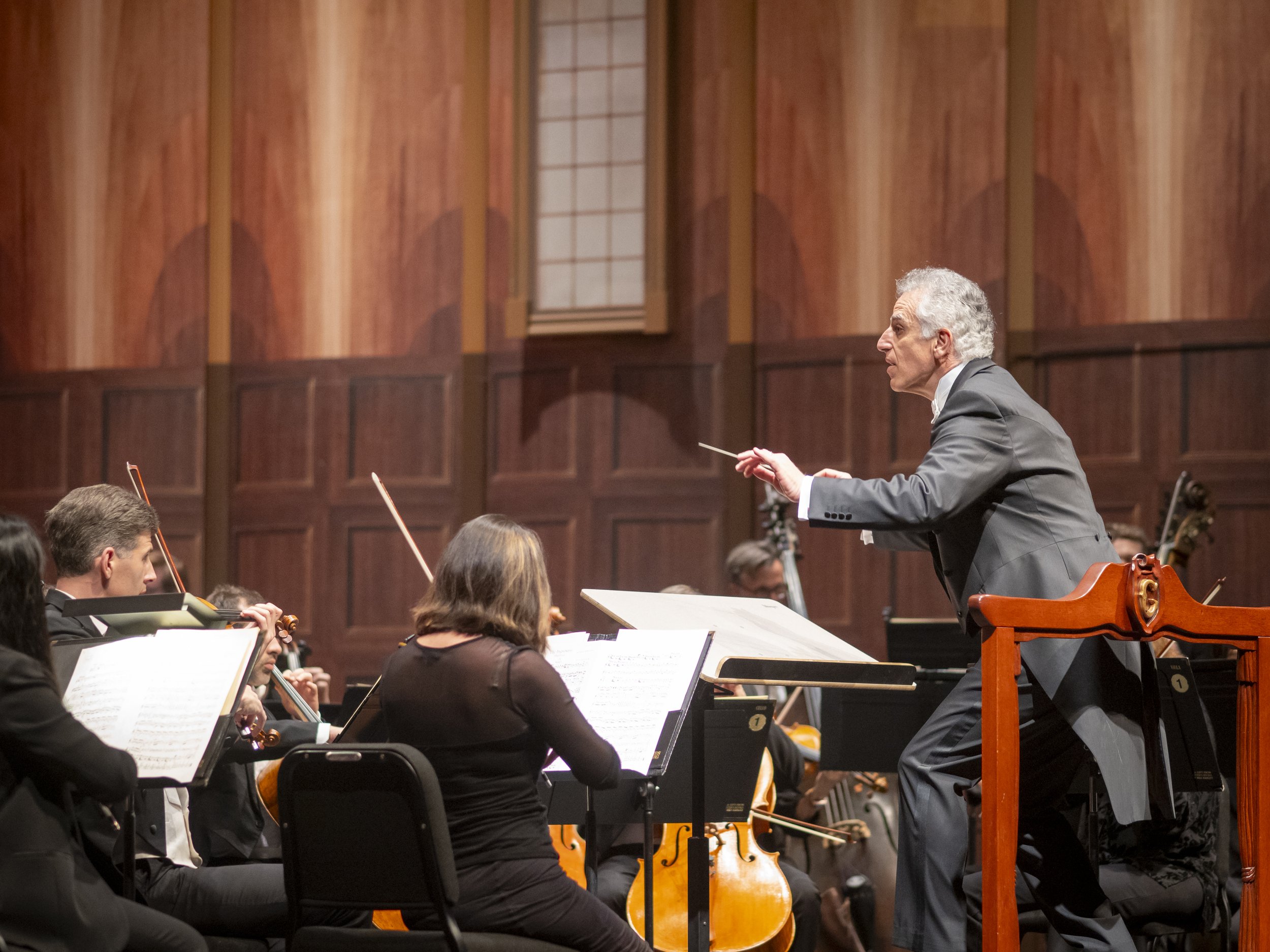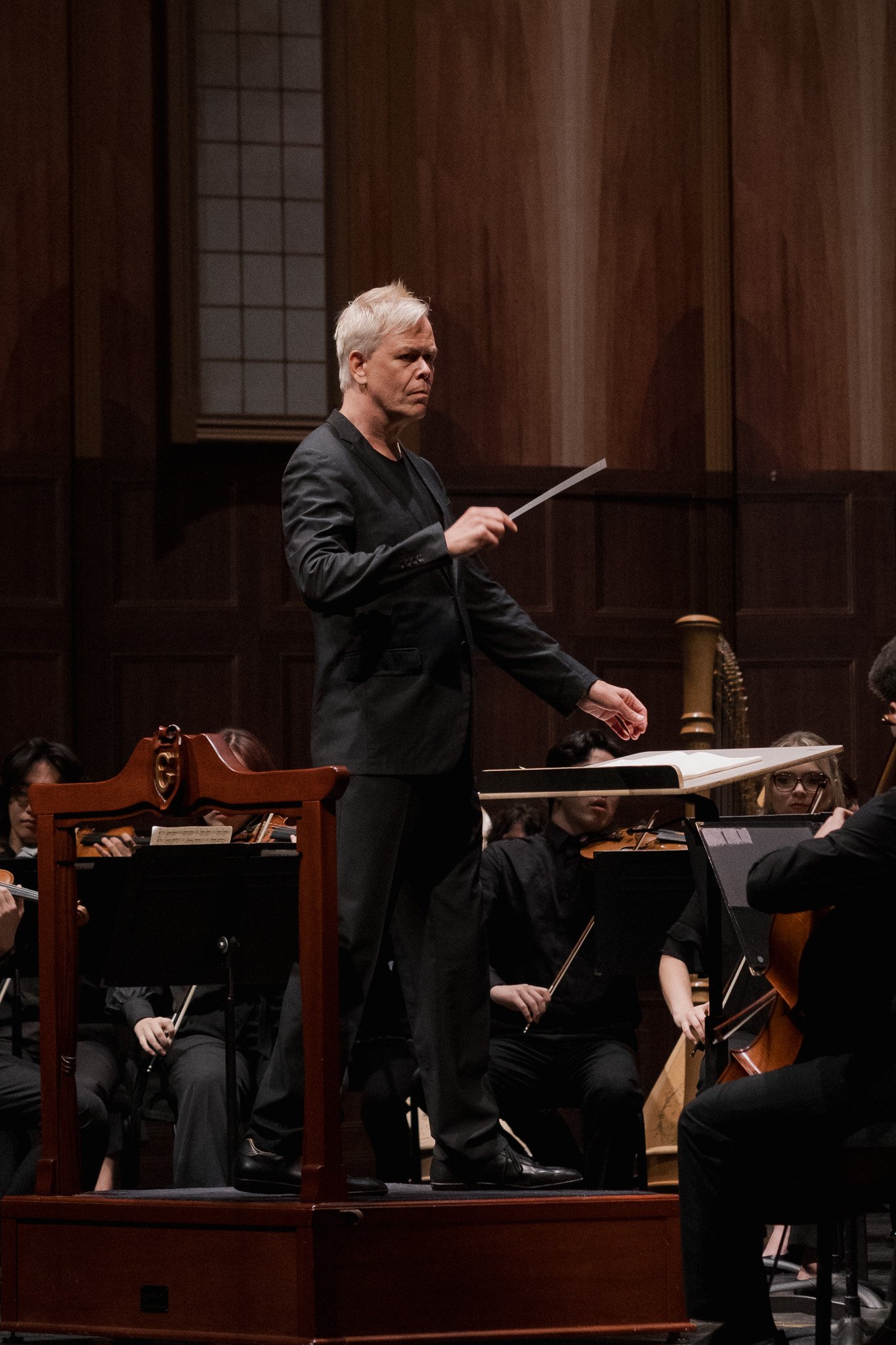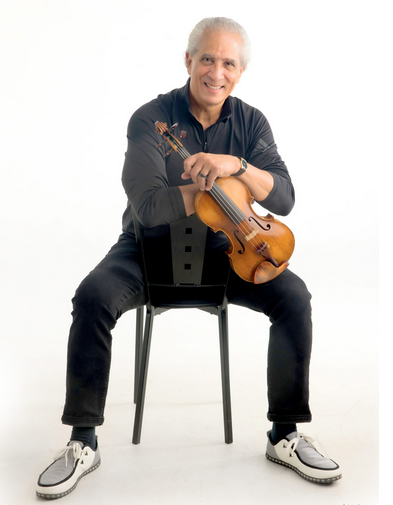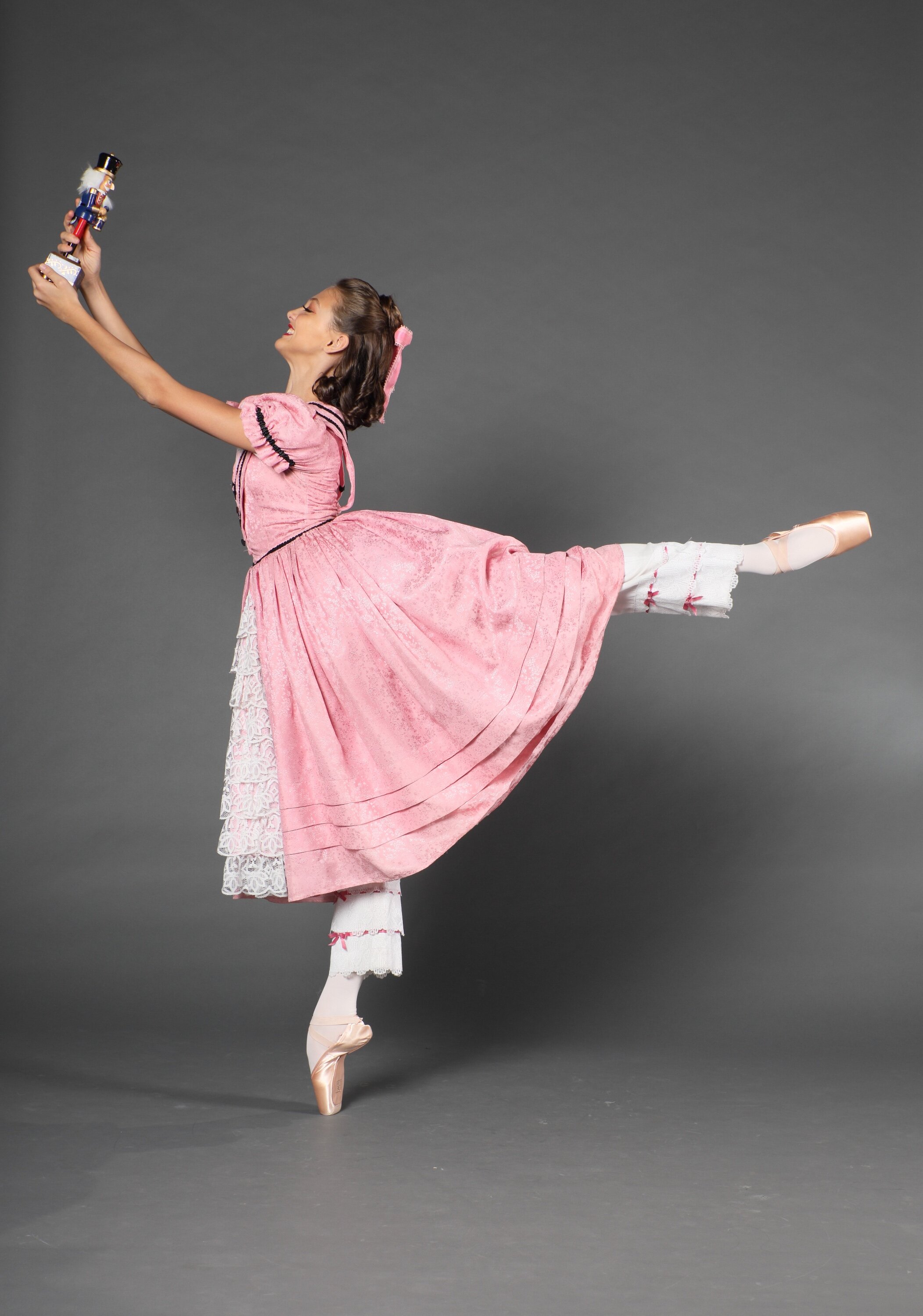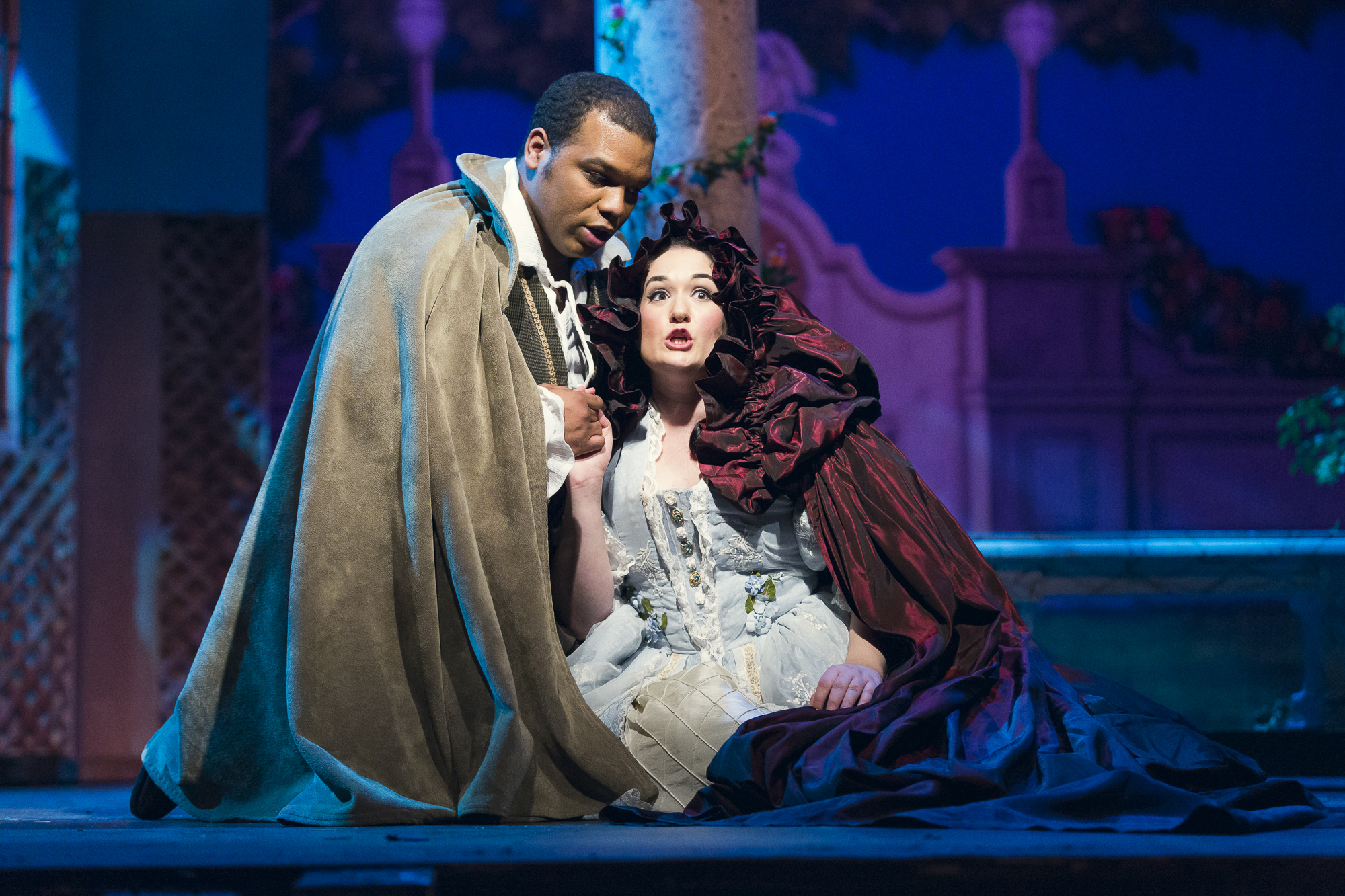Santa Barbara Symphony on January 18-19 2025 - Mozart Marathon
Visit the Santa Barbara Symphony website
Read Music and Artistic Director Nir Kabaretti’s bio
Read violinist Jessica Guideri’s bio
Read flutist Amy Tatum’s bio
Read harpist Michelle Temple’s bio
Visit actor Tim Bagley’s website
Read stage director Jonathan Fox’s bio
The Trouble with Marathons/Saturday, January 18, 2025
The Beauty and the Beast about marathons, particularly when they focus on a single composer, filmmaker, painter, architect, whatever . . . is curation. Curators, those tasked with selecting the content of an exhibition or performance series, can sometimes get a bit carried away, losing sight of the most important responsibility of the curatorial art; avoid at all costs, turning adventure and discovery into an awful bore.
Santa Barbara Symphony audiences are fortunate. The curator-in-chief of music programming for the orchestra, Music, and Artistic Director Nir Kabaretti is a master at conjuring fresh, beautifully imagined, and carefully crafted concert programs. Not the least flustered when tasked with creating two consecutive and separate all-Mozart programs for the orchestra’s January 18-19 concert pair in the Granada Theatre, Kabaretti chose to focus on the bright and playful side of Mozart’s complex personality, while also cleverly weaving a potent handful of narrative anecdotes into the fabric of the two concerts to gently separate the human being from the demigod.
Kabaretti’s programming architecture for the two Mozart concerts allowed for a satisfying and carefully calibrated flow from one piece to another, from Saturday evening to Sunday afternoon without a restless stir from auditors. Success was in balance, and aesthetic. The programs grazed Mozart’s copious oeuvre with scholarly magnanimity. An overture, a little night music, four concertos, and two symphonies were the ingredients for Kabaretti’s Mozartiana.
His spices? Forget savory. The tonalities filling the Granada Theatre for both concerts were in Mozart’s happiest key areas - C major, D major (lots of D major), and A major. Does curation, even of tonal centering matter? Of course! Two concerts over two days gave us a roomful of positive energy and, well, happiness. Did maestro Kabaretti think this magic up? Creativity and innovation are in his job description.
The concerto soloists for both concerts (more on each later) were the principal players of the SBSO. In southern California, with the Los Angeles megalopolis a little over an hour south, the SBSO principals also enjoy similar positions in the film and TV industry, and with many of the dozen or so professional orchestras, opera, and dance companies in the Greater Los Angeles area.
In other words, the Mozart Marathon concerto soloists were a collective treat to the ear; magnificent execution, authoritative styling, interesting cadenzas, and the confident virtuosity that comes with being at the top of one’s game.
It makes sense to open a Mozart Marathon with an overture. Without wink or nod but surely from intention, Kabaretti selected with straight face, the overture to Der Schauspieldirektor (The Impresario), a brief singspiel opera from 1786 commissioned for a private entertainment at the Vienna palace of Holy Roman Emperor Joseph II about the vanity of Italian singers. There’s more to the fascinating story. Think Salieri, and Google Impresario.
The Santa Barbara Symphony, tastefully reduced in string numbers to abide period performance practice, gave the roughly five-minute overture it’s stylistic due on Saturday’s opening night of the Marathon - clean articulation, spunky playing, lovely balances between departments, and an irresistibly glib C major temperament. A light confection to open the Mozart festivities.
Kabaretti loves to collaborate with his colleagues at Santa Barbara’s other professional performing arts organizations. His relationship with stage director Jonathan Fox has been steady and productive over several years. Recently retired after 16 years as Artistic Director at Santa Barbara’s Ensemble Theatre Company, Fox has remained active as a freelance director for recent productions in Frankfurt and Cologne (Germany), Vienna (Austria), and Basel (Switzerland).
Having worked with conductor Kabaretti on several memorable concert/narrative collaborations pairing semi-staged dialogue to musical themes, Fox was a no brainer to join the Mozart Marathon creative team. Adding de-mystifying anecdotes about the composer as punctuation points to the extraordinary music, Fox devised a non-invasive narrative peek into the backstory of Mozart and his world.
Fox’s Mozart-as-Everyman story launched immediately after the Impresario overture on Saturday evening. Hollywood actor/comedian Tim Bagley (Will & Grace) entered the stage to read a scatological but fun letter from the young genius to his female cousin. After breaking culture and class stereotypes with a dose of Mozart’s delightfully descriptive potty mouth, Bagley reminded all what we were likely doing as ‘tweens (stomping in mud puddles was my favorite activity) while Mozart at the same age was touring Europe as a violin prodigy, composing masterpieces by the gigaton.
Saturday night’s concert continued in the same key as Impresario, a nice segue from one work to the other - the Concerto for Flute, Harp, and Orchestra in C major, K. 299/297c (1778). Amy Tatum flute, and Michelle Temple harp gave this classic of the repertoire a reading that was fresh as well as fascinating.
Amy Tatum, principal flute with Santa Barbara Symphony since 2023 plays all over the place including regularly for LA Opera, the Hollywood Bowl Orchestra, Los Angeles Chamber Orchestra, Pacific Symphony, Pasadena Symphony, New West Symphony, Los Angeles Master Chorale, and Long Beach Opera.
Michelle Temple has been principal harp with Santa Barbara Symphony since 1991 and for Pacific Symphony since 1994. She also serves as principal harp for Opera Santa Barbara, and undoubtedly gigs extensively throughout southern California, and beyond.
Out of the gate the two were pals in perspicacity, brushing a cobweb or two off this gorgeous and regularly performed work. The duo cadenzas they presented throughout the concerto were wonderful to enjoy (author?), because fresh to these ears. The lovely cadenza at the end of the Allegro for example, ushered the beautifully expressive Andantino into the soundscape, both artists enlightening the aesthetic with lots of dynamic contrast, subtly shaded colors, and pithy rubato.
After another wonderful duo cadenza, the two matching each other’s finesse equally, the last movement Rondeau-Allegro. Tricky this one, especially for the harpist. An aura of Mozartian playfulness was successfully conjured by the two, despite some busy pedal work on the harp! Breezy conducting from Kabaretti, and tight nearly gossamer playing from the orchestra closed a delightful first half of Saturday’s program in style.
After intermission, a brief return to the stage by Tim Bagley to enlighten the audience on the quasi-Oedipal, reasonably dysfunctional yet also loving co-dependency between Mozart and his father, Leopold. The narrative, which Jonathan Fox honed from source materials and letters was, in a canny coup de théâtre, the perfect setup for the creative if occasionally bruised fruit of this manager/artist, father/son connubial conundrum.
The Violin Concerto No. 4 in D Major, K. 218 composed at the age of 19 in 1775 to use as a touring showpiece for himself along with the other violin concertos the young Mozart composed between 1773 and 1775 represents at a psychological sub-basement level, the pressure from the father to produce fresh material for tours, and the resultant brilliance unleashed from that parental pressure point.
Another blockbuster performance was on tap. Jessica Guideri’s stunning interpretation of the work was as fresh and exciting as it gets. Concertmaster of Santa Barbara Symphony since 2015, Jessica Guideri has held principal positions with several orchestras including the Los Angeles Opera Orchestra, Pacific Symphony, and Phoenix Symphony. Her Hollywood film and TV studio recording gigs indicate she’s at the top of the contractor lists for the best recording orchestras in the business.
Training and professionalism showed in her impeccably executed and innovative - fabulous and fresh cadenzas - interpretation of the work. Breathtaking articulation, pure, ringing tone production with superlative intonation, not to mention her significant palate of dynamic nuance, breathed life and rhythm into every movement of the concerto.
The first movement Allegro instantly cleared the air about where Guideri stands in the fiddle firmament. It could have been hallucination, but I swear Guideri deciphered, for that is what performing great music is about, a few things I had never heard before including perhaps, her unearthing of a prescient subconscious (Mozart’s) fragment in the first movement that reminded this listener for the first time of the composer’s coloratura aria for the Queen of the Night, Der Hölle Rache kocht in meinem Herzen (Hell's vengeance boils in my heart).
It’s possible Guideri discovered and showed us a shard that might have grown in the composer’s mind over time, to be found fully developed years later in The Magic Flute (1791). Fresh discovery or hallucination, it doesn’t matter. The performance was revelatory.
The solo cadenza into the slow movement Andante contabile jumped off the page for this listener - a version I had never heard before. A fabulous choice of cadenza (there are many), which was modern in a Classic Period way, and fresh. The house listened in fascinated silence. Have I mentioned Guideri plays with authority and finesse? Her performance of the Andante cantabile was expressive certainly, but with added dollops of color and powerful but contained energy in super-soft passage work that electrified.
The last movement Rondeau: Andante grazioso - Allegro ma non troppo, one of the jewels of the violin concerto repertoire for its coy and youthful playfulness, was the more remarkable in this performance by Guideri. A stout if also playful performance, it was altogether genuine in temperament, thus engaging. The violinist gave us intellectual nourishment in spades, and also bathed us in her considerable elegance and style. Maestro Kabaretti and the orchestra gave back in kind.
To conclude this first of two ridiculously pleasant Mozart Marathon concerts, the Symphony No. 35 in D major (Haffner), K. 385 (1782). A work of Holy Grail-like significance and familiarity to orchestra musicians amateur and professional alike since, well, 1782, the Santa Barbara Symphony, Nir Kabaretti at the helm, offered a brisk and velveteen performance of its four iconic movements that was light, enthusiastic, candidly bracing, and completely satisfying.
Mariposa Series - JACK Quartet on December 7, 2024: Modern Medieval
Visit the Music Academy Mariposa Series website
Visit JACK Quartet’s website
Visit composer Taylor Brook’s Wikipedia page
Visit composer Vicente Atria’s website
Visit composer Juri Seo’s website
JACK Quartet: Modern Medieval - The Once and Future Micro-tonalists
We don’t often go into a transformative experience willingly. When it happens, the event wipes out distractions about oneself, immediate time, personal goals - the stuff of everyday conscious thought. Psychologists call it the “awe” effect.
An hour or more of evanescent whispers from sonic worlds past, present, and future conflated into a single musical riddle wrapped in 700 years of history, does not readily come to mind even for brainwave activists, as a wild night out on the town.
Wrong!
New York City-based JACK Quartet’s marvelously esoteric and thoroughly mind altering (no kidding) program on December 7 at the Music Academy in Santa Barbara - the second recital of the Academy’s 2024-2025 Mariposa Series - was also an utterly fascinating intellectual broadside.
Programmatic parable? Perhaps something about string theory, worlds in collision, and the oneness of all matter in the universe. Not bad for a Saturday evening adventure in music at the Music Academy.
In over 60 years of reviewing live concerts, it’s been my general policy to experience performances in the moment, without much if any preparation. I was not ready, therefore, to have neural surgery performed on my mindset by JACK Quartet’s profound thus a bit rattling, programming acumen.
Modern Medieval, a slightly disorienting, moderately oxymoronic program title on its face, was in fact a construct of bunker busting musical and cultural revelation. JACK captured the audience’s attention by means of sound sorcery, taking us on a journey through historical/musical time that set my head spinning softly in the moment, with long ruminations on the experience days after. How magnificent is that!
JACK Quartet - Christopher Otto violin, Austin Wulliman violin, John Pickford Richards viola, and Jay Campbell cello - have created together, in a burst of foursquare intuitive genius, a deceptively unassuming, quasi magical realist, and thoroughly satisfying touring program of new music inspired by Medieval compositional experimentation centered in Venice, which Nostradamus himself could not have prognosticated.
The program’s raison d'être was inspired by one of the most progressive composers of his time, Nicola Vicentino (1511-1576) who invented a micro-tonal keyboard instrument, the archicembalo, which should have earned him a burning at the stake.
Jack Quartet’s approach to unlocking the Rubick’s Cube of Modern Medieval is like dumping puzzle parts out of a box and asking the audience to put it together while sniffing chloroform. The “awe” kicked in immediately upon trying to figure out the program order itself. Lots of new voices.
Despite the pan-generational music history jigsaw JACK Quartet put before us, the great joy of the quartet’s meticulously organized Modern Medieval program was its mindful construction, which created an overall confidence among us auditors, at least subconsciously, that deep down in our synapses a re-wiring of thinking about music and history was in play, and we were going to be the beneficiaries.
The evening’s several seductions began with violinist Christopher Otto’s beguiling narrative before the first work was performed. Luring us down a verbal micro-tonal rabbit hole, a 700-year musicological dive upward from Medievalism to the present sound universe Westerners are generally accustomed to hearing while sedated at the dentist, the mind-melting message from JACK Quartet to its audience was simple, “Whatever is has already been, and what will be, has been before.” (Ecclesiastes 3:15).
JACK Quartet’s Modern Medieval program in a codpiece, considers the fight several hundred years back over which tuning method “just” or “tempered” would prevail in Western music. The quartet has a thing or two to say about the issue, it’s outcome then, and how things that go around, come around.
Pieces by Taylor Brook, Organum (2017) and Ars Nova (2017) served as programmatic bookends for the Modern Medieval thesis. His Phrygea, also composed for JACK Quartet in 2017 was slipped into the second half of the recital as a bonus. All three are contemporary homages to the bedrock forms and sounds of Nicola Vicentino and his free-thinking Venetian colleagues.
Organum prepared us for the musical soundscape ahead in whispering, languorously sustained whole tones. And as a kind of benediction at evening’s end, his Ars Nova hinted at the profundity of the 360-degree circumnavigation of time and musical process JACK Quartet had created and bestowed upon us.
The music in between those bookends consisted of three works tweaked for JACK by violinist Christopher Otto - Angelorum Psalat after Rodericus (2011/1390), Miserere after Nathaniel Giles (2023/1594) and Fumeux fume par fumee after Solage (2018/1390); with two works by Nicola Vicentino realized by JACK - Musica prisca caput and Madonna, il poco dolce (1555).
On the menu as well, JACK Quartet violinist Austin Wulliman’s fascinating 2024 composition for the ensemble, Dave’s Hocket; Vicente Atria’s hot off the press 2024 composition, Round-About; and Juri Seo’s Three Imaginary Chansons, also composed in 2024.
Suffice to say, the most satisfying aspect of JACK Quartet’s intoxicating program December 7 was not about individual pieces, though there were plenty of trophy winners in that category. Rather, the helium in the room was generated by a realization that sounds past and present were intermingling easily, as in a ghost story, reinforcing the idea of timelessness. Sounds discovered and explored in the Medieval period (micro-tonalism), were lost for centuries then re-discovered and deployed in our own age. How “woke” is that!
Memories from the vaporous daydreaming of the concert’s sound experience: colors and pitches deliberately skewed in dizzying but fun mashups; fascinating pitch clusters and tonal meltdowns; high harmonics creating “ghost” echos; rogue pitches splendidly informing the mystical wonder of sound.
Compositional highlights: Juri Seo’s Three Imaginary Chansons, particularly the last, Confronted Cocks and Running Dogs, Austin Wulliman’s Dave’s Hocket (one had to turn away, look to the ceiling to hear everything subtly taking place in the sounds), and Vicente Atria’s Round-About, with its energetic passage work and busy winks and nods to all kinds of things musical, modular, and multi-tonal, not to mention his powerful skills at writing for string quartet.
Daniel Kepl | performingartsreview.net
“I try to use words as I would sounds - I want them to have meaning and create visualization.”

JACK Quartet - Christopher Otto violin, Austin Wulliman violin, John Pickford Richards viola, Jay Campbell cello
PROGRAM
Taylor Brook, Organum (2017)
Christolpher Otto, Angelorum Psalat, after Rodericus (2011/1390)
Nicola Vicentino, Musica prisca caput - Madonna, il poco dolce (1555)
Austin Wulliman, Dave’s Hocket (2024)
Christopheer Otto, Miserere, after Nathaniel Giles (2023/1594)
Taylor Brook, Phrygea (2017)
Johnny MacMillan, Songs from the Seventh Floor (2021)
Christopher Otto, Fumeux fume par fumee, after Solage (2018/1390)
Juri Seo, Three Imaginary Chansons (2024)
Taylor Brook, Ars Nova (2017)
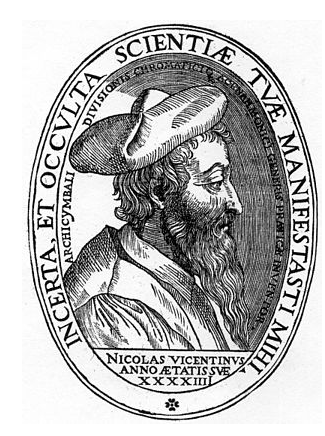
Composer Nicola Vicentino

Download a PDF of the review

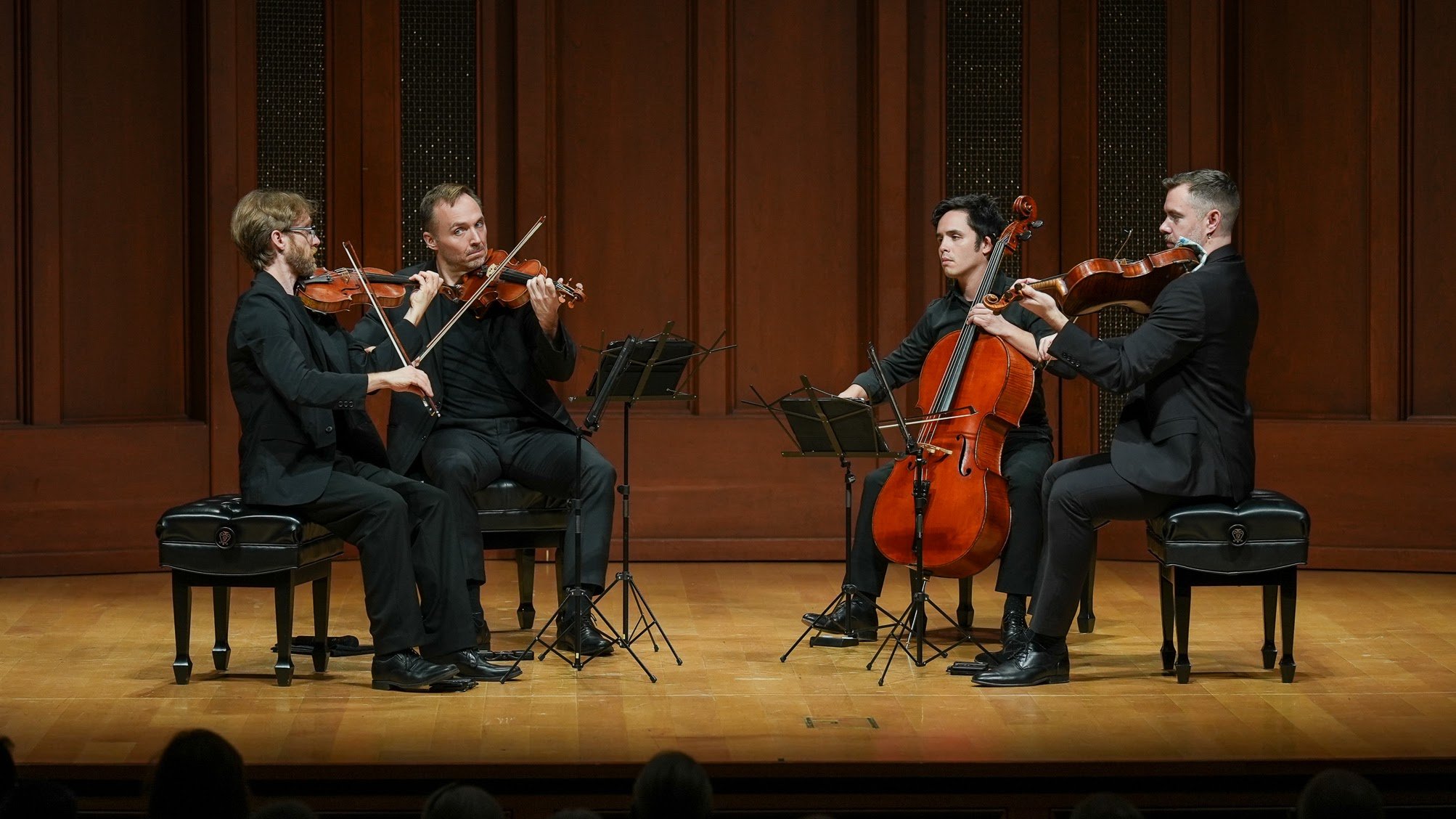
Live performance photos by Emma Matthews


Composer Taylor Brook

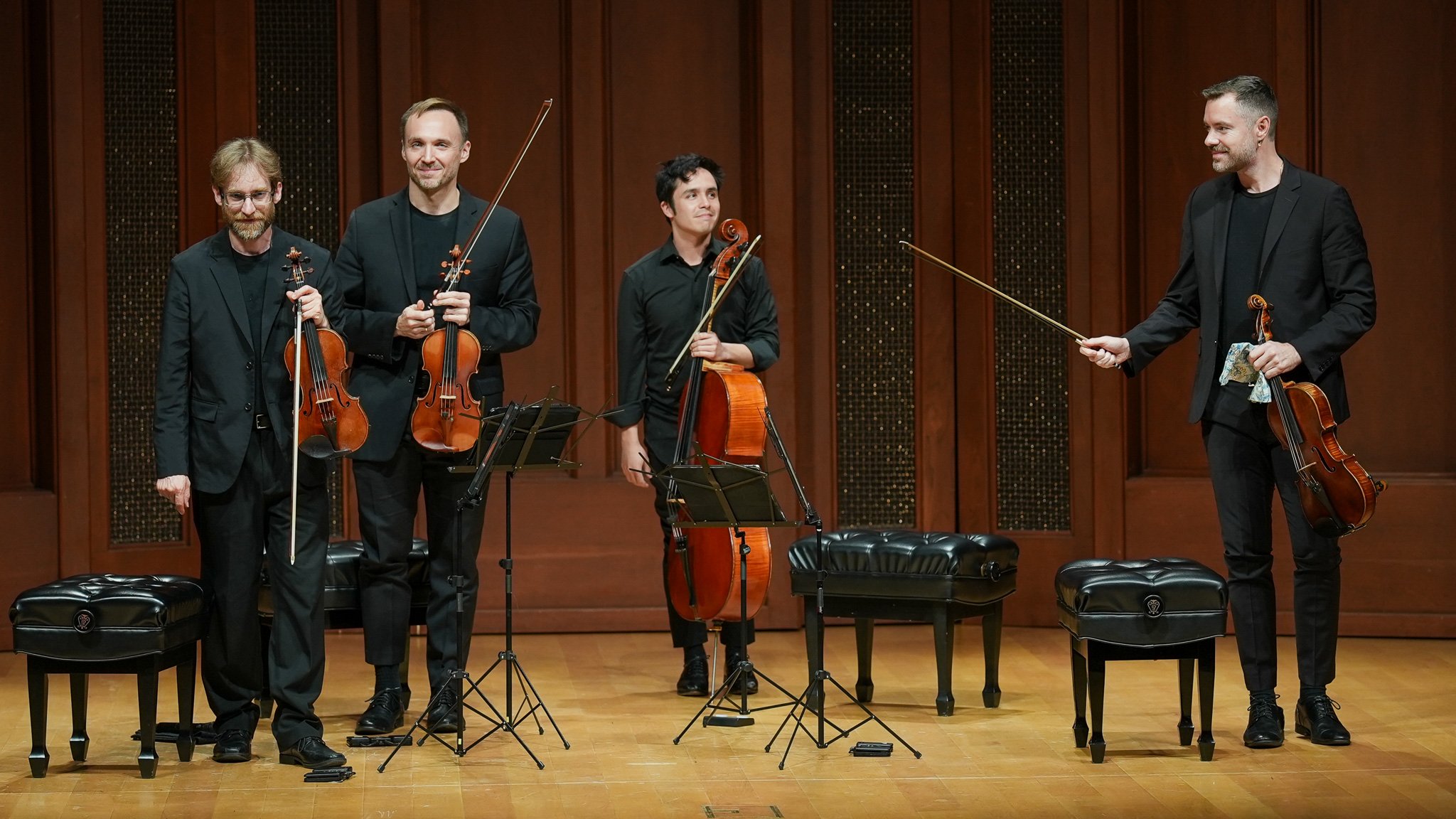

Violinist/composer Christopher Otto

Violinist/composer Austin Wulliman

Composer Vicente Atria
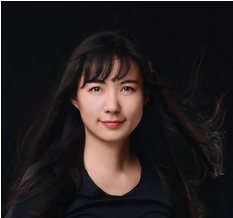
Composer Juri Seo
Santa Barbara Symphony on October 19, 2024 - Tributes and Triumphs
Visit the Santa Barbara Symphony website
Read Music and Artistic Director Nir Kabaretti’s bio
Visit guitarist Pablo Sáinz-Villegas’ website
Read In Memoriam: Emma Lou Diemer 1927-2024
Tributes and Triumphs
The special honor for most of us who knew American composer and longtime Santa Barbara resident Emma Lou Diemer (1927-2024) was the opportunity to bask even briefly, in the aura of her indefatigable energy. Like the sprawling prairie from which she came, the Kansas-born composer, who died here at 97 in June 2024, lived every minute of her time with us in happiness, joy, and a purposeful Somewhere Over the Rainbow optimism.
Tiny in stature, seemingly fragile as Delft though actually tough as nails with a side order of discipline, Diemer’s sincerely cheerful personality, her enthusiasm for just about everything, and most importantly her steadfast musical integrity, made her life and music a bright shining object in the classical music firmament. Diemer’s prodigious folio of works large and small are her legacy for us all to enjoy.
Music and Artistic Director Nir Kabaretti and the Santa Barbara Symphony opened the orchestra’s 72nd season on October 19 at the Granada Theatre with a particularly apt tribute to Emma Lou Diemer’s creative compositional skills - a work of hers utilizing late Romantic orchestrations, like-minded ensemble balances and colors together with devilish-clever manipulations and melodic references to the composer being “homaged.”
Commissioned and premiered by the Santa Barbara Symphony in 2001, Homage to Tchaikovsky is a feisty concert opener of about six minutes. A perfect musical bon voyage to Emma Lou from her friends and musical colleagues in Santa Barbara, Homage bubbled with energy, pulse, optimism, and not a few winks and nods. Diemer’s playful tunes passed through various departments of the orchestra with sly accessibility and an unmistakably sassy American musical attitude.
Were bits of Tchaikovsky tunes present, however fractured, in Diemer’s compositional mashup? Honestly, I didn’t hear any in 2001, nor at this second opportunity on October 19, which is likely the point. Every time I convince myself there are no recognizable Tchaikovsky tune fragments in the piece, I see Emma Lou Diemer’s face looking down at me with that famously disarming twinkle in her eye!
The composer admitted in an earlier program note the piece was her first use of the technique of hiding fragments and other characteristics of one composer within a “fresh” composition by another. If themes from Tchaikovsky’s jukebox are there, hats off to Diemer’s skills at smoke and mirrors, the very object of the exercise. Kabaretti and the orchestra gave their own homage to Diemer’s genius with a performance that bristled with playful energy and technical expertise.
I remember my first encounter (it was visual) with Joaquín Rodrigo’s eponymous Concierto de Aranjuez for Guitar and Orchestra (1939). I was in high school (1963-1966) taking college-level summer classes at UC Santa Barbara. Exploring the Student Union building one day I found, running the length of a long interior hallway corridor, a seven-inch-high strip of colorful graphic art depicting in Schenkerian musical analysis style, a visual representation of the forms, structures, harmonic progress and resolutions of Concierto de Aranjuez.
I must stop by one day and see if it’s still there or painted over. In any case, that graphic and the time it took to create it speaks to the popularity of Rodrigo’s concerto over the decades since it’s premiere in 1939.
Like Tchaikovsky’s The Nutcracker, most people have heard and recognize Rodrigo’s masterpiece, or bits of it. In both cases, the public might not know who the composers are, but can recognize the tunes. As career paths go, a composer can’t ask for much better.
Before the performance on October 19 by Spanish guitarist Pablo Sáinz-Villegas, who is a favorite guest artist with the orchestra, I had not heard the work performed in truly Iberian fado/flamenco (evocative/provocative) temperament - the key to its soul.
The concerto speaks with energy and rhythm of which it has plenty, but prior to Sáinz-Villegas’ interpretation, I had not experienced the sense of historical zeitgeist (Moorish conquest and removal) that informs Sáinz-Villegas’ sensibility. His psychologically piercing and genuinely authentic interpretation at so many levels, was a revelation.
The first movement Allegro con spirito, seemed at first quite straightforward, but it didn’t take long to realize Sáinz-Villegas’ performance was different from most - calm in execution, no drama. A meditative and appropriately melancholic performance that gave the movement new meaning and mysterious atavistic heft. Kabaretti and the orchestra obliged with incredibly sensitive collaboration.
The second movement Adagio, found Sáinz-Villegas in particularly magnificent expressive form, his playing regal, sophisticated, wildly expressive, while also superbly articulate; angst and joy commingling in a glory of sweet and savory irony.
During the solo cadenza before the last movement Allegro gentile, Sáinz-Villegas emphasized dissonant harmonics in a manner I’d not heard before - shocking, heartfelt, and meaningful. Powerful stuff. The audience received his charismatic playing with hushed obeisance, preparing perhaps unconsciously for the unfettered solidarity of technique and execution Sáinz-Villegas brought to the last movement itself.
His encore, Argentinian composer Astor Piazzolla’s Viva Tango in an arrangement for guitar and orchestra. Delightful.
Considering the moniker for the October 19-20 Santa Barbara Symphony concert pair was Tchaikovsky Immersion, there was little left for audience imagination than to experience one of the composer’s rip-snorting symphonies to close the evening with panache. Maestro Kabaretti, who has conducted the work on numerous occasions and knows it from memory, decided the composer’s Symphony No. 4 in F minor, Op. 36 would fit the bill. It did, handsomely.
With Kabaretti at the helm, and the orchestra an ensemble of professionals from Santa Barbara and Los Angeles who have played together for decades, it will cause no surprise to report the performance was stunning. With so many technical challenges in its four comprehensive and complicated movements, so much exposed section playing and unforgiving writing for horns to say nothing of the monumental arc of Tchaikovsky’s mighty vision, the No. 4 was the proverbial cherry on an evening of wonder.
Daniel Kepl | performingartsreview.net
“I try to use words as I would sounds - I want them to have meaning and create visualization.”
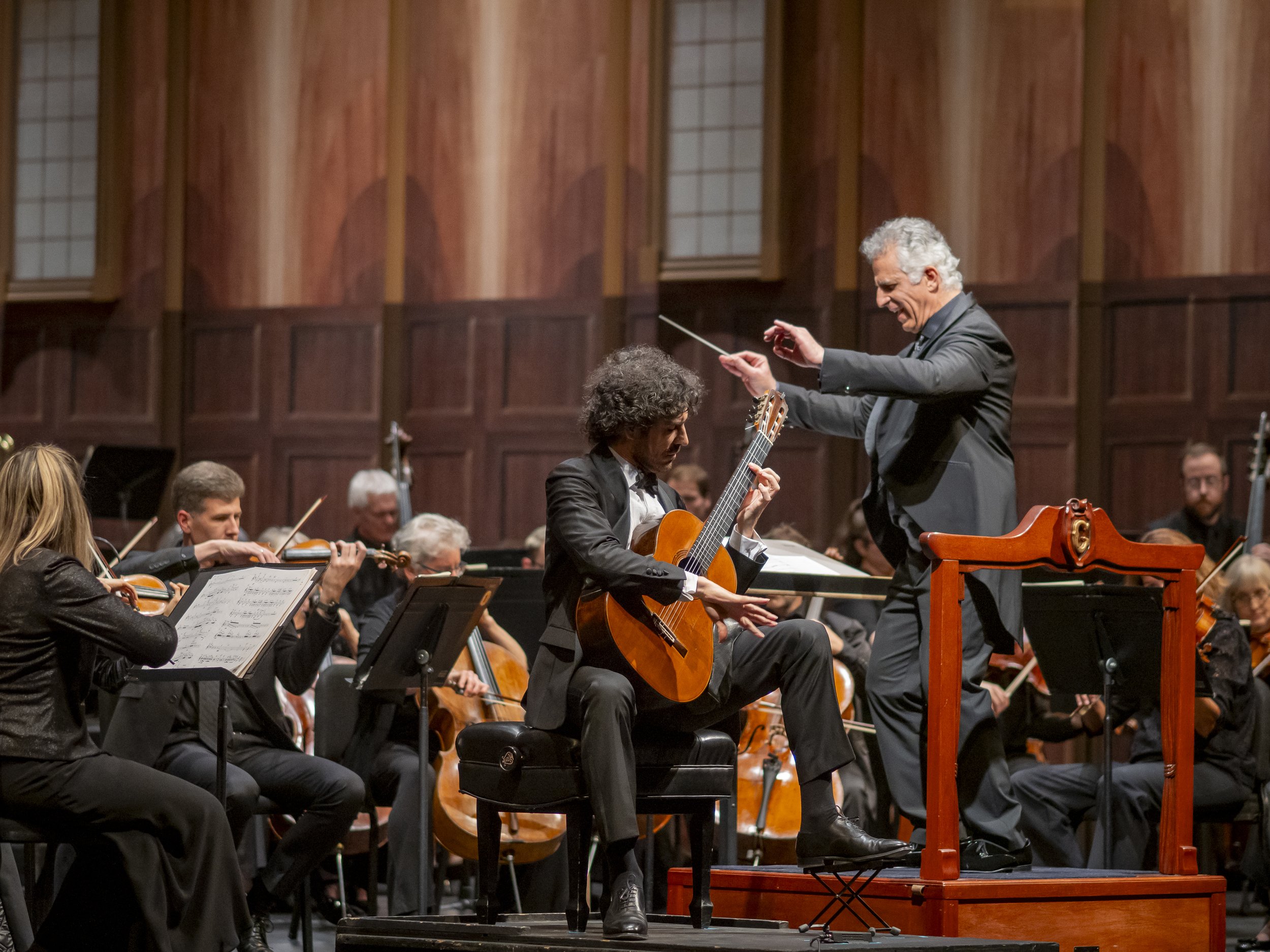
Conductor Nir Kabaretti and guitar soloist Pablo Sáinz-Villegas/performance photos by Nik Blaskovich

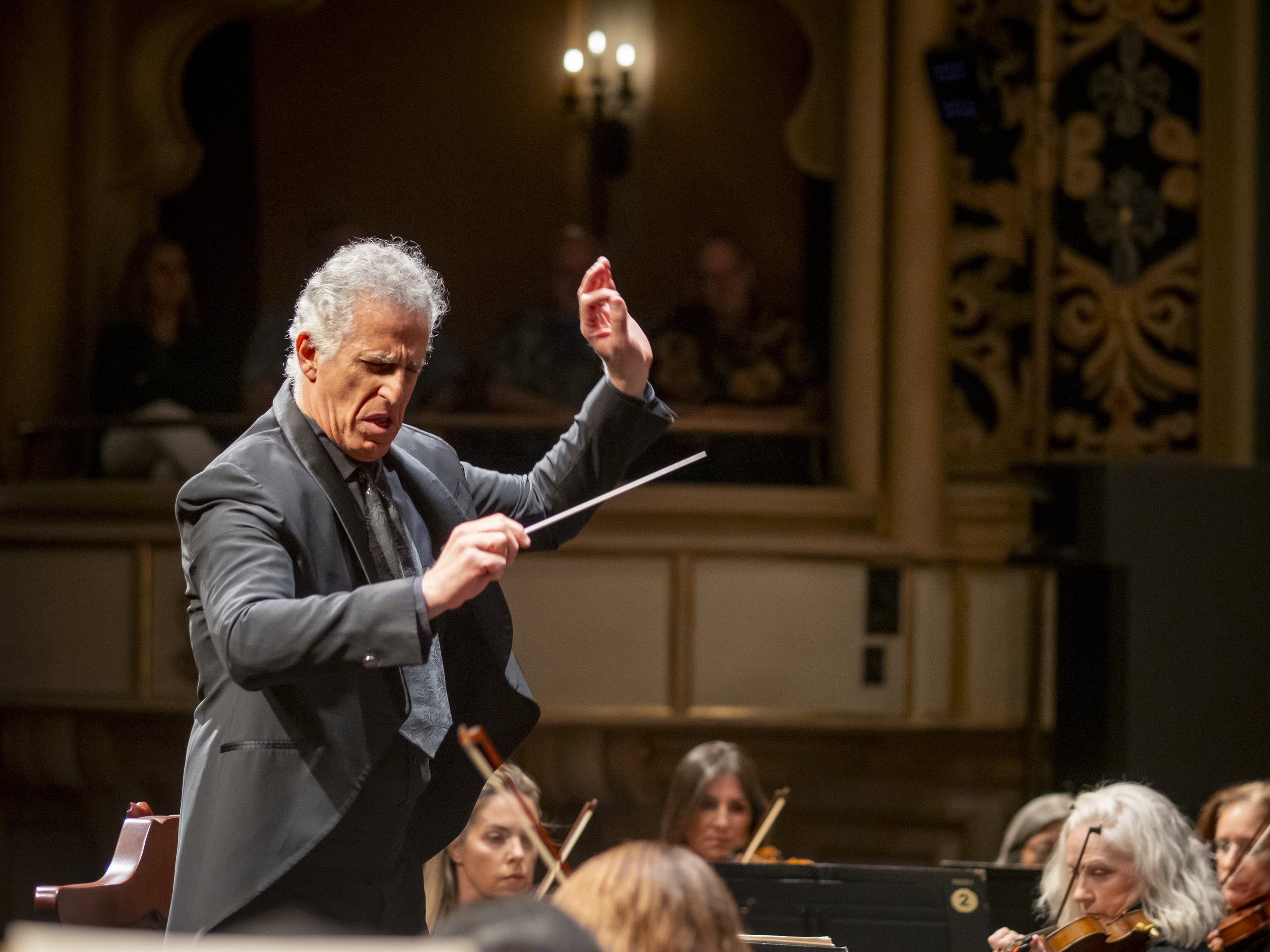
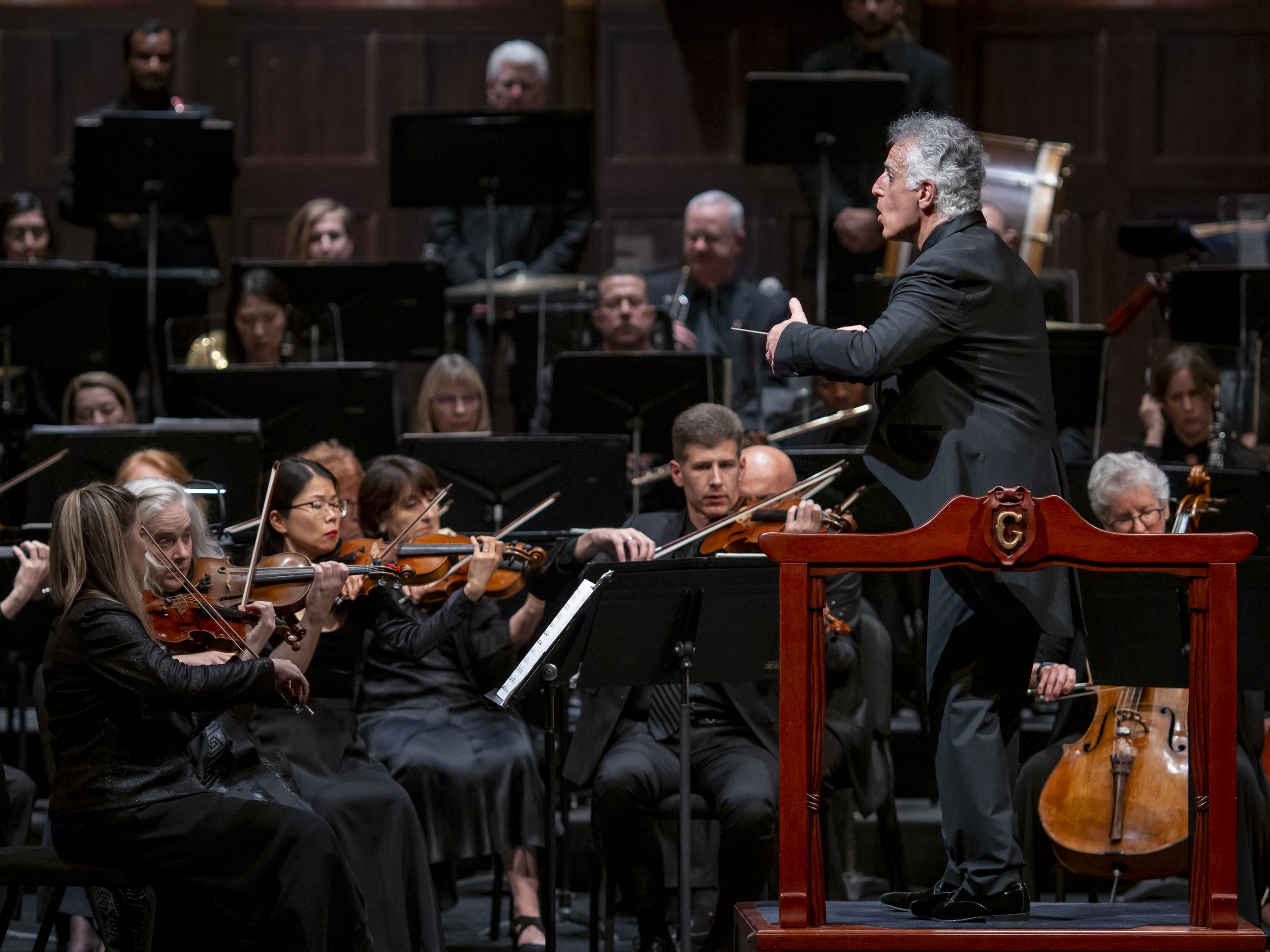

Download a PDF of the review
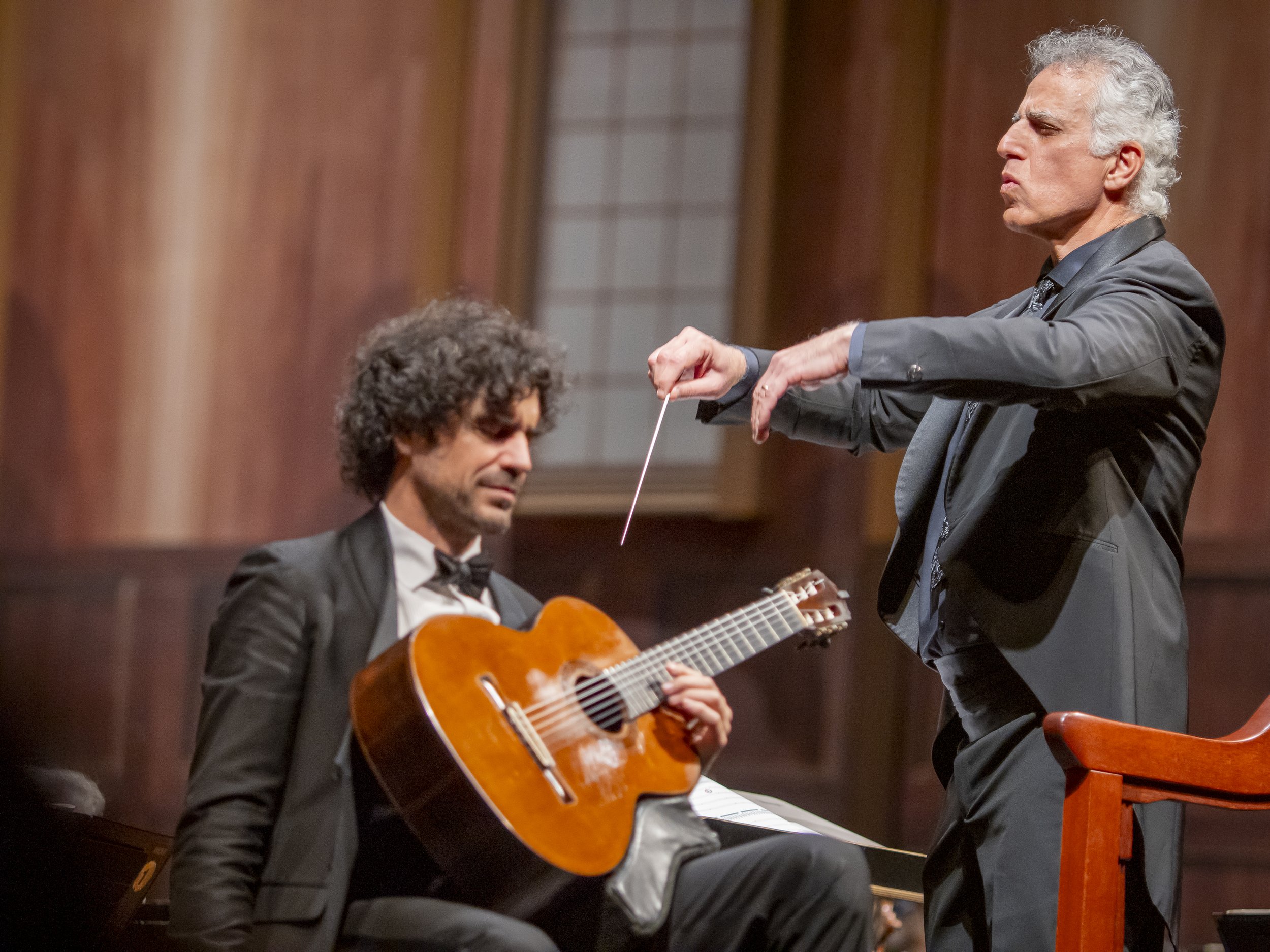
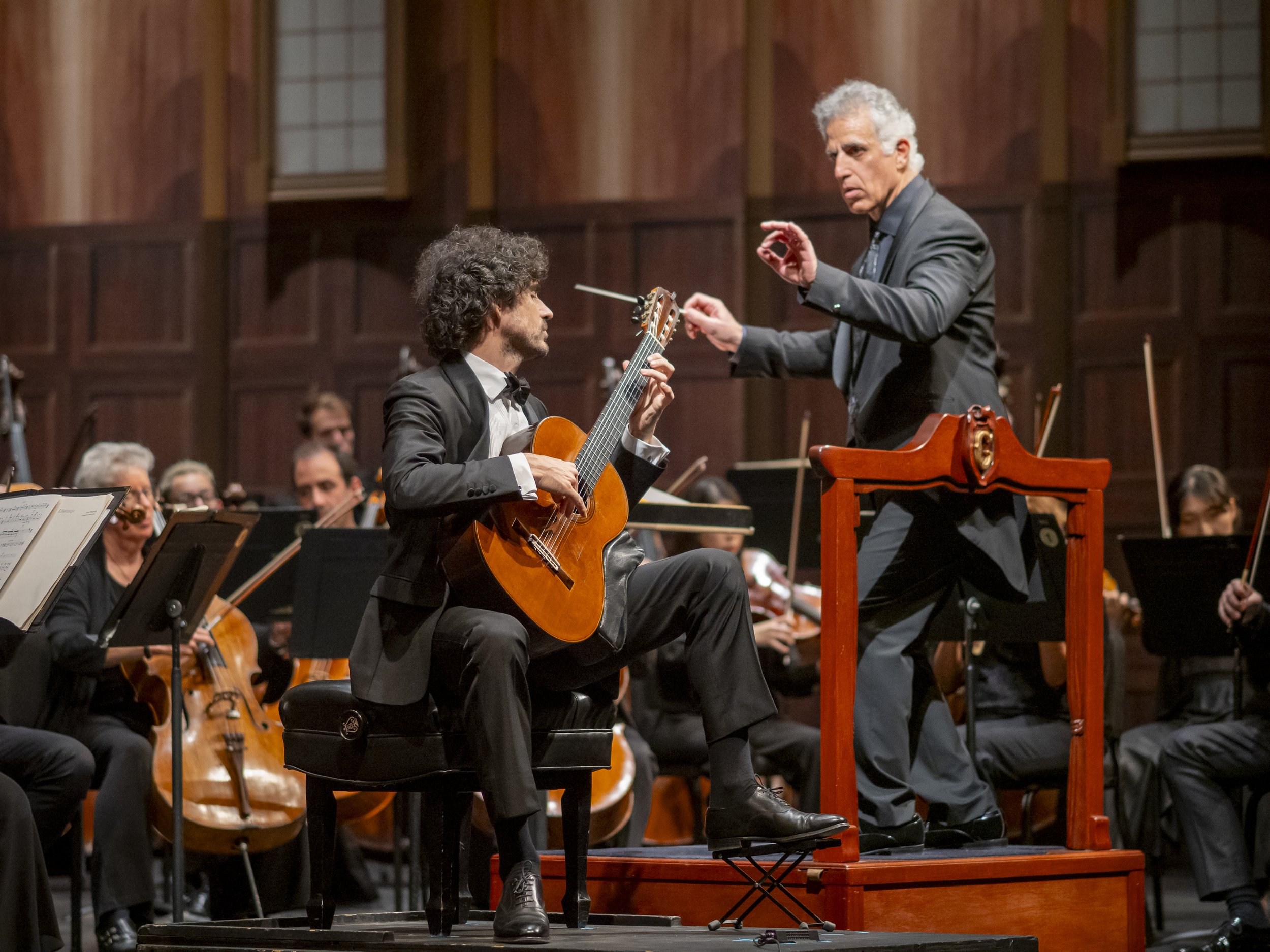


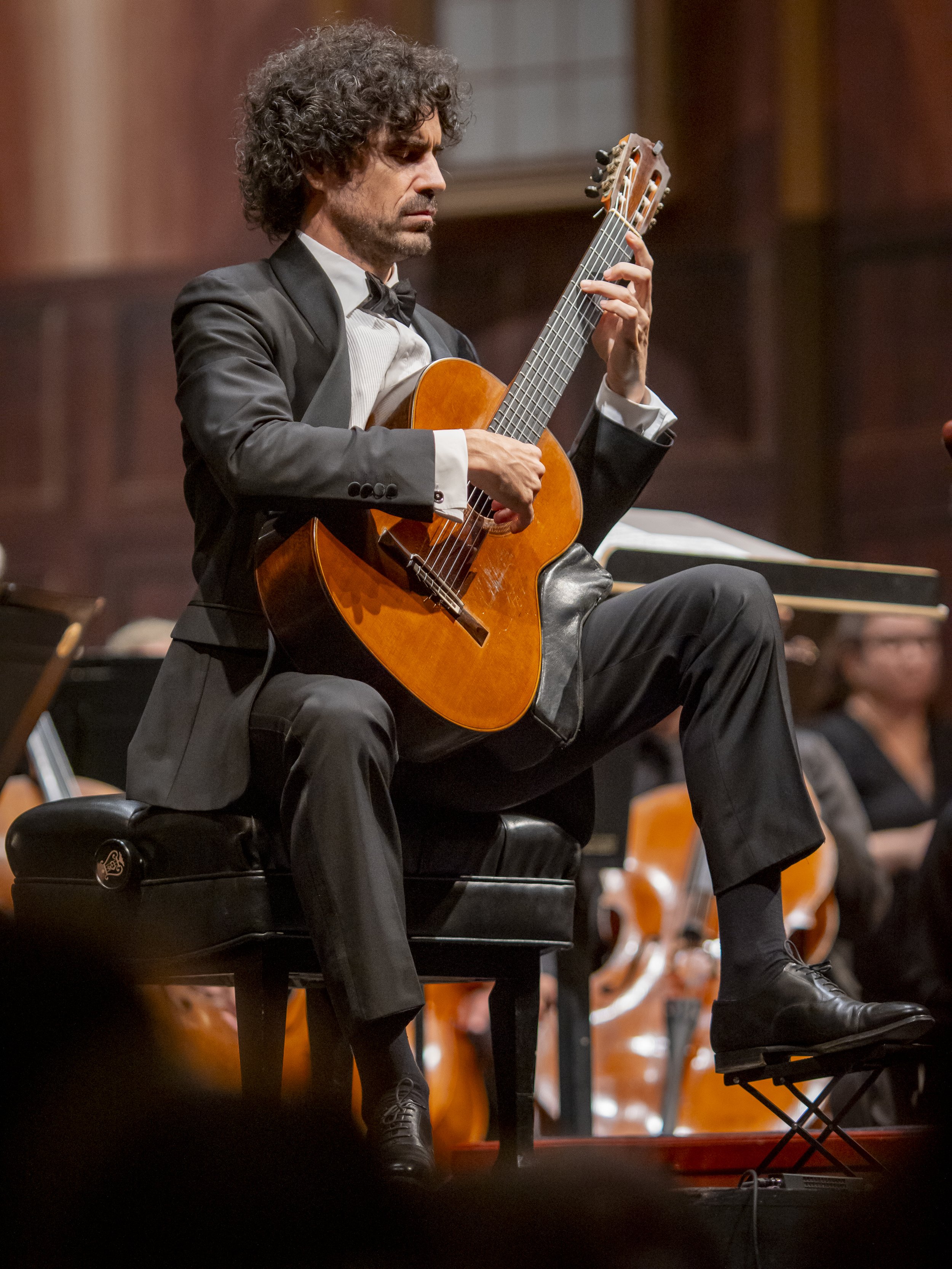

Camerata Pacifica recital in Santa Barbara on September 20, 2024
Visit Camerata Pacifica’s website
Visit violinist Paul Huang’s website
Visit pianist Gilles Vonsattel’s website
Visit cellist Santiago Cañón-Valencia’s website
Maurice Ravel - Sonata for Violin and Cello Claude Debussy - Images pour Piano, Book II Maurice Ravel - Piano Trio in A Minor for Violin, Piano, and Cello
The Synesthesiologist
I’ve been attending and reviewing Camerata Pacifica concerts off and on since its first iteration as a chamber orchestra in 1990. Artistic Director Adrian Spence’s career project has morphed considerably over the past 34 years, especially after he moved the ensemble to its present Music Academy venue in Santa Barbara and added three more southern California cities to Camerata Pacifica’s sphere of musical influence - Thousand Oaks, San Mateo, and Los Angeles.
Spence re-branded the ensemble’s purpose and personnel early on and has nurtured lifelong artistic friendships with a broad roster of chamber music colleagues over the years. The result, chamber music of unquestioned artistic merit, emotional worth, and world class technical prowess.
Camerata Pacifica’s opening recital of the 2024-2025 season in Santa Barbara at the Music Academy on September 20th featured principal artists violinist Paul Huang and pianist Gilles Vonsattel, with guest artist cellist Santiago Cañón-Valencia. Music of Ravel and Debussy.
It was during this magnificently fragile and exquisitely realized French program I experienced a major Adrian Spence epiphany. I should have known Spence never fools around; nothing gets past his finely tuned brain. My revelation? He’s been pulling a Scriabin on his audiences for decades!
Synesthesia is a neurological condition and perceptual phenomenon in which stimulation of one sensory or cognitive pathway leads to involuntary experiences in a second sensory or cognitive pathway. For Russian composer Alexander Scriabin, sounds were colors and colors were sounds. The two were experienced as one.
Camerata Pacifica’s artistic director has been gifting his audiences with a synesthetic experience at his concerts. Call me callow for not seeing/hearing Spence’s serious messaging and thoughtful intent over the years.
Using a portable theatrical stage lighting rig at all four venues upon which to hang color-capable lighting systems as needed, Spence has created an AI event if you will, conflating sound and color for his audiences. Synesthesia indeed. Marvelous!
Beyond jumping out of planes for the rush of it Spence is not, I suspect, particularly into cheap entertainments. Choices about lighting each work in Camerata Pacifica’s musical portfolio over hundreds of programs, have been made with careful, intelligent purpose. Complimenti!
Case in point, Maurice Ravel’s Sonata for Violin and Cello composed during 1920-22 and dedicated to Claude Debussy (1862-1918). Bathed in subtly changing Monet blues throughout the performance, the sound/color effect was fabulously evocative. Violinist Paul Huang and cellist Santiago Cañón-Valencia communed together with stunning ensemble passage precision, gratifying sensitivity to musical coloration, and sweet, fragile harmonics; a superb performance of the first movement, Allegro.
The second movement, Très vif, with its fascinating pizzicato opening and pitch-perfect bowed ensemble playing between the two artists, was realized with Bartók-like intensity - very exciting.
The third movement Lent, which is the very soul of the sonata with its heartbreaking cello solo opening passage joined in mourning by the fiddle, was performed by the two at a shattering level of deep sensitivity - a duet of exquisite pain and sadness. A fabulous performance. The last movement of the sonata, Vif, avec entrain, brought the work to a balanced, dancerly finish - simultaneously ironic and fateful, with a little coda of pure exhilaration as the thrilling cherry on top.
Color hues in Emerald City greens lent pianist Gilles Vonsattel ample ambiance for his wizardly performance of Claude Debussy’s piano suite Images pour Piano, Book II (1907). Cloches à travers les feuilles (Bells through the leaves) with its pentatonic tonality and flowing, watery imagery, was executed by the artist in one delicious breath of fluidity.
Et la lune descend sur le temple qui fut (And the moon descends on the temple that was) found Vonsattel in a state of superbly delicate and thoughtful meditation - a wildly intelligent interpretation, the lighting canvas easing into blues and mahoganies. Poissons d’or(Golden Fish), with its restless dashes of brilliant color and movement - the faster section of the piece a thrill of virtuoso technique - brought pianist Vonsattel’s segment of the program to an exhilarating close.
Ravel’s masterpiece from 1914 the Piano Trio in A Minor for Violin, Piano, and Cello brought this robust program of French masterpieces to a satisfying close. Bathed in soft woody lighting hues, Huang, Cañón-Valencia, and Vonsattel traversed Ravel’s 28-minute journey through four distinctly moody movements with a rich panoply of marvelous musical colors, delicate as confectioners icing.
The first movement Modéré was balance and intonation perfection, Huang’s tone color and technical control functioning splendidly in collaboration with his colleagues. No room for unconscious or frivolous playing from this crew.
Another pizzicato opening for the second movement Pantoum - Assez vif - Spence’s programmatic sensibility sparkling with intelligence - illustrated the joy and ease of Huang’s gorgeous playing in particular, while the third movement Passacaille: Très Large was just that - capacious and entirely bracing, with nearly painfully intense ensemble playing from the artists, an altogether engaging and moving experience.
The Finale: Animé featured Ravel’s innovative sense of orchestration, even for only three players. Begging the question, how can three people make so much sound, the performance was deliciously overwhelming.
Daniel Kepl| Performing Arts Review

Founder/Artistic Director Adrian Spence

Download a PDF of the review

blue hues for Ravel’s Sonata for Violin and Cello



pianist Gilles Vonsattel

browns for Ravel’s Piano Trio in A Minor for Violin, Piano, and Cello


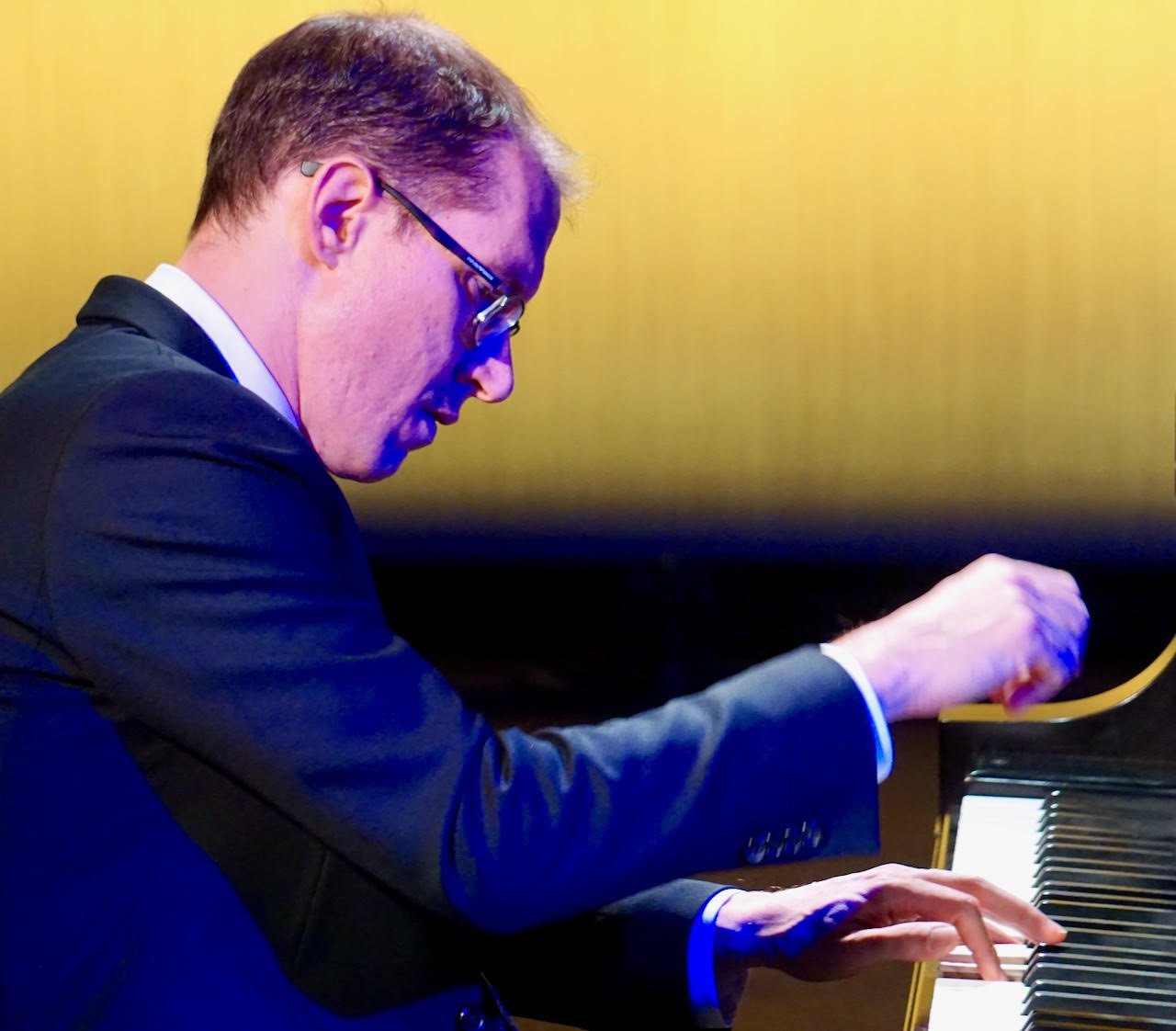

violinist Paul Huang

Cellist Santiago Cañón-Valencia

the lighting cage - from an earlier recital
Time for Three joins Santa Barbara Symphony on November 18-19 2023

Performance photos by Nik Blaskovich



State Street Ballet and Santa Barbara Symphony make history: Giselle on October 21-22 2023
Visit the State Street Ballet website
Visit the Santa Barbara Symphony website
An historic collaboration: State Street Ballet + conductor Nir Kabaretti and the Santa Barbara Symphony = a sublime full-length Giselle
For the first time in the history of collaborations between these two major organizations, the Santa Barbara Symphony was in the Granada Theatre’s orchestra pit for State Street Ballet’s season opening performances on October 21 and 22 of Adolphe Adam’s full-length romantic pantomime ballet from 1841 Giselle, one of a handful of the most famous and virtuoso ballets in the repertory.
Music and Artistic Director of the Symphony Nir Kabaretti was at the helm in the pit, and the professional dancers of State Street Ballet under new Artistic Director Megan Philipp knew it. The company was more than up to the task, achieving a high level of artistry and execution, confident the maestro would have their back. The Granada Theatre was sold out for both weekend performances.
The Giselle performance on October 22nd was music and dance heaven, top to bottom. A delicate soufflé of great beauty requiring stamina as well as virtuosity. The entire company was inspired. The principal soloist’s bravura dancing and the corps de ballet’s precise articulation took everything up a notch from the company’s already high bar.
Professional confidence, both in the pit and on stage gave the performance a magical shimmer. Studious attention to mid-nineteenth century stylized mime, to say nothing of the stunning classical ballet technique on display was matched by music making from the pit besotted in emotional power and thrall.
This gorgeous conflation of two great organizations into one spectacularly focused artistic realization of Adam’s masterpiece powered a magical aura in the room, a nimbus that everybody felt on stage and throughout the house. Fireworks, balletic and orchestral was the order of the day. Set design, lighting and staging were also of extraordinary professionalism and subtlety. This production of Giselle will remain in audience memory for a long time – the very goal of live performance art.
No stranger to Europe’s great opera houses - Vienna, Madrid, Milan, Florence, Rome, and most recently the Royal Swedish Opera in Stockholm - maestro Kabaratti has conducted ballet as well as opera in these houses and others around the world frequently. Giselle has been in his repertoire for several years, and it showed. His ease with the responsibility, his confident expertise in executing Adam’s huge two-and-a-half-hour narrative arc of dance, music and drama was thrilling to watch and hear on the 22nd.
Buoyed from working with such an experienced ballet conductor, the dancer’s artistic self-confidence became beautifully empowered. The result on stage was more than usually exciting, often spectacular. The company’s expertise in executing this historic model of virtuoso classical ballet was clearly enhanced by the company’s trust in the conductor in the pit. Risks were taken, heights were achieved.
It takes two to tango, and State Street Ballet Artistic Director Megan Philipp crafted a superb curation of Adam’s masterpiece. Attention to choreographic detail was as breathtaking as Kabaretti’s conducting. State Street Ballet has refreshed itself in recent years, hiring exciting new talent and shaping its solo and ensemble discipline to a high standard. Giselle was the perfect season-opening showpiece for the company.
The original 1841 choreography for Giselle was created by Jean Coralli and Jules Perrot. A slew of choreographers like Marius Petipa have tinkered with the original choreography since - high compliment. Over the years, Giselle has remained solid – the marvelous arc of its original Coralli/Perrot structure essentially unchanged.
The performance on the 22nd was gorgeous in execution thanks to skillful staging by Marina Fliagina, Chauncey Parsons, and Megan Philipp. Skill, flair, and the discipline of years of acquaintance with the work by the three colleagues paid off in superlatives. Nicole Thompson’s costume design was exactly what the music told us to imagine, abetted by Samantha Jelinek’s obliging lighting design, and the functional sets of Rolf Freeman, and Inland Pacific Ballet.
State Street Ballet’s principal cast were powerful acting dancers, their individual technique superb. Credibility in acting out one of the craziest stories in ballet history disarmed and was moving. Sometimes stunning to the eye, always a perfection of detailed classical ballet movement, virtuoso performances were turned in by all the principals to mind-boggling effect and audience delight. The nearly lost art of mid-nineteenth century mime was masterfully achieved by all with true Period elegance.
Breaking out Blasis’s Traité élèmentaire, théorique et pratique de l’art de la danse (1820) to describe in detail the encyclopedic footwork on display in Giselle would be exhausting. Suffice to say, Nerea Barrondo was one of the most touching and believable Giselle’s in this viewer’s memory stretching over several decades seeing the ballet in much larger cities. Her acting, demur and without affectation, her dancing delicate, fragile, deeply moving.
A finer Count Albrecht than State Street Ballet’s Ryan Lenkey would be hard to find. His stature on stage, his understanding of his character as Giselle’s almost lover, his mastery of the art of nineteenth century mime, and most importantly his believability made him a great Count Albrecht, and a solid asset for State Street Ballet. Lenkey has mastered the role.
Noam Tsivkin has been with the company since 2016 and created a character of high energy and determined resistance in his role as Hilarion, Giselle’s true love. Superb virtuoso dancing from Tsivkin was often breathtaking. Denise Grimm (Berthe), Tanner Blee (Duke of Courtland), Kaia Abraham (Bathilde), and Sergei Domrachev as Wilfred honored the provenance of Giselle with amazing character studies and solid dance virtuosity. Ditto Marika Kobayashi and Harold Mendez (Peasant Pas de deux), and a truly impressive State Street Ballet corps de ballet.



Download a PDF of the review






Theatre Group at Santa Barbara City College - Kate Hamill's Emma on October 13, 2023
Kate Hamill’s 2022 play based on Jane Austen’s last novel Emma, misses by a country mile
American actress and playwright Kate Hamill makes clear in her biographical material that when she adapts the novels of Jane Austen for theatrical presentation, 60% of the re-write is her own original material. Hamill’s boast proved uncomfortable on opening night October 13, 2023 as the Theatre Group at Santa Barbara City College presented her adaptation of Jane Austen’s subtly satirical, gently comedic, and seriously message-driven last novel Emma (1815). Playwright Hamill has turned Austen’s perceptive masterpiece into cringe worthy slapstick.
Director and instructor of acting at SBCC Theatre Arts Katie Laris set her company of student and adult amateurs an unnecessarily difficult task from the get-go by deciding to present the play in British English. The resulting mishmash of accents - questionably British, predominantly American, and otherwise unidentifiable – was regrettable. Dialects appeared and disappeared throughout the evening with the regularity of a pesky speech impediment.
Laris’ cast struggled valiantly but without much success to meet the director’s unnecessary language challenge when they could have presented the play far more successfully in American English. Playwright Hamill had, after all, turned the literary cheek by morphing Austin’s British masterpiece into American comedic schtick.
Co-chair of the Department of Theatre Arts Patricia L. Frank didn’t have much to do as Scenic and Lighting Director for Emma. Her lighting throughout the play’s two acts stayed pretty much ice cold bright, more-or-less unchanging and static - decidedly unimaginative. Her single set piece for the show, more Crusader castle than English country estate, begged the question - budget constraints?
Sound Designer Barbara Hirsch scattered credible period music samplers spanning a hundred years or so up to and around 1815 throughout the play, but considering Jane Austen was a well-known and gifted musician, Hirsch might have sought out popular pieces for fortepiano and voice (Austen sang too) from the Georgian Period; the tunes most likely to have been on hand and performed by wealthy amateurs at their country estate social gatherings (the motif for most of the play). A little research would have made for a more focused and interesting sound ambiance.
Stage movement and other blocking – the dance choreography for party and wedding scenes in particular – was an entirely improvised mess on stage - embarrassing. To her credit, Costume Designer Pamela Shaw achieved excellent results at assembling wardrobe with the look of the Napoleonic Period. Brava!
The cast for Emma - City College students with adult amateur actors from the community - needed much more artistic leadership than director Laris delivered. Lexie Brent who played the title role of Emma, was all over the map in her attempt to prod laughs from the audience. A little balancing by director Laris of these raw fluxes of temperament and accent would have redounded to Brent’s credit. Clayton Barry in the role of Mr. Knightley managed his English accent and improvised blocking with solid success – a job well done in a generally precarious ensemble acting environment.
Grace Wilson as Harriet Smith, and Jenna Scanlon as Miss Bates navigated their scenes together with rough-hewn but empathic finesse. Playing the vicar as a dandy - who came up with that one? - Mario Guerrero was permitted unfettered tastelessness as he improvised his way through a ballet of awkward moments on stage. His delivery? Indecipherable.
The character of Mr. Weston was imagined by Robert Allen as something between P.T. Barnum and Boss Tweed. At least Allen made no bones about speaking in gangster American English exclusively. A sensible decision. Anikka Abbott as Jane Fairfax, Emma’s perceived rival, managed to hold her own, despite apparently limited pedagogic help from faculty to understand at a deeper level, one of the most pivotal characters in Austin’s novel.
Luke Hamilton, who stepped into the role of the amiable young sex object and true dandy Frank Churchill, found himself also abandoned by leadership - un-coached thus uncouth in his understanding and presentation on stage of this crucial character in Austin’s novel. Other cast members – Van Riker as Mr. Woodhouse, Rachel Brown as Mrs. Weston, Lana Kanen as Mrs. Elton and a maid, and Sue Smiley as Mrs. Bates - pretty much sorted out character development on their own. It showed.
Playwright Hamill states her mission in adapting Jane Austen’s novels for the theater is about looking at Austen’s work through a 21st century lens, especially a modern woman’s perception of sexism, marriage dependency, independence, and self-worth. Jane Austen’s advocacy for women and their struggle for equal rights, the thematic subtext of all of her novels, was prescient in 1815 and more so today. Adapting her last and some say best novel for the theater is a noble project. Hamill has unfortunately missed the mark by opting for cheap laughs.
Daniel Kepl | Performing Arts Review


Download a PDF of the review






Santa Barbara Symphony launches 2023-2024 season with Beethoven's Ninth on October 14 & 15, 2023
Enjoy my review of the Santa Barbara Symphony for VOICE magazine
Visit the Santa Barbara Symphony
Visit conductor Nir Kabaretti’s website
Launching the new season in the company of musical friends
Santa Barbara’s concert season officially opened last weekend at the Granada Theatre with what has become an annual collaborative tradition. Beethoven’s eponymous “Ode to Joy” Symphony No. 9 in D minor, Op. 125 was the blockbuster main feature for this year’s kick-off concert pair by the Santa Barbara Symphony. Joining the orchestra and Nir Kabaretti were the Santa Barbara Choral Society (Jo Anne Wasserman, Artistic Director, and Conductor), Santa Barbara Community College Quire of Voyces (Nathan Kreitzer, Artistic Director), the Westmont College Choir (Daniel Gee, Director of Choral Activities), and the Adelfos Ensemble (Temmo Korisheli, Artistic Director). The four vocal soloists for the last movement of Beethoven’s Ninth were Johanna Will soprano, Christina Pezzarossi Ramsey mezzo-soprano, John Matthew Myers tenor, and Cedric Berry bass-baritone.
One constant among many in Santa Barbara’s vibrant cultural life is Santa Barbara Symphony Music and Artistic Director Nir Kabaretti. Not only is this small city on the American Riviera lucky to have such an internationally famous conductor in residence he’s a nice guy and sensitive artist to boot. Most importantly, maestro Kabaretti is devoted to contributing to our city’s artistic well-being and growth. Collaboration is his magic baton, and last weekend’s Santa Barbara Symphony season opener was the latest of several collaborations the maestro has put together over the years of his tenure here between the orchestra and other performing arts groups in Santa Barbara.
Conducting the program entirely from memory last Sunday, Kabaretti opened with a florid version of the chorus “The Promise of Living,” from Aaron Copland’s opera The Tender Land. A perfect vocal warm up for massed choirs, Copland’s elegant and inspiring music also pressed an important message home for all of us to think about in these times: “The promise of growing with faith and with knowing, is born of our sharing our love with our neighbor. The promise of ending in right understanding is peace in our hearts, peace with our neighbor.”
Franz Liszt’s Les preludes (1845-54), is probably the most famous of his 13 tone poems for orchestra. Several members of the Santa Barbara Symphony have likely performed the work many times over the years in various orchestras throughout southern California. Kabaretti took full advantage of his players’ expertise, and delivered an unusually beautiful, elegantly crafted performance of the war horse that not once lost itself in excess. Balances between sections were deliciously clean and clear to the ear (brass suspensions this listener had never heard before for example). Maestro Kabaretti led an expansive but at the same time tightly controlled performance. Memorable, and that’s saying a lot about the conductor’s rapport with his players.
After intermission, Beethoven’s still amazing, still mystifying, still profoundly moving, and essentially immortal Symphony No. 9 in D minor, Op. 125 (1822-24). For those who have just emerged from under a rock, the Symphony No. 9 was Beethoven’s last. The structure is four movements but the substance of each of those four is revolutionary, particularly the last movement, where Beethoven utilizes massed choirs, four vocal soloists, a marching band, and storm’s fury to accommodate Friedrich Schiller’s An die Freude (Ode to Joy).
Kabaretti, who has conducted Beethoven’s masterpiece on several occasions in various venues worldwide, made it clear by his relaxed but confident manner, he and his incredible orchestra were in familiar, even intimate territory. The first three movements, all instrumental, were a wonder of refinement and taste. Power when needed was rounded and beautiful, the quiet moments, as in the third movement Adagio molto e cantabile, convinced this listener Kabaretti had homeland on his mind; a supremely moving performance by all.
What hasn’t been said a thousand times about the last movement? Here’s a new truth. It’s beginning to be clear, as misunderstandings and copying mishaps of the past two hundred years are clarified and sorted out, Beethoven’s tempos were exactly what he said they were to be – fast. He even notated these fast tempos in the score using the newly invented metronome. Nobody believed him. It will take a long while to spread the word about the exhilaration of performing the last movement at Beethoven’s tempos. Here in Santa Barbara last weekend, conductor Nir Kabaretti was ahead of the pack. Fast!
The result, as choristers, orchestra, soloists, and audience alike discovered, was a whirlwind of energy as Beethoven wanted it; thrilling, fast-paced, full of surprises. The combined choirs sang with new intensity, wonderful balance, and inspiring exaltation – all brightness and fast-paced, exactly as Beethoven wanted it. Ditto the four soloists, whose narratives in ensemble and solo made for conversational not lugubrious vocal exchanges, a pleasure to enjoy on account of Kabaretti’s faster tempos.
Tenor John Matthew Myers dug in with Kabaretti and pushed the tempos of his narrative with vigor. The emotional result was breathtaking, his voice solid. Balance between the four soloists in the famous and brutal solo quartet passages found bass-baritone Cedric Berry in particularly rich low voice. Mezzo Christina Pezzarossi Ramsey made a marvel for the ears of her mid-range color and intelligent articulative maneuvers, accommodating Beethoven’s inner lines with clarity and style. Soprano Johanna Will navigated the notorious heights of her part with considerable clarity, her highest range holding well. It has to be easier to get through all those high C’s, at a faster tempo.
The Santa Barbara Symphony must have relished Kabaretti’s more correct tempos, particularly for the German marching band tune in the Alla Marcia section. As to the audience reaction to Kabaretti’s exciting helmsmanship? No kidding, the last movement held us all in a trance of excitement. During brief musical silences not a sound in the hall. Beethoven’s Choral Symphony always earns standing ovations wherever it’s performed. Audiences last weekend have probably heard and given standing ovations to many previous performances over the years. It’s that kind of masterpiece. But there was something different in the air at last weekend’s performances. Audience, choristers, soloists, musicians knew they had just performed the Ode to Joy as Beethoven intended – at last. Very exciting!
Daniel Kepl | Performing Arts Review
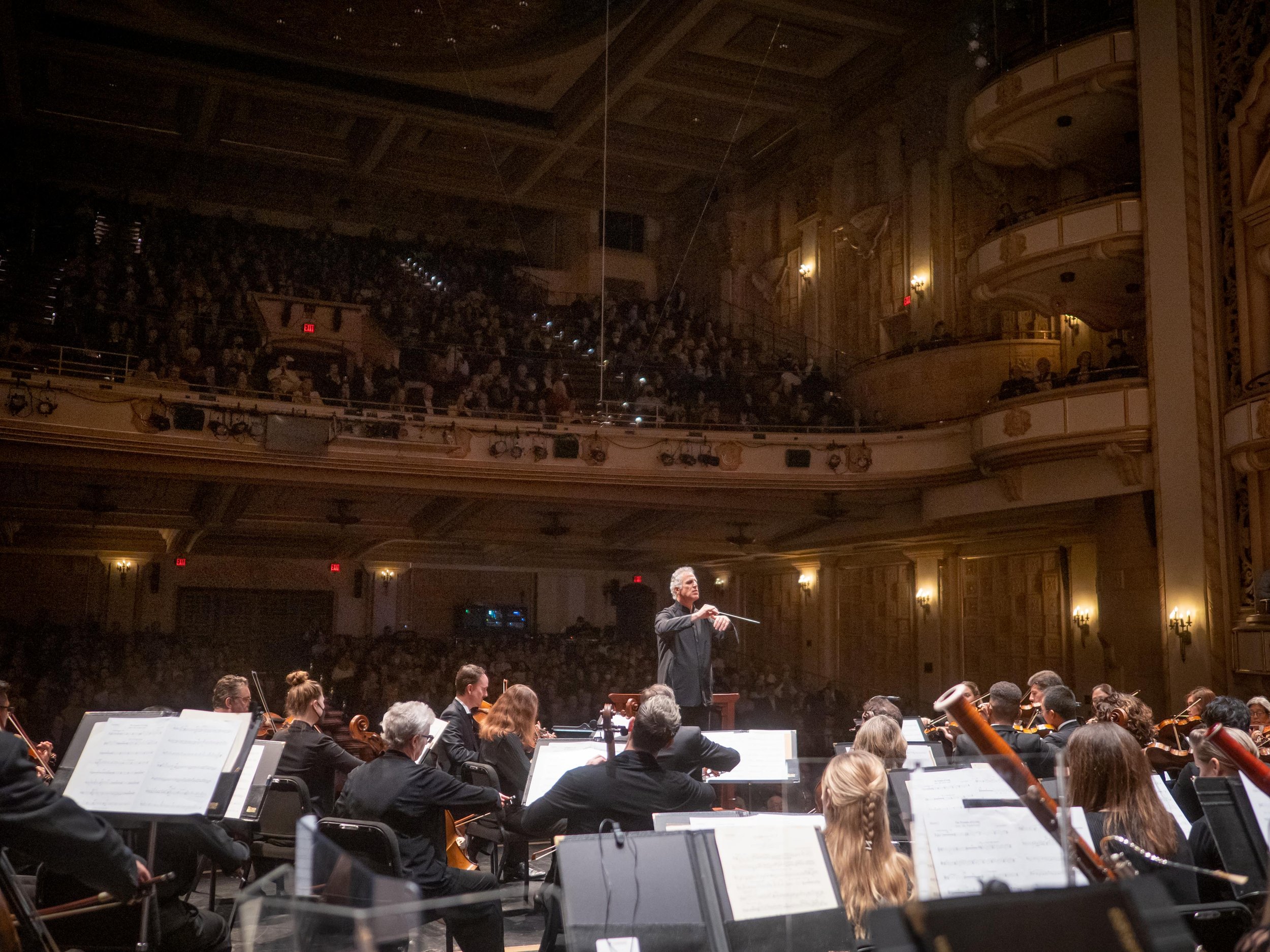

Download a PDF of the review









Larissa FastHorse's The Thanksgiving Play at Ensemble Theatre on October 7, 2023
Read my review for VOICE magazine
Visit Santa Barbara’s Ensemble Theatre Company
Visit Larissa FastHorse’s website
The Thanksgiving Play: Larissa FastHorse’s hilarious black comedy
Celebrating the art of storytelling with one of the most brilliant new plays of the last ten years, Ensemble Theatre Company opened its 45th Santa Barbara season last Saturday at the New Vic with playwright Larissa FastHorse’s The Thanksgiving Play, a drop dead funny (tasteless pun intended), mercilessly eviscerating examination of white America’s “attempt to reconcile the weight of historical inaccuracies with the desire for inclusion and sensitivity,” as the award-winning director for this production, Brian McDonald remarks in his program note.
Highlighting with slashing stilettos of mirth, the tragicomic absurdity in recent years of well-intentioned but naïve attempts by white Americans to make up for what playwright FastHorse (Sicangu Lakota Nation) calls “the longest black comedy in the world,” her funny as an acid bath 2015 masterpiece, which received its Broadway debut in 2023, doesn’t need to mention the near total extermination by the US government of Native Americans over the past couple hundred years to make it’s point; silly platitudes and twisted word salads do not adequately compensate for countless trails of tears, and Wounded Knees. FastHorse, a 2020-2025 MacArthur Fellow, makes it punishingly clear that indigenous peoples understand cycles – there’s nothing new in the white man’s talk, it just goes round and round.
Four superlative professionals, all masterfully intuitive in understanding the substance or lack thereof of their characters, were also acutely attuned to each other on stage at last Saturday’s opening of The Thanksgiving Play. The split-second timing required for successful comedic interaction between the four sparkled with energy. FastHorse’s 90-minute dark comedy danced with wry spirit and agile consequence. Numberless nuanced subtexts and gossamer allusions to Native American terrors past, present, and future sped by, greased with slick, laughter-wracked schtick and timing. Director McDonald did not miss a single opportunity for swift verbal punch or sub-textual superlatives. This cast was surely a dream come true of ensemble creativity and interaction.
The four characters are all white, one of several FastHorse cannonades about who tells history’s tale - the victors. Los Angeles-based Devin Sidel played the earnest if for all the wrong reasons Logan, director in charge of creating a new, politically correct version of the traditional and traditionally wrong First Thanksgiving story. Sidell’s hyperventilated unctuous cloying, her supplications to colleagues about collaboration and community, her rituals of desperate “method,” and her borderline hysterical, usually simultaneous episodes of inspirational hypertension and exhausted fetal retreat made for priceless dollops of comedic opportunity and character caricature. Sidell was on top of every swift-moving gaff and verbal pitfall at last Saturday’s opening – her character fragile intellectually, and shallow in leadership skills.
Aging surfer and occasional theatrical hire, the “cool” character of Jaxton was given perfect Hollywood casting couch insouciance by Los Angeles-based Adam Hagenbuch, no stranger to the endless audition game himself. Jaxton becomes, in Hagenbuch’s crafting of the character, the most rational member of this somewhat squirrely foursome. Jaxton is at least certain of his own certainty, while the others grasp at intellectual and emotional straws. A wonderfully subtle, warmly comedic, and vibrantly human character study by Hagenbuch in his Ensemble Theatre Company debut.
The role of schoolteacher and wannabe playwright Caden is juicy, and southern California-based Will Block escalated his character’s increasingly manic behavior by slow degrees, on a spit of comedic edginess. Quite perfectly over the top from time to time, no easy task, Caden’s character is in a way the most genuine manifestation of emotional truth of the four principals. Walking a tightrope between antipodes of excessive flourish and solid history, Block gave Caden an aura of real if fractious humanity.
Los Angeles-based but more importantly, daughter of the Jersey shore Ashley Platz, turned the dangerous role of sexy but dumb Alicia into a triumph of understated comedic chutzpah. The slightest flaw in empathic understanding of her character, the briefest failure at cha-ching gotcha statement and response synchronicity, a faltering in any way of Alicia’s disarming charms and hilarious mind to mouth faux pas could easily have plunged the character into the dross of stereotype. Platz’ understated exultation of Alicia was, put simply, brilliant.
A single but somehow engrossing set piece by scenic and lighting designer Mike Billings - an elementary school classroom where the four hapless colleagues gather to improvise their way toward collective Thanksgiving consciousness - worked like a charm; chairs and a settee being the means, by which scene variety could be actualized visually. Costume designer Abra Flores dressed her four charges in contemporary So-Cal rehearsal garb, adding a little snigger perhaps, with the character Logan’s ensemble of implied if nerdy authority. Separating scene breaks with devilish funny videos of kids in Pilgrim couture singing blasphemous, ill-fitting Turkey Day lyrics to Christmas favorites was the clever work of Randall Robert Tico, his 17th original music and sound design project for Ensemble Theatre.
Above all, director Brian McDonald deserves kudos with laurels, for a tight, brilliantly staged, diction-perfect – I understood every word – clockwork of precisely timed comedic virtuosity. His spectacular ensemble cast presented a masterpiece in masterful manner.
There’s more though, and it’s what makes FastHorse one of America’s most important playwrights. The number and urgency of issues addressed with wit and forgiving irony in The Thanksgiving Play nevertheless culminate in a fascinating, Godot-like enigma at the very end of the play. Maybe the journey isn’t about becoming anything, but rather about unbecoming everything, so human beings can be what they were meant to be in the first place.
Daniel Kepl | Performing Arts Review


Download a PDF of the review


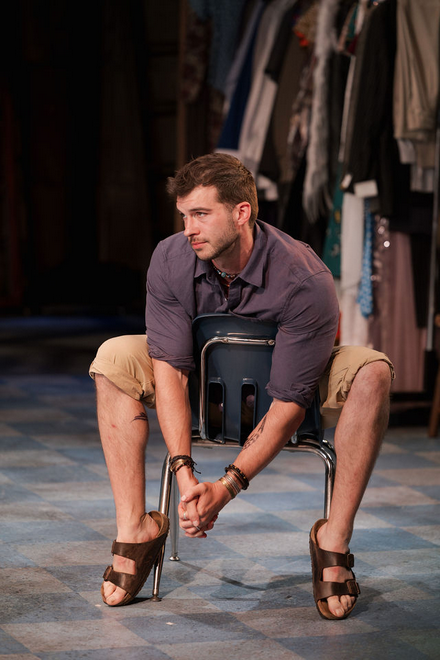



Opera Santa Barbara's 2023-24 season opener: Bizet's Carmen on Friday, September 29, 2023
Visit Opera Santa Barbara
Read my review for VOICE magazine
A Carmen Harvest Moon
Coincidence or sorcery? Opera Santa Barbara’s Artistic and General Director Kostis Protopapas has earned plaudits over the years for his passion about possibilities, operatic and otherwise. But is it a stretch imagining him calculating opening night of the 2023-2024 Opera Santa Barbara season to overlap precisely with a gloaming Harvest Moon, coerced by the ghosts of the unsettled dead that linger in the liminal space between life and death, day and night? Short answer - No!
Last Friday’s OSB presentation at the Granada Theatre of Georges Bizet’s avant-garde for its time (1875) operatic treatment of Prosper Mérimée’s novella Carmen found audience and artists alike shimmering with close moon encounter syndrome. The energy in the house and on the street as the Harvest Moon manifested gigantically over downtown Santa Barbara at intermission was pure Tesla – electrifying.
Bizet’s anti-heroine Carmen is a cigar smoking, cigarette-selling, willful and sexually independent ghetto-bred Gypsy prostitute. Her fate is a conflation of metaphors, perfect for last weekend’s Harvest Moon with its blood-orange color and off-putting size. The city in which Bizet’s opera plays out, Sevilla, Spain is also famous for its blood oranges, as well as its blood sport.
A crucial set piece in the opera, the arena in which bulls are sacrificed for the entertainment of cheering masses by Carmen’s lover, the toreador Escamillo, is at least a properly ceremonial execution site, if bullfighting can be considered proper at all. Carmen’s murder by her jealous and jilted suitor Don José takes place importantly, outside the bullring, a very public and maladroit stabbing on the seedy streets from which Carmen had emerged for a while at least, independent.
Making her OSB debut, California-raised Mexican American mezzo-soprano Sarah Saturnino grabbed the role of Carmen by its sexual revolutionary bootstraps and ran with it on opening night. Impeccable French articulation, a genuinely sultry and room-filling vocal capability in all registers including Bizet’s challenging writing for the lowest mezzo range, and most importantly a powerful, barely contained mastery of nuanced acting in all its potency and bittersweet rage, then fear, then resignation as the opera makes its inevitable procession, like Escamillo’s into the bullring, toward an all too human catastrophe - blind jealousy and pointless retribution.
Sevilla isn’t anything like Kansas Toto, nor Santa Maria where he presently resides, but tenor Nathan Granner in his first embrace of the complex role of Don José, corporal of dragoons and poster boy for jilted yearning and out of control machismo hyperbole (read violence), spun his debut in the role last Friday to vocally stunning heights. Last seen with OSB in 2018 (Rodolfo in La bohème) and 2022 (Alfredo in La Traviata) his singing and acting last Friday brought the house down for its punchy prowess and magnificent tone quality – a memorable realization of the role.
Chinese American bass-baritone and Santa Barbara resident Colin Ramsey has been seen in five Opera Santa Barbara productions since 2017. Taking to the role of Carmen’s most recent lover the toreador Escamillo as snugly as the character’s tight-fitting Taleguilla, Ramsey offered Friday’s audience a character study in the subtle narcissism appropriate for a popular bullring celebrity and full-time gigolo. His addictive chocolatey vocal timbre clinched the heady spell he presented on stage in his debut interpretation of the role.
Soprano Anya Matanovic has been seen in three Opera Santa Barbara productions, The Crucible (2019), Das Rheingold (2021) and La Traviata (2022). Her role as Micaëla in Carmen is small, but the music Bizet gives her character is monumental. Micaëla’s duo with Don José, Parle-moi de ma mere (Tell me about my mother), and her solo aria, Je dis que rien m’epouvante (Nothing Scares Me), gave Matanovic’s bright, cleanly articulated voice, with its rich endowment in high register finesse and middle register warmth, opportunity to nearly steal the show.
So many to congratulate, so Little space! Soprano Sunwoo Park (Frasquita), Mezzo-soprano Max Potter (Mercedes), baritone Omar Alejandro Rodriguez (Le Dancaire), tenor Kyle Rudolf (El Remendado), baritone Matthew Peterson (Zuniga), and in his debut with OSB, baritone Michael Segura (Moralès) – a wonderful ensemble cast of virtuoso singing actors.
Stage director Fenlon Lamb made the most of Dahl Delu’s modest but extremely functional set design, enhanced immeasurably and imaginatively by Daniel B. Chapman’s lively, colorful, and message-driven video and still projections. Helena Kuukka’s lighting design was a collaborative masterstroke of additional visual enhancement – a fabulous team, Chapman and Kuukka.
Chorus master, principal pianist, and director of the Chrisman Studio Program at OSB Timothy Accurso trained the OSB chorus admirably – some tricky bits in that score! Julija Zonic’s fabulous Ojai Pixies tackled the important children’s chorus sections in Carmen with not just cute aplomb, but real professional training; balanced voicing, excellent diction, and solid intonation. Choreographer Cecily MacDougall (State Street Ballet) sprinkled several virtuoso duo sequences for dancers Ethan Ahuero and Rachel Hutsell throughout the opera’s four acts, that wowed.
In charge of it all, maestro Protopapas held forth from the pit with benign pleasure and decades of experience producing and conducting Bizet’s masterpiece under his belt. Perhaps it was the ominous video projections of the full moon rising over the smuggler’s mountain hideaway in Act III where Carmen has her death premonition, that convinced this attendee Santa Barbara’s operatic future is in good hands. By the way, Friday night’s Granada performance was sold-out, and I’m told ditto for Sunday’s matinee.
Daniel Kepl | Performing Arts Review


Download a PDF of the review





Music Academy Festival Orchestra concert on August 5, 2023 with Hannu Lintu
Read my review for VOICE magazine
Visit conductor Hannu Lintu’s website
Finnish Conductor Hannu Lintu: Painting Big Pictures
Bringing to vivid life, through a tsunami of orchestral color and valorous sound pageantry, two of the most explicitly narrative tone poems of the Romantic era, Richard Strauss’ monumental 55 minute long through-composed masterpiece, Ein Heldenleben: A Hero’s Life, Op. 40 (1898) and Tchaikovsky’s eponymous tribute to eternal love, the Overture-Fantasia Romeo and Juliet (1880), the Music Academy Festival Orchestra wrapped their 2023 summer season last Saturday at the Granada Theatre.
Tall, lean, long armed, and possibly endowed with extra digits on each of his ten fingers, Finnish conductor Hannu Lintu, Chief Conductor of Finnish National Opera and Ballet, wrapped his mind, body, and expressive arms around the task of painting these two graphic musical narratives in a manner that might illuminate and inspire. He succeeded handsomely.
Strauss calls for an enormous orchestra for Ein Heldenleben which opened Saturday’s concert. Several Music Academy faculty members joined the orchestra Fellows to help achieve the composer’s sonic demands. Nine horns, two harps, and two E-flat trumpets boosted the already huge string, wind, brass, and percussion sections of the orchestra to manifest a glimpse into the composer’s massive vision; nothing less than an expression through music, of the pan-Germanic ideal taking shape in the last part of the nineteenth century that ultimately became the modern German state.
Though performed without pause, Ein Heldenleben does segue through several episodic changes in temperament and mood. Strauss later withdrew reference to specific section titles after audiences began to think the work might be about his own life story, filled as Ein Heldenleben is with musical motifs from Strauss’ other tone poems – Also sprach Zarathustra, Till Eulenspiegel, Don Quixote, Don Juan, and Death and Transfiguration.
The hero motif is intoned at the beginning of the piece, the hero’s adversaries are musically diagrammed next, and the obligatory love companion is exquisitely developed musically in the third sequence of the tone poem. Battle scenes and works of peace that follow victory serve as denouement to the hero’s ultimate retirement from this world and completion of life’s journey.
No stranger to the art of illuminating all manner of complex visual/musical scenes in his role as Chief Conductor at Finnish National Opera, Lintu danced and prowled the tiny confines of the Granada’s podium, leaning precariously this way, then that as he addressed various matters of balance, color, and subtext in Strauss’ magnum opus. During the battle sequence, which contains some of the most powerful brass ensemble writing in the repertoire, Lintu flung his arms in cyclonic fits on more than one occasion to describe the imaginary scene. The Festival Orchestra responded appropriately, caught in the conductor’s overwhelming energy vortex.
Making nearly tangible his long-armed embrace of the entire orchestra during spacious arcs of lush string sound or broad woodwind passages, Lintu inhaled his colleagues’ enthusiasm to please, and exhaled with every sinew of his lithe physique and expressive intellect wave after wave of simply gorgeous music making. The hour-long Ein Heldenleben narrative flew by. That’s synergy.
After a needed intermission to gossip about the epic Strauss tone poem just heard, Lintu and the Festival Orchestra gave us exactly what we needed to wind down the evening, Tchaikovsky’s bittersweet yet somehow hopeful tone poem Romeo and Juliet, in a performance that shimmered with well-prepared sectional balances, featured carefully tapered and extended phrasing, and focused the confrontational sequences between rival Montague and Capulet clans on the musical virtues of clean articulation and controlled dynamic. A first-rate performance.
Daniel Kepl | Performing Arts Review
Music Academy Festival Orchestra concert on July 29, 2023 with conductor JoAnn Falletta
Enjoy reading my review for VOICE magazine
Visit JoAnn Falletta’s website
JoAnn Falletta: Surprises & Satisfactions
American conductor JoAnn Falletta is one of those extraordinary forces of art and nature who tears the fabric of convention to shreds but always tidies up the scene of each of her several apotheoses. Importantly, she never looks back.
The litany of orchestras Falletta has helmed and recordings she’s made is legion. Watching her conduct last Saturday’s Music Academy Festival Orchestra concert at the Granada Theatre in Santa Barbara, a concoction of spicy magical realism (Roberto Sierra’s Fandangos), French angst (Maurice Ravel’s La Valse), and Russian mystery (Sergei Rachmaninoff’s Symphonic Dances, Op. 45), it became clear immediately, Falletta was not just in charge but in supreme command of every color-filled, rhythm-bursting moment of Fandangos and later, the Ravel (a revelatory performance), and moody Rachmaninoff.
Walking onto the Granada stage looking for all the world like a worried mom fussing over her massive family of musicians, Falletta’s conducting – straight and clean and clear, but not particularly charismatic – did not in the first nanoseconds of the evening appear to be lighting any fires. Then the high brass fanfares began in the opening moments of the Sierra piece – unique sparkles of thrillingly complicated color.
Falletta, still no-nonsense about stick technique, nevertheless began a slow melt into a subtler and palpably effective body language of rhythm and pulse that successfully lured her colleagues into a slow-dance crescendo of such excited intensity the piece reached full rollicking throttle while the audience held its breath; a spectacular take by Roberto Sierra on two earlier fandangos by predecessors Soler and Boccherini. The orchestra, now thoroughly seasoned as an ensemble for this, its next to last concert of the summer season, gave Fandangos a slick performance, and Falletta 120% of their attention.
Before conducting Maurice Ravel’s La valse (1919-1920), JoAnn Falletta took a few minutes to instruct the audience about the piece. Both La valse and his other masterpiece Boléro (1928) hold profound messages in their harmonic and structural incongruities. Ravel, a survivor barely, of World War I, was injured physically and psychologically by the experience. La Valse, like Boléro, eventually collapses of its own weight and hysteria; the waltz pattern in La valse is a musical totem to antebellum Europe, washed away in a confused tidal wave of blood and despair.
The opening bars, conducted by Falletta as a throbbing heartbeat, were just the first of several interpretive revelations brought to the listener’s attention. Little pockets of color not noticed before came into audible play under Falletta’s microscopic attentions. And with unerring noblesse oblige, Falletta advocated on behalf of Ravel’s sense of outrage about the effects of world conflict on societies. Finesse and elasticity of bar line, orchestral sighs and pouts, ominous forebodings from the bottom of the orchestra that build to its hysterical climax – made for a particularly thoughtful and inspired interpretation of La valse.
Sergei Rachmaninoff’s last major composition, the Symphonic Dances, Op. 45 (1940), were created during the composer’s only stay in the United States at Centerport, New York, overlooking Long Island Sound. Eugene Ormandy and the Philadelphia Orchestra premiered the work in January 1941, as another world war began to ravage the European continent, including the composer’s homeland.
Falletta and the Festival Orchestra plumbed the richly Russo-nostalgic three dances of the suite with particular emphasis on Rachmaninoff’s gorgeous orchestrations, including his lush string writing, which Falletta dug into with unabashed gusto. Balances throughout and between various sections of the orchestra were carefully tweaked by the conductor for maximum color.
If heartbreak were an instrument, Rachmaninoff’s use of alto sax, his breathtaking melodies for high strings, his orchestral whispers and sighs describe the composer’s homesickness for Russia with unadulterated, post-revolution passion. Falletta, whose powers of persuasion are those of a goddess – gentle, and without error – gave her Festival Orchestra colleagues several lessons in the art of interpretation, and her audience several opportunities to cheer.
Daniel Kepl | Performing Arts Review


Download a PDF of the review






Music Academy Festival Orchestra & Chorus concert on July 1, 2023
Read my review for VOICE magazine
Visit the Music Academy
Visit conductor Osmo Vänskä’s website
Visit American composer Jessie Montgomery’s website
Conductor Osmo Vänskä - From Here to Eternity
A Nicola Tesla of the podium, conducting energy instead of notes, allowing musical phrases to soar by not controlling them, Grammy winning Finnish conductor Osmo Vänskä led the Music Academy Festival Orchestra and Festival Chorus in an eclectic program last Saturday night at the Granada Theatre that also electrified for its successful destruction of the bar line. Sometimes hard to follow, Vänskä’s gestures and cues were more about endorphins than textbook technique. The conductor successfully convinced his colleagues in the orchestra to trust intuition and impulse, his and theirs, go out on more than a few musical limbs with him, and by taking such risks discover the magic and freedom of unbridled expression.
Music by Leonard Bernstein, the Overture to his 1956 operetta Candide; American composer Jessie Montgomery, the West Coast premiere of her Hymn for Everyone, which enjoyed its first performance by the Chicago Symphony this past April; and Gustav Holst’s enduring masterpiece from 1914-1917, The Planets, Op. 32, found Vänskä’s presence on stage – a roiling Delphic oracle – inspired and purposeful.
Conductor Laureate of the Minnesota Orchestra and now guest conductor to the world, Vänskä’s is a technique that while often nearly incomprehensible to the eye, achieves stunning artistic result. This follower of Music Academy concerts since the early 1960s was reminded of the legendary conducting machinations of Maurice Abravanel. Vänskä like Abravanel, is all over the place between bar lines, often crashing into guardrails of structural order in the name of elastic phrasing. But when push comes to shove - those moments when an orchestra needs a traffic cop to keep it all together - Vänskä is crystal clear in his movement and focus, as was Abravanel.
From the opening fanfare of the Overture to Candide it was clear something different, even revelatory was afoot in Vänskä’s interpretation of this popular concert opener. Fluid, textured, easy going in its various raptures and feints, the maestro’s coaxing and shaping of the musical narrative was a symphony of intuitive movement liberated from strict stick technique. The orchestra in turn plunged into the deep end of nuance with their chief, and together they gave the full house at the Granada Theatre a truly rapturous and joyful performance.
American composer Jessie Montgomery is finishing her third and final year as the Mead Composer-in-Residence of the Chicago Symphony Orchestra. Her Hymn for Everyone, premiered by the Chicago Symphony in April 2023 and receiving its West Coast premiere last Saturday, is the last of three commissions during her residency. A meditation on memory and loss, Hymn for Everyone is in the composer’s own words, “a bit of a catharsis,” created during the isolation of COVID and speaking to its aftershocks, while also reflecting on the death of Montgomery’s mother in 2021.
Conducting this new work with precise due-diligence, Vänskä embraced and nurtured the low unison dirge that opens and sets the mood for all that follows. Montgomery’s orchestrations invoke ecstasy as easily as atonement, particularly a few minutes into the piece, when the dark opening dirge becomes briefly ecstatic – fabulous messaging. Montgomery’s subtle color constructs, including some fascinating unison instrumental pairings like high strings and tuba, revealed a keen understanding of musical color as psychological epiphany. Hymn for Everyone reaches a final breaking point – relentless dirge rhythms from a massive percussion battery, then softens to a clarinet meditation with other solo winds and strings, and softly out.
Gustav Holst (1874-1934) began work on his seven-movement exploration of the inner and outer planets of our Solar System, The Planets, Op. 32, in 1914 and somehow managed to complete the suite by 1917 while World War One raged around him. It should be no surprise The Planets is far more than its astronomical nomenclature. Maestro Vänskä became, not to take this metaphor much further, a Tesla Coil of conducting energy and leadership from the first ominous drumbeats of Mars, straight through the gloriously achieved sirens (thanks, William Long, Festival Chorus chorusmaster) of the final movement, Neptune.
Highlights: sonic thrills as only the Music Academy Festival Orchestra can muster, in an edge-of-seat performance of Mars, Vänskä winding up the tension and drama of “the Bringer of War” to near hysterical levels. We all loved it. A shimmering performance of the surreal second movement, Venus, the Bringer of Peace; a superbly conducted and masterfully executed performance of the lively third movement, Mercury, the Winged Messenger; a lovingly conducted fourth movement, Jupiter, the Bringer of Jollity with its always moving anthem, now Britain’s national hymn, I Vow to Thee, My Country.
The stunning power of Vänskä’s body movements, oozing rhythm and energy even in stasis during Saturn, the Bringer of Old Age; the fabulous musical storytelling of Uranus, the Magician; and as mentioned earlier, the mystical allure of eternity as beautifully realized by the backstage chorus in Neptune, the Mystic.
Daniel Kepl | Performing Arts Review
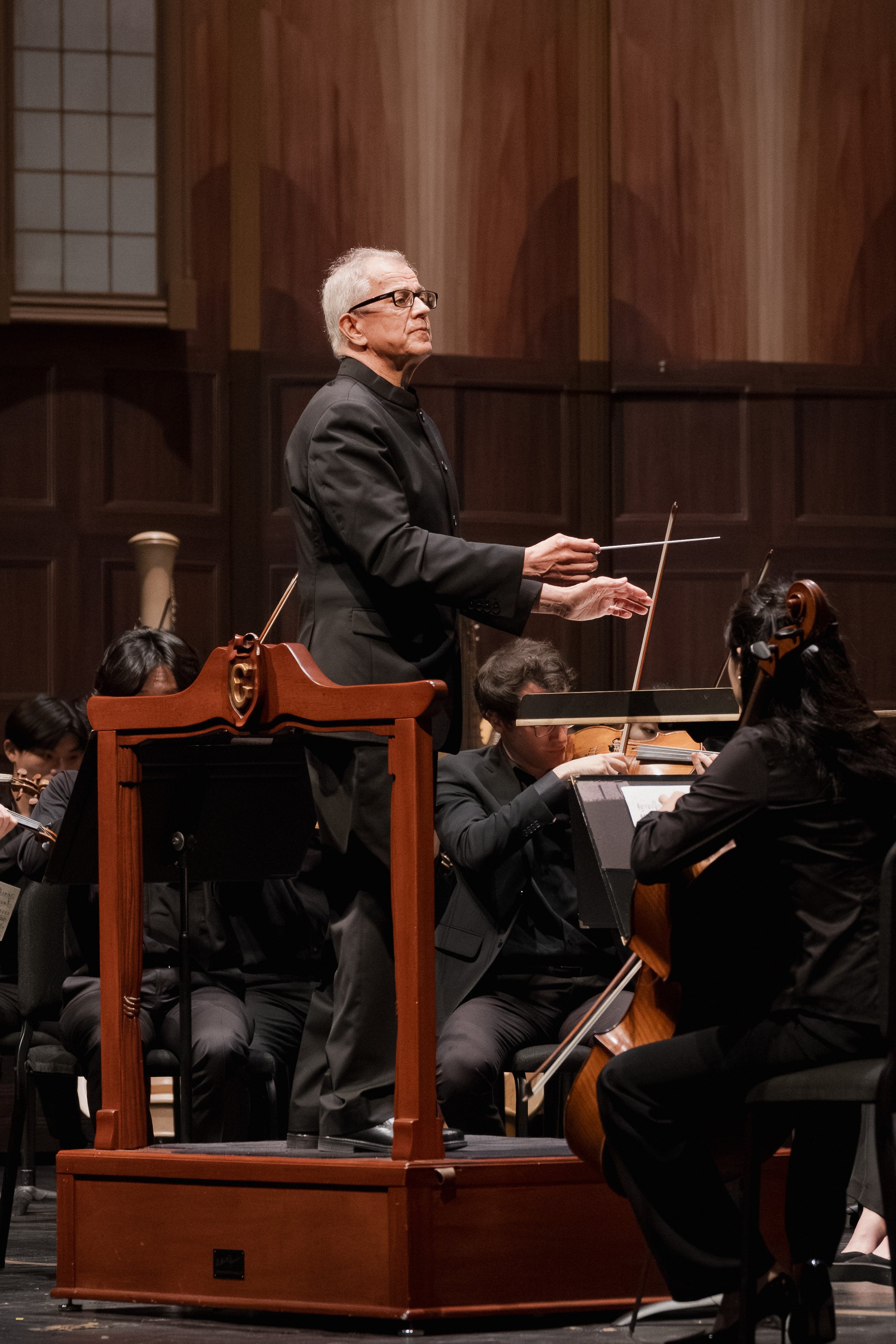
Osmo Vänskä conducting the Music Academy Festival Orchestra on July 1, 2023 at Santa Barbara's Granada Theatre - photos by Zach Mendez

Download a PDF of the review

American composer Jessie Montgomery receives applause after the West Coast Premiere of her new work, Hymn for Everyone




Music Academy Festival Orchestra on June 24, 2023: all Berlioz concert
Read my review for VOICE magazine
Visit the Music Academy
Visit conductor Stéphane Denève’s website
Visit mezzo-soprano Sasha Cooke’s website
All Berlioz program - Beauty and the Beast!
Alchemy, witches cauldrons, death by execution, summer nights both sanguine and otherwise; a Julia Childs masterpiece of sweet and savory sounds stirred up last Saturday’s Academy Festival Orchestra program at the Granada Theatre. Featuring the Music Academy’s Lehrer Vocal Institute co-chair, mezzo-soprano Sasha Cooke, in a radiant performance of the composer’s 1841 song cycle Les Nuits d’été (Summer Nights) Op. 7 and concluding – how could it have been otherwise? - with Berlioz’ 1830 hallucinogenic opium trip, Symphonie fantastique, Op. 14, the concert left the audience spellbound and punch drunk. A glorious night!
French conductor Stéphane Denève chaired the first Festival Orchestra concert of the 2023 Music Academy summer season with, well, aplomb. Perhaps it was the maestro’s atavistic kinship with the stunningly curated all Hector Berlioz program Saturday that added a certain delicious ensouciance to his manner? Maybe it was the professional performance level of this season’s Music Academy Fellows, gathered from around the world for their first rehearsals just days ago, that lit the flame of inspiration?
No matter. Maestro Denève offered his orchestra colleagues a masterclass in meticulous conductorial nuance and subtlety. Even the thrilling execution and witches sabbath movements of the Symphonie fantastique grazed the lower depths of orchestral color and the upper reaches of sonic apocalypse with an ever-present collective sense of taste and forbearance. How French! The orchestra delivered sound imagery to match each of Denève’s dynamic shadings, emotional sighs, and explosive sound bombs. Berlioz’ many-splendored chimeras came to life like vivid holograms from distant worlds.
Two-time GRAMMY Award-winning mezzo-soprano Sasha Cooke, a 2002 Music Academy graduate, is enjoying her first summer season as Co-Director of the Academy’s Lehrer Vocal Institute. Her public performance debut in the new position last Saturday was sublime for its understatement. Maestro Denève, acutely aware the original version of Berlioz’ song cycle Les nuits d’été (1841) was for soloist and piano, reined in the dynamics of the composer’s later orchestrations (1843, 1856) last Saturday, creating a performance so hushed, reverent, and mystical, the full house at the Granada fell profoundly silent through the entirety of the six song cycle, to poems from La comédie de la mort (The Comedy of Death) by Théophile Gautier (1811-1872) – Villanelle (When the new season comes); Le spectre de la rose (The spectre of the rose); Sur les lagunes (On the lagoons); Absence; Au cimetière (In the cemetary); and L’ile inconnue (The unknowable isle).
A template of Berlioz’ utterly unique orchestrating genius, Les Nuits are masterpieces of restraint, never covering the soloist, particularly in the lower reaches of the mezzo range. Maestro Denève brought the orchestra to a kind of meditative calm, the occasional swirls and currents in the darker poems controlled by the sensibility of the conductor’s body signals. Understanding his duty to the original concept (piano), Denève coaxed colors from Berlioz’ orchestrations that were complex yet gossamer, distant, feather light. Cooke’s voice, sustained gently by her collaborators, was a balm of unstrained thus beautifully shaped, pure mezzo-soprano heaven.
As if making up for the restraints conditional to an artistically satisfying performance of Les nuits, the after-intermission performance of Berlioz’ Symphonie fantastique, while beautifully crafted and shaped with elegance and refinement throughout, nevertheless gave everybody in the room what they wanted, a Music Academy E-ticket to glory! Conducting the massive five movement Épisode de la vie d'un artiste with a combination of intense focus on dynamic nuance and rubato (the first three movements) and flat out “off with their heads” fun – March to the Scaffold and Dream of a Witches’ Sabbath, Denève seemed pleased to show off this summer’s new batch of orchestral chops. Fabulous ensemble string cohesion that was lush and articulate; punchy winds capable apparently, of just about anything; a brass section to take home to mom; and a percussion battery capable of marching on Moscow. Wow!
Daniel Kepl | Performing Arts Review

French conductor Stéphan Denève - photos by Zach Mendez

Download a PDF of the review





Santa Barbara Symphony Concert on May 14, 2023: Platinum Sounds
Read my review in VOICE magazine
Visit the Santa Barbara Symphony
Visit composer Jonathan Leshnoff’s website
Visit violinist Philippe Quint’s website
Read about Music and Artistic Director Nir Kabaretti
Seventieth Season Finale – Mendelssohn and Milestones
The Santa Barbara Symphony wound down its 70th concert season last weekend at the Granada Theatre with a program that remembered the recent past with a fresh performance of Jonathan Leshnoff’s Concerto Grosso, premiered here as a Santa Barbara Symphony commission in 2013, continued with an old friend as soloist, violinist Philippe Quint playing Mendelssohn’s Violin Concerto in E minor, Op. 64, and burned the barn down with a stunning performance of Brahms’ Symphony No. 1 in C minor, Op. 68. Platinum sounds, indeed.
Music and Artistic Director Nir Kabaretti, who conducted the premiere of Jonathan Leshnoff’s Concerto Grosso ten years ago, gave the work new life and meaning at last Sunday’s performance. In four movements and featuring the principal players of the orchestra as soloists in various combinations, Concerto Grosso has aged beautifully. A modern work cloaked in Baroque structure and etiquette, the first movement featured two solo violins, Jessica Guideri (concertmaster) and Ryo Usami (principal second). With Kabaretti chaperoning, the two blended together beautifully in their various exchanges, while the orchestra chattered approval, punctuating the discourse from time to time with pithy orchestral commentary.
The second movement highlighted the virtuosity of principal horn (Teag Reaves), principal trumpet (Jon Lewis), principal trombone (Dillon MacIntyre), principal cello (Trevor Handy), and harpsichord (principal pianist Natasha Kislenko). Leshnoff has composed a delicious mood mash-up for this movement. Quasi-Baroque sentiment, semi-Andalusian color, and Hindemith-like tidiness rewarded the listener with a plethora of little bonuses, like the lovely unison passagework that melded muted trumpet and cello colors, or the magical opening solo cello figure that cast a spell over the entire movement. Marvelous.
The third section of Concerto Grosso featured principal winds – Amy Tatum (flute), Lara Wickes (oboe), Don Foster (clarinet), and Andy Radford (bassoon), with a touch of harp for added lightness (Michelle Temple). Leshnoff’s color palette for the orchestral support team included besides harp, mallet percussion (xylophone), and other feathery orchestral colors to enhance the delicate yet glittery passages for the ensemble of wind soloists. Imaginative orchestration.
With the re-appearance on stage of the two violin soloists, the last movement of Concerto Grosso presented a grand finale for all 11 soloists and orchestra. What a difference ten years of artistic growth can make. I remember the premiere of Concerto Grosso in 2013, a rather head-in-the-music affair like most premieres. Last Sunday’s performance danced with energy, color, and bright optimism; a tribute to the orchestra’s ensemble cohesion and growth over the past decade under Nir Kabaretti’s steady helm.
It’s always a treat to welcome special friends of the Santa Barbara Symphony back for important occasions, and the 70th anniversary of our orchestra’s founding (1953) was perfect for a return visit by violinist Philippe Quint, who knocked Mendelssohn’s Violin Concerto in E minor, Op. 64 out of the concert hall ballpark. Rapport is everything when jointly discerning the minutia of a profound and emotionally complicated work. The Quint/Kabaretti collusion was an exercise in mind-bending intellectual as well as musical exhilaration. Quint’s big, sometimes deliberately raw sound during various machinations in the first movement, Allegro molto appassionato, made it clear his interpretation would be hefty. It worked.
Quint’s intensely personal approach to the cadenza at the end of the first movement confirmed his appropriately meditative approach to the work as a whole; a sincere understanding of the many years of angst involved in the concerto’s creation. A mysterious sustained solo bassoon tone shifts the mood and segues the concerto into its second movement, Andante, a unique effect that itself was revolutionary compositionally, for the period.
Quint/Kabaretti made full use of this suspended energy, commencing a steadily relentless forward movement that eventually crashed into the third movement, Allegretto non troppo-Allegro Molto Vivace, as if time were of the essence. The composer died prematurely within two years of the concerto’s debut. A beautiful and extensive solo narrative cadenza before the concerto’s exciting frenetic coda found Quint, Kabaretti, and the orchestra caught up in a fervid embrace. The concerto danced through its exhilarating last bars. Massive applause Sunday, resulted in a solo fiddle encore, the Adagio from the Unaccompanied Violin Sonata No. 1, in G minor (BWV 1001) of Bach.
Maestro Kabaretti’s programming raison d'etre for this last pair of concerts of the season was “concerto.” A concerto for his principal players (Leshnoff), a concerto for a favorite guest artist (Mendelssohn), and to end the concert, Brahms’ Symphony No. 1 in C minor, Op. 68, arguably a concerto for orchestra. Speaking of puzzles to unravel and put back together again, the Symphony No. 1 is monumental in its hints, mysteries and secrets.
Mendelssohn struggled with the Violin Concerto for about eight years before he was satisfied. So too Brahms, who worked on, doubted, revised, fretted over, but finally permitted to surface publicly, after 20 years of creative struggle. Little wonder. The Symphony No. 1 is an enigma. Stunningly beautiful, an enormous soundscape, its four restless movements a virtuoso challenge for orchestra and conductor alike.
Revealing at least one or two of its sub-basements, Kabaretti and the orchestra explored Brahms’ darkest intimations, his sometimes over the top longings, his resignations, and apotheoses. Magnificent playing, brilliant conducting, and several musical revelations this listener has never noticed, produced a performance Sunday that brought the house to its feet.
Daniel Kepl | Performing Arts Review

Violinist Philippe Quint

Download a PDF of the review

Music and Artistic Director Nir Kabaretti - photo by Zach Mendez

American composer Jonathan Leshnoff


Felix Mendelssohn


Johannes Brahms in his twenties
Santa Barbara Symphony review - April 15, 2023: Beethoven Dreams
Read my review for VOICE Magazine
Visit the Santa Barbara Symphony website
Read conductor Nir Kabaretti’s bio
Visit pianist Inna Faliks’ website
Visit composer Ella Milch-Sheriff’s website
Visit the Ensemble Theatre Company website
Visit violinist Gilles Apap’s website
Beethoven Dreams - Magnificent Virtuosity
A thrilling display of confident virtuosity was the hallmark of last weekend’s Santa Barbara Symphony concerts at the Granada Theatre. Conductor Nir Kabaretti was back on the podium between stints at the Royal Swedish Opera in Stockholm – his manner and energy bespeaking a burgeoning international career. In the concertmaster chair, a weekend cameo appearance by world famous violinist Gilles Apap, whose diverse musical personality and brilliant mind has garnered him a wide following of faithful acolytes around the globe. He led the high strings of the orchestra with every fiber of his body and most of the neurons in his brain. His personality contagious, the entire orchestra glowed with pride of purpose.
Pianist Inna Faliks, who calls Los Angeles her nest between solo and concerto gigs all over the place, was guest artist for maestro Kabaretti’s intriguing program of Beethoven and Beethoven-inspired music. Somehow, she also manages her day job as professor and head of Piano Studies at UCLA. Turns out, Beethoven’s Piano Concerto No. 4 is one of Faliks’ favorite concerti, and she performed it on Saturday night with intimate detail and personal insight.
The concert’s opening salvo and intellectual pivot point on which the entire program depends for meaning, Israeli composer Ella Milch-Sheriff’s 2020 masterpiece, The Eternal Stranger, A Monodrama for Actor and Orchestra, (based on a dream of Beethoven), was easily one of the most elegant of several collaborative partnerships between the Symphony and Santa Barbara’s Ensemble Theatre Company over the past several years.
Receiving its west coast premiere last weekend, ETC’s Artistic Director Jonathan Fox has ingested whole, Joshua Sobel’s powerful text about alienation, which Milch-Sheriff uses as metaphor for Beethoven’s increasing deafness during the two years (1805-1806) he was composing the other two works on the program. Spinning original visual and declamatory magic by crafting Sobel’s monodrama into two vivid narratives rather than one as initially conceived by the composer, Fox has engineered a brilliant “musical” affect through the two characters and their diverse vocal inflections and physical actions.
Fox places narrator and immigrant on either side of the narrow passageway in front of the orchestra on stage, their very separation aiding the now more distinct story line. Perplexing eternal dichotomies: good/bad, right/wrong, yin/yang, are made clearer through Fox’s directorial choreography. Kudos, Jonathan Fox, for making words physically apparent.
John P. Connolly, in his 52nd year as a Los Angeles-based actor for stage, television and film, was a riveting narrator of Sobel’s gut-wrenching text. Staying well to his side of the perilous argument taking place physically on stage until the very last moments of the mini-drama - Connolly’s superb declamations, his labored movements, visually akin to the stress of Atlas supporting the world, made for magnificent mini-theatre.
Los Angeles-based Indian American actor Nitya Vidyasagar has spent most of her career in TV and film. Her theater credits include ETC’s recent production of Sylvia Khoury’s Selling Kabul. Diminutive in stature, her character clinging to one last piece of cultural identity (a drum), Vidyasagar as immigrant, represents choreographically, a visual goddess of elegant resolve.
Thanks to Jonathan Fox’s inspired stage direction, Vidyasagar rose over time literally, from her opening movements of low, even groveling disorientation to the powerful standing choreography Fox devised for her increasingly self-aware triumph over prejudice. Kabaretti and the orchestra navigated the often troubling and murky waters of Milch-Sheriff’s magnificently complicated score, with the uncanny ease of professional musicians who know what they’re doing. Video projections onscreen behind the orchestra were at once pertinent and visually helpful to understanding the undercurrents of Milch- Sheriff’s profound and ultimately beautiful score.
As per Milch-Sheriff’s instructions to segue the last notes of her piece into the next work, Kabaretti selected the unusually constructed Piano Concerto No. 4, for last weekend’s morph. The transition from 21st century to 19th was accomplished successfully with discreet lighting, pianist Inna Faliks entering the semi-darkened stage quietly to play the delicate solo piano figure that opens the concerto, as narrator and immigrant left upstage behind the orchestra. The effect worked beautifully and not without a few shivers. Stunning.
With years of study and many performances of the Piano Concerto No. 4 under her belt professionally, Faliks has crafted a signature interpretation of the work. Her confident playing, bold and articulate, is also a puff pastry of tapered phrasing and delicate rubati. Faliks demurs discreetly at cadential points and enjoys with delight, the fun of harmonic crunches, especially the sneaky ones. Her cadenzas Saturday night, particularly at the end of the first movement, were a pleasure to hear, as the artist contemplated then dissected, the art of nuance.
Kabaretti and the orchestra topped the evening with a magnificent performance of Beethoven’s Symphony No. 4, it’s four movements whisking by with breezy élan and not a little bravura playing. Beethoven was always complaining his music was not being played fast enough, and the maestro apparently agrees, keeping the pace razor sharp, feather light, and, well, bouncy. Fantastic!
Daniel Kepl | Performing Arts Review

Music and Artistic Director Nir Kabaretti

Download a PDF of the review

Israeli composer Ella Milch-Sheriff

Pianist Inna Faliks

World-renown violin virtuoso Gilles Apap, a sometime resident of California’s Central Coast when not continent-hopping, was the pop-up concertmaster for the April 15-16, 2023 Santa Barbara Symphony Concerts

Santa Barbara Ensemble Theatre Company Artistic Director Jonathan Fox

Playwright, author and director Joshua Sobol who’s The Eternal Stranger (based on a dream by Beethoven) inspired Ella Milch-Sheriff
Download a PDF of Sobol’s text

John P. Connolly

Nitya Vidyasagar
A CHAT WITH AMERICAN COMPOSER JOHN BIGGS, 90 IN 2022, ABOUT HIS CAREER, HIS MUSIC
Read a brief biography of American composer John Biggs
A catalogue of John Biggs’ discography
The complete Consort Press catalogue of John Biggs’ music
American composer John Biggs invited me to his 90th birthday celebration concert in October, 2022. I had attended his 80th birthday event in the same Ventura (California) venue a decade earlier. Both concerts, then and in 2022, featured a wide variety of Biggs’ chamber works, including new pieces he composed for each ten-year milestone.
The ambiance on both occasions was of friendship and sharing. Professional musicians, including members of the extended Biggs family, played his music together wonderfully, and with palpable fondness.
“Every portrait that is painted with feeling is a portrait of the artist, not of the sitter.” ― Oscar Wilde, The Picture of Dorian Gray
I hitched a ride from Santa Barbara to Biggs’ 90th birthday concert with a professional cellist recently retired, who had enjoyed a substantial career playing in orchestras throughout the Bay Area, and has known the composer for decades.
During the 40 minute drive we discussed in particular, the Cello Sonata to be heard that afternoon, with its gorgeous slow movement, Larghetto. The secondary discussion going on silently in my mind was about Biggs’ lyricism in general - passé, or de rigueur?
I met John Biggs for the first time around 1969-1970, when I interviewed him for a long forgotten - I certainly don’t remember a word of the piece - article for the Santa Barbara News-Press. I was 21 or thereabouts, Biggs was living in Santa Barbara with his wife at that time, soprano Salli Terri.
They were in the middle of a California Mission Music project and tour, the John Biggs Consort performing works composed expressly for the California mission system and its musical needs; masses, antiphons, preludes, postludes and the like.
Works by Spanish, but also New World composers of the eighteenth and early nineteenth centuries, who were active in California in those days, were thoroughly researched - resurrected is a better word - and performed by the John Biggs Consort, often for the first time since the 1780s.
Soon after that interview, I began my professional career as a conductor, training at the California Institute of the Arts and Trinity College of Music, London, which led to gigs in Seattle for a decade or more, conducting for Seattle Festival Ballet, Seattle Wind Ensemble, and Seattle Debut Orchestra. Wearing my hat as an entrepreneur, I also brought the Santa Fe Chamber Music Festival to Seattle during the summers of 1979 and 1980. In short, I lost touch with southern California and John Biggs.
Back in Santa Barbara in the early 1980s, it wasn’t long before I was having a serious look once again at Biggs’ music, in particular his Symphony No. 2, which I contemplated conducting with the American Collegiate Symphony in London in 2003.
Biggs and I reconnected, and I have had an opportunity since, to see and review performances of his opera Ernest Worthing, based on Oscar Wilde’s play, The Importance of Being Ernest, and the Symphony No. 2, among other works performed in recent years in his new sphere of musical influence, Ventura/Ojai. Hats off to Ventura College, for championing Biggs’ works.
The premiere of Biggs’ Concerto for Violin and Classical Orchestra, which took place in Santa Barbara in the 1990’s, violinist Nina Bodnar whom I’d known since she was nine (!) having just returned to Santa Barbara after a stint as concertmaster of the Saint Louis Symphony (1989-1995), found me eavesdropping at the dress rehearsal before the debut.
The beauty of the quiet tête-à-tête between composer and soloist, was watching John Biggs allay Bodnar’s misapprehensions by example of his profound knowledge of the instrument. Nina Bodnar’s first experience with the new work became much more comprehensible for her as a result. A delight to watch the exchange, I listened and learned. The beauty of Biggs’ confidence in his musical vision was also an E-ticket to enlightenment about his craft.
The Second Symphony, which I know intimately from a conductor’s point of view is like all of Biggs’ works, unmistakably American, influenced at some deep, internal level by uniquely personal sonic structures and harmonic language - his own voice - molded and shaped by several mentors and colleagues: Stravinsky, Copland, Sessions, Piston, Diamond, Bernstein, Creston, Persichetti, Dahl, Harrison et al.
I reviewed the Santa Barbara Symphony premiere some years back (Betty Oberacker was piano soloist and later recorded the work) of Biggs’ Variations on a Theme of Shostakovich for Piano and Orchestra, and have listened to much of his chamber music output over the years as well, while considering repertoire for the Santa Barbara Chamber Music Festival (2003-2008), which featured American music exclusively.
All of us in professional classical music and other intellectual art forms, know very well the continuous struggle to be seen, heard, or read; the perennial contest between pulp fiction and literature, popular music and art music, works of substantive visual effect, and wallpaper. It’s a lifetime hustle in a world that is hellbent on cultural illiteracy. John Biggs is no stranger at 90 to that struggle,and his thoughts on the future of the arts, while sobering, sound a necessary warning.
“Live! Live the wonderful life that is in you! Let nothing be lost upon you. Be always searching for new sensations. Be afraid of nothing.” ― Oscar Wilde, The Picture of Dorian Gray
Daniel Kepl | Performing Arts Review





The John Biggs Consort



Composer Igor Stravinsky meets John Biggs

SANTA BARBARA CHAMBER PLAYERS APRIL 1, 2023
Read my review for VOICE magazine
Visit the Santa Barbara Chamber Players website
It Takes Community
Santa Barbara Chamber Players came into existence during the pandemic, when local professional musicians gathered to make music in their homes as live public performances were shut down. In January of this year, with help from the Towbes Fund for the Performing Arts, the Santa Barbara Foundation, the Santa Barbara Bowl Foundation, and the Music Academy, the orchestra gave its first public performance, an unqualified success by any standard.
Last Saturday at Santa Barbara’s First Presbyterian Church, Santa Barbara Chamber Players gave the second concert of their inaugural season under the stewardship of founding conductor, Emmanuel Fratianni. The program spoke to Fratianni’s high musical standards and goals; Borodin’s, In the Steppes of Central Asia, Elgar’s Enigma Variations, and Lalo Schifrin’s Concerto for Tuba and Orchestra, with Gene Pokorny, principal tuba of the Chicago Symphony, as soloist.
Conductor Fratianni, a resident of Santa Barbara, has enjoyed a broad portfolio of professional engagements and projects over the years, he knows how to make the most of limited rehearsal time. A suitable program opener for the orchestra, Borodin’s, In the Steppes of Central Asia, was conducted in a straightforward manner; nice English horn and clarinet solos, lovely string sonority in the lush bits, well balanced brass ensemble playing – an altogether concise and tidy performance, in preparation for the remaining two heavyweight works on the program, each posing unique challenges for the new orchestra.
Argentine American pianist, composer, arranger, and conductor Lalo Schifrin, is best known to the public for his large body of iconic film and TV scores over several decades. His journey from a law degree in Argentina to music began with a scholarship to the Conservatoire de Paris at age 20 in the early fifties, where he learned the art of classical composition while also discovering the world of jazz, playing piano in clubs throughout the city. His Concerto for Tuba and Orchestra (2017) reflects this life experience, incorporating Argentine tango, jazz, and classical music elements in a turbulently virtuoso three-movement mélange for tuba and orchestra.
Composed by Schifrin specifically for Gene Pokorny, it was a treat to watch and hear the benefactor play this signature concerto in person, part of a whirlwind American tour performing the work with several orchestras in advance of a performance with Pokorny’s home orchestra the Chicago Symphony, this coming summer.
In three more or less through-composed movements, the Tuba Concerto is a take-no-prisoners musical beast – extremely complicated in structure and virtuoso expectation, profoundly tricky for the orchestra, and a bravura showpiece for the solo instrument. Elements of jazz (Paris), tango (Argentina), compositional brilliance (Conservatoire de Paris) and the movies (Hollywood) are all in delightful evidence. It’s thick, but a beauty.
Pokorny’s vaunted command of his oft-maligned instrument was, well, awesome. Tone quality and lyricism conjured sound images of caramel and melted butter; technique moved delicately but with the speed of light, unhampered by mere notes, of which there were plenty.
Fratianni miraculously kept the tricky bits in sync, while also allowing for camaraderie between soloist and orchestra – impressive. A jolly encore, Schifrin’s eponymous theme from Mission Impossible, brought this segment of the program full circle.
After intermission, the major orchestral work of the evening, Edward Elgar’s mystical mystery masterpiece, Enigma Variations (1898-99). Enigma is not a careless metaphor. Dedicated by the composer to “my friends pictured within,” each variation describes someone close to the composer in considerable if mysterious musical detail. It has taken decades to figure out most if not all, of the defendants.
Fratianni had his hands full. Enigma Variations is late romantic English music, so must gush and swoon. A codex of personality traits, with distinct musical markers for each behavioral idiosyncrasy of those described, the work is awash in cabalistic detail, requiring astutely intelligent calibrations by the conductor about color, dynamic effusion, and descriptive purpose.
Fratianni wisely chose the less risky path, making sure every section of this elaborate musical puzzle moved forward without incident. If lacking in a certain esprit de corps, the performance was nevertheless, solid.
Daniel Kepl | Performing Arts Review

Principal tuba of the Chicago Symphony Gene Pokorny with Santa Barbara Chamber Players conductor, Emmanuel Fratianni

Download a PDF of the review




Gene Pokorny joins the orchestra for Elgar’s Enigma Variations


Santa Barbara Symphony Review- February 18, 2023: Transformation
Read my review for VOICE Magazine
Visit the Santa Barbara Symphony website
Visit the Josh Nelson Trio website
Read pianist Natasha Kislenko’s page at UC Santa Barbara
Symphony Embraces Jazz Fusion For Transformative Program
Embracing musical diversity, Nir Kabaretti, Music and Artistic Director of the Santa Barbara Symphony, assembles his concert programs like a filmmaker, bringing disparate musical images together in spectacular sonic convergence around a single, profound trope. Kabaretti’s magical tour for the Symphony’s concerts last weekend at the Granada Theatre pirouetted on the notion of transformation - sometimes obvious, often intangible.
Jazz saxophonist and internationally renowned jazz composer, Ted Nash, and the Josh Nelson Trio joined the symphony for the world premiere of Nash’s Transformation for Jazz Quartet and Orchestra. From earlier iterations, Transformation has now settled nicely into a suite in four sections, including a new Prelude, inspired by Scriabin’s Prelude, Op. 11, No. 1 for Piano; re-workings for full orchestra and jazz quartet of Dali, from Nash’s Portrait in Seven Shades, composed for the Jazz at Lincoln Center Orchestra some years back, and Dear Dad, kept from the earlier version of Transformation and re-orchestrated, with a video letter from the composer’s son projected above the orchestra. The last section, Wolfgang’s Samba, inspired by Mozart’s Clarinet Quintet, was also freshly composed for this world premiere.
Guest artists, including Santa Barbara Symphony principal pianist Natasha Kislenko, jazz saxophonist Ted Nash, and the Josh Nelson Trio, gave Saturday night’s audience excellent wow value, with solid performances of Ernst von Dohnányi’s Variations on a Nursery Song, Op. 25 (1914), Richard Strauss’ tone poem Death and Transfiguration, Op. 24 (1888-89), Maurice Ravel’s Boléro (1928), and the world premiere of saxophonist/composer Ted Nash’s Transformation for Jazz Quartet and Orchestra.
Opening Saturday’s concert with Ernst von Dohnányi’s Variations on a Nursery Song, Op. 25 (1914), a virtuoso transformation of the simple nursery song Twinkle Twinkle Little Star into an imaginative, no mind-boggling series of variations for piano and orchestra, Santa Barbara Symphony principal pianist Natashia Kislenko was in her element, playing the work from memory and with gusto. Dohnányi’s brilliant orchestrations, his cheeky sense of humor and take-no-prisoners pianistic bravado, made for good fun and colorful music-making.
Kislenko’s clarity of articulation kept her role as cheerful protagonist consistently above the orchestral fray around her – virtuoso technique making for malleable musical magic. Kabaretti and the orchestra danced their part with jolly finesse. Sectional and ensemble cohesion and energy were appropriately de rigueur for this professional orchestra, but the Finale fugato took the piece over the moon. A wonderful performance all round.
Next on the program, jazz saxophonist/composer Ted Nash and the Los Angeles-based Josh Nelson Trio joined the Santa Barbara Symphony for the world premiere of Nash’s Transformation for Jazz Quartet and Orchestra. From earlier iterations, Transformation has now settled nicely into a suite in four sections, including a new Prelude, inspired by Scriabin’s Prelude, Op. 11, No. 1 for Piano; re-workings for full orchestra and jazz quartet of Dali,from Nash’s Portrait in Seven Shades, composed for the Jazz at Lincoln Center Orchestra some years back, and Dear Dad, kept from the earlier version of Transformation and re-orchestrated. The last section, Wolfgang’s Samba, inspired by Mozart’s Clarinet Quintet, was also freshly composed for this world premiere.
Timbre the essence of clarified butter, technique as swift and light as butterfly wings (enjoy the mixed metaphor) Ted Nash is as advertised, one of the great jazz saxophonists of the 21st century. His solo passages on soprano sax (Prelude) were delicate in color and patrician in improvisational mastery. Ditto, his alto sax riffs (Dali). The Josh Nelson Trio – Josh Nelson piano, Luca Alemanno bass, Dan Schnelle drums – were a perfect ensemble match and foil for Nash’s jazz aesthetic. Each member of the trio offered solo moments that matched Nash’s in style and delicacy; all were equals in sophisticated jazz artistry. Maestro Kabaretti and the orchestra played Nash’s orchestrations with the panache of experienced studio artists, which many of them are.
After intermission, two works to show off the orchestra itself as soloist, Richard Strauss’ powerful tone poem Death and Transfiguration and Maurice Ravel’s eponymous masterpiece of steady construction and heady chaos, Boléro. Kabaretti allowed the Strauss to speak expressively on its own account, without overindulging himself or the music – no easy discipline with such an emotionally charged and transcendental work of sonic art. It takes a seasoned ensemble of professional musicians to navigate Strauss’s orchestral description of death and beyond. The Santa Barbara Symphony acquitted itself, as audiences have come to expect, with finesse, energy, and tight ensemble discipline. First-class playing from all sections.
Ravel’s Boléro can easily become a bloody bore if not paced with steely precision and careful sound layering. It’s an extremely tricky work, particularly because of its deceptive simplicity. Wildly popular, it doesn’t help that most everybody in an audience knows the tune and will quickly discern the slightest lull in carefully notched intensity. Pacing – not too slow, not to fast, never erratic – is the secret and curse of the work. Kabaretti and colleagues know the piece, understand the potential problems, and gave Saturday’s audience a thrilling performance.
Daniel Kepl | Performing Arts Review




Download at PDF of the review






Santa Barbara Master Chorale performs Haydn's The Creation on January 29, 2023
Read my review for VOICE Magazine
Visit the Santa Barbara Master Chorale website
Hallelujah! – The Master Chorale is Reborn
Last weekend’s first performances by the Santa Barbara Master Chorale in nearly two years, Haydn’s monumental oratorio, The Creation, revealed an organization that has completely re-invented itself. Last Sunday’s performance, abetted by a crackerjack professional chamber orchestra, was first-rate. The Master Chorale is smaller now, leaner, and much better prepared than in the past. The result, a handsome realization of Haydn’s gloriously imaginative, colorful, and complicated masterpiece that shimmered with collective synergy.
The Master Chorale has snagged itself a worthy new Artistic Director and Conductor for its 39th season, David Lozano Torres. His résumé reveals a broad conducting interest and capability, easily visible at last Sunday’s performance. Neither faux bravado nor maudlin angst clutter Torres’ conducting dance card. Rather, his is a solidly dependable, focused and importantly, calm helm.
It’s a strategy, together with clearly masterful preparation skills, that has elevated the Master Chorale’s artistic ambitions. The result of Torres’ leadership Sunday was magical; a performance as light on its musical feet as it was powerful and nuanced. Torres clarified and fine-tuned Haydn’s complicated narrative patchwork stitched together from Genesis, the Book of Psalms, and Milton’s Paradise Lost with admirable skill and finesse.
Soloists, soprano Christine Hollinger, tenor Lorenzo Johnson, Jr., and baritone Matthew Peterson sang the English language text with clarity of diction and unanimity of style. The Master Chorale enjoyed excellent ensemble balance and blend, spot-on pitch, clean articulation of difficult fugal and contrapuntal passages, and above all energy.
Considering the long hiatus before rehearsals resumed this past fall for The Creation, and acknowledging this is a community choir, the quality of performance on Sunday represented an important artistic transformation for the group; musical light years now separate then, from now.
Haydn (1732-1809) composed The Creation at the zenith of his career in 1797-1798, after two wildly successful trips to London to premiere his series of symphonies commissioned by the impresario Johann Peter Salomon. He is known to have heard Handel’s narrative oratorio, Israel in Egypt during one of these trips. Inspired, Haydn decided to compose a similarly large canvas for chorus, orchestra and soloists, this time with no less a narrative story than the origin of the universe and the creation of life on planet earth.
The orchestral opening of the work, Representation of Chaos, is a test of conducting stamina and pacing that can make or break the spell of the performance. In unskilled hands, Haydn’s carefully imagined orchestral imagery can be lost. Torres understood the task, and followed the composer’s orchestral roadmap clearly, beginning with a tasteful, Late Classical Big Bang chord, which opens the work and launches Haydn’s epic journey.
Throughout its three sections and nearly two-hours, The Creation is bejeweled with several orchestral interludes, each a wealth of musical imagination, energy, and compositional genius. The Master Chorale Orchestra, made up of some of the region’s best professionals, performed these gems, and several additional colorfully orchestrated moments that pop up throughout the oratorio, with tight dispatch and tasteful period styling. Special salutations to timpanist Jonathan Palmquist and contrabassoonist Emilia Banninger.
Colorado transplant to Santa Barbara, baritone Matthew Peterson, was in excellent voice Sunday as archangel Raphael, the angel of the spirits of men. Presence, projection, a poise on stage that bespoke his budding operatic career, all paired nicely with Peterson’s well-rounded and balanced sense of vocal color and theatrical inflection. Beginning with his first aria, Rolling in foaming billows, and continuing through the entirety of his performance, Peterson engaged, and was engaging.
Pursuing his Doctor of Musical Arts in Vocal Performance at UC Santa Barbara, tenor Lorenzo Johnson, Jr.’s mellifluous voice and malleable temperament as archangel Uriel, master of knowledge and archangel of wisdom, bound Haydn’s complicated narrative journey together nicely, from his first aria, Now vanished by the holy beams, through various connective recitatives and a brief, colorful stint as Adam, culminating in the radiant aria, And God saw everything that he had made.
Santa Barbara-based soprano Christine Hollinger’s delicate voice proved a good match for her role as the guardian of Israel, archangel Gabriel. Projection initially a problem, Hollinger quickly found her acoustic niche in the large sanctuary, and by her second aria, Now robed in cool refreshing green, was more resonant in voice and confident in demeanor. Her duo as Eve to Lorenzo Johnson’s Adam, By thee with grace, and her trios with Johnson and Peterson, In fairest raiment now, and From thee, O Lord, doth all proceed, confirmed her collaborative skills and sense of balance, tone, and color.
Daniel Kepl | Performing Arts Review
Santa Barbara-based music critic Daniel Kepl is taking a small group of participants on a 12-day tour of Portugal June 8-19, 2023, which will focus on visiting the cathedrals and historic pipe organs of the country. Stays in Lisbon and Porto will be supplemented by day trips to the Douro River Valley, Guimaråes, Braga, Coimbra, Fátima, Mafra, and the city of castles, Sintra. There are three spaces left for this trip. Full itinerary and costs: https://emeritiphilharmonic.com/
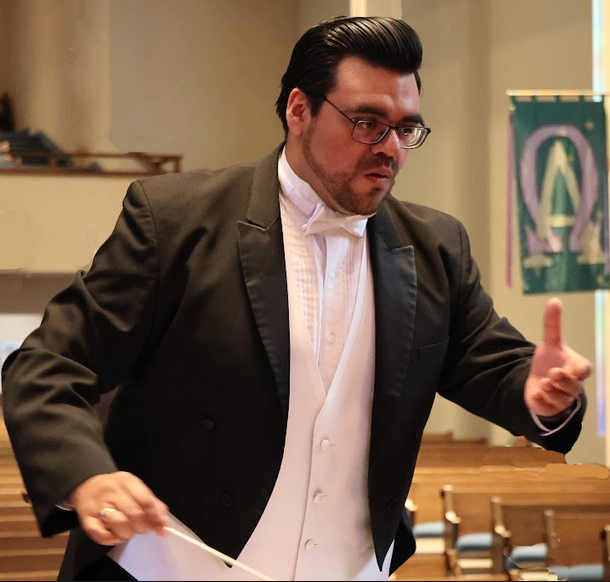

Download a readable PDF of the review







Santa Barbara Symphony Review - January 21, 2023: Plains, Trains & Violins
Read my review for VOICE Magazine
Visit the Santa Barbara Symphony website
Civilization and Its Challenges – Sigmund Freud meets Miguel del Águila et al . . .
A musical journey across the great American plains by train was the imagery for an unusually beautiful reflection on the excitement and challenges of immigrant experience portrayed by the Santa Barbara Symphony, under the guidance of Maestro Nir Kabaretti, for their 2023 season opener at the Granada Theatre.
Music of Elmer Bernstein (Toccata for Toy Trains Concert Suite), Miguel del Águila (Concerto for Violin: El Viaje de una Vida-The Journey of a Lifetime) and Antonin Dvořák (Symphony No. 9, From the New World) neatly tagged the source of the immigrant surge (improved transportation); the finality of leaving one’s homeland never to return; and the bittersweet lessons psychological and otherwise, telegraphed poignantly to the old world, from the new.
Opening the program, Elmer Bernstein’s charming wind and percussion chamber music score (eight players) for a short 1957 stop action animation film by Charles and Ray Eames, Toccata for Toy Trains, freshened up a bit with a new arrangement by Elmer’s son, Peter. About 17 minutes in length, the concert suite is pure neoclassicism – think Stravinsky’s The Rake’s Progress. For all its innocent charm, the score is also tricky for its subtle bravura. Kudos in particular, Santa Barbara Symphony principal trumpet Jon Lewis, for reliably spot-on virtuosity, and the chamber group as a whole for tight, characterful playing.
Miguel del Águila’s Concerto for Violin and Orchestra, Op. 94, El viaje de una vida - The Journey of a Lifetime (2007), is a stunningly accessible if beastly difficult recent entrant in the violin concerto sweepstakes. Its four movements – Crossing the Ocean to a New World, In the Purple Land, The Return, and Finale - the violin soloist accepting the musical mantle of immigrant protagonist throughout the work, contemplate the gauntlet of physical as well as psychological challenges all travelers face when leaving their homeland for a foreign land and culture.
De Águila himself a living witness to the immigrant struggle, having traveled from his native Uraguay to the United States (where he received his American citizenship) as a young man, then to Europe for a period of years and back again to America in 1992, has created a score as sweeping as the oceans, actual and allegorical, that separate whole continents and peoples.
Puerto Rican violinist/conductor Guillermo Figueroa, who premiered del Águila’s concerto in 2007 and has been performing it around the world ever since, was the featured soloist last weekend in Santa Barbara, approaching its virtuoso musical cautionary tales with the sublime self-confidence of one who owns the work – every note of it.
The orchestra and Kabaretti jousted and tarried danced and pivoted, with meter changes flying in all directions like bats out of hell, while Figueroa, sanguine in his complete mastery of the piece, kept things steady, well-paced, and pertinent. As encore, fellow Porto Rican Ernesto Cordero’s Concertino Tropical.
A particularly expressive and finely honed performance of Antonin Dvořák’s Symphony No. 9, From the New World, found the Santa Barbara Symphony in first-rate professional fettle, Kabaretti conducting from memory with the authority of dozens of performances over the years under his belt. Likewise, the orchestra personnel.
Nuanced phrasing, careful balances, an indefatigable horn section (yes!), tight percussion battery, super elegant wind and low brass section playing, and lush string ensemble cohesion and color spoke truth to the notion that under Kabaretti’s leadership and humanity, the Santa Barbara Symphony might well be one of the best regional orchestras on the west coast.
Daniel Kepl | Performing Arts Review
Santa Barbara-based music critic Daniel Kepl is taking a small group of participants on a 12-day tour of Portugal June 8-19, 2023, which will focus on visiting the cathedrals and historic pipe organs of the country. Stays in Lisbon and Porto will be supplemented by day trips to the Douro River Valley, Guimaråes, Braga, Coimbra, Fátima, Mafra, and the city of castles, Sintra. There are three spaces left for this trip. Full itinerary and costs: https://emeritiphilharmonic.com/

Download a readable PDF of the review







Music Academy Alumni All-Star Cello Choir December 17, 2022
Read my review for Voice Magazine of the third and last recital of 2022 in the Music Academy’s new Maricopa Series
Alumni All-Star Cello Choir – The Eight Immortals
The number eight is powerful. Throughout folkloric history it has been considered a symbol for luck and prosperity and is the atomic number for the element water. Aside from the infinity of its design, eight (8) also represents organization, perseverance, and control of energy. The Eight Immortals, of Chinese legend had extraordinary powers that could be transferred to each of their “power tools.”
Not that the cello is a power tool (cellists would disagree), but the imagery was appropriate last Saturday at the Music Academy in Santa Barbara. A conflation of marketing genius and artistic purpose brought eight cellists, all Music Academy alums, together for the first time in years to play a big program together in an intimate salon (Lehmann Hall in the main house) which was packed to the wainscoting with a sold-out crowd of a hundred or more eager Music Academy patrons.
The third and last recital of the 2022 season for the new Music Academy Mariposa Series featured the Music Academy Alumni All-Star Cello Choir, eight colleagues gathered from hither and yon a couple days earlier to rehearse and perform a program of mostly transcriptions (Grieg, J.S. Bach, Johann/Joseph Strauss, Wagner, Piazzolla) together with cellist Paul Wiancko’s 2017 Cello Quartet, Op. 1 “When the Night.”
Opening the program with a transcription for eight cellos of three movements from Edvard Grieg’s Holberg Suite, Op. 40 (1884), the All-Stars - Katrina Agate, Chas Barnard, Shirley Kim, Jennifer Kloetzel, Noah Seng-hui Koh, Marcie Kolacki, Maki Kubota, Emma Lee – brought the first of the three, Praeludium, into satisfying simile with the string orchestra version, including the replication, high on the cello fingerboard, of the violin tunes. Nice.
The Sarabande transcription, perfectly suited the rich timbre of the cello choir. Lovely. The last and trickiest of the three transcriptions, Gavotte, gave the eight cellists opportunity to levitate a bit.
Colin Hampton’s arrangement for cello quartet - Agate, Kloetzel, Kubota, Lee - of two movements from Bach’s unaccompanied Cello Suite No. 6 in D Major, BWV 1012 gave this listener a “puzzle me this” moment. How could it be? The first movement, Sarabande, found the brain remembering decades of solo cello performances, while the ears heard harmony and counterpoint - the arrangement’s magic. Fabulous!
The Gavotte I & II was also a delight in this skillful transcription. Little wonder, Colin Hampton (1911-1996) was a world-famous cellist and founder of the California Cello Club (1950) the oldest in the nation.
American composer/cellist Paul Wiancko’s Cello Quartet Op. 1 “When the Night” (2017) – Barnard, Kim, Koh, Kolacki – transported the listener through eight minutes, yes, eight minutes of vaporous cello quartet intoxication; a rich while also transparent palette of colors, a rhythmic pulse that waxed and waned with sometimes ecstatic frenzy, pizzicato and col legno effects to enhance moments of leisurely magic, then away softly into the night, like a dream. A splendid performance.
The last three programmed pieces, all transcriptions for the gang of eight to play together, included a fun Pizzicato Polka by the father/son team of Johann and Joseph Strauss, conducted discreetly as needed for rubato, by one of the team; Friedrich Grützmacher’s brilliant arrangement of Feierlliches Stück from Wagner’s Lohengrin; and a dynamite arrangement by James Barralet of two movements from Astor Piazzolla’s Four Seasons of Buenos Aires – Winter (1969) and Summer (1965). For encore, a simply beautiful arrangement of Leonard Cohen’s Hallelujah. A good time was had by all.
Daniel Kepl | Performing Arts Review
Download the Performing Arts Review Travel 12-day Portugal tour itinerary - June 8-19, 2023


Download a PDF of the review

Concert photos by Zach Mendez





Soprano Michelle Bradley recital - Music Academy Mariposa Series, 4 December 2022
Read my review for Santa Barbara’s VOICE Magazine
Soprano Michelle Bradley – Veni, vidi, vici
Art and more importantly its interpretation, is all about personality. Music Academy alumna, soprano Michelle Bradley, returned to her vocal training grounds last Sunday, dripping in recent kudos and rave reviews from triumphs at the Metropolitan Opera, San Diego Opera, and Chicago Lyric Opera. Presenting the second of three recitals by various artists as part of the new Mariposa Series at the Music Academy, Bradley offered an intimate program with her steady-as-a-rock collaborator, former Music Academy faculty artist, pianist Brian Zeger.
A sold-out crowd of 100 or more savvy patrons found themselves in the intimate embrace of two nearly overwhelming phenomena; the Music Academy’s elegant and creaky characterful Lehmann Hall with its chandeliers, turn-of-last-century ceiling molding and wood floors, and the utterly transparent, pitch-perfect, and disarmingly Kentucky-cheerful gobsmack talent of Michelle Bradley.
2014 grand-prize winner of the Music Academy’s Marilyn Horne Song Competition, Bradley has come a long way since, and lit up the tiny recital room in the main house last Sunday with a fascinating program, tempered mindfully against acoustic overload. Wearing a bright red evening gown that added volcanic energy to the proceedings while also melting hearts, Bradley offered a program of Samuel Barber (Hermit Songs, Op. 29); three songs by Reynaldo Hahn; four of Mahler’s Rückert-Lieder; two elegant arrangements of traditional hymns; and an encore medley of Whitney Houston classics.
Opening her recital with Hermit Songs, composed by Barber in 1953 and premiered by Leontyne Price, Michelle Bradley wasted no time confirming her nuanced capacity for scintillating vocal color, which she has nurtured to maturity since 2014. It was not difficult, because of Bradley’s unabashed personal interpretive temperament, to hear also a timbre in her mid-low range, or an earnest certainty of declamation, reminiscent of Price.
Of the ten songs in the set, St. Ita’s Vision and The Heavenly Banquet were prime examples of Bradley’s exquisite, clarified vocal color, while the last two, The Praises of God and The Desire for Hermitage, gave the soprano opportunity to unleash, albeit on the tight leash of Lehmann Hall’s acoustic environment, a generous dollop of her enormous vocal soundd.
Three love songs by Venezuelan-born French composer Reynaldo Hahn (1874-1947) offered a mid-meal sorbet in quasi-Baroque styling. À Chloris (To Chloris – 1913) fashioned compositionally with a French Overture conceit, provided Bradley with broad swaths of legato phrasing, which she executed with mesmerizing vocal fluidity.
Quand je fus pris au pavillon (When I was lured to her love nest - 1894) to a dance tune in Baroque manner, found the soprano in lighter, more playful voice as she canted male grievance: “If I had only been a falcon, or had the wings to fly away, I’d have saved myself from her.” Another opportunity for sustained phrasing, Si mes vers avaient des ailes (If my poems had wings – 1888) composed at the age of 14, ended the set in gentle, post-Romantic manner to Victor Hugo’s “If only my poems had the wings of the soul.”
Finishing the art song portion of their program, Michelle Bradley and Brian Zeger performed four of Gustav Mahler’s five Rückert-Lieder (1901-1902) beginning with Ich atmet’ einen linden Duft (I breathed a gentle fragrance) with its sprawling vocal landscape. Liebst du um Schönheit (If you love for beauty) one of the most challenging of the songs technically, found Bradley’s top voice superbly focused and capacious. Blicke mir nicht in die Lieder (Look not into my songs) with its difficult intervallic writing, was precisely in pitch, no small feat. The last and most famous of the Rückert-Lieder, Ich bin der Welt abhanden gekommen (Lost am I to the world) gave Bradley the narrative freedom to reveal her greatest asset, emotional vulnerability.
A gorgeous arrangement by James Miller of the traditional hymn I Am Seeking for a City and Margarinet Bond’s discreet arrangement of He’s Got the Whole World in His Hand fired up Bradley’s inner gospel, as well as her mighty voice. And to make the evening particularly memorable, sitting down at the piano Bradley morphed into Vegas mode, a deliciously mesmerizing and delightfully loose medley of Whitney Houston tunes, after a little warm up doodle – Puccini?
Daniel Kepl | Performing Arts Review
Download the Performing Arts Review Travel 12-day Portugal tour itinerary - June 8-19, 2023
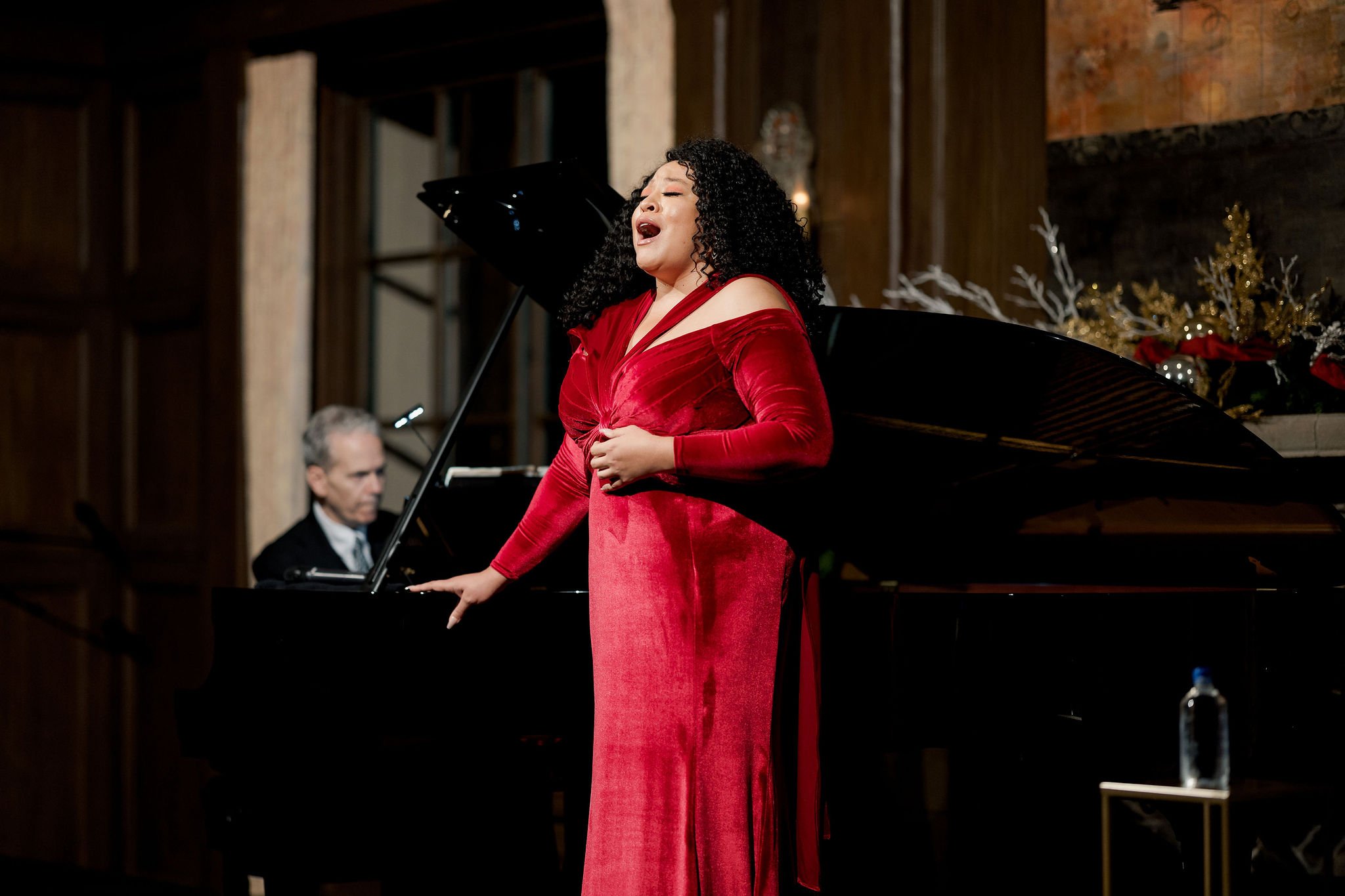

Download a PDF of the review






SANTA BARBARA SYMPHONY CONCERT 19 NOVEMBER 2022
Read my review for VOICE Magazine of the Santa Barbara Symphony concert on November 19, 2022
Wisdom of the Water, Earth, Sky — elevating the conversation
It isn’t often a community has an opportunity to learn about itself through art. Santa Barbara Symphony Music and Artistic Director Nir Kabaretti’s carefully crafted program last weekend at the Granada Theatre included a world premiere by Santa Barbara composer Cody Westheimer, his Wisdom of the Water, Earth, Sky; Robert Schumann’s love letter to his wife Clara, the Piano Concerto in A minor; a gorgeous realization of Jean Sibelius’ Valse Triste; and a splendidly clean and nuanced performance of Mozart’s Symphony No. 40 in G minor.
One of Santa Barbara’s favorite guest artists, pianist Alessio Bax, gave his fans here a performance of the Schumann concerto that was rich in detail, articulate clarity, and stoic power reminiscent of Arthur Rubenstein; note after note ringing clear and true – a stunning display of Bax’s physical as well as interpretive mastery of both the instrument and Schumann’s mind.
The world premiere of Santa Barbara composer Cody Westheimer’s musical, visual, and narrative homage to the Chumash Nation opened Saturday’s concert. A one-movement work for orchestra and Chumash language narrators - for this performance, Ernestine Ygnacio-DeSoto and Marianne Parra - enhanced by Westheimer’s stunning nature videography, Wisdom of the Water, Earth, Sky is not just wonderfully accessible musically and visually, but historically and culturally. Westheimer’s love letter to mankind via the cultural heritage and animist folklore of California’s Central Coast Chumash people offered Saturday’s audience a timely message from first inhabitants about balance and sharing.
The Coplandesque timbre and calming temperament of the opening bars of Wisdom immediately established for the listener a comfortingly halcyon musical vibe that gently belied an otherwise complicated and ever morphing compositional structure. Westheimer describes musically, the Chumash story of the origin of dolphins - Chumash who fell into the sea during the rainbow crossing from the Channel Islands to the mainland millennia ago and were saved from death by being transformed into dolphins.
The beauty of the sound of the Chumash language in the dolphin story and other ancient parables about deer (night marauders) and squirrels (saving, sharing, sacrificing), abetted Westheimer’s charming musical imagination commiserate with each story told. Finally, in grand strokes of triumphant, wonderfully orchestrated soundscape and stunning videography, the story of the Red Tail Hawk, who sees the world, its potential and failings, from a vantage beyond human conception, marked the thrilling emotional and musical denouement of the work. An epilogue, with sweeping Westheimer-guided drone footage of the natural wonders of this part of the world, accompanied by broad passages of orchestral grandeur and feel-good musical apotheosis, brought the world premiere of Wisdom of the Water, Earth, Sky to a knot-in-your-throat conclusion, and the house to its feet.
Pianist Alessio Bax has been a frequent visitor to Santa Barbara for concerto and chamber music appearances over many years, but Saturday’s performance of Robert Schumann’s Piano Concerto in A minor, Op. 54 (1845) was his first with the Santa Barbara Symphony and conductor Nir Kabaretti. From the first notes of the dramatic first movement, Allegro affettuoso, and with nary a flinch or shoulder crunch, Bax set a definitive and thrilling mantra for all to hear – every note of Schumann’s monstrously complicated masterpiece would be heard with clarity. The result was a jaw-dropping performance that not only sparkled with action and energy, but revealed passage work usually lost in the balancing game between soloist and orchestra.
Bax’s demeanor and electrifying sound presence – clean, articulate, balanced, resolute – reminded this listener of the Arthur Rubinstein touch; gentlemanly, almost stoic posture, pristine articulation, with a muscular edge that note for note packed a satisfying wallop, especially in the powerful cadenza at the end of the first movement.
Bax’s role as playful lover in the second movement, Intermezzo-Andantino grazioso, was appropriately lighthearted, elastic and coy, while the last movement, Allegro vivace, found Bax, Kabaretti and the orchestra in feisty form, willing collaborators at a stylish clip, in the nuptial celebration that is the emotional point and practical purpose of the work.
Jean Sibelius’ 1903 incidental music for his brother-in-law’s rather morbid play, Kuolema (Death) included Valse Triste (Sad Waltz), about a dying woman dancing with the ghosts of her past, before dying herself. Conducting from memory, as throughout most of the program, maestro Kabaretti gave his Saturday night audience a gorgeous and moving interpretation of Valse Triste, followed by a crackerjack virtuoso performance of Mozart’s Symphony No. 40 in G minor, K. 550.
Daniel Kepl | Performing Arts Review

Santa Barbara Symphony - Music and Artistic Director Nir Kabaretti


Download a PDF of the review





LOBERO THEATRE CHAMBER MUSIC PROJECT
Read my review for VOICE Magazine of the 2022-2023 opening recital in Santa Barbara by the Lobero Theatre Chamber Music Project on October 18, 2022
Back at last!
The Lobero Theatre Chamber Music Project, a legacy of the Santa Barbara Chamber Orchestra, sprang back to life on October 18 with a program of music for piano trio and piano quartet that was both elegant and enlightening. Heichiro Ohyama, former conductor of the Santa Barbara Chamber Orchestra functions as Artistic and Music Director of the Lobero Theatre Chamber Music Project.
As everybody knows, Ohyama can’t keep his hands off the viola, so subs as needed in that role, as he did for one of the pieces on the program last week. Violinist Benjamin Beilman serves as violinist and Musical Advisor to the Chamber Music Project.
With the assistance of colleagues, pianist Lucille Chung and cellist Edward Arron, the Lobero audience was treated to a magical interpretation of Dvorák’s Trio No. 4 in E minor, Op. 90 for Violin, Cello, and Piano “Dumky” 1890-91) and a refined performance of Faure’s Piano Quartet No. 1, in C Minor, Op. 15 (1876-79 & 1883).
Focusing listener attention throughout the evening; the bar line-busting integrity and breathtaking reflective quietude of the Dvorák, and the seminal fortitude of the Fauré, both works performed in lush, late nineteenth century style by the ensemble. Virtuoso technical execution and an essential equality of empathy between the musicians, made it all work.
Opening the program with Antonin Dvorák’s slightly quirky Piano Trio No. 4 in E minor, Op. 90, Dumky (1890-91), pianist Lucille Chung, violinist Benjamin Beilman, and cellist Edward Arron made of its six sections a marvel, not just of musical finesse and interpretive insight, but also that secret ingredient that enlightens performance, ensemble intuition. For all its flighty, folkloric friendliness, there’s something going on in this work that presages the composer’s mind-bending four-year stint as Director of the National Conservatory of Music in New York City (1892-1895).
Violinist Benjamin Beilman, firmly yet ever so delicately in charge, guided his colleagues, already acutely attuned to one another, on a bar line busting, phrase-centered journey, ensemble attacks and releases meticulously executed and stylishly honed. Time vanished in fevers of ensemble beauty and high-wire emotional attitude. The big surprise that took the performance over the top? Transformative passages of immaculate quietude.
Gabrielle Fauré’s Piano Quartet No. 1 in C minor, Op. 15 (1876-79 & 1883) was the second and last work on the program, Heiichiro Ohyama joined the others on viola. From the first bars of the opening Allegro molto moderato, ensemble playing was nicely balanced, tutti attacks and releases stunning, fluid, and subtly colored. The players gave the second movement, Scherzo-Allegro vivo its playful due.
The slow movement, Adagio, wherein so many of Fauré’s secret regrets lie hidden, was given an exquisitely painful interpretation, a tribute to the humanity of the artists and Faure’s musical messaging. The lively last movement, Allegro molto, picked up the pace appropriately, Fauré’s lively and heroic themes passing amiably between the players. After a hiatus of more than a year between Lobero Theatre Chamber Music Project events, it was gratifying to witness a full house enjoying great chamber music again in that venerable venue.
Daniel Kepl | Performing Arts Review





SANTA BARBARA SYMPHONY: CARMINA BURANA REVIEW OCTOBER 15, 2022
Read my review for VOICE Magazine of the season opening concert on October 15, 2022:
Santa Barbara Symphony/Santa Barbara Choral Society/State Street Ballet/SBCC Quire of Voyces/Music Academy Sing! Children’s Chorus
Pavane, Bacchanale, Carmina Burana — what a party!
If success can be measured in smiles, last weekend’s pair of Granada Theatre concerts by the combined musical forces of the Santa Barbara Symphony, Santa Barbara Choral Society, State Street Ballet, SBCC Quire of Voyces, and Music Academy Sing! children’s chorus, was an ear-to-ear triumph. The massive collaborative effort represented metaphorically, a catharsis and joyful sunrise. With flourishes, banners, dancers, orchestra, and choruses large and small - a combined cast of just under two hundred - Santa Barbara’s performing arts organizations gathered again at last, to announce they are back in the game, the 2022-2023 season is on!
Packed houses on Saturday night and at Sunday afternoon’s matinee, sipped champagne in celebration of the Santa Barbara Symphony’s 70th birthday, while also raising a collective toast to the performing arts professionalism we enjoy year-round in this community. On the program, Gabriel Fauré’s Pavane in F-Sharp minor, Op. 50 (1887), with new choreography by State Street Ballet’s Co-Artistic Director and Resident Choreographer, William Soleau; a feisty entr’acte for the orchestra alone, Camille Saint-Saëns’ Bacchanale from his opera Samson and Delilah (1877); and to end each of the two concerts with a mighty spectacle, Carl Orff’s rowdy masterpiece, Carmina Burana (1936).
The last time a collaborative musical joy ride of this caliber blew the roof off the Granada Theatre was in 2015, the first successful joint presentation by Santa Barbara performing arts groups of Carl Orff’s deliciously naughty mega-cantata for dancers, choruses, orchestra, and soloists. Seven years later the venue is the same, professionalism and thrills a given, but important changes scenically, choreographically, and musically, have spruced up this second collaboration. The result is fresh to eyes and ears on several levels.
Tight performance standards and compelling energy marked the entire program Saturday night, charioted with vigor by Santa Barbara Symphony Music and Artistic Director Nir Kabaretti, who kept the pace and purpose of all three works on the program athletic, taut, and intellectually exciting. A stunning new cadre of young professional dancers at State Street Ballet made their debut as well, immediately dispelling any worries about the artistic bottom line, with precise yet fluid corps de ballet accuracy, with consistent finesse in execution.
The Santa Barbara Choral Society, SBCC Quire of Voyces and Music Academy Sing! Children’s Choir sounded particularly well-rehearsed and tight in ensemble balance, color, and intonation. Kudos, conductors Jo Anne Wasserman, Nathan Kreitzer, and Erin McKibben. Clean staging and lighting design also enhanced the look on stage in surprising and satisfying ways.
Choreographer William Soleau illuminated visually, two of the works on the program, creating elegant new choreography for Gabrielle Fauré’s Pavane in F-Sharp minor, Op. 50 (1887) a sublime movement reverie for an ensemble of six, while tweaking here and there, his original 2015 choreography for Carmina Burana, achieving a marvelously successful if subtle, transformation of the 2015 original.
Perhaps it was the lighting design of Sammy Jelinek, or some subtle changes in wardrobe by Nicole Thompson. Certainly, the confident and precise ensemble, solo, and duo dancing throughout the evening by State Street Ballet’s new gaggle of stunningly versatile artists contributed to the sense that the 2022 Carmina Burana was entirely fresh. Salutations, State Street Ballet principals Amara Galloway and Herñan Montenegro (The Couple), Marina Fliagina (Fortuna), and Leeza Domrachev (The Swan).
Vocal soloists for Carmina Burana, soprano Jana McIntyre, countertenor Randall Scotting, and baritone Valdis Jansons, made much of their often-perilous musical roles. Orff’s writing for these three is mercilessly virtuosic. Vocal resilience, fortitude, intelligent coloration, and high skill marked the performances by all three.
The Santa Barbara Symphony and all the participating choirs except the children’s choir, which did their bits on the dance stage, could be seen perched handsomely on a platform behind and above the on-stage dance area. A scrim just in front of the orchestra allowed for visual projections and other special lighting effects as needed, while also making slightly mysterious and intriguing, the visual illusion of an orchestra suspended in midair.
Conductor Nir Kabaretti, smack in the center of it all, commanded a ringside overview of the dance action going on below. Handy for the Fauré, Kabaretti’s elevated position and visibility was crucial during the massive and often tricky sections of Carmina Burana.
A bonus made particularly apparent during the orchestra’s elegantly cosmopolitan performance of the Bacchanale scene from Camille Saint-Saëns’ opera Samson and Dellilah (1877); being elevated, thus closer to the acoustic shell’s ceiling panels, the orchestral sound projecting into the hall seemed particularly clean, balanced, articulate, and detailed.
Daniel Kepl | Performing Arts Review
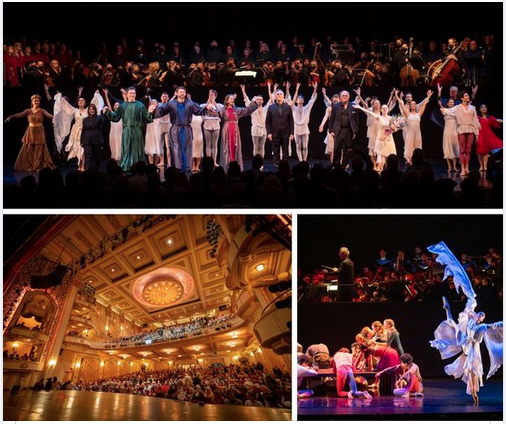








OPERA SANTA BARBARA - TOSCA ON OCTOBER 1, 2022
Enjoy my review for VOICE Magazine, of Opera Santa Barbara’s October 1, 2022 production of Puccini’s Tosca
A lean but transformative Tosca
The blood-curdling fate motive in low brass and percussion which launches Giacomo Puccini’s Tosca (1900) and sets a mesmerizing horror story in motion, brought a full house at the Granada Theatre last Saturday to hushed silence for over two hours, as Opera Santa Barbara opened its 2022-2023 season with a production steeped in high drama and filled with glorious music. Artistic and General Director Kostis Protopapas has helmed his company through the vagaries of the past two years with sometimes stubborn, often visionary, but always resolute determination to serve his audience and their understanding of the world around them. It’s called selecting repertoire to meet the times in which we live, and Tosca, though enveloped in historical events from the past, is a universal story about the upheaval of wars and the resiliency of womanhood.
A practicable set design made the best of budget restraints, as OSB and nearly every other performing arts organization in the world recovers, slowly, from two full seasons of lost revenue. The OSB Orchestra was on stage, visible but hidden discreetly behind a couple walls of open scaffolding on which various points of action would take place. A large screen, suspended in front of the orchestra and behind the scaffolding, was used to excellent affect for video projections that accompanied, without overwhelming, the psychological messaging of the opera.
Set in war-torn Rome circa 1800, the beginning skirmishes of what would become the Napoleonic Wars (1803-1815), Tosca is at one level, about the fates of people caught up in political upheaval and military struggle. Victors and vanquished chase and dodge one another throughout the three acts of Puccini’s musical drama. Artists, politicians, the head of the secret police, a famous and strong-willed singer: these characters and their disparate needs and interests shift and churn in an elastic milieu of give and take, success and failure, life, and death. Power, deception, betrayal, murder, self-sacrifice, lust, and karma form the glue of the opera’s complex subtext.
In the title role of Floria Tosca, Greek soprano Eleni Calenos easily took command of the stage as well as her character. A classic Puccini heroine, Tosca becomes increasingly self-aware and courageous as the opera progresses and circumstances become more threatening. So too Calenos, whose voice became powerfully steely as Tosca’s act of just murder and self-sacrifice takes its inevitable course. Tenor Adam Diegel as Tosca’s lover, the painter Mario Cavaradossi, enjoyed a bright and persuasive high tessitura, notwithstanding a slightly frayed moment or two around the edges of his voice during sustained high tones on Saturday. Diegel’s acting, his confidence on stage, and his penetrating vocal timbre, made for a near perfect Cavaradossi.
Baritone Wayne Tigges as Baron Scarpia, chief of the secret police of the Kingdom of Naples which has recently occupied Rome after the withdrawal of Napoleon’s troops, took the role and ran with it. Possessing a resonant, amber vocal color and superbly thoughtful acting sensibilities, Tigges dominated each of his scenes, as well he should – his character is a colorful badass.
OSB’s Chrisman Studio Artist Program alum, bass Colin Ramsey, was a keen presence on stage in the role of Cesare Angelotti, former Consul of the Roman Republic installed by Napoleon, now on the run from Baron Scarpia and the Neapolitan authorities. Ramsey’s voice, a deep pool of sound, could not be ignored as he took on the Angelotti persona brilliantly. Bass Ben Lowe (Sacristan/Jailer), tenor Matthew Peterson (police agent Spoletta), and Kyra Maal-King (Shepherdess) aided the action with strong vocal and acting finesse.
Stage Director Layna Chianakas, familiar to OSB audiences for directing smaller pieces for the company between 2019 to 2022, grabbed the reins of this, her first full length opera for the company, and made sure the action stayed at a level of electrifying tension and terse choreography throughout. Yuki Izumihara, in charge of Projection and Set Design, crafted a collage of video imagery by Filmmaker Zach Mendez that discreetly married visuals to the action taking place on her efficient set.
Helena Kuukka, Lighting Design and Director of Production, gave dimension, color, and meaning to each scene in Puccini’s sprawling masterpiece. Heather Sterling (Hair/Makeup Design) and Stacie Logue (Costume Manager) authenticated the look of Tosca with spot-on stylings circa 1800. The OSB Chorus under the masterful coaching of Principal Pianist and Music Administrator Timothy Accurso, packed a powerful vocal wallop, and the Ojai Pixies chorus (altar boys and girls) under the direction of Julija Zonic, fulfilled their tasks musical and theatrical, admirably. Special kudos to the Opera Santa Barbara Orchestra under the alert conducting panache of Artistic and General Director Protopapas - a splendid, deliciously overwhelming immersion in Puccini’s magnificent music.
Daniel Kepl | Performing Arts Review

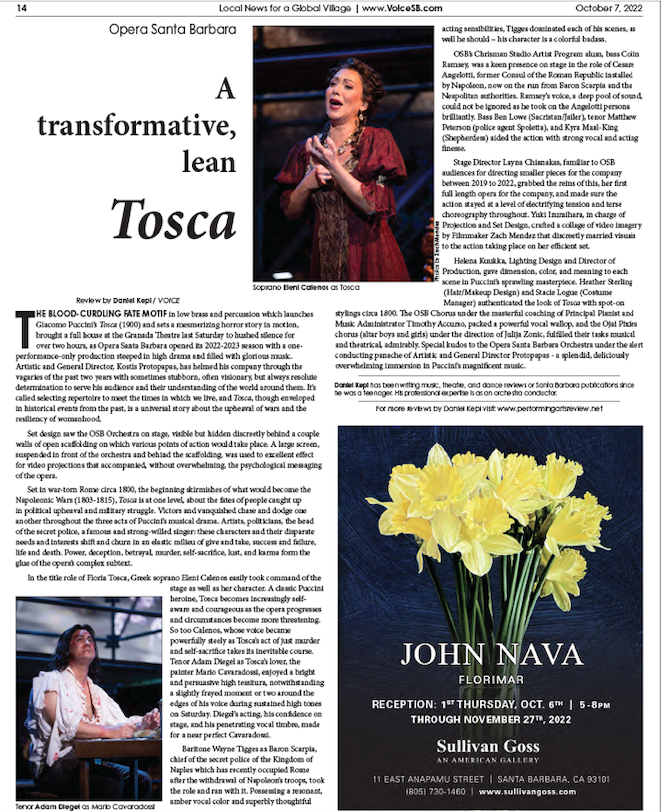
Download a PDF of the review








Music Academy Festival Orchestra July 30, 2022
Read my review for VOICE Magazine of the Music Academy Festival Orchestra concert on Saturday, July 30, 2022
There’s something about the French!
The Music Academy Festival Orchestra has been in fine musical form all summer, coming together as an ensemble of superb peers to produce in just weeks, reliably impressive interpretations of major orchestral repertoire under a host of world-famous conductors. The ensemble has quickly acquired a delicately honed and carefully balanced arsenal of orchestral color, imagery, and flat-out thrilling finesse in performance.
The pleasure of hearing the full orchestra in all its sonic glory last Saturday at the Granada Theatre, especially considering its well-deserved imprimatur this summer for gorgeous romantic orchestral sound, was enhanced not just in dollops, but ladles of crème fraiche by guest conductor and French music specialist, Stéphane Denève.
Music Director of the St. Louis Symphony and Brussels Philharmonic, Principal Guest Conductor of the Philadelphia Orchestra, and Director of the Centre for Future Orchestral Repertoire, Denève is cutting edge, and offered a lush musical cocktail of compelling early to mid-twentieth century romantic impressionism; a comingling of programmatic sense and sensibility that puzzled and satisfied, simultaneously.
Sergei Rachmaninoff’s Symphony No. 3 in A minor, Op. 44, composed near the end of the composer’s life in 1935-36 opened the concert. The Second Orchestral Suite (1913) by Maurice Ravel from his “symphonie choréographique,” Daphnis et Chloé, was the only other work on the program, intensifying the passion and audience palpitation levels considerably. There was a brief break between the two works, but no intermission.
Of Rachmaninoff’s three symphonies, the Second Symphony is performed most often and is revered particularly for its several cascading waterfalls of luscious tunes, tethered resolutely to the composer’s famously rich orchestrations. The first and third symphonies have not fared so well over time.
At 40+ minutes, the four movements of the Symphony No. 3 rolled out promisingly Saturday night, with an immediately engaging tune in the first movement, Lento – Allegro moderato – Allegro. Truth is, the remaining three movements, despite their lush orchestrations and sometimes interesting emotional pivots, simply don’t get off the ground melodically; the soaring tunes of the Symphony No. 2 are AWOL in the Third Symphony. Some suggest old age, exhaustion, depression, or the approaching world war as distractions.
So why program this symphony? The answer is both simple and disarming. Denève, grounded in French repertoire, re-examined before our eyes and ears, Rachmaninoff’s late-late Russian romantic masterpiece at least partially from an impressionist’s interpretive perspective. Unable to soar as successfully as the composer’s earlier symphony, the Third is nevertheless worth at least occasional dusting off for its rich orchestrations, if not its currency in 1936 European compositional innovation.
Exploring the good, the bad, and the inadequate mechanisms of this puzzling Russian work proved advantageous for both the musicians in the orchestra and the audience; an enabling musical dissertation from Denève to the young virtuosos of the orchestra – with his hands. Determined to find something to save in the chassis, the conductor spruced up the undercarriage, replaced some spark plugs and chrome, and found value in his re-tooling of the work, à la française. The Symphony No. 3 still doesn’t run seamlessly, but Denève’s attempt to fix it, was fascinating.
The orchestra was deliciously tight in all departments. Strings unforced and gorgeous in sonority throughout. Wind, brass and percussion sections, working together as co-conspirators in thrills, relished executing rhythmic and dynamic contrasts as they were intended – unexpectedly thrilling.
Denève, a large man, was in mesmerizing control of all things, including minutia. The third movement, Allegro – Allegro vivace – Allegro, for example, was extraordinarily re-examined and codified on several levels by the conductor, while the last movement, Allegretto – Allegro vivace, particularly the fugue section, served up a satisfying sonic lush out in the conductor’s hands, despite not having a single memorable tune.
After demonstrating a flair for Russo-French rapprochement with his Rachmaninoff interpretation, Denève let loose his inner Gaul, for a magical performance of Maurice Ravel’s, Daphnis et Chloé Suite No. 2 (1913). The Second Suite is a pastiche of dance segments - Lever du jour, Pantomime, and Danse generale - from the full-length ballet composed for Diaghilev’s Ballets Russes in 1912.
From its mystical opening bars - animist warbling in winds intimating a Panhellenic nature idyl - straight through to its triumphant Dionysian finale of shifting rhythms and irregular meters, the Second Suite is an imaginative tour de force for orchestra, with one of music’s most exhilarating endings – a sonic whirling dervish celebrating pagan love. The audience, quiet as church mice throughout the roughly 18-minute musical orgy, erupted in roars and hoots of delight after the last tsunami chord – an apt acknowledgement of an extraordinarily exhilarating performance.
Daniel Kepl | Performing Arts Review
Download a PDF of the 12-day Performing Arts Review Travel Portugal adventure June 8-19, 2023
Simon Rattle and the London Symphony Orchestra in Santa Barbara on March 24 2022
Read my review for Santa Barbara arts weekly, VOICE magazine, of the March 24 2022 performance by the London Symphony Orchestra, Simon Rattle conducting
Sir Simon Rattle conjures privateers, prostitutes, the subconscious, and the demise of the waltz - in one evening
Santa Barbara, home to the internationally famous Music Academy of the West, and host to concerts by the great orchestras of the world for over a century under the aegis of Community Arts Music Association (CAMA), is a bit spoiled for its population demographic. Still, last week’s mini residency here by the London Symphony Orchestra - part of its partnership with the Music Academy since 2018 which continues through this coming summer - confirmed at several levels, the orchestra is clearly among the top half dozen in the world.
Music Director Simon Rattle kicked off the first act of an extended weekend of special events celebrating the Music Academy’s 75th birthday, by conducting a program at the Granada Theatre in Santa Barbara on March 24th that defied a certain elemental logic about biting off more than one can chew. Berlioz’ treatise on string virtuosity, Overture: Le corsair; Hannah Kendall’s The Spark Catchers; Sibelius’ stunningly complex Symphony No. 7; Bartók’s equally daunting Miraculous Mandarin Suite, and for dessert, Ravel’s La Valse, which a critic at its premiere in 1920 described as a piece that, “plots the birth, decay, and destruction of a musical genre,” were dispatched as mortals might chow down a Big Mac. The evening flew by with the speed of fast food, yet at the musical level of Le Cordon Bleu.
Last Thursday’s program is locked into the London Symphony’s North American touring repertoire, thus was thoroughly prepared. Yet the breathtaking speed of unison string passage work, the uncanny balance of wind and brass choirs, the apparent immortality of Simon Rattle’s energy, and his insistence on the powers of dynamic contrast, made this meaty, nearly overweight program levitate with technical perfection and artistic savoir faire. World class, alright.
Opening the concert with flash/bang, the LSO’s performance of Berlioz’ Le Corsaire (1844/1852) represented one of those glorious experiences where one sees the players movements, hears the sounds rushing by at breakneck speed, and wonders, is that possible? Rattle, conducting alternately in two and four, depending on the sweep and flow of the music, clarified a thousand details of harmonic structure and orchestration, while also demanding dynamic and rhythmic subtleties seldom heard in other virtuoso performances of the piece.
British composer Hannah Kendall’s 2017 composition, The Spark Catchers, takes inspiration from Lemn Sissay’s poem by the same name, which he wrote for the 2012 London Olympics. A single, continuous compositional structure, the work nevertheless has distinct, and distinctly colored, sections: Sparks and Strikes, Molten Madness, Beneath the Stars/In the Silver Sheen, and The Matchgirls’ March. Edgy, repetitive patterns, jagged musical fragments, and moody colors, all in a nimbus of nervous energy, conjured the ghost memory of the Bryant and May match factory that once stood on the 2012 Olympics site, and the nerve-wracking vigilance required of the women who worked there, to avoid the accident of a catastrophic spark. Interesting subject, fascinating realization.
The two largest works on the LSO program last Thursday, Finnish composer Jean Sibelius’s enigmatic Symphony No. 7 (1924) and a suite from Béla Bartók’s music for a risqué pantomime ballet, The Miraculous Mandarin (1918-1924), would, in and of themselves, be considered the principal major work of most orchestral programs. Together on the same concert, they represented, as mentioned earlier, the world class technical, intellectual, and ensemble capabilities of the London Symphony.
Conducting both massive works from memory, Simon Rattle pulled no punches. His Sibelius was properly Nordic, fog-drenched sonically and psychologically, lush, mysterious, and moody. Rattle’s Bartók, also through-composed with section titles describing the various seductions of the Miraculous Mandarin story, was a feast of cubist chaos. Both works featured various soloists - an orchestra of chamber musicians.
Perhaps to take the edge off a bit, Ravel’s super-lush La Valse (1919-20), brought the printed program full circle, followed by Dvorak’s Slavonic Dance No. 3, as a jolly encore. Simon Rattle’s conducting throughout - a masterclass.
Daniel Kepl/Performing Arts Review

Photos by David Bazemore







Santa Barbara Symphony welcomes organist Cameron Carpenter: March 19 2022
Visit the Santa Barbara Symphony
Visit Cameron Carpenter’s website
Read conductor Nir Kabaretti’s bio
Read my review for Santa Barbara’s arts weekly VOICE magazine:
Organist Cameron Carpenter: mysteries revealed
Last weekend’s concert pair by the Santa Barbara Symphony at the Granada Theatre with guest artist, organist Cameron Carpenter, added a short but fitting work to the printed program, Ukrainian composer Myroslav Skoryk’s Melody for Strings, a tender, hauntingly elegiac folk-like melody, performed by the orchestra in tribute to the ongoing heroic fight by the Ukrainian people to keep their independence.
Soaked metaphorically in Ukraine’s blood and history, Melody helped all in the room to reflect on, and be in the moment with, Ukraine’s existential struggle. Special guests Tetiana and Stepan Kisilevich, who had escaped the war zone two weeks earlier, were in the house Saturday night to watch their daughter, Myroslava, play the piano part in Saint-Saëns’ Organ Symphony No. 3, which brought the concert to a rousing close.
Interestingly, the two main works on the program, selected by conductor Nir Kabaretti long before COVID and the invasion of Ukraine, nevertheless suited perfectly, the present historical circumstance.
Francis Poulenc’s Concerto for Organ, Strings and Timpani in G Minor (1938), while light and Parisian in so many ways, also has its dark side; the impending world war and the death of Poulenc’s lover (most agree), composer Pierre-Octave Ferroud. Camille Saint-Saëns’ stunning Organ Symphony No. 3 in C Minor (1886) has its own sub-basement of grief, the death of both his infant sons in 1878, a loss that haunted, with gossamer melancholy, the composer’s remaining compositional output.
Presented in collaboration with Through Vincent’s Eyes: Van Gogh and His Sources, at the Santa Barbara Museum of Art, and with Sonic Boom! as its marketing hook, last Saturday’s concert enjoyed a full house.
Guest artist, organist Cameron Carpenter, did not disappoint, opening the concert with a solo, Bach’s Prelude and Fugue in E-flat Major BWV 552 (St. Anne - 1739). Sitting at the console of his newest traveling electronic organ, a magnificent beast planted stage left in front of the orchestra with phalanxes of speaker towers arranged along the back wall of the orchestra shell above and behind the players, Carpenter’s intensely focused and personal interpretation of this monumental construction, based on the mysticism of the Holy Trinity (3) was, well, mind boggling.
Taking the art of embellishment to heaven and back again, Carpenter improvised, noodled, tweaked, and toggled around Bach’s written superstructure at every opportunity, spinning a cotton candy dervish of Baroque performance practice. Exactly.
Francis Poulenc’s Concerto for Organ, Strings, and Timpani in G Minor (1938) is in seven sections, played in one musical arc. A work of sublime coloration, and not so subtle dissonance (for a reason), the composer uses his 20th century harmonic palette to express apprehension at the approach of World War II, as well as his profound melancholy (the composer almost went into the priesthood) at the loss of composer Pierre-Octave Ferroud.
A leader of the movement known as Les Six, this work, while doggedly tuneful and straightforward in its way, is nevertheless colored in tears, and tempered by an impending, if still distant storm.
Cameron Carpenter’s approach to the work - a trance-like, razor-focused delicacy - examined each chord with scholarly care, particularly the dissonant ones, eliciting their secret beauties, like cracking open the interior of an amethyst geode. Improvising embellishments here and there, Carpenter stamped his unique personal imprimatur on the piece. A treat. The Santa Barbara Symphony under Kabaretti’s elegant baton, created both velvet and ominous sound textures, all within Poulenc’s clever conceit of a gigantic French Overture.
“I gave everything to it I was able to give. What I have here accomplished, I will never achieve again.” Thus spoke Camille Saint-Saëns about his Organ Symphony No. 3, composed in 1886 at the height of his career. Considered one of the greatest organists of his age, a virtuoso pianist and composer, his enormous and technically complicated Symphony No. 3 is more a sprawling tone poem, than four-movement symphony.
Conducting from memory, Kabaretti turned in a stellar performance. The orchestra, most of whom having played this glorious war horse on several prior occasions, clearly enjoyed themselves, though the tough bits, as always, were exhausting. Cameron Carpenter, utterly still and pensive when not playing, sprang into action as the score required, giving the piece its sonic boom audiences love, while also managing to sprinkle improvised embellishments throughout, with what sounded like a completely improvised cadenza. Splendid!
Daniel Kepl/Performing Arts Review








State Street Ballet's new production of Sleeping Beauty
Read my review for Santa Barbara arts weekly VOICE magazine
Visit State Street Ballet
Visit Opera San Luis Obispo
Sleeping Beauty - a metaphor for our time
3/5/2022
Sometimes, things happen when they’re supposed to. State Street Ballet’s new treatment of Tchaikovsky’s Sleeping Beauty - a major addition to the company’s repertoire - was set to receive its premiere in Santa Barbara in early 2020. Fate intervened with a real-time Sleeping Beauty experience.
The re-scheduled premiere of Sleeping Beauty last weekend precipitated pleasurable goosebumps of anticipation weeks before opening night. A full house Saturday night (March 5), including young parents and their kids, jammed the Granada Theatre with energy and expectation. It’s been a long time.
Professionals all, State Street Ballet projected particularly confident ensemble cohesion as they danced for a live audience again after the long, planet-wide nap of the past couple years. The Opera San Luis Obispo Grand Orchestra, under the baton of Brian Asher Alhadeff, made use of a cleverly reduced orchestration of the original score with delightful style and polished finesse. The SSB production crew - sets, lighting, costumes, special effects - managed stage craft magic with aplomb. Everybody, audience included, enjoyed a wonderful awakening.
Sleeping Beauty (1890) is the second of Tchaikovsky’s three ballet masterpieces, sandwiched between Swan Lake (1876) and the most famous of the three, Nutcracker (1892). Like Washington Irving’s novel, Rip Van Winkle (1819), Sleeping Beauty contemplates lost time. The brothers Grimm tweaked an earlier version of the story to add a popular homily about the constant struggle between good and evil.
Working around and through Marius Petipa’s original 1890 choreography, SSB’s Rehearsal Director Marina Fliagina, Associate Executive Director Cecily MacDougall, and Professional Track and Rehearsal Director Megan Philipp collectively added their own subtle choreographic homage and design twists, fashioning the story into four scenes - Summer, Fall, Winter, and Spring. So much gorgeous music, so little time in this new version of an hour and a half or so, meant trimming the score by half from its original length, and tapering the action accordingly. Still, this new production was sensible and tight.
Guest artist Aaron Smyth (Prince Florimund) and SSB’s Deise Mendonça (Princess Aurora) paired beautifully in principal roles as star-crossed representatives of love-conquers-all romanticism. Arianna Hartanov, who joined SSB in 2018, was a stunningly powerful Carabosse, ironically, both Fairy of Wisdom and representative of evil in the world of Grimm - something about original sin, which Hartanov appeared to relish. Saturday’s Lilac Fairy, Saori Yamashita, created a yang role of goodness and bright truth, to counter Carabosse’s evil yin.
The “travelogue” conceit used in Nutcracker to introduce a host of exotic countries and dance forms, originated in Sleeping Beauty, where a similar mechanism of showy virtuoso dance vignettes features a bevy of fairies and other Grimm characters. Puss and Boots (Tanner Blee), White Cat (Emma Matthews), Little Red Riding Hood (Amara Galloway) and her Wolf (Oscar Bravo Ly), the Fairy of the Crystal Fountain (Elizaveta Domracheva), Wheat Flower Fairy (Emma Matthews), Fairy of the Woodland Glade (Eliana Swanberg), Singing Canary Fairy (Amara Galloway), the Fairy of the Golden Vine (Marika Kobayashi).
Princess Florine (Marika Kobayashi), and Bluebird (Harold Mendez) also paraded their stuff before the King (Nathaniel Tyson) and Queen (Emily McKinney), Dukes and Duchesses, courtiers and squires, huntsmen and suitors, with colorful flair and flourish. Ensemble dances, solos, duos, and combinations were introduced with trademark dandyism by audience favorite, Sergei Domrachev as Catalabutte, Master of Ceremonies.
One of many delightful memories from the evening was Christina McCarthy’s enormous dragon puppet design. The evil Carabosse’s huge winged sidekick was scary and impressive, with a dollop of silly fun.
Daniel Kepl/Performing Arts Review

Photo credits: Montecito Photo & Design








Music Academy of the West 2021 - read the reviews
Music Academy Chamber Orchestra concert with guest conductor Marin Alsop August 7 2021
Read my review for Santa Barbara’s VOICE Magazine
Visit the Music Academy of the West
An amazing summer season ends in triumph
Last Saturday at the Granada Theatre, the Music Academy of the West Chamber Orchestra, with one of the world’s great conductors, Marin Alsop, at the helm, presented the last concert of the 2021 summer season. Masked but happy, everyone in the audience appreciated with gusto, the opportunity to engage with live music makers once again, after too long a hiatus on account of COVID-19. In the annals of the Music Academy of the West, 2021 will be remembered as one of the most important artistic renewals in the institution’s 74-year history.
Despite the unpredictability of the virus, the Music Academy administration and staff have pulled off a minor miracle this summer, bringing back, under difficult circumstances, an interactive experience between audience and performers. The Music Academy’s dynamic orchestral, chamber music, piano, and vocal training programs for young professionals jump-started with a roar, after so many challenges over the past year and a half. Next year’s 2022 summer season, it can safely be predicted, will be blockbuster.
Marin Alsop is no stranger to the opening work on Saturday’s program, Joan Tower’s Fanfare for the Uncommon Woman (1986) written for and dedicated to the conductor. Orchestrated for the same brass instrumentation as Aaron Copland’s Fanfare for the Common Man (1942) but with a larger percussion battery, Alsop knows every kink and curlicue, having conducted the piece countless times over the years. The result, a Puckish performance; facile, glittery, amusing, and virtuoso.
An adjustment of chairs to accommodate seating for strings and winds, and Alsop returned to conduct Alberto Ginastera’s Variaciones concertantes for Chamber Orchestra, Op. 23 (1953). A theme with several variations and sprinklings of virtuoso solo interludes, Alsop clearly selected this work to showcase the many talents, individual and collective, of the orchestra. Tricky meters, mood changes on a dime, brilliant wind, brass and string sectional flurries, pulsing rhythms, and stylish tympani licks - what’s not to like? In stunning command of each lovely calm and pitching tempest, Alsop was a marvel of fabulous musicianship and subtle conductorial handicraft. Bravi tutti!
Intermission still on the forbidden list at indoor events because of COVID, a quick reshuffling of winds and brass presaged the last piece on the program, Beethoven’s Symphony No. 7 in A Major, Op. 92. Known for its several fabulous horn licks, Alsop had some fun. Placing tympani dead center behind strings and winds, the conductor arranged trumpets on one side and the French horn section - two behind two, behind two - on the other side of the tympani, rather than in the usual horizontal line behind the winds. The result was fantastic, both in look and sound. A special shout out to the exciting, vigorous and entirely correct playing by whichever of the two tympanists listed on the program did the 7:30 Beethoven gig.
Luckily, in recent years interpreters have learned a lot more about Beethoven’s intended and clearly notated tempo markings. Forget the broken metronome theory. Beethoven wanted things to be energized and indicated so in his metronome markings. Relishing the new consciousness, Alsop gave the audience a refreshing romp through all four movements that soared and pitched, dove deep, and meditated quietly but with purpose, free at last, of a couple generations of misunderstanding.
Daniel Kepl | Performing Arts Review
Takács Quartet recital July 22 2021
Read my review for Santa Barbara’s VOICE Magazine
Visit the Music Academy of the West
Takács Quartet: Schubert never heard it so good!
Last Thursday (July 22) a packed house at Hahn Hall on the Music Academy of the West campus welcomed Takács Quartet back to Santa Barbara with cheers and applause after a long Covid hiatus; the uproar, a kind of communal shout out of relief at the return, sort-of, to normal. Two works were on the program, Schubert’s String Quartet in D Minor, D. 810, “Death and the Maiden” and Brahms’ String Sextet No. 2 in G Major, Op. 36. Academy Fellows Keoni Bolding viola, and Chas Barnard cello, joined Takács for the Brahms.
Personnel changes for string quartets are tricky. The sold-out house last Thursday anticipated the introduction of Takács Quartet’s newest member, violist Richard O’Neill. O’Neill has been a fixture on the Music Academy faculty for some years and has performed with Camerata Pacifica for many years here as well. O’Neill’s recent career moves have been exciting. Not only has he just joined Takács Quartet, his recording of American composer Christopher Theofanidis’ Concerto for Viola and Chamber Orchestra with the Albany Symphony, won this year’s Grammy for Best Classical Instrumental Solo.
Long story short, Richard O’Neill is one of the most dynamic and visually thrilling violists on the planet today. As the newest “color” in Takács’ quiver, O’Neill would be one of four equal partners, not just now and again, but for years to come, performing hundreds of concerts as a member of one of the great string quartets of the world.
Schubert’s next to last and most famous string quartet No. 14 “Death and the Maiden” opened the program. Perhaps it was only me holding my breath before the fragile opening notes of the first movement, Allegro. The silence in the room anticipating those first notes - the initial aural test of Takács’ famous ensemble blend and interpretive integrity with their new violist - bespoke at very least, an intensely curious audience of serious Takács fans. Everyone in the room, especially the artists, knew what was expected, but didn’t know what to expect.
Having seen performances of Death and the Maiden by many dozens of quartets over several decades myself, Thursday’s performance by the ensemble - violinists Edward Dusinberre and Harumi Rhodes, cellist András Fejér, and violist Richard O’Neill - was hands down, the most breathtakingly exquisite interpretation of the work in my experience. Perfection in intonation, dynamic compass, style and balance, not unexpected at the highest levels, was crowned by an overall interpretation of the work that was fresh, fascinating, cerebral and chock-o-block with color and imagery. Did I mention style? If compassion is a musical style, Takács gave Schubert’s heartbreaking masterpiece one of the most moving and gentle interpretations in memory.
Technical prowess and ensemble bravura abounded, as in the variations of the Andante con moto, second movement. Takács’ edgy performance of the third movement, Scherzo: Allegro molto, was honey. Every note, each exclamation, every mood change, perfectly honed, styled and finished. The final movement, Presto, with its thrilling coda, gave the audience a collective case of the vapors, followed by roars of approval for a stunning interpretive endeavor!
After a short stretch break, Academy Fellows Bolding (viola) and Barnard (cello) joined Takács Quartet on stage for a fascinating performance of Brahms’ String Sextet No. 2 in G Major, Op. 36. In four movements, the work is from 1864-65, the composer in his early thirties. Takács’ performance revealed the quirkiness of the piece, with its interesting dissonances and experiments in harmonic movement, beginning with the passage for two violas that opens the work. Tweaked tonality in the third movement, Adagio, and a very nearly Elgarian tune in the last movement, Poco Allegro, gave all six artists opportunity to relish making music again together for a live audience.
Daniel Kepl | Performing Arts Review
Academy Chamber Orchestra concert Juiy 11 2021
Read my review for Santa Barbara’s VOICE Magazine
Visit the Music Academy of the West
Cheers! The Academy Chamber Orchestra opens a post-Covid Granada Theatre with panache and not a few tears
Not since March 7 2020, when the Los Angeles Philharmonic performed its 100th anniversary concert in the venue for a gala sell-out CAMA crowd, has Santa Barbara’s Granada Theatre welcomed a free-flowing, non-masked, cheerful and chatty audience to its iconic post-modern, quasi-Spanish Revival performance space. Videotaped programs with limited in-house personnel behind those Covid-19 spit screens we’ve come to love and loathe, or the occasional Pavlovian experiment, inviting a dozen or so witnesses into the space, spacially segregated and masked, for special in-house private events, were the few intrusions into an otherwise tomb-like silence that embalmed the Granada for well over a year.
Last Sunday afternoon (July 11), the Academy Chamber Orchestra, under the spellbinding thrall of conductor Larry Rachleff, officially and without question effectively, gave back to a live performance-deprived audience, music that bathed hungry souls in the multiple nimbuses of youth, life, energy, camaraderie, sound itself, and the joy of people being with one another once again. The city’s too long shrouded premiere performing arts venue breathed anew, pulsed with the energy of human artistic endeavor, and a rekindled creative spirit. It’s been a long time coming, and it was epic.
An iconic artistic staple and survivor by its own right of passage and perseverance, the Music Academy of the West has managed Covid-19 with intelligence, rising anew and quickly, from a year and a half of semi-stasis. Conductor Rachleff reminded Sunday’s audience the young professional musicians of the orchestra behind him had arrived in Santa Barbara only the preceding Wednesday for their first ensemble rehearsal of any kind in over a year. Sunday’s concert was laudatory from the get-go, not least for this kind of discipline and conviction of Music Academy Fellows, who made transcendent, aural art together, after such a long hiatus.
Befitting an historic event such as Sunday’s concert, Australian composer Katy Abbott’s Punch for Brass Ensemble and Timpani (2013) opened the Academy Chamber Orchestra program with appropriate effusive energy, shaded by the composer’s occasional harmonic magical realism; an admixture of Punch and Judy rhythmic jollity and fanfare-like motives, hued occasionally in mysterious tonality and intention; casually perplexing forebodings to spice auditors’ speculation about subtext and meaning.
Next on the program, Mozart’s Symphony No. 39 in E-flat Major, K. 543, one of the composer’s most popular tune crunches, was performed with the casual insouciance of musicians ten times the assumed maturity of this fresh batch of Academy Fellows. Little wonder, as Rachleff led the orchestra through the symphony’s four movements with particular attention to phrasing, nuanced cadenzas and performance practice styling in situ with lovely, delicate balances and clean articulation, a breathtakingly subtle performance.
Leading from memory, as he had with the Mozart symphony, Rachleff saved his final surge of conductorial invictus for the last work on the program, Stravinsky’s 1919 suite from the ballet Firebird. Centering the Academy Chamber Orchestra on its primary mission, to wow the audience with virtuosity, Rachleff led his charges, now centered and feeling their oats, through a performance that was at once colorful and athletic, the Holy Grail of Stravinsky’s transparent genius, achieved. The famous tune in French horn, harkening the ballet’s final denouement and apotheosis, brought the audience to its feet and soiled not a few hankies with tears of joy. Wonderful.
Daniel Kepl | Performing Arts Review
Los Angeles Philharmonic-100th anniversary concert in Santa Barbara — read the review
Visit the Los Angeles Philharmonic website
Visit conductor Gustavo Dudamel’s website
Visit the Community Arts Music Association website
++ Here is my review for Santa Barbara’s arts weekly VOICE Magazine of the Los Angeles Philharmonic’s 100th anniversary concert in Santa Barbara on March 6 2020:
LA Philharmonic, Ives and Dvorák — Three American Masterpieces
Santa Barbara’s Community Arts Music Association celebrated 100 years hosting concerts here by the world’s great orchestras on March 6 with a day of centennial events, followed by an historic Los Angeles Philharmonic concert at the Granada Theatre and an after party at nearby Santa Barbara Museum of Art that blew the lid off the city’s social calendar and reminded the thoughtful how lucky is this tiny metropolis for its vigorous and long-lived cultural good health.
March 6 marked the 100th anniversary of CAMA’s first concert presentation, the debut performance in Santa Barbara by the then one-year old Los Angeles Philharmonic at the Potter Hotel Theater in 1920. The orchestra’s history of regular performances in Santa Barbara continued after the demise by fire of the Potter Hotel in 1922 with regular CAMA bookings at the new (1925) Granada Theatre beginning during the 1925-26 season. Miraculously, the nine-story Granada building survived the 1925 earthquake and is the city’s first, last and only skyscraper. CAMA has sponsored orchestras from around the world in the now fully refurbished venue more or less regularly since 1925.
Last Friday’s LA Phil program, led by Music and Artistic Director Gustavo Dudamel, consisted of two monumental masterpieces, each inspired by the American experience. American composer Charles Ives’ Symphony No. 2 (1897-1909) opened the program and Czech composer Antonín Dvorák’s Symphony No. 9 in E Minor, Op. 95 - From the New World (1893) which was performed at the first LA Phil concert here in 1920, concluded the concert and brought a sold-out for months, Granada Theatre audience to its feet in a gush of community and artistic pride.
The third American masterpiece of the evening was the Los Angeles Philharmonic itself; a glorious living artistic organism and model for the consanguinity of the human experience, artistic integrity and creative empathy: e pluribus unum. Led by one of the great conducting geniuses of this century, the orchestra is a composite of world experience, but also a willing expressive conduit for Dudamel’s interpretive inspirations. A violist in the orchestra told me after the concert and with pride of profession that when Gustavo is on the podium, there is no room, no time for anything other than total commitment to his scholarship and interpretive vision.
Dudamel’s exacting command of orchestral color, dynamic terracing, mood, pulse, balance and voicing detail was palpable from the opening bars of Charles Ives’ masterpiece of American magic realism, his soul defining Symphony No. 2. It’s 40 minutes and several tableaux of a more rural America from Ives’ youthful memory, long lost even by the turn of the last century, flew by with cinematic intensity as the composer’s vivid musical portraits and frequent quotes from folk songs, patriotic tunes, spirituals and even little snippets of Dvorák/Brahms passed before our ears and imaginations with intuitive thus hypnotic, clarity. Eschewing stereotypes about how to interpret the piece, Dudamel and the orchestra turned in an Ives Second that was refreshingly romantic in pace and elegance, while also loaded with fresh ideas and asides.
Too easily dismissed as flip since its premiere in 1957 some years after the composer’s death, Dudamel’s approach to the Second Symphony was instead reverent and thoughtful. The result, a revelatory manifesto from the composer, discovered and delivered with clarity by conductor Dudamel that spoke volumes about Ives the man, the genius, the visionary and revisionist. Regarding the last and most notorious chord (discord) of Ives’ Symphony No. 2? Perfectly horrible, delivered with perfectly tuned and forceful irony.
After intermission and with thrilling intention and purpose, Antonín Dvorák’s Symphony No. 9 – From the New World. Conducting from memory, Dudamel proceeded without wink or nod to re-imagine this iconic and touching homage to the American id with heady dollops of personal as well as artistic insight informing every distinctively nuanced thread of his interpretation. Foreigners often know us better than we know ourselves and Dvorák’s take on Americans from the 1890’s conflated with Dudamel’s impressions of norteamericanos from his own experience, made for a remarkably pertinent and profoundly moving musical and intellectual experience. The packed house exploded, but not before 10 or more seconds of utter silence after the last, strangely bittersweet diminuendo chord of the work had long since ceased to exist sonically, but hovered still in consciousness. Dudamel finally dropped his hands - one of those goose bump moments that will be remembered for a generation by those in attendance – and an insanity of rapturous applause, shouts and whistles brought Dudamel back to the stage several times before everybody went home.
Daniel Kepl | Performing Arts Review












Santa Barbara Symphony — read the reviews: 2019-2020
Visit the Santa Barbara Symphony website
Visit conductor Nir Kabaretti’s webpage
++ Here is my review for Santa Barbara’s arts weekly VOICE Magazine of the Santa Barbara Symphony concert of February 15 2020:
Visit guest conductor Christian Reif’s website
Visit cellist Thomas Mesa’s website
Mozart, Tchaikovsky and Graffiti
It’s refreshing to have a guest conductor pop by from time to time when the Santa Barbara Symphony’s regular Music and Artistic Director Nir Kabaretti is sharing his talents with other orchestras around the world. German conductor Christian Reif took the helm for the concert pair last weekend (February 15, 16) at the Granada Theatre and together with Cuban-American cellist Thomas Mesa gave subscribers fussy and fabulist alike, an evening of music as immaculate in execution as it was imaginative in programming design.
Mesa performed Tchaikovsky’s Variations on a Rococo Theme with measured elegance, warmth and style, humanizing what is too often seen as simply a virtuoso display piece. The concert opened with American composer Michael Gilbertson’s vibrant new masterpiece Graffiti: Concerto for Orchestra (2018) and after intermission, a Mozart doubleheader; the Overture to La Clemenza di Tito (1791) from the last year of the composer’s life and his Symphony No. 39 in E-flat Major, K. 543 (1788).
It was not difficult at Saturday’s concert to hear the salutary influence of teachers John Corigliano, Christopher Rouse and Aaron Jay Kernis among others, in Michael Gilbertson’s coy and clever, highly imaginative and unquestionably virtuoso addition to an already elite niche of works featuring the virtuosity of an orchestra and it’s various sections, his Graffiti: Concerto for Orchestra (2018). A faculty member at the San Francisco Conservatory of Music and Resident Composer with the San Francisco Contemporary Music Players, Gilbertson’s pre-performance chat with the audience enabled a better understanding of its six intriguing sections: Eye-Opener, Spray, Slow Jam, Bubble Letters, Shake, and Again and Again – each descriptive of graffiti styles and color application techniques (spray cans) used by practitioners of this distinctly urban and often beautifully censorious art form.
The orchestra string sections positioned to suit maestro Reif’s tastes - basses and celli on his left behind the first violins; second violins on his right with violas nestled next to them – responded to his clearly understood conductorial entreaties with genuine delight and sparkling professional vigor; likewise, the entire orchestra. The first movement Eye-Opener was just that; shots of musical color, multitudinous catchy rhythms and a kaleidoscope of oddly familiar sound fragments that bundled together, offered a deliciously amorphous approximation of a myth called Americana. The second movement Spray sealed the deal so to speak, with an imagination orgy of colorful flashes and swoops of sound, including a particularly magical musical moment which seemed to recreate for this listener at least, a soundscape of fast-darting schools of fish, their colors changing – dark to silver - with each spontaneous turn and tarry in the music. Spectacular!
Slow Jam shimmered in a casual jazzy sort of way, the orchestra and conductor relishing its subtle mood shifts, while Bubble Letters, with its lush and imaginative string slides, wind squeals, pointillist pizzicati and assorted pithy musical humors was executed with the nonchalance characteristic of studio-hardened pros. The glorious Shake (as in spray paint cans), and the final movement Again and Again begged the question, “are you dancing yet?” Sonic excitement from unexpected sources, percussion virtuosity that bolstered brass fanfares and high piccolo riffs – episodes, collages, rainbow colors and a big musical smile – that’s Graffiti. Next to Béla Bartók’s Concerto for Orchestra, a twentieth century masterpiece, Gilbertson’s equally brilliant Graffiti will make an excellent programming mate.
Reif’s conducting is spacious and accommodating; no mincing or dicing of musical episodes into unnecessarily micro-managed pockets and drawers. Inspired by Mozart (what programming savvy!) Tchaikovsky’s Variations on a Rococo Theme for Cello & Orchestra, Op. 33 (1877) can be an uneven affair in the hands of less cosmopolitan conductors and soloists. Contrary to a prevailing and rather manic interpretive blueprint much in fashion until recently, cellist Thomas Mesa gave one of the most elegantly delineated interpretations of the work in this listener’s memory, the conflation of languid conducting, mannered soloist and an orchestra ebbing with every interpretive nuance and flow from Reif, offered exquisite insight into the fragile classical model upon which the work is based. Graciously musical in his approach to the theme and its eight variations, Mesa illuminated where others might have blathered, shaping phrases and cadential movement in a manner pleasing to the mind and ear, while also satisfying the necessary virtuoso character of the work.
After intermission, Mozart; a mini-convocation of the master’s latter-day genius beginning with the Overture to La Clemenza di Tito (1791) and concluding with the everlastingly ebullient Symphony No. 39 in E-flat Major, K. 543 (1788). Stylistically spot-on in every detail of phrasing, dynamic contrast and performance practice, Reif nevertheless kept entirely out of the way, his rehearsals having shaped all he wanted to say about these two works. The Santa Barbara Symphony acknowledged the maestro’s compliment and played these two works with lighthearted delicacy and intuitive finesse.
Daniel Kepl | Performing Arts Review
++ Here is my review for Santa Barbara’s arts weekly VOICE Magazine of the Santa Barbara Symphony concert of January 18 2020:
Visit the Silver-Garburg piano duo website
Kabaretti rings in the New Year with a California premiere
Spirits were high and the programming interesting as conductor Nir Kabaretti launched the first concert pair of 2020 by the Santa Barbara Symphony last weekend (January 18/19) in the Granada Theatre. Guest artists, duo pianists Sivan Silver and Gil Garburg, joined Kabaretti for the California premiere of Austrian composer Richard Dünser’s Concerto for Piano, Four Hands and Strings in G minor (2016), an adaptation of Brahms’ Piano Quartet in G minor, Op. 25. The concert opened with American composer Michael Torke’s Ash (1988) from his suite of orchestral pieces, Color Music. Kabaretti conducted from memory the evening’s headliner, Beethoven’s Symphony No. 3 in Eb minor, Op. 55, Eroica (1803-04).
It’s rhythmic pulse constant and fun, in the manner of Darius Milhaud’s Le Boeuf sur le toit, Michael Torke’s Ash is the last movement of a suite of orchestral pieces that express the composer’s synesthesia; sound perceived by the brain as color. Other movements in the suite – they’re actually independent orchestral pieces - are Ecstatic Orange, Bright Blue Music and Green and Purple. Ash expresses how Torke’s brain “sees” the tonality of F minor. Kabaretti and the orchestra navigated the piece carefully without compromising the slightly punch-drunk sonic fun of the roughly eleven-minute work. Torke’s intricate rhythmic mazes, delightful if terrifying for the performers, scattered voice leading (a single melodic line moving swiftly through various instruments, colors and dynamics) and tricky interruptions and re-starts kept the orchestra on its A game.
The piano duo Sivan Silver and Gil Garburg are championing Richard Dünser’s Concerto for Piano, Four Hands and Strings in G minor, an adaptation by the composer of Brahms’ Piano Quartet in G minor, Op. 25. They’ve recorded the work for release this month and have made it a part of their repertoire. Santa Barbara audiences heard the California premiere last weekend. Playing together with exquisite, even mesmerizing élan, their four hands weaving a ballet of movement and sound, the duo’s intimate camaraderie was so sensual it’s a good thing they’re married! Luscious phrasing, delicate musical conversations whispered back and forth between the two, an attention to expressive detail accompanied by ecstatic hand longueurs above the keyboard; their musical and body parts meshed literally on the keyboard from time to time. Would Brahms have approved? Considering the piano part of the original was written for Clara Schumann, Brahms’ unattainable beloved, the answer is yes. Is this adaptation a concerto? Not really. As encore, a piano four-hand arrangement of Ernesto Lacuona’s Malagueña that brought the house down.
Speaking of bringing the house down, after intermission Kabaretti conducted from memory Beethoven’s Symphony No. 3 in Eb Major, Op. 55 “Eroica” and the orchestra, which has played the work more times than most conductors have conducted it, gave him their most confident shot. Conducting the first movement Allegro con brio in one rather than three pulses to the bar - superb and about time in Beethoven interpretations! – Kabaretti took chances and the orchestra happily obliged. The slow movement Marcia funebre: Adagio assai was given its full and dramatic emotional measure and the third movement Scherzo: Allegro vivace proceeded at a nice clip, the famous horn ensemble segments coming together with perfect punch and blend. The Finale: Allegro molto gave new meaning to lickity-split, while the movement’s various virtuoso embellishments - a lovely flute solo, fast-moving violin sectional passages performed precisely, color, balance, interpretive nuance – were executed in a manner and at a level of expertise that made it clear the Santa Barbara Symphony knows how to deliver.
Daniel Kepl | Performing Arts Review
++ Here is my review for Santa Barbara’s arts weekly VOICE Magazine of the Santa Barbara Symphony concert of November 16 2019:
Visit soprano Anya Matanovic’s website
Resurrection and realpolitik: Mozart, Mahler & Julia Wolfe
Conductor Nir Kabaretti and the Santa Barbara Symphony with guest artist soprano Anya Matanovic offered an intriguing program last weekend at Santa Barbara’s Granada Theatre that outlined a lovely and sensible narrative arc. Two works focused on ecstasy and metamorphosis - Mozart’s Exsultate, jubilate, K. 165 which opened the program and Gustav Mahler’s Symphony No. 4 in G Major which brought the evening to a gentle and meditative close. Sandwiched between, Julia Wolfe’s automaton nightmare about the world in which we live today, Fuel for Strings (2007). Musically, the evening’s scorecard was mixed; two home runs and a near miss.
Kabaretti opened last Saturday night’s concert with a lean and polished performance of Mozart’s Exsultate, jubilate Motet for Soprano and Orchestra K. 165 (1773). Emphasizing the elegant virtuosity and stylish phrasing the orchestra has achieved over the years under Kabaretti’s attentive leadership, the performance also highlighted American soprano Anya Matanovic’s clarion singing. Hers is a bright, clean and articulate instrument and the innocent joy of her approach to Mozart’s coloratura moments, while also maintaining perfect discipline in intonation and dynamic elasticity, gave the performance frisson.
Filmmaker Bill Morrison created a stunning Koyaanisqatsi-like video to accompany Julia Wolfe’s Fuel for Strings, which followed. Wolfe’s frenetic minimalist composition style suited Morrison’s not very cheerful visual meditation on our increasingly robotic world. Ominous giant cranes on steroids at two of the world’s great seaports, New York City and Hamburg are seen dipping, lifting, shifting and dumping cargo containers day and night ad infinitum and at fast frame speed à la Philip Glass. The takeaway from Morrison and Wolfe’s visual/musical parable; disturbing memories of 1953’s War of the Worlds and the likely catastrophic consequence of our overdeveloped and overpopulated future. Wolfe’s minimalist, repetitive, frenzied and busy as an overheated human beehive score was interesting for the first few minutes of its 21-minute duration but soon became like the film itself, a haze of repetitive monotony. That’s undoubtedly the point at some deep Om level, but the taxing length of Fuel stretched credulity.
After intermission, a treat for music lovers because so seldom performed, Gustav Mahler’s Symhpony No. 4 in G Major (1899-1900). Lasting about an hour, with Kabaretti’s vibrant tempi the work was spellbinding from the iconic sleigh bells that gently announce the pace and temperament of the first movement, to soprano Anya Matanovic’s touching presentation of the text Das Himmlische Leben (The Heavenly Life) in the last movement of the score – a child’s vision of heaven. In between, a sprawling turn-of-the-last-century late romantic musical portrait of Vienna, gemütlichkeit, European Jewishness and at even deeper levels, the progress from earthbound to angelic consciousness.
Daniel Kepl | Performing Arts Review
++ Here is my review for Santa Barbara’s arts weekly VOICE Magazine of the Santa Barbara Symphony concert of October 19 2019:
Visit violinist Francesca Dego’s website
Festa Italiana - molto bello!
Pre-curtain champagne flowed generously, the opening night crowd buzzed in happy fraternity, even the orchestra looked younger at last Saturday night’s launch of the first pair of weekend concerts to open the Santa Barbara Symphony’s 2019-2020 season, it’s 66th at the Granada Theatre. The ensemble’s affable maestro Nir Kabaretti had assembled a program – Festa Italiana! – which erred cheerfully on the side of pure entertainment. Verdi’s Overture to La Forza del Destino; Nicòlo Paganini’s insanely fun and hugely difficult Violin Concerto No. 1 in D Major, Op. 6 with Italian virtuosa Francesca Dego and after intermission, Mendelssohn’s puckish take on the Italians, his Symphony No. 4 in A Major, Op. 90 (Italian) with Tchaikovsky’s magnificently Italo-czarist Capriccio Italien, Op. 45 to finish.
Conducting entirely from memory with the exception of the Paganini concerto – a field of landmines for soloist and conductor alike requiring a good road map – Kabaretti opened the program with a complicated comfort piece, the Overture to Guiseppe Verdi’s 1862 opera La Forza del Destino. Audience members not aware previously of Kabaretti’s extensive and continuing conducting career at the opera houses of Rome, Milan, Florence and elsewhere around the world, were set straight immediately as the maestro wasted no time and spared not the rod in leading a taut, authoritative, stylish, moody, fast and furious performance. The orchestra, God bless them one and all, followed Kabaretti’s gutsy tempi, navigating the composer’s sometimes nightmarish avalanches of notes with an aplomb bred of their own extensive professional experience; the cherished war horse snorted fire and popped with energy. Nice, very nice.
In 2008 London-based violinist Francesca Dego became the first Italian female prize-winner at the Genoa Paganini Competition. She hasn’t looked back since. Her violin, a Francesco Ruggeri (Cremona 1697) produces an intoxicatingly rich tone and because of its extraordinary sonority, also enables a wide range of colors that facilitate the encyclopedic cornucopia of fiddle effects and affectations that were Niccolò Paganini’s (1782-1840) calling card and earned him the adoration of audiences throughout Europe as the most celebrated violin virtuoso of his time. The three movements of his Violin Concerto No. 1 are among the most difficult solo challenges in the repertoire. Essentially one gigantic cadenza, the concerto is chock-o-block with episodes and asides, a baker’s dozen at least of finger-twisting double stops, harmonics, spicatti, pizzicati and other visually dazzling bow and fingering effects meant to blow the minds of listeners and warn lesser talents to stay away. Dego played the concerto with consistently perfect intonation and spectacular technical wizardry. Kabaretti and the orchestra accompanied adroitly. For encore Dego offered nothing less than the B-flat Major Caprice No. 13 (Devil’s Laughter).
Santa Barbara Symphony Principal Cello Trevor Handy opened the second half of the program with a lovely tribute to cellist Geoffrey Rutkowski, Principal Cello of the orchestra from 1968 to 2011, who passed in July. An elegantly simple performance by Handy of the Sarabande from Bach’s Cello Suite No. 1 gave those many in the audience who knew Geoff an opportunity to reflect before a high-octane performance of Mendelssohn’s Symphony No. 4 in A Major (Italian). The orchestra has a fresh, younger look this season after a summer of auditions and placements. An important aspect of maestro Kabaretti’s job description is to continually elevate the standard of the orchestra’s personnel and the new hires for 2019-2020 did not disappoint, making their presence and virtuosity known immediately, with a sublimely effortless and fleet-footed performance of Mendelssohn’s sunny masterpiece.
Topping off the evening, Tchaikovsky’s Capriccio Italien, Op. 45 in a razzle-dazzle reading that found all sections of the orchestra – strings, winds, brass and percussion – in excellent voice. Without compromise, Kabaretti pushed tempi, shaped imagery and forged narratives of sound that quickened the pulse and pumped up expectations for the season ahead. And to send everyone home with an Italian standard that says it all, a magnificent arrangement of Funiculì Funiculà.
Daniel Kepl | Performing Arts Review
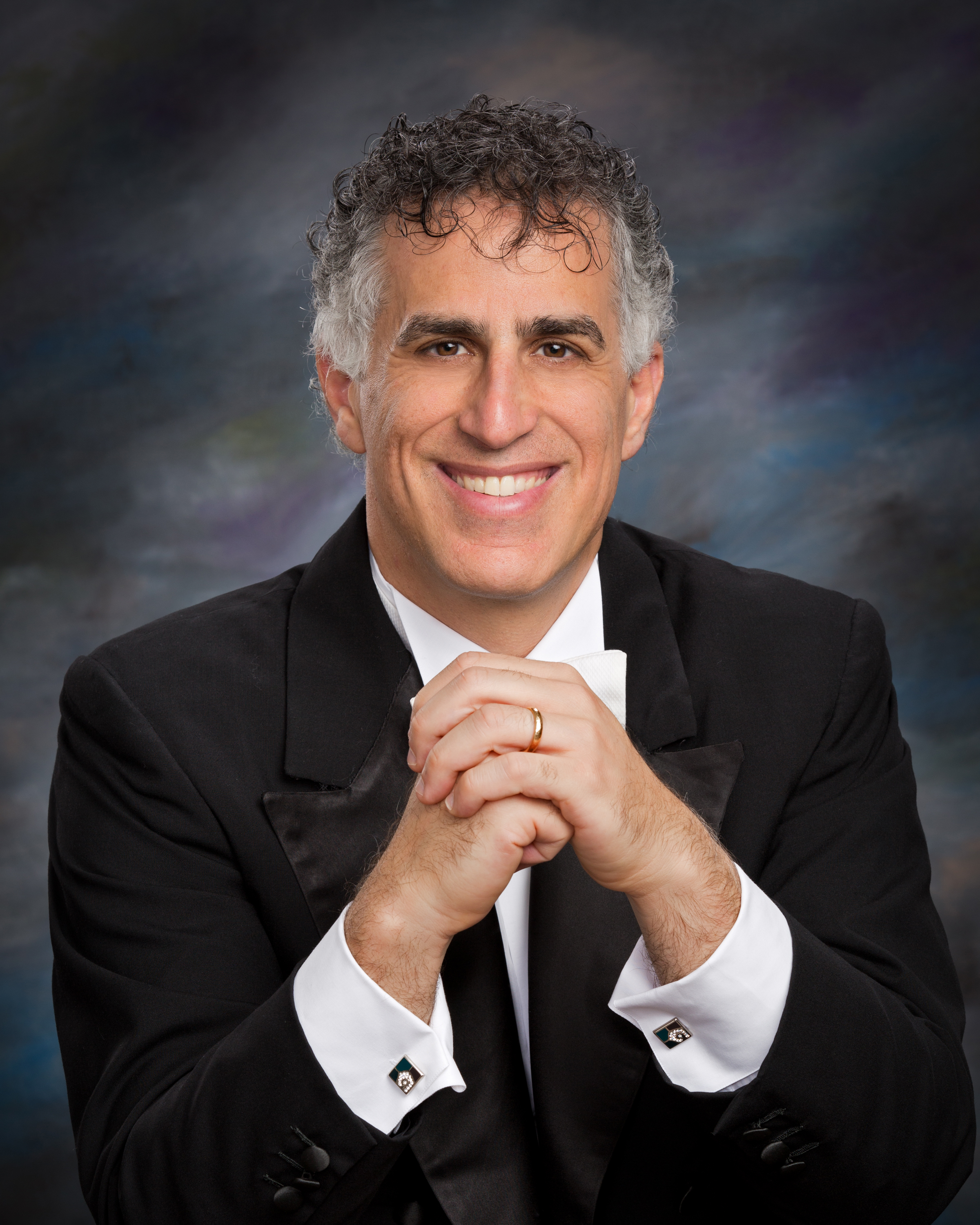
Conductor Nir Kabaretti


Composer Michael Gilbertson explains his piece Graffiti to the Santa Barbara Symphony audience while guest conductor Christian Reif looks on - all concert photos by David Bazemore


Guest conductor Christian Reif

Cellist Thomas Mesa




All photos by David Bazemore




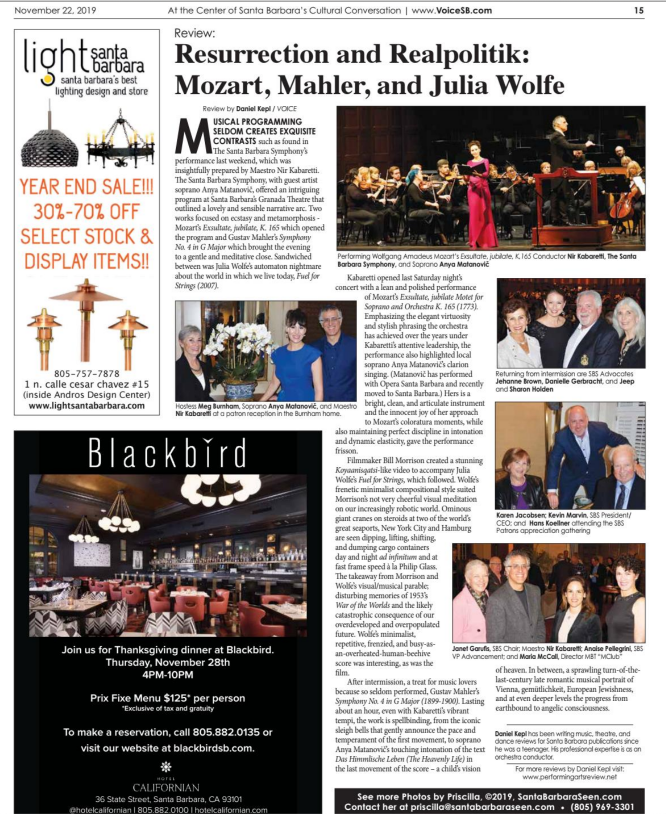
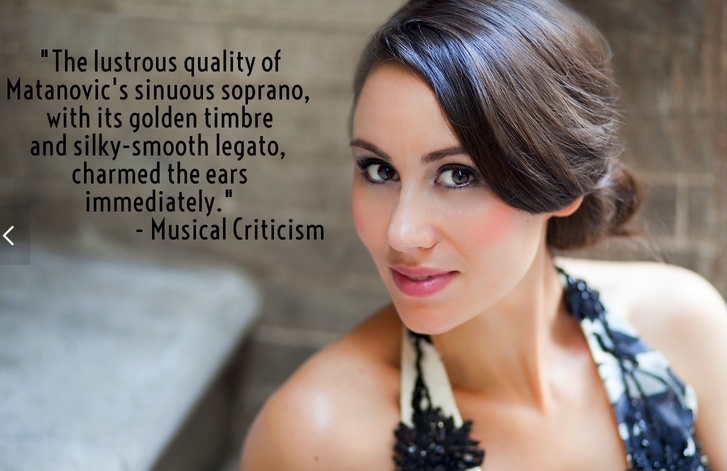
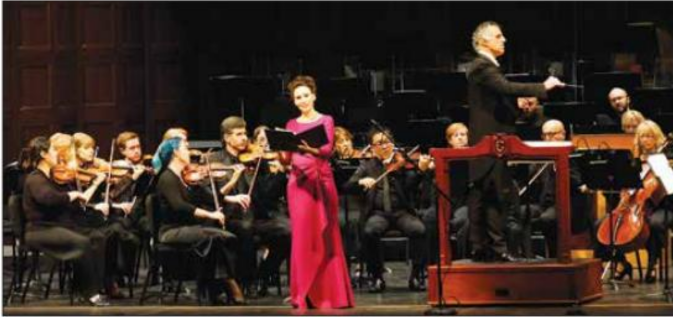


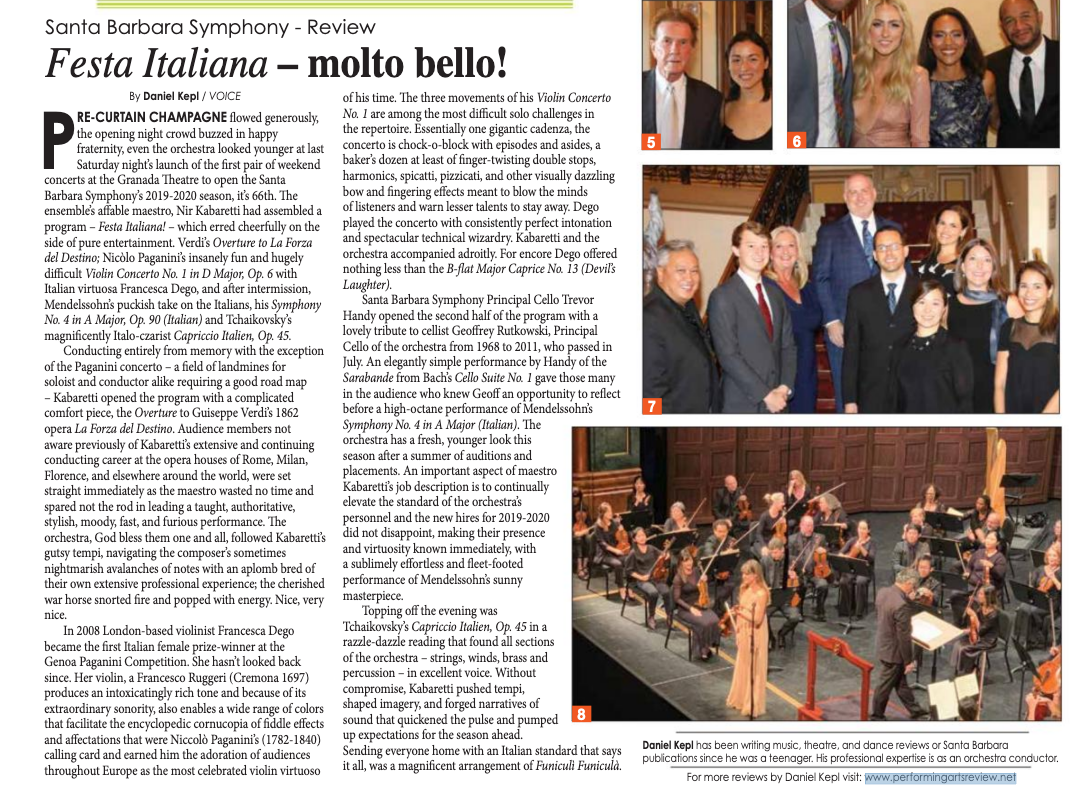
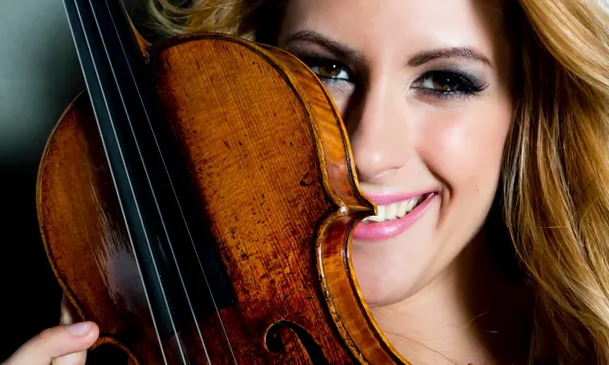
Violinist Francesca Dego
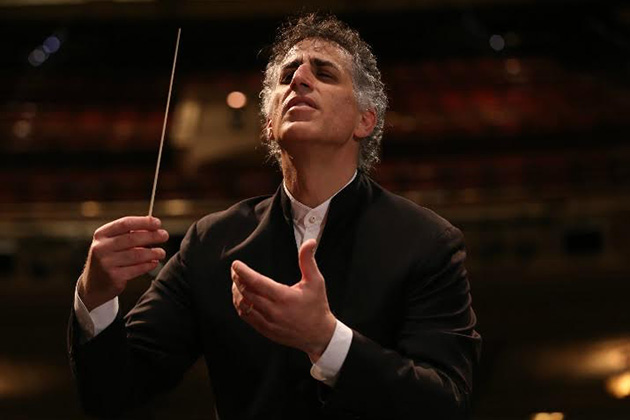
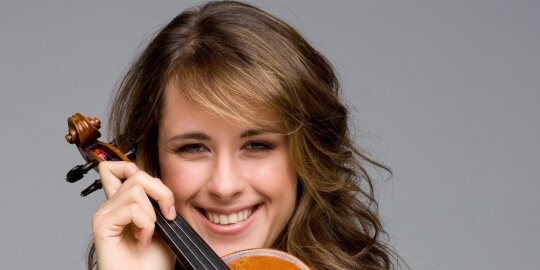

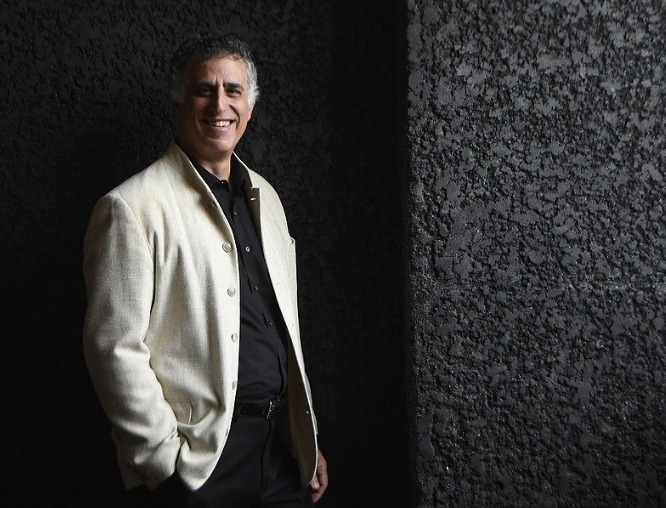
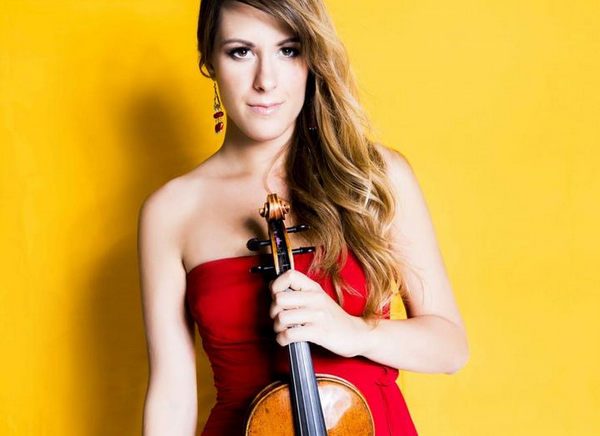
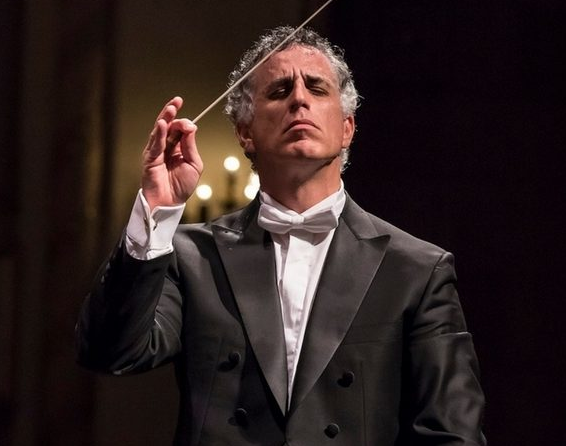

Lobero Theatre Chamber Music Series 2020-2021 — read the reviews
++ Here is my review for Santa Barbara’s arts weekly VOICE Magazine of the second set of recitals in the Lobero Theatre Chamber Music Series in Santa Barbara on February 8, 2020:
Visit Artistic and Music Director/violist Heiichiro Ohyama’s website
Visit Musical Advisor/violinist Benjamin Beilman’s website
Visit pianist Louis Schwizgebel’s website
Visit violinist Ida Kavafian’s webpage
Visit Clive Greensmith’s website
Shimmering Virtuosity
The Lobero Theatre’s new Chamber Music Project under Artistic and Music Director Heiichiro Ohyama’s supervision, with performing colleague violinist Benjamin Beilman Musical Advisor, returned to Santa Barbara’s Lobero Theatre on February 8th and 9th for two completely different yet similarly messaged programs of music by Beethoven, Prokofiev/Kodály and Brahms. A fabulous series debut on January 4 by pianist Alessio Bax and violinist Beilman set a high bar and augured well for the new Chamber Music Project. The recital I saw on February 8th confirmed earlier predictions.
A larger house at the February 8th recital – an excellent sign - was unusually focused and still throughout the evening for a program of works by Beethoven, Prokofiev and Brahms. Mesmerizing, leisurely and silken describes inadequately, the ensemble temperament and timbre of this powerful gathering of Heiichiro Ohyama’s musical friends. A subtly powerful concordance of experience and empathy between each player bespoke artistic unanimity – a rare pleasure to see and hear. Pianist Louis Schwizgebel; violinists Ida Kavafian and Benjamin Beilman; violist Heiichiro Ohyama and cellist Clive Greensmith gave listeners an evening of sonic elegance.
Beethoven’s Quartet for Piano and Strings in E-flat Major, Op. 16 (1797) performed by Schwizgebel, Kavafian, Ohyama and Greensmith opened the program at a dynamic level so soft and fragile in the opening bars of the first movement Grave: Allegro ma non troppo one fell completely under its spell, the audience as quiet and concentrated as the music making itself. Several interpretive wonders ensued, including whispered unison passage work that shimmered with perfect intonation and balance; terraced modulations from one characterful instrumental narrative to another that spoke to Beethoven’s kinky harmonic eccentricities even in his 20s and a model of performance practice that illustrated not just Beethoven’s virtuoso piano writing, but also his debt to Mozart and Haydn. The second movement Andante cantabile with its panoply of fabulously busy piano riffs, yummy viola inner voicing and luscious cello melodies served as amiable preamble to the last movement Rondo: Allegro ma non troppo which topped off the performance at a nice pace that nevertheless allowed plenty of opportunity to relish its several meaty and precocious developmental and modulatory passages.
Prokofiev’s Sonata for Two Violins in C Major, Op. 56 (1932) performed as if from a long-lost mindscape by consummate master Ida Kavafian and her former student and long since professional colleague Benjamin Beilman, was revelatory at several levels, most of them intuitive. Composed while Prokofiev was living in Paris exile from the Russian Revolution and its after-horrors, the work is haunting, particularly as performed by these two powerful intellectuals. By 1932 fascism was on the rise, Stalin was disappearing his enemies by the millions and Germany’s new Enabling Act (1933) would give Hitler unlimited power to do the same. From its sobering opening bars, the Andante cantabile speaks to profound resignation. Kavafian and Beilman bonded like survivors and provided the audience a level of perfection in musical imagery that matched timbre and technique to conscious and subliminal empathy; a stunning and deeply moving performance.
The second movement Allegro addresses with troubling and often explosive frenzy the helplessness and despair of that time, still reeling from worldwide financial depression, thus vulnerable to totalitarianism. With stunning virtuosity, the duo crushed it; flurries of musical rage assuaged somewhat by calms fraught with tense foreboding were communicated to the audience to chilling effect. The muted third movement Commodo (quasi allegretto), it’s bittersweet lullaby one of Prokofiev’s most touchingly prescient tunes, captured in the duo’s interpretation both sentimentality and calamity, touching our hearts in whispers. The last movement Allegro con moto gave some relief for its irresistible vigor. It takes true virtuosity to successfully navigate Prokofiev’s seldom performed Opus 56, a technical and intellectual Rubik’s Cube. Kavafian and Beilman honored themselves and enriched us all with their performance.
Pianist Schwizgebel, violinist Beilman, violist Ohyama and cellist Greensmith returned to the stage after intermission for a deliciously cordial performance of Brahms’ Quartet for Piano and Strings No. 1 in G minor, Op. 25 (1861). The nineteenth century presented itself casually, as might be expected from a time of gas light and horse-drawn carriage. The result, a performance of its four movements that was leisurely, the charm of Brahms’ inner voicing transparent throughout. Highlights: gorgeous dialogue between violist Ohyama and violinist Beilman in the Andante; cellist Greensmith’s opulent timbre throughout, likewise Ohyama; the heroic grandeur of the interpretation in general and the irrepressible energy of the Rondo alla Zingarese: Presto with its Hungarian folk tunes and many compositional zigs and zags, including a lovely solo piano bit, an interlude for string trio sans piano and a pulse-pumping finale.
Daniel Kepl | Performing Arts Review
++ Here is my review for Santa Barbara’s arts weekly VOICE Magazine of the debut of the Lobero Theatre Chamber Music Series in Santa Barbara on January 4, 2020:
Visit Benjamin Beilman’s website
Visit Alessio Bax’s website
Chamber Orchestra to Chamber Music Project: a phoenix rises
Violist /conductor Heiichiro Ohyama thrilled Santa Barbara audiences for nearly 40 seasons as Music Director of the Santa Barbara Chamber Orchestra. His appearances as a performing artist (viola) during the orchestra’s chamber music events were particularly magical, inspired by his virtuosity as a soloist and his deep understanding of the repertoire. Maintaining a professional ensemble of 30 or more musicians proved financially difficult and ultimately the Chamber Orchestra board decided to close its books and cede remaining assets and the future to the Lobero Theatre Foundation.
Working with maestro Ohyama for the past couple of years as the newly appointed Artistic and Music Director with violinist Benjamin Beilman functioning as Musical Advisor, the Lobero Theatre Chamber Music Project made its debut last Saturday (January 4, 2020) with a stunning program presented by two world class musicians hand-picked by Ohyama at the venerable venue that served for so many decades as the Chamber Orchestra’s home. What goes around, comes around.
Thanks to Ohyama, who brought him here regularly as a concerto soloist with the Chamber Orchestra, Santa Barbara audiences have had ample opportunity to savor and cherish the delicate musicality and peerless style of pianist Alessio Bax. Violinist Benjamin Beilman, the new Artistic Advisor to the Lobero Theatre Chamber Music Project is the fresh face in this rising from ashes metaphor. Judging from his fascinating interpretations and often jaw-dropping virtuosity performing sonatas by Bach, Busoni and Grieg last Saturday, the calculus for success with this new chamber music series in Santa Barbara’s busy classical music datebook is strong.
The overall arc of Saturday’s program, literally its dynamic range through the course of the evening’s three sonatas, might be described as something akin to a tsunami crescendo, from the whispered opening bars of the Bach sonata to the knuckle-whitening final moments of the Grieg sonata which closed the program. Beilman’s violin whispered in the Bach - nearly inaudible (stunning); his fortissimos reached the edge of harsh (be still my heart!) and were cheek to jowl and brain to brain with Allesio Bax’s enthusiastic collaborations at the keyboard. Beilman’s heady harmonic stew in deciding upon this particular set of works for his program - C minor (Bach), E minor (Busoni), C minor (Grieg) – posed the question, why? Bottom line, the sonic ambiance of these tonal universes resonated, not just at the surface but deep in the soul.
Just 30 and already an international sensation, American violinist Benjamin Beilman is an artist utterly without affectation. Every movement of his body, each marvelous to watch proof of his remarkable bow arm – a kaleidoscope of breathtaking coloration, dynamic subtlety and bar line busting phrasing – spoke volumes about his thoughtfully intuitive approach to both the instrument and his artistic integrity. As revelatory for completely different reasons as violinist Pamela Frank’s recent performance here, Beilman’s approach to Bach’s Sonata for Violin and Keyboard No. 4 in C Minor, BWV 1017 (circa 1720) was deeply reverent without drama, romantic to a fault without breaking any performance practice manners and above all easy, gentle and warm.
The third movement Adagio was particularly lovely, Beilman exploring the composer’s unusual harmonic eccentricities without unduly stirring otherwise still waters. For the last movement Allegro, Beilman and Bax were delightfully catty voice leading collaborators, but Beilman’s performance in particular hinted at aspects of the violinist’s command of force – his top dynamic - and the uses he would make of this power in the remaining two works on the program.
Ferruccio Busoni (1866-1924) lived in the US from 1894 to 1914 and again from 1920 to his death. His name rings bells with some music lovers for his famous piano transcriptions of other composers’ compositions, including iconic realizations for keyboard of Bach’s organ works. It’s not often that Busoni’s own portfolio is brought before the public; kudos to Beilman and Bax for programming this masterpiece. The Sonata No. 2 in E minor for Violin and Piano, Op. 36a (1898) is an extraordinary work that deserves to be an important part of the American consciousness and repertoire.
Intensely romantic and moody, one wonders if Busoni, a recent immigrant to America, might have been impacted by the Spanish-American War, which ceded The Philippines and Cuba to the US in 1898. Beilman gave the work its full and worthy breadth and measure, from whispered supplications to hugely heroic statements, often intoned quite intentionally from the instrument’s abrasive sound spectrum. The last section of the one-movement sonata, its exquisite chorale tune and variations allowed Beilman opportunity to unleash a firework or two of his own, but ultimately, sublimely, this amazing and neglected sonata settled down, it’s quiet ending a brilliant testimony to restraint.
Edvard Grieg’s Sonata No. 3 in C minor for Violin and Piano, Op. 45 (1886) rounded out the program and allowed both artists freedom to display their deep understanding of the emotional sinews of the work as well as its huge sonic capabilities. A Caprice of Kreisler as champagne encore and the new series closed in cascades of applause.
Daniel Kepl | Performing Arts Review

Recital photos by David Bazemore


Artistic & Music Director/violist Heiichiro Ohyama

Music Advisor/violinist Benjamin Beilman


Violinist Ani Kavafian


Cellist Clive Greensmith

Pianist Louis Schwizgebel
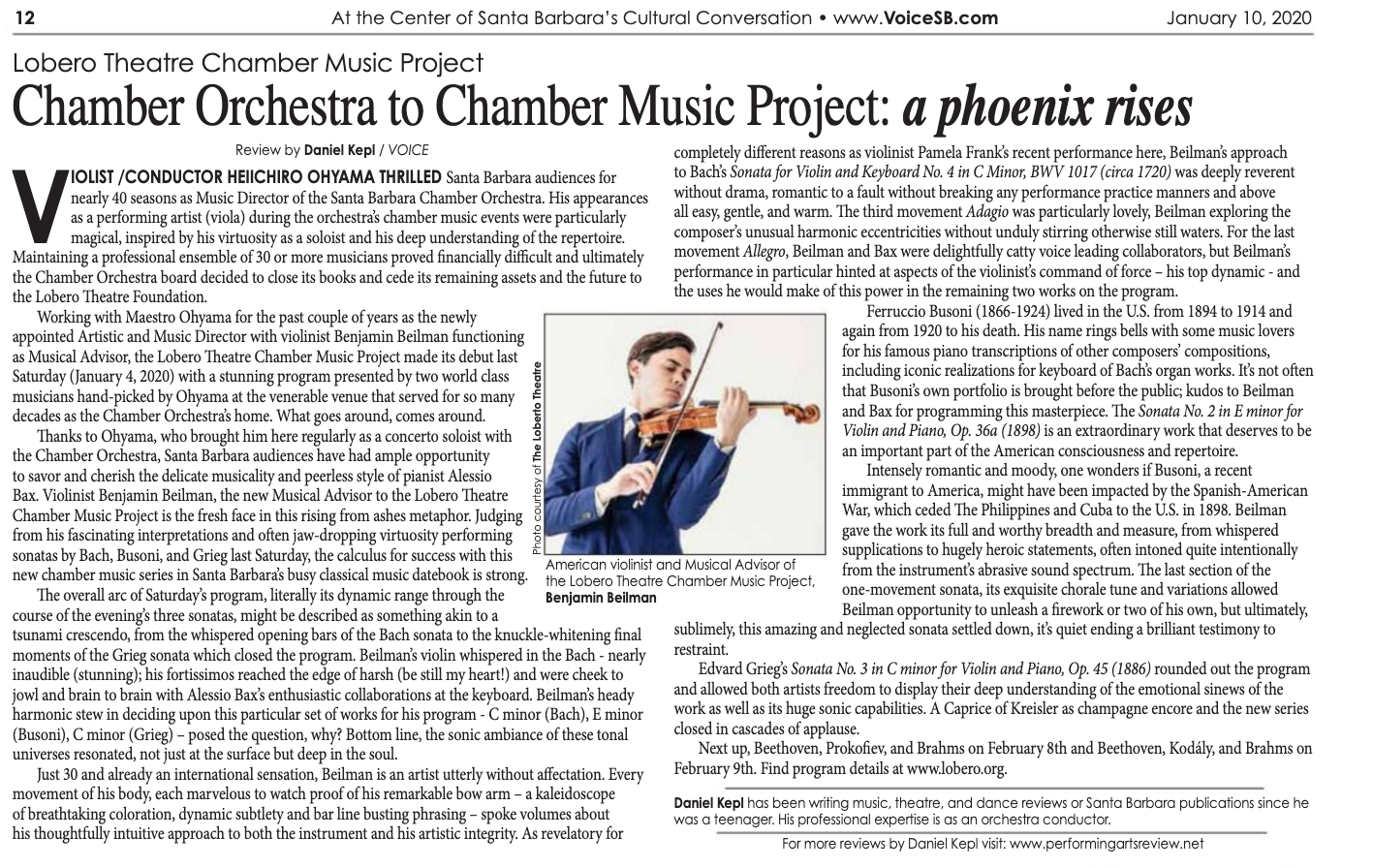
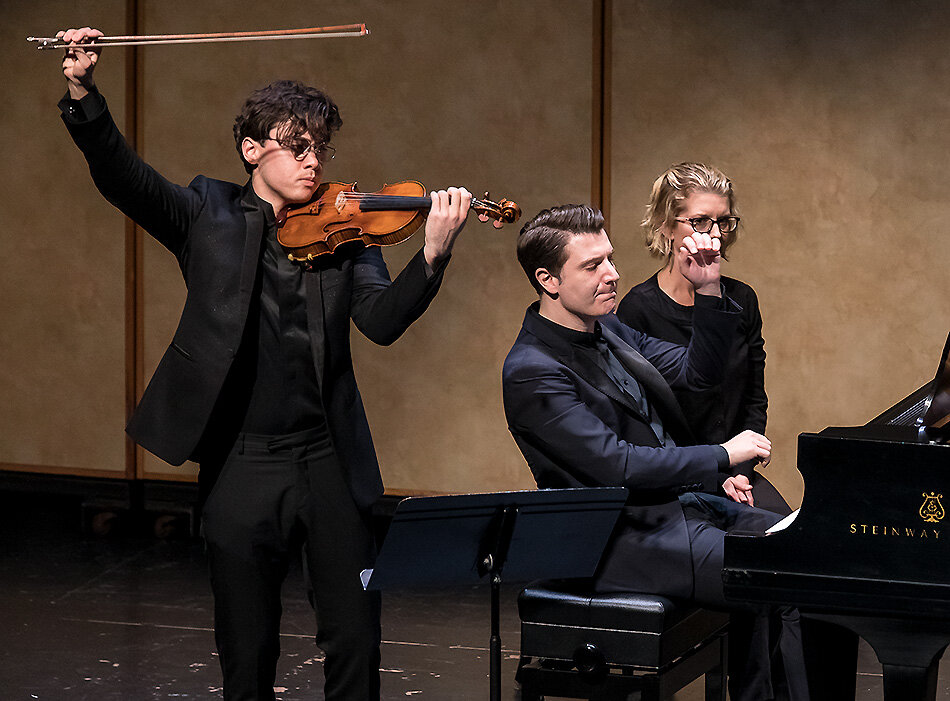
Action photography from the Lobero Theatre recital by David Bazemore
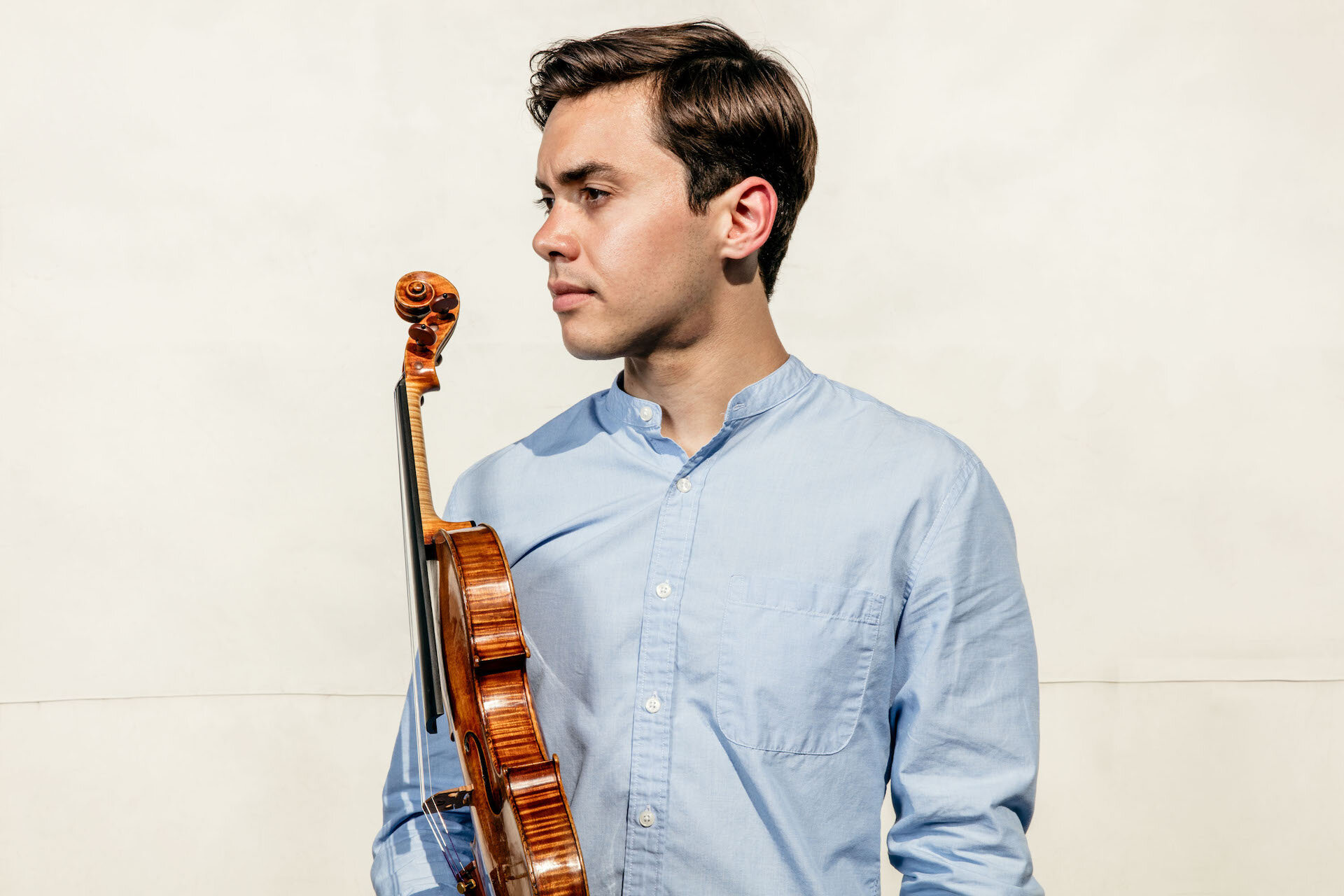
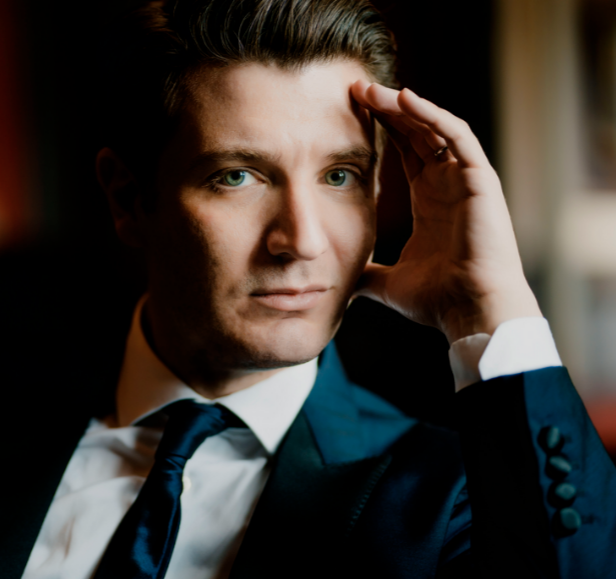
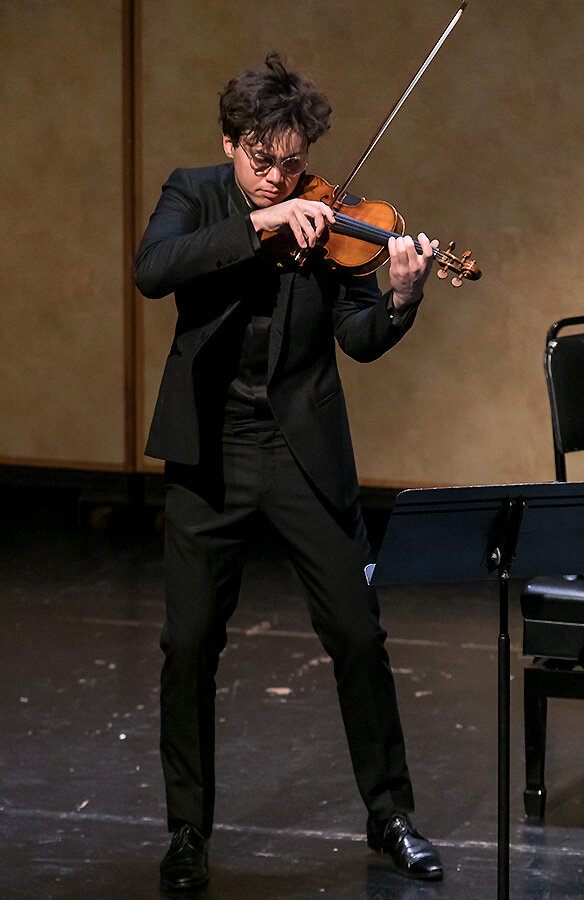
Action photography from the Lobero Theatre recital by David Bazemore
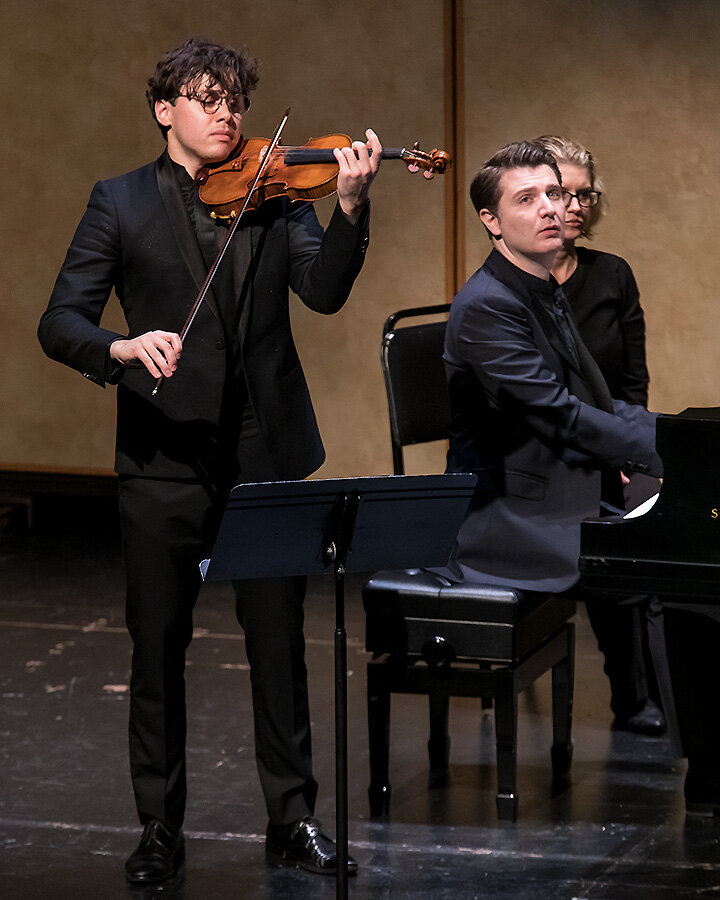
Violinist Itzhak Perlman: a master tells his story — read my review
++ Here is my review for Santa Barbara’s arts weekly VOICE Magazine of violinist Itzhak Perlman’s appearance at the Granada Theatre for his 75th birthday tour on January 21 2020:
Visit violinist Itzhak Perlman’s website
Visit pianist Rohan de Silva’s webpage
Itzhak Perlman: a master tells his story
Most everybody, classical music fan or not, recognizes the name of Israeli American violinist Itzhak Perlman. Winner of 16 Grammys and a Grammy Lifetime Achievement Award, four Emmys and the Presidential Medal of Freedom to single out a handful of the panoply of worldwide honors Perlman has garnered over the course of his career, the artist is celebrating his 75th birthday with an intimate touring program of delicious personal reminiscences, historic videos from his legendary life and in-person chats with his wife Toby about the struggles and triumphs of a musical genius who overcame polio and the prejudices of an insensitive world to become arguably the greatest violinist of this age.
Touched immediately by the warmth of Perlman’s sense of humor and wealth of anecdote, a sold-out Granada Theatre audience in Santa Barbara on January 21st melted with laughter and applause on several occasions as he described with often hilarious inuendo and anecdote, a childhood of tight financial resources in Palestine before it become the new state of Israel and his life-changing immigration to the US to study at The Juilliard School with violinist Ivan Galamian, where he met his wife and launched his spectacular solo career.
With his collaborator of the past several decades Rohan de Silva at the piano, Perlman performed bits of this and that, and chaperoned video clips from his Ed Sullivan Show TV debut as a teen and other milestones captured for all time on film and records, particularly performance clips from his earliest years as a newly discovered prodigy.
Speaking to the audience from his spiffy, state-of-the-art automated rocket ship (wheelchair would be a ridiculous misnomer) in a setting on the Granada stage a little like a family living room - coffee table of sorts for his fiddle and it’s little brother, a tiny fiddle that he played as four year old, an easy chair, empty for the first half of the presentation, then occupied by Perlman’s wife Toby, for a segment of treasured memories about career and family. A screen above and just behind the set facilitated Perlman’s monologue with a charming multimedia show of family pictures and home movies, while nestled in the middle of it all, pianist Rohan de Silva, Perlman’s collaborator of many decades.
After a greeting to the audience and some initial banter, including a viewing of the famous television debut segment on Ed Sullivan’s Cavalcade of Stars in 1958 at the age of 13, Perlman got down to a little business with pianist De Silva, Fritz Kreisler’s brief but powerful Tempo di Minuetto in the Style of Pugnani, followed by the first of several discussion points, beginning with how young is too young for a child to begin studying the violin? Explaining hilariously, his family’s recognition of then dilemma about their “young genius” and initial attempts to find a proper fiddle teacher, Perlman produced a tiny violin and illustrated on the Lilliputian instrument it’s never too early to begin learning.
Addressing two of the core events of his life before marriage and children – the lifelong influence of violinist Jascha Heifitz on Perlman’s aesthetic and the polio epidemic of 1948 which claimed his legs’ mobility – Perlman recounted losing music for a year or so before coming back to the violin at around four, then played for us his parents’ favorite piece, Franz Schubert’s Serenade from the collection Schwanengesang (Swan Song) composed near the end of the composer’s tragic life. An account of his audition and acceptance to The Juilliard School to study with Ivan Galamian as a teenager, a move to the US that transformed his career and another Kreisler piece, Cambarich Memoir, which Perlman recalled performing often at Jewish fundraisers during his Juilliard days, was followed by an anecdote about dumb luck – his Carnegie Hall debut review, which ran on the front page of the New York Times on account of a newspaper strike – and the profound challenge his handicap presented to his career as he experienced the silent discrimination of presenters and audiences alike.
A delightful treat, the appearance of Perlman’s wife Toby for some delicious banter about life and children (they have five) and a review of the 25th anniversary of The Perlman Music Program which Toby, a Juilliard grad herself, administers was followed by the evening’s denouement and perhaps the most moving story of all. Explaining his initial resistance to Steven Spielberg and John Williams’ invitation to play the violin part for the 1994 film Schindler’s List, Perlman recounted finally accepting the offer and recording the famous solo violin theme in Boston’s iconic Symphony Hall while watching a click track of the film. Saying simply, “I lost it,” Perlman described his emotional response to the film, then played for us Williams’ haunting tune. Not a dry eye in the house.
Daniel Kepl | Performing Arts Review

Violinist Itzhak Perlman with pianist Rohan de Silva | photos by David Bazemore







Santa Barbara-Kotor Sister City Chamber Music Recital — read my review
Visit the Santa Barbara-Kotor Sister City website
Visit the UC Santa Barbara Department of Music website
Visit pianist Andrija Jovovic’s Facebook page
Visit violinist/violist Sara Bashore’s Facebook page
Visit violinist Nastasja Vojinovic’s Facebook page
Visit cellist Katrina Agate’s Facebook page
++READ MY REVIEW FOR SANTA BARBARA’S ARTS WEEKLY VOICE MAGAZINE OF THE SANTA BARBARA-KOTOR SISTER CITY CHAMBER MUSIC RECITAL IN SANTA BARBARA ON JANUARY 31, 2020
Lingua Franca: Santa Barbara and Kotor musicians make music together
In 1956 President Dwight Eisenhower launched his People-To-People program promoting friendship between countries regardless of race, creed, nationality or color. The Sister City program has contributed to world peace by encouraging a vision of the planet and its many cultures as less confusing and more cohesive. Since 1956 Santa Barbara has made friends with seven sister cities including Kotor, Montenegro. Under the leadership of Founding Chairman and Co-Chair George and Denise Lilly, regular exchanges between Santa Barbara and Kotor have taken place since 2009 including visits between water polo teams, theater groups and culinary schools. Montenegrin classical musicians, including pianist Ratimir Martinovic, have been a regular part of the Santa Barbara-Kotor Sister City exchanges as well, presenting recitals on two or three occasions since 2009.
A promising new collaboration between the Santa Barbara-Kotor Sister City organization and UC Santa Barbara’s Department of Music was inaugurated last Friday night in Weinman Hall at the Music Academy of the West which promises to significantly increase contacts between musicians in the two cities. With funding from the SJL Foundation, four young professional musicians – two from Santa Barbara and two from Montenegro – came together for the first time to present a recital of music by Dvorak, Shostakovich, Fauré and Mozart. Music is indeed humanity’s lingua franca and the quartet of pianist Andrija Jovovic (Montenegro), violinist/violist Sara Bashore (Santa Barbara), cellist Katrina Agate (Santa Barbara) and violinist Nastasja Vojinovic (Montenegro), despite meeting to rehearse together for the first time only days earlier, played as one mind for a thoughtful and duly appreciative audience.
Originally scored for two violins, cello and harmonium, Dvorak’s Bagatelles, Op. 46 (1878) opened the program. Performed these days with piano replacing the harmonium, violinists Bashore and Vojinovic, cellist Agate and pianist Jovovic found immediate interpretive common ground in the first bagatelle of the set, Allegretto Scherzando, warming to each other still more in the second Tempo di Minuetto, Grazioso. As ensemble cohesion became more confident, blend and balance more focused, a vibrant energy and more nuanced discourse also evolved. By the Andante con moto fourth bagatelle one could sense a golden moment had arrived, the disparate musicians having found their collective sweet spot. A gorgeous wealth of color, dependent always on trust and consensus as much as technical prowess, filled the room with the wonder of the last bagatelle Poco allegro, its playful galop and fascinating trio section performed with gusto by the four musicians now colleagues and gave the audience a beautiful example of music’s indomitable connectivity with all souls.
Dmitri Schostakovich’s assistant Lev Atovmian arranged many of the composer’s works for various instrumentations over the years, all with the composer’s blessing including Five Pieces for Two Violins and Piano, the second work on the SB-Kotor program. Drawn from music Shostakovich composed for various other projects like the film The Gadfly (Prelude); the Third Ballet Suite (Gavotte and Elegy); a cartoon film The Tale of the Priest and his Servant Balda (Waltz) and the First Ballet Suite (Polka) the Five Pieces are if nothing else, a sentimental musical journey most of us have never heard. More powerfully, these settings to images of peasant life and summer harvests - a Russia between the two World Wars – is both fun and bittersweet. Violinists Vojinovic and Bashore, with pianist Jovovic, were in particularly sensitive liaison, giving the pieces their nostalgic due with colorful dollops of panache, including lots of stylish playing in the Gavotte, a subtle understanding of the Viennese waltz rhythm from Jovovic (Waltz) and a canny prescience about Shostakovich’s sly winks and coy nods throughout the set, particularly in the last piece, Polka.
Gabriel Fauré’s Élègie for Cello and Piano, Op. 24 (1880) found cellist Agate and pianist Jovovic in excellent partnership, executing Faure’s lamentations as well as his busier riffs with characterful aplomb. Mozart’s signature Piano Quartet in G minor, K. 478 brought the program full circle with all four artists (Bashore switching from violin to viola) offering sterling performances of its three movements. Rich ensemble playing, intelligent phrasing and embellishment, very little pedal from the pianist (thanks) and excellent balancing and voice leading throughout, produced a polished performance. Post-recital catering by Goran Milic, guiding light of the culinary aspect of the Santa Barbara-Kotor Sister City exchanges, served by members of the Santa Barbara water polo club who will visit Kotor this summer gave credence to the ecumenical nature of the Santa Barbara-Kotor Sister City programs.
Daniel Kepl | Performing Arts Review



Pianist Andrija Jovovic

Violinist/violist Sara Bashore

Violinist Nastasja Vojinovic

Cellist Katrina Agate

Martha Graham Dance Company: The Eve Project — read my review
Visit Martha Graham Dance Company
++READ MY REVIEW FOR SANTA BARBARA’S ARTS WEEKLY VOICE MAGAZINE OF THE MARTHA GRAHAM DANCE COMPANY AT THE GRANADA THEATRE IN SANTA BARBARA ON JANUARY 24, 2020
The Eve Project: celebrating the 19th Amendment and Martha Graham
Martha Graham, arguably the founder of American contemporary dance, graduated Santa Barbara High in 1911 and never looked back, creating the Martha Graham Dance Company in New York City in 1926. 93 years later, Graham having passed in 1991, the company remains one of the most innovative contemporary dance ensembles in the world under the leadership of Janet Eilber, who has been Artistic Director of the Martha Graham Center of Contemporary Dance since 2005.
With only two performances scheduled this season in California - San Diego and Santa Barbara’s Granada Theatre on January 24th - the company presented its homage to the 100th anniversary of the 19th amendment which gave the vote to women (The Eve Project) with an evening of choreography created exclusively by women, including Virginie Mécène’s reimagining of Graham’s 1933 ballet Ekstasis, based on Graham’s notes and still photos; Lamentation Variations (2007) created by the choreographic triumvirate of Aszure Barton, Liz Gerring and Michelle Dorrance and three iconic masterpieces from Martha Graham’s extensive catalogue, Diversion of Angels (1948), Errand Into the Maze (1947) and Chronicle (1936).
Martha Graham knew her music. She was one of the first American choreographers to commission new music by living American composers for her dances. The completely sold out Granada Theatre program opened with Graham’s masterpiece Diversion of Angels (1948) which describes, in colors as well as through Norman Dello Joio’s fabulous score, three aspects of love; mature/white, erotic/red and adolescent/yellow. An encyclopedic example of Graham’s utterly unique choreographic style, including a prescient exploration of minimalism - still life poses, mesmerizing hieroglyphic movements, geometric patterns informing a larger visual consciousness – the corps and three principal couples performed the piece to perfection, a clear commitment to historic accuracy and respectful live documentation.
Virginie Mécène’s 2017 reworking from historical bits and pieces, of Graham’s 1933 solo piece Ekstasis (1933) was both contemporary – a wonderful score by Ramon Humet – and respectful. Superbly erotic while also celebrating Grahams words “The body is a sacred garment,” Mécène’s inspired choreography has made this magnificent work whole again, danced by Natasha M. Diamond-Walker with thrilling prescience. Graham’s Errand Into the Maze (1947) to another fabulous score, this time by Gian Carlo Menotti, featured Charlotte Landreau and Lloyd Mayor in what has become one of the great duos of the modern dance repertoire; an often chilling, always intense tour de force of Graham’s eponymous and singular movement signature.
After intermission, a haunting silent film of Graham performing her solo piece Lamentation (1930) as inspirational fingerprint for Lamentation Variations (2007) by choreographers Aszure Barton, Liz Gerring and Michelle Dorrance. Four composers are tapped; George Crumb, Michael J. Schumacher, Michelle Dorrance and Jaco Pastorius. A tour de force for three sets of soloists and the entire company, the Barton Variation was danced by Anne O’Donnell and Laurel Dalley Smith, the Gerring Variation by Lloyd Knight with So Young An, Alessio Crognale and Leslie Andrea Williams. The final Dorrance Variation featured So Young An, Alessio Crognale, Natasha M. Diamond-Walker, Lloyd Knight, Charlotte Landreau, Jacob Larsen, Lloyd Mayor, Marzia Memoli, Anne O’Donnell and Leslie Andrea Williams.
The last work on the program, Graham’s monumental Chronicle (1936) for women dancers, to a gripping score by Wallingford Riegger presages the approach of World War II in three dramatic movements, Spectre – 1914 featuring the magnificently persuasive power of soloist Anne Souder; Steps in the Street, the women of the company entering and marching in total silence at its beginning – unnerving - and Prelude to Action a ritual of preparation for what all the world sensed in 1936 was approaching conflict, to Riegger’s heroically cinematic score.
Daniel Kepl | Performing Arts Review
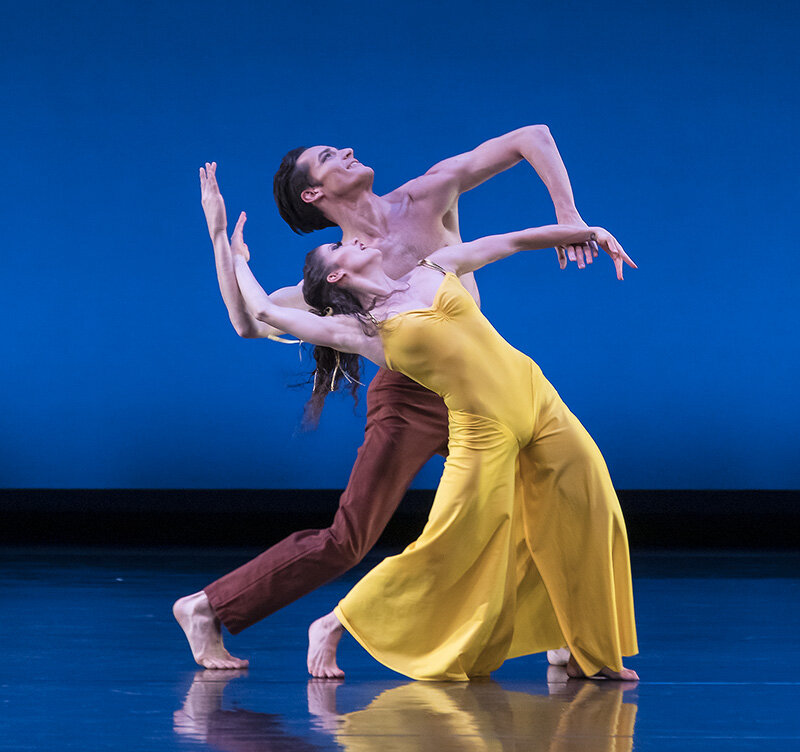
Photos by David Bazemore








State Street Ballet: Rodney Gustafson's Nutcracker
Visit State Street Ballet
++ Here is my review for Santa Barbara’s arts weekly VOICE Magazine of State Street Ballet’s production of Rodney Gustafson’s choreography to The Nutcracker on December 21 and 22 2019:
Rodney Gustafson’s magical choreography for The Nutcracker
Santa Barbara’s internationally acclaimed State Street Ballet was back in town last weekend after touring the west presenting artistic director Rodney Gustafson’s choreographic take on The Nutcracker. The company gave the home audience opportunity to see its finely tuned performances last weekend (December 21-22) at the Granada Theatre.
Gustafson’s endearing and visually beautiful original choreography and staging of Tchaikovsky’s poignant masterpiece enchanted Saturday night’s audience and reminded this witness to more than a few productions that The Nutcracker in its various choreographic iterations over the past 120 years continues to hit home, delighting as well as moving audiences as readily in 2019 as it did at its premiere in 1892, just one year before the composer’s tragic death.
Gustafson’s Nutcracker is, well, innocently curvaceous, its choreographic narrative clean and clear to the eye. E. T. A. Hoffmann’s creepy-good tale about young Clara’s dream-state adventures with the Nutcracker Prince in a not altogether friendly Land of Sweets remains sacrosanct, yet Gustafson also brings fresh insight and new ideas to his interpretation of the iconic story. Characters in Hoffmann’s narrative that take Gustafson’s eye are highlighted with focused choreographic attention.
Two roles in particular, Drosselmeyer the magician and Mother Ginger, have been given more significant choreographic and acting tasks by Gustafson. SSB principal Sergei Domrachev who has been with the company since 1997, stole the show last Saturday night, as he no doubt does whenever he dances these two disparate characters. His stunning professionalism, masterful sense of timing and humor, disciplined and artful acting exaggerations and incredible footwork, made both roles uniquely his. Nothing cheaply comedic about Domrachev’s interpretations. Rather, a Marcel Marceau-like perfection of disciplined body movement and mimed expression. Bravo, maestro Domrachev!
Tchaikovsky’s music for The Nutcracker stretches two and a half hours plus when performed, which is seldom, in its totality. As the ballet has been tweaked by various choreographers over the years beginning with Petipa/Ivanov, the score has also been sliced and diced to satisfy need, taste and time. Gustafson’s Nutcracker is in the neighborhood of an hour and a half with one intermission, yet he has chosen to keep one or two dances that are not ordinarily heard or seen in the de rigueur realization of the work performed this time of year throughout the world since the 1940s. What a thrill to hear music and see dance sequences that are not familiar.
As Santa Barbara’s resident professional dance company, it is always a delight to see familiar artists perform their accustomed roles in this annual rite of holiday passage. Francois Llorente is a relative newcomer to the company and his pairing on Saturday night with another newcomer Saori Yamashita in Arabian made for a stunningly beautiful duo. The Grand Pas de Deux in the second act was performed on Saturday night with style and familiarity by Deise Mendonça and Jack Stewart.
In an imaginative twist by Gustafson, the traditional role of Rat King is replaced by a Rat Queen and on Saturday night Anna Carnes turned in a charmingly dastardly performance. Jack Stewart nailed Cavalier on Saturday, kudos as well for Deise Mendonça’s Sugar Plum Fairy. Hoffmann’s dream weaver Clara was realized with elegant form and poise on Saturday night by Ella Rotondo, her Nutcracker Prince, Noam Tsivkin.
Bennett Ruehlman (Soldier Doll); Alvaro Oquita (Grandmother); Tanner Blee (Snow King); Arianna Hartanov and Chloe Kelley (Spanish); Marika Kobayashi and Oscar Bravo Ly (Chinese); Amara Galloway, Tanner Blee and John Christopher Piel (Russian); Emma Lawrence (Maid); and multiple additional roles danced by several of the above, brought Gustafson’s sweet Nutcracker vision to vibrant life.
Angels, snowflakes, bon-bons and assorted dewdrops courtesy of Gustafson Dance; imaginative costume design by A. Christina Giannini and colleagues; the Opera San Luis Obispo Grand Orchestra in the pit under the baton of Brian Asher Alhadeff with the added magic of the Matilija Junior High Chamber Choir, Thomas Frederickson director, as Tchaikovsky’s angelic voices, made for a splendid evening.
Daniel Kepl | Performing Arts Review
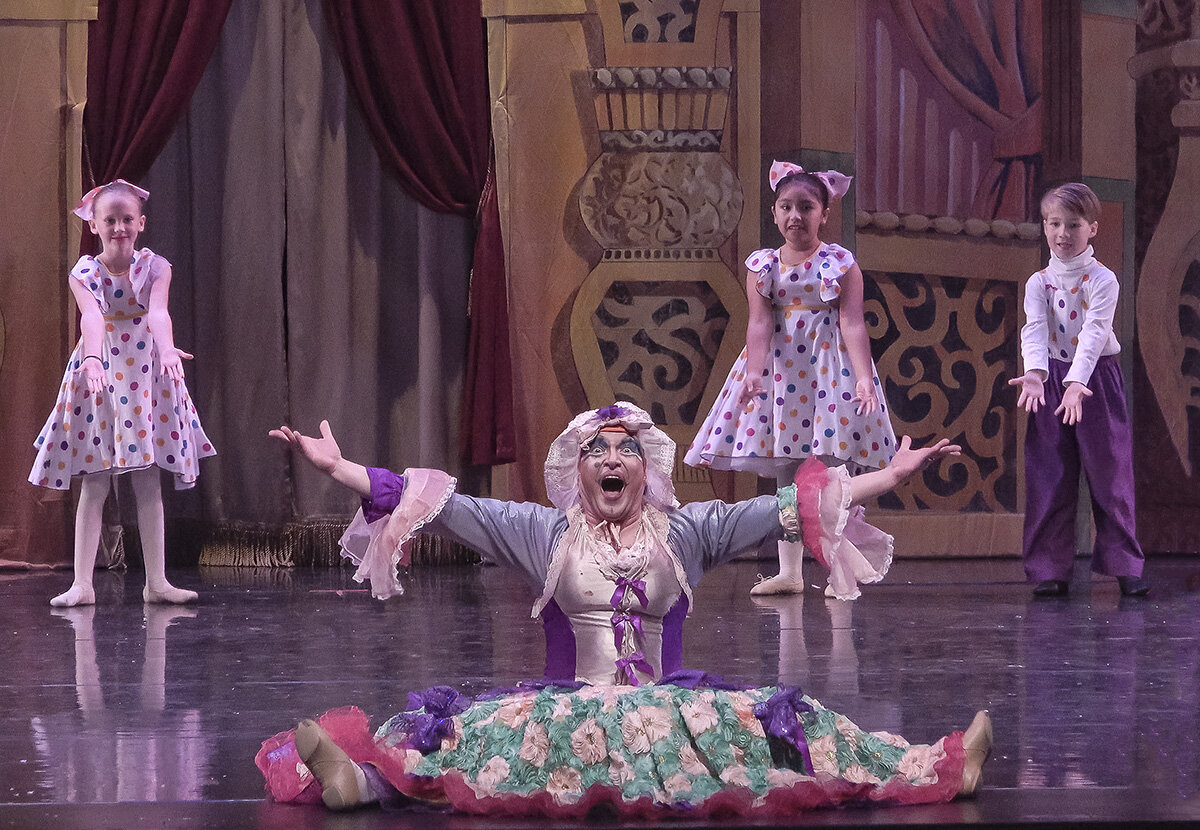
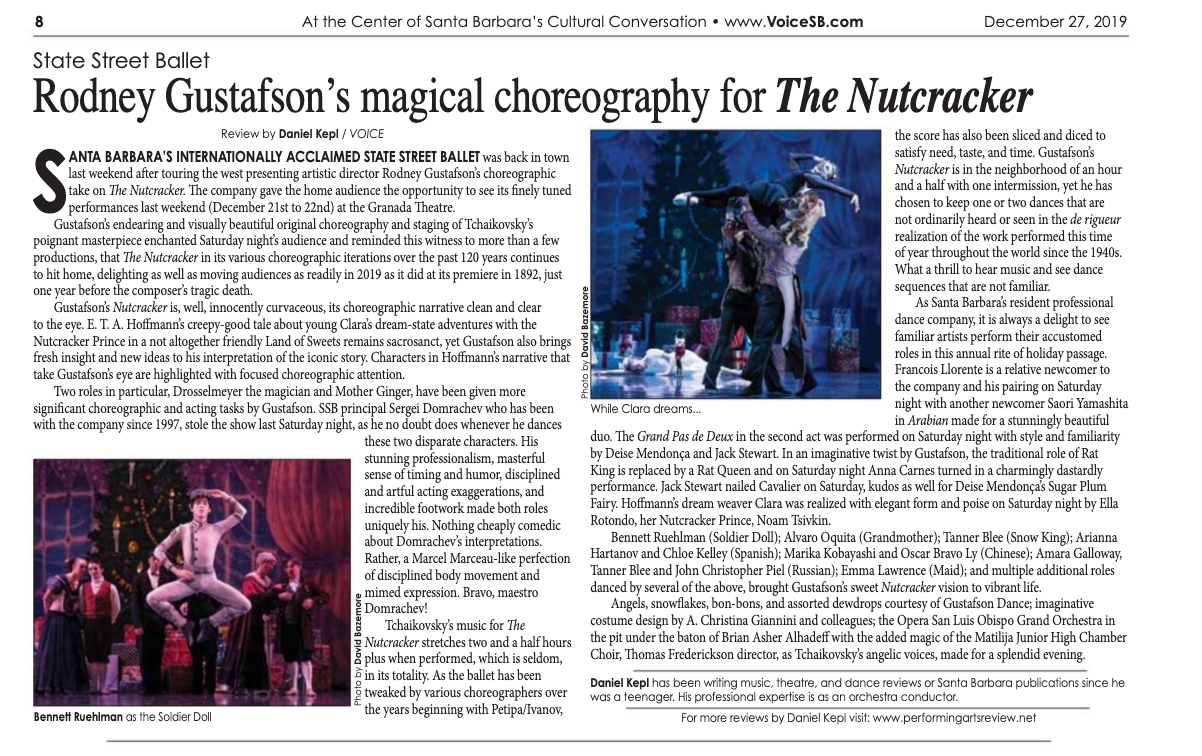
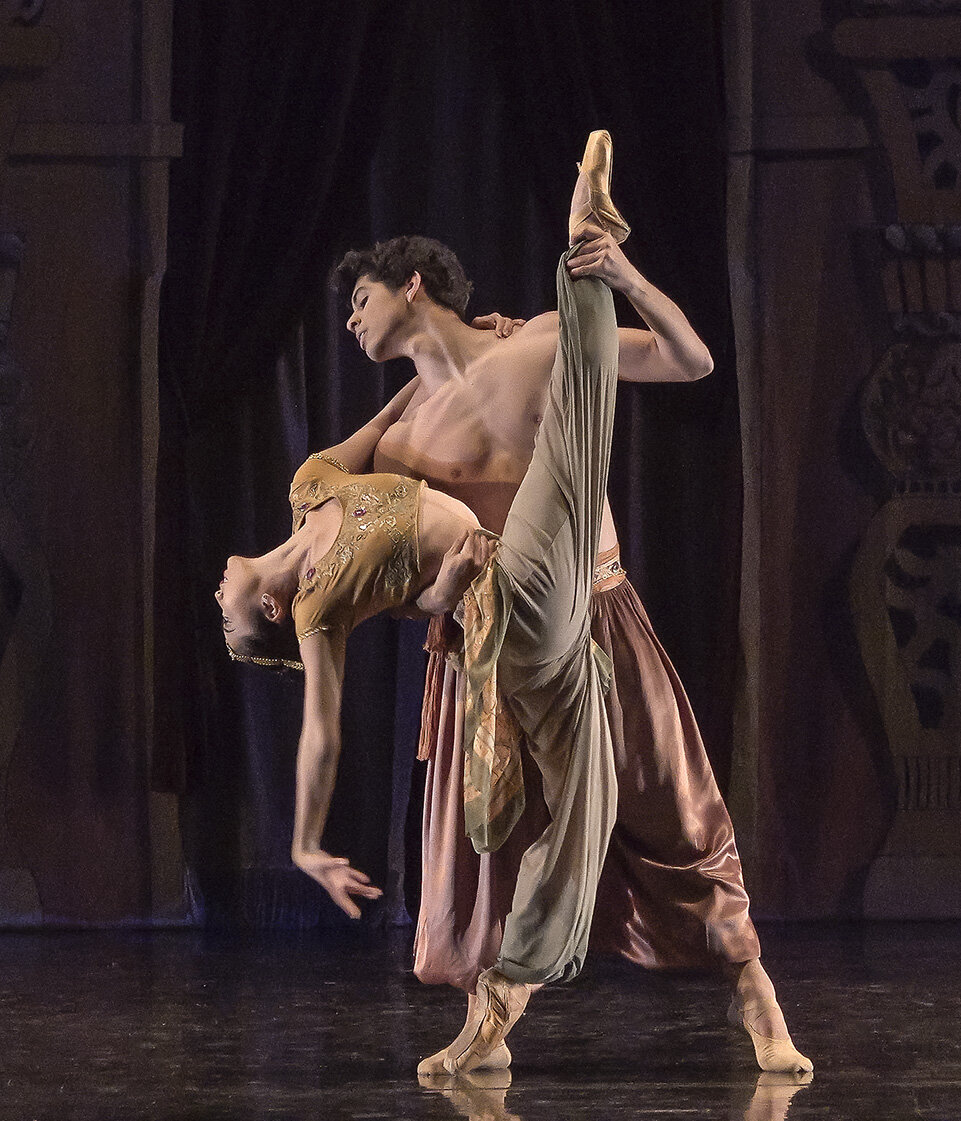
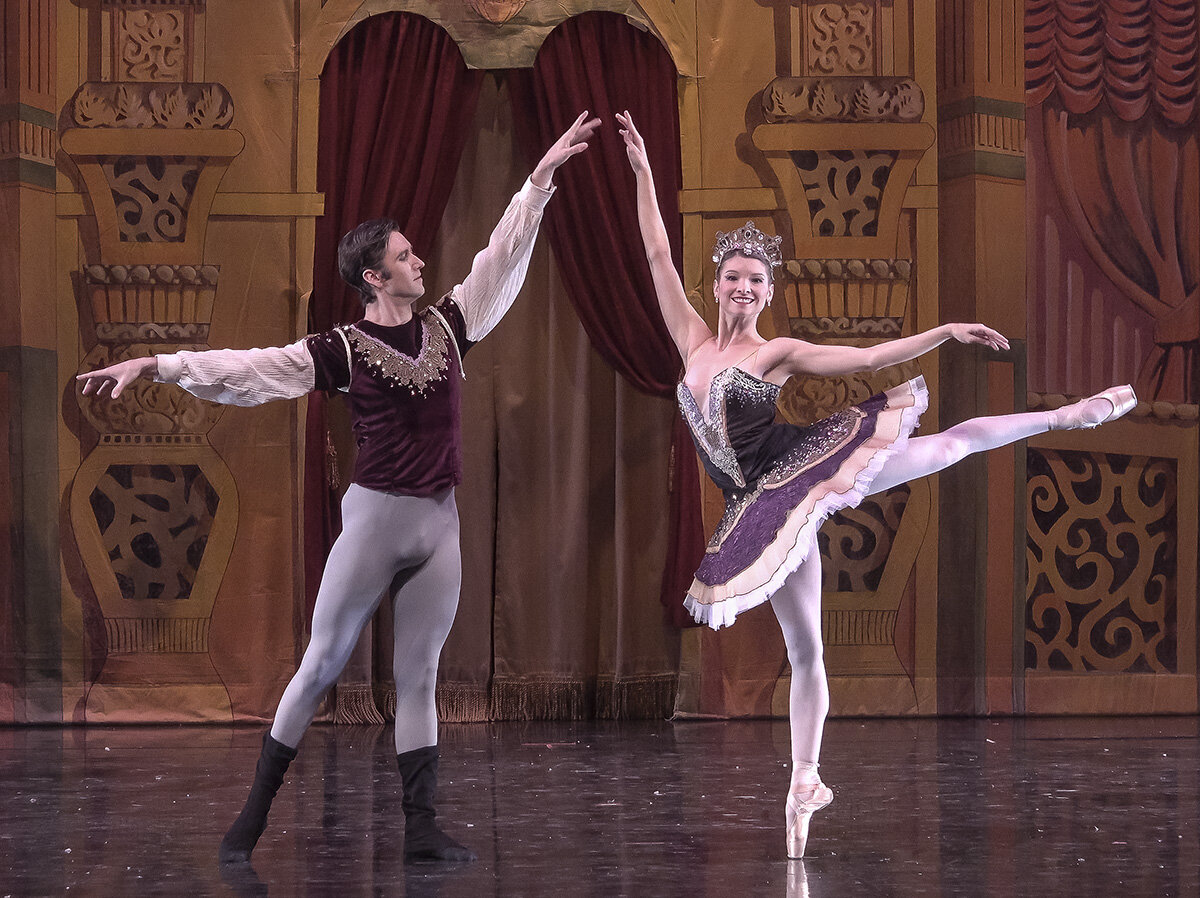
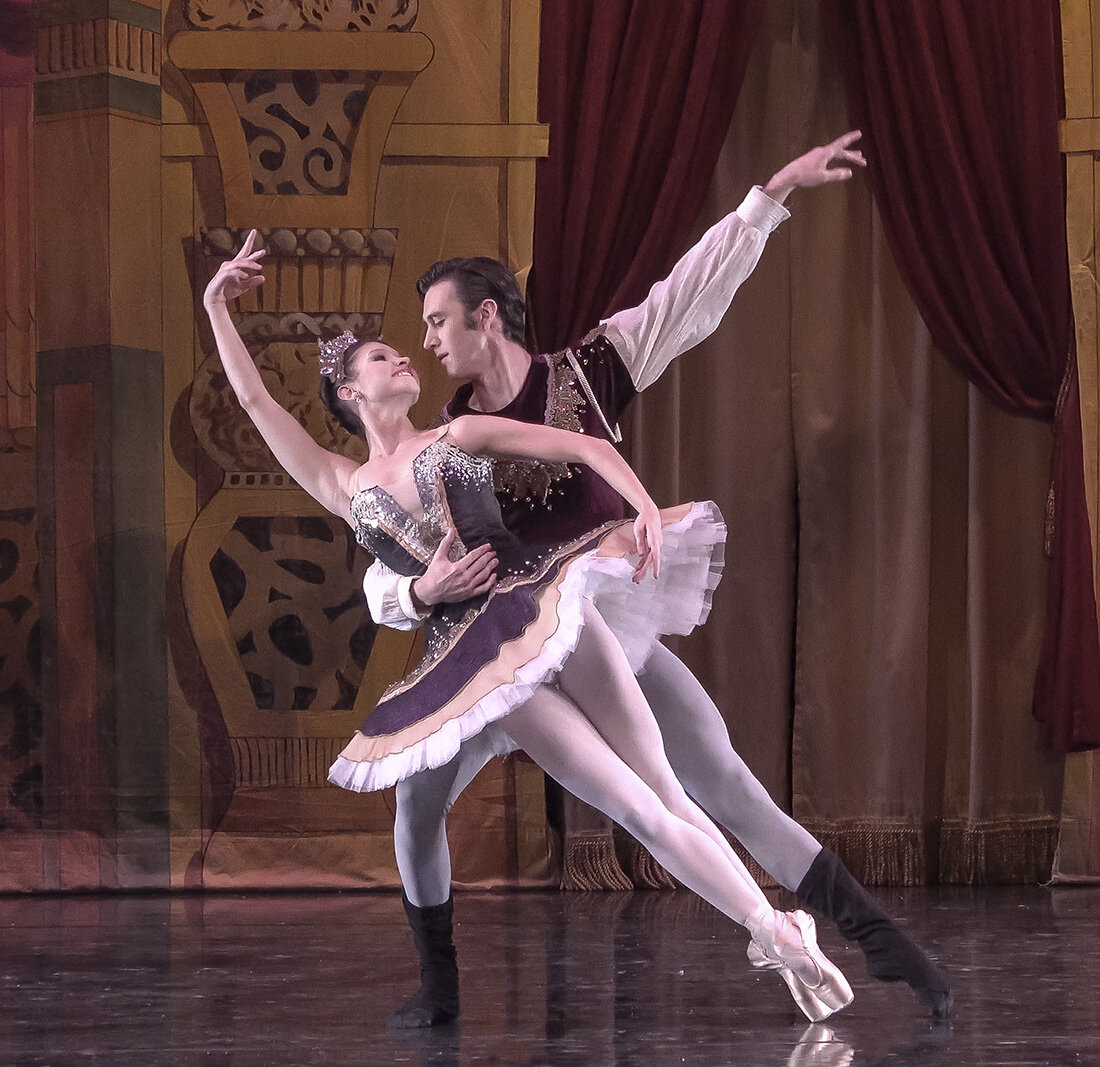
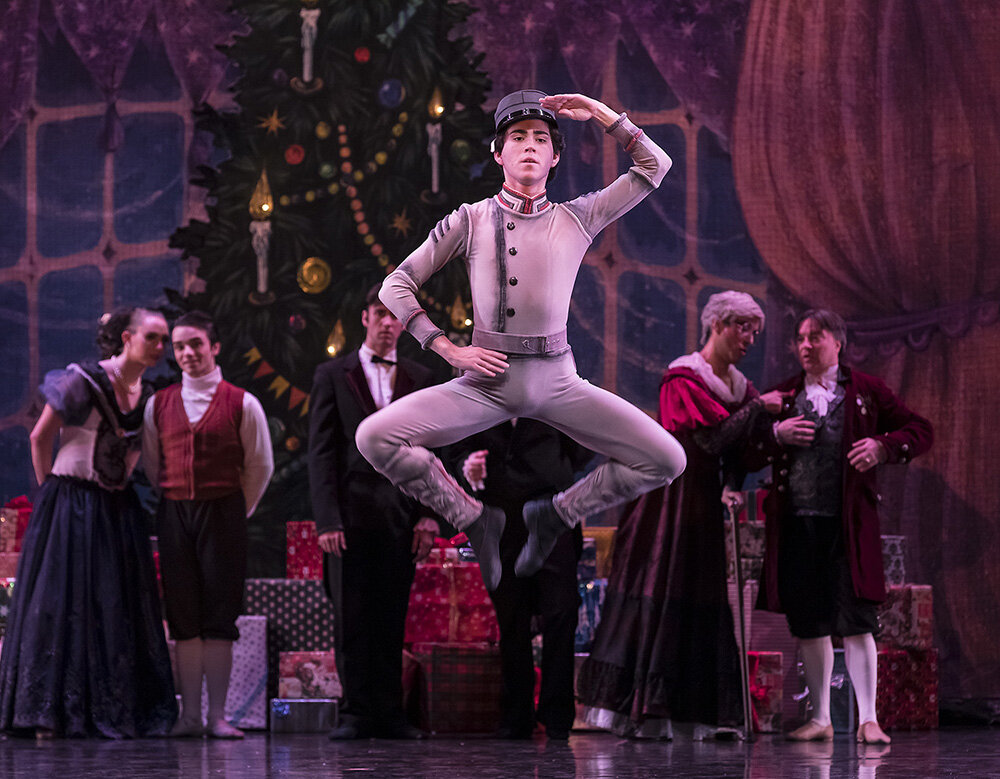
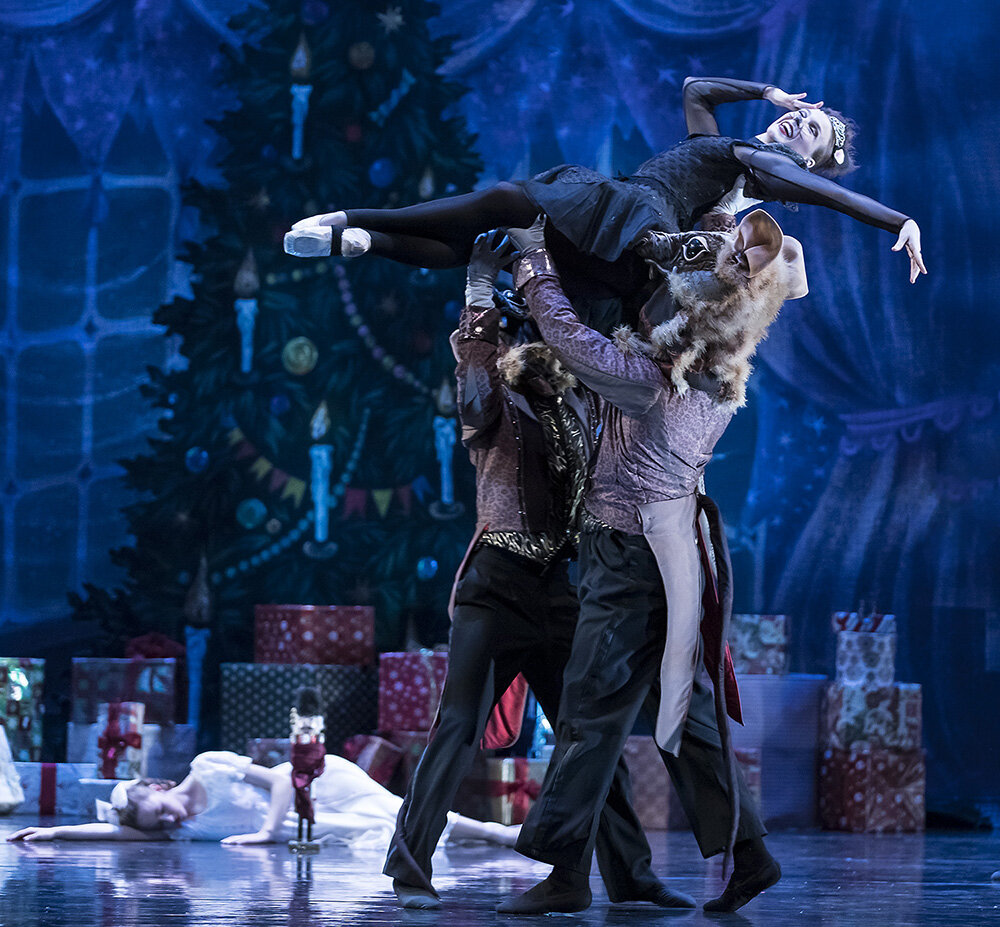
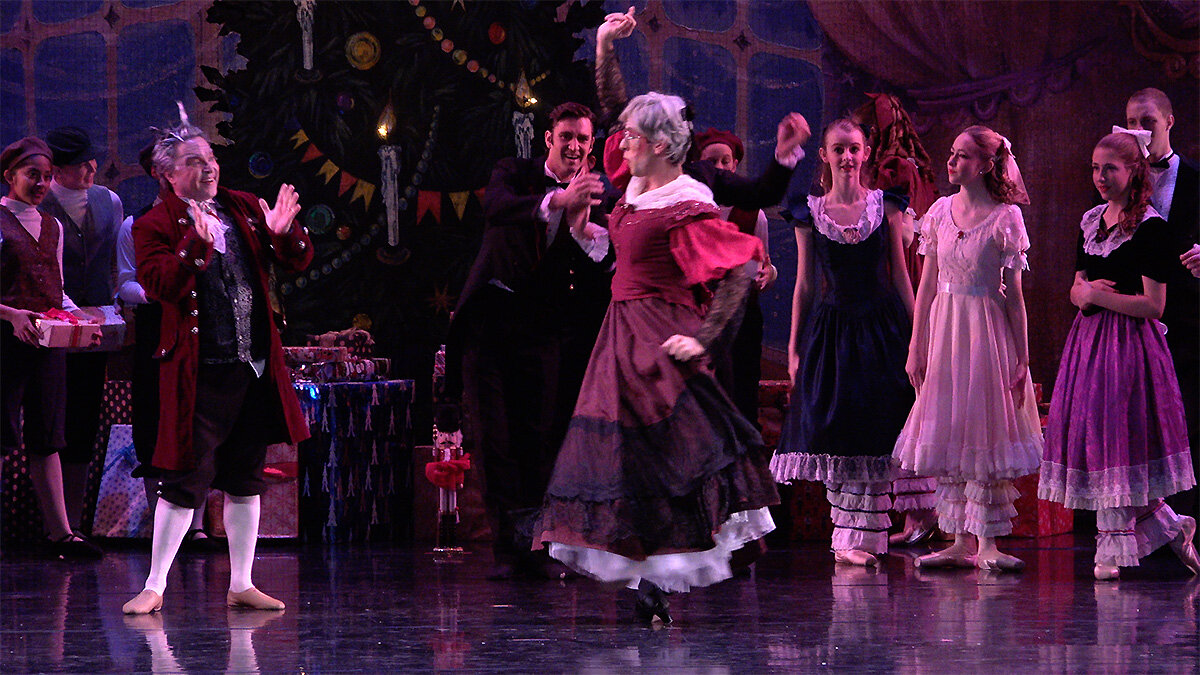
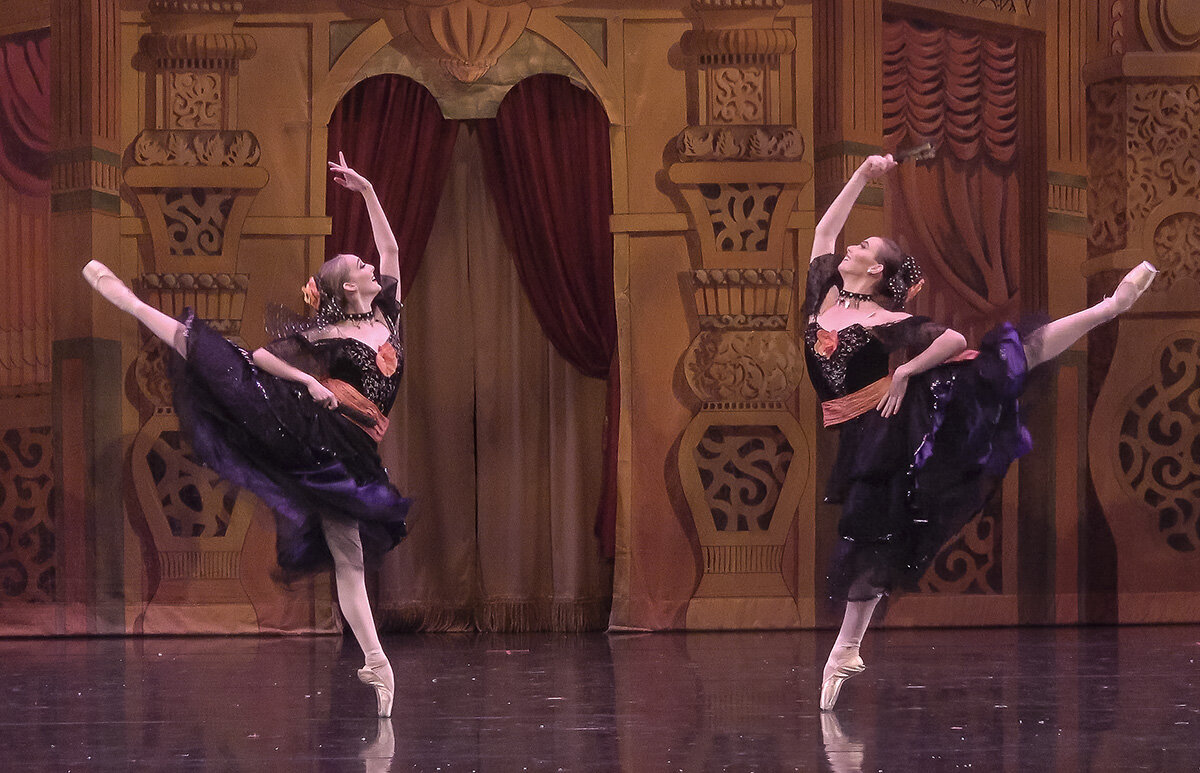
Santa Barbara Festival Ballet: 45th Nutcracker at the Arlington
Visit Santa Barbara Festival Ballet
++ Here is my review for Santa Barbara’s arts weekly VOICE Magazine of Santa Barbara Festival Ballet’s 45th Nutcracker at the Arlington on December 14 and 15 2019:
Celebrating its 45th Nutcracker at the Arlington!
Traditions are wonderful, they remind us of where we’ve been and what lies ahead. Traditions can also become a bit stale over time, gathering dust in the comfort of regularity and repetition. Not so, Santa Barbara Festival Ballet’s 45th annual iteration of Tchaikovsky’s masterpiece, The Nutcracker. Fondly branded Nutcracker at the Arlington! this community-wide artistic achievement at Santa Barbara’s famous Arlington Theatre on December 14 and 15 surpassed by several light years, the production I saw when Artistic Director Aimee Lopez first took the helm at Festival Ballet about three years ago and made it clear even then, she had in mind the complete revitalization of the project.
Participants from various age groups and dance schools, colleges and conservatories around the city including the Festival Ballet Conservatory (Denise Rinaldi, Director) came together as they have for decades to make this production a community effort. What stood out from the get-go at Saturday night’s performance on December 14 was the high level of artistic achievement this miracle amalgam of diverse local talent has mustered since I last saw the ballet about three years ago. Costumes were fresh and colorful, lighting design was interesting and innovative and character acting, from the youngest peppermint cookie baker to venerable Mother Ginger, came off as engaging and believable. Beautifully placed mini-scene vignettes like the hairbrush schtick at the opening of Act I and the party guest who reads continuously even when dancing, were sprinkled throughout the ballet with a wink and nod toward choreographic innovation and a little fun. The result of all this attention to detail, a thoroughly engaging visual narrative.
Seeing is believing and the maturity and professionalism of the 45th Nutcracker at the Arlington! was certified in spades by the precise execution of several ensemble scenes. A vibrant collegial confidence among our local dancers was palpable, from the little bakers’ circle dance right through and including the battle scene with the Rat King and the Waltz of the Snowflakes. Speaking of traditions, Festival Ballet has always hired a professional orchestra for its Nutcracker at the Arlington! Led for the umpteenth year by conductor Elise Unruh, the orchestra’s live musical enhancements contributed greatly to the irresistible magic and wonder of the performance I saw on December 14. Kudos to harpist Elisabeth Zosseder in particular and all sections of the orchestra, who assayed some of the most exposed and difficult passagework in the dance repertoire with admirable aplomb.
Featured guest artists this year were Misa Kuranaga (Sugar Plum), formerly of Boston Ballet, now principal dancer with San Francisco Ballet; fellow San Francisco Ballet principal Angelo Greco (Cavalier); Michelle Meltzer (Snow Queen) and Braeden Barnes (Snow Cavalier) of Visceral Dance Chicago and Tracy Kofford (Arabian Cavalier) who is Director of Dance and Artistic Director of Santa Barbara Community College Dance Company. Festival Ballet’s Kaia Abraham was a magnificent Clara this year, her footwork impressively elegant and stylish. Other Festival Ballet soloists included Elise Arcuri (Harlequin Doll, Dream Mouse, Marzipan, Lilac Maiden); Ava Gosselin (Dream Mouse, Spanish Dancer, Lilac Maiden); Mina Hall (Snowflake, Dew Drop Fairy); Floriane Noel (Dream Mouse, Snowflake, Chinse, Lilac Maiden); Ella Onishuk (Soldier Doll, Snowflake, Spanish Dancer, Lilac Maiden);Stella Wing (Snowflake, Lead Marzipan, Lilac Maiden) and a host of student guest artists and apprentices.
A special shout out to Chris Carmona, whose Drosselmeyer was intense and scary; Matthew Kleeburg (Rat King and Battle Scene sword fight choreographer); Thea Vandervoort Palencia (Frau Silberhaus, Mother Ginger) and Festival Ballet’s long-time guiding light and mentor, Resident Choreographer and Interim Executive Director Valerie Huston.
Daniel Kepl | Performing Arts Review
CAMA: violinist Pamela Frank & pianist Stephen Prutsman
Visit violinist Pamela Frank’s website
Visit pianist Stephen Prutsman’s website
++ Here is my review for Santa Barbara’s arts weekly VOICE Magazine of the Community Arts Music Association’s Masterseries presentation of violinist Pamela Frank and pianist Stephen Prutsman at the Lobero Theatre on December 11, 2019:
Violinist Pamela Frank plays Bach: nothing PC about this performance!
Community Arts Music Association’s centennial season continued on December 11, 2019 in Santa Barbara’s historic Lobero Theatre with another of its Masterseries chamber music recitals sponsored by the Esperia Foundation. Violinist Pamela Frank and pianist Stephen Prutsman, who was subbing for an indisposed Peter Serkin, presented the complete set of six Sonatas for Violin and Keyboard by Johann Sebastian Bach. For intelligent artistic reasons, the sonatas were performed on modern instruments, enabling a clearer hearing of the fascinating but not accidental harmonic anomalies in the scores. A full house honored the duo with rapt attention and hearty applause.
Pamela Frank is professor of violin at the Curtis Institute of Music. In addition to her broad international career as a guest soloist with major orchestras, Frank coaches promising young violinists during the summers at the Tanglewood, Ravinia, Verbier and Caramoor Center for the Arts Festivals. A Los Angeles native, pianist Stephen Prutsman is comfortable playing music from diverse cultures and languages including jazz and classical idioms. Recipient of an Avery Fisher Career Grant in the early 1990s and winner of a host of major international piano competitions, Prutsman is comfortable in small clubs as well as the great concert halls of the world.
Composed when Bach was in his 30s (1720-1723) the six Sonatas for Violin and Keyboard are unique not only for their several harmonic and cadential eccentricities, but also because they are seldom performed at all. As a lifelong music lover, I discovered within the first few bars of the concert’s opening Sonata No. 2 in A Major, BWV 1015 that I had never heard the piece before! With the possible exception of the Sonata No. 1 in B minor, BWV 1024 the six were completely unknown to me. While a respectful level of period performance practice was observed by Frank and Prutsman, the sonatas when performed on modern instruments invite a robust exploration of Bach’s sometimes unusual harmonic turns and cadential twists; the “odd” chords and progressions that can be heard clearly when played on the modern piano and violin.
The four movements of the Sonata No. 2 gave fair notice - the audience takeaway for the night would be exhilarating. Frank’s beautifully round, widely colored and flat-out romantically expressive playing matched perfectly, Prutsman’s encyclopedic skills as a collaborator. The pianist’s occasional improvisatory fancies lent discreet spice to his already well-organized period embellishments and his jaw-dropping array of keyboard colors and terraced dynamics abetted the magical rapport the two established and enjoyed throughout the evening.
The remainder of the first half of the program consisted of the Sonata No. 5 in F minor, BWV 1018 – the first movement Largo being particularly memorable for Frank’s rich tone, while the last movement Vivace thrilled on account of its furious virtuosity – and the Sonata No. 3 in E Major, BWV 1016 with its amazing opening Adagio which sounded for all the world like birdsong. The remaining three movements of the work displayed a wealth of colorful narrative between violin and piano, performed with technical prowess and stunning ensemble balance and control by the duo.
The Sonata No. 4 in C minor, BWV 1017 opened the second half of the program, followed by the Sonata No. 1 in B minor, BWV 1014 and the truly odd but incredibly satisfying Sonata No. 6 in G Major, BWV 1019. All three gave the audience opportunity to settle in and soak up Frank’s gorgeous tone, her expressive and impressive soft playing, her elastic phrasing and beautifully disciplined bow arm. Prutsman was also given a lovely solo cameo or two in the course of the three sonatas of the second half and made impressive use of his permit to embellish freely.
With unquestioned technical virtuosity and probing intellectual curiosity, violinist Pamela Frank and pianist Stephen Prutsman have re-examined Bach’s Sonatas for Violin and Keyboard and found their eccentricities compelling. For this audience member at least, the experience was revelatory.
Daniel Kepl | Performing Arts Review
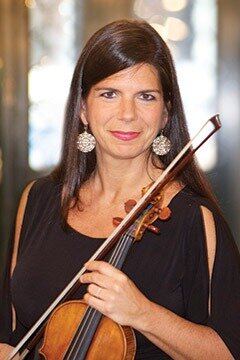
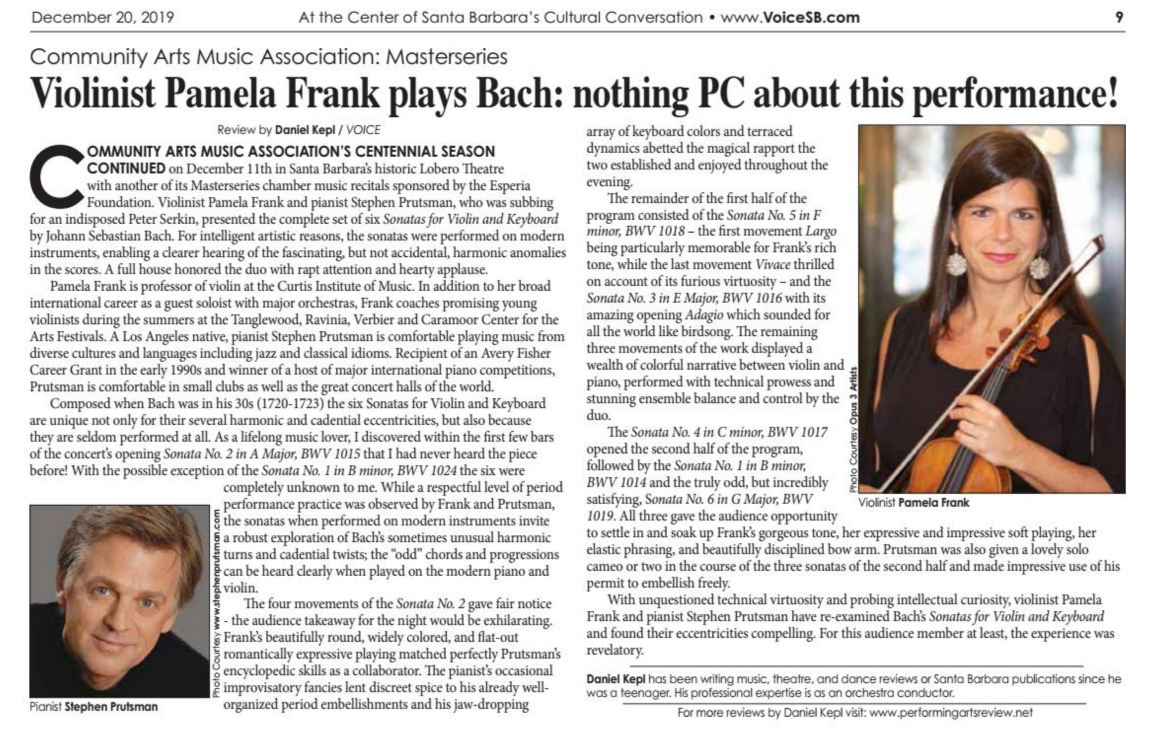



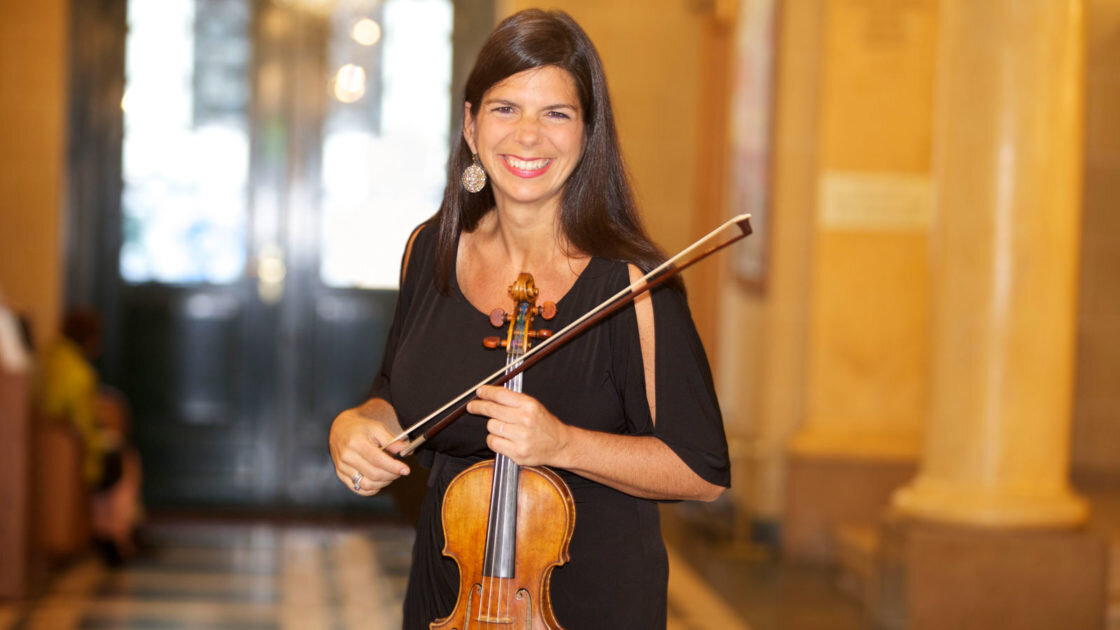



Jasper String Quartet: The Force is with them! — read my review
Visit the Jasper String Quartet’s website
++ Here is my review for Santa Barbara’s arts weekly VOICE Magazine of the Jasper String Quartet’s concert at the Santa Barbara Museum of Art on November 21, 2019:
Jasper String Quartet – The Force is with them!
The Santa Barbara Museum of Art’s Mary Craig Auditorium is a wonderful chamber music venue. Seating about 125 it offers an intimate audience experience. A bit dry acoustically, visiting ensembles, especially string quartets, must adjust their sound projection accordingly. Philadelphia-based Jasper String Quartet gave a superb recital there last week (November 21st) and filled the room to bursting with their huge sonic presence. On the program, Beethoven’s String Quartet Op. 18, No. 4 in C minor (1801); an intriguing work by composer Vivian Fung, her String Quartet No. 3 (2013) and Schubert’s heartbreaking String Quartet No. 14 in D minor (1824) known as Death and the Maiden, composed at the beginning of the composer’s horrifying five-year decline and death from what was at that time incurable syphilis.
Charismatic, describes the thrilling energy, perfect intonation, stunning blend and intellectual prowess of the Jasper String Quartet. Founded in 2006 while they were studying together at the Oberlin Conservatory, violinists J. Freivogel and Karen Kim, violist Sam Quintal and cellist Rachel Henderson Freivogel have filled their Jasper trophy rack with international prizes and awards ever since. The ensemble’s latest CD, The Kernis Project: Debussy was released in June and has garnered rave reviews. A compelling force majeur in the heady and competitive world of international string quartets, the Jasper Quartet is the real deal.
With the exception of Vivian Fung’s contemporary Quartet No. 3, the program last week began and ended with virtuoso standard repertory of the nineteenth century; Beethoven’s Quartet No. 4 and Schubert’s Death and the Maiden. Opening the concert with Beethoven, the Jaspers immediately transformed the room, the audience and in particular the acoustic, filling the place with a remarkably focused, full-bodied and gorgeously blended sound. The second movement Andante scherzoso quasi allegretto with its coy humor, Mozartean temperament, beautifully crafted fugato and bright C Major tonality in an otherwise C minor sound world, sparkled with color and dynamic fun despite Beethoven’s ever-present brooding on darker matters. The Jasper’s clean, crisp playing, perfect intonation and flawless technical execution illuminated all four movements, especially the last, Allegro – Prestissimo.
Canadian-born composer Vivian Fung is gifted with an imagination both intuitive and naïve. Her mesmerizing String Quartet No. 3 composed in 2013 is sophisticated in its structure, precisely to achieve the magical simplicity of her several sound illusions - a parlor organ intoning one of the guiding motives of the work; cluster chords of exquisite otherworldly beauty; an angelic chorale tune; birdsong. In one continuous movement and lasting about 10 minutes, Fung’s quartet is a reflection at least partially, of the composer’s personal milieu, thoughtful and meditative when west and east are in harmony, harsh, perilous and craggy as the mountains of Banff National Park (the work was commissioned by the Banff Centre and the Canadian Broadcasting Corporation) when tectonic plates literal and metaphysical, shift.
Sliding pitches, fascinating modes, sounds from centuries past and contemporary mashup, the work’s otherworldly ascending drift and dispersal at its end represented not only magnificently skillful musical narrative, but philosophical metamorphoses. The Jasper’s made each note count. Clarity of ensemble timbre and voice leading, superb intonation and studied attention to every riveting emotional detail informed first time listeners to the savories of this wonderful addition to the string quartet repertoire.
After intermission and by virtue of its majesty, the stand-alone work of the evening was Schubert’s 14th of 15 string quartets, Death and the Maiden. Arguably the most famous of the lot, every professional ensemble learns, loves and performs this masterpiece regularly. Catch is, how to keep the experience fresh for audience and players alike? From the first notes, Jasper Quartet’s interpretation jumped off the page. Informed and stylish, rich in detail, profoundly moving, the four voices of the quartet a rich blend of timbre and temperament, theirs was a revelatory achievement that will remain in memory for its energy and insight.
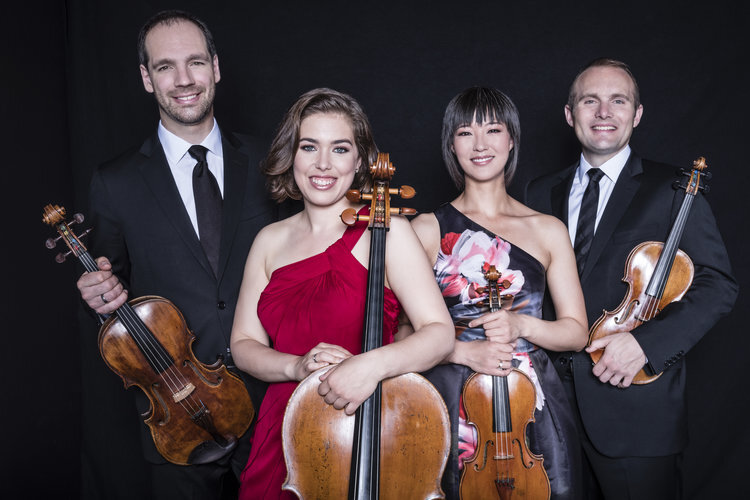
Left to right - violist Sam Quintal, cellist Rachel Henderson Freivogel and violinists Karen Kim and J. Freivogel
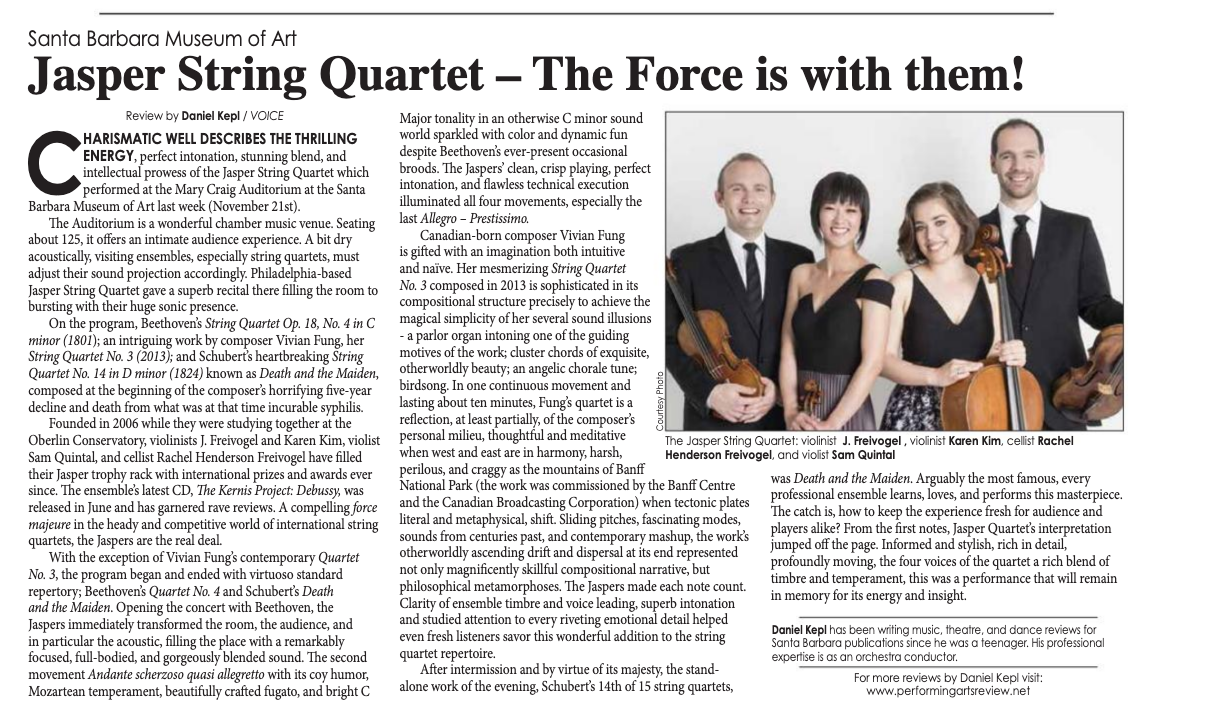

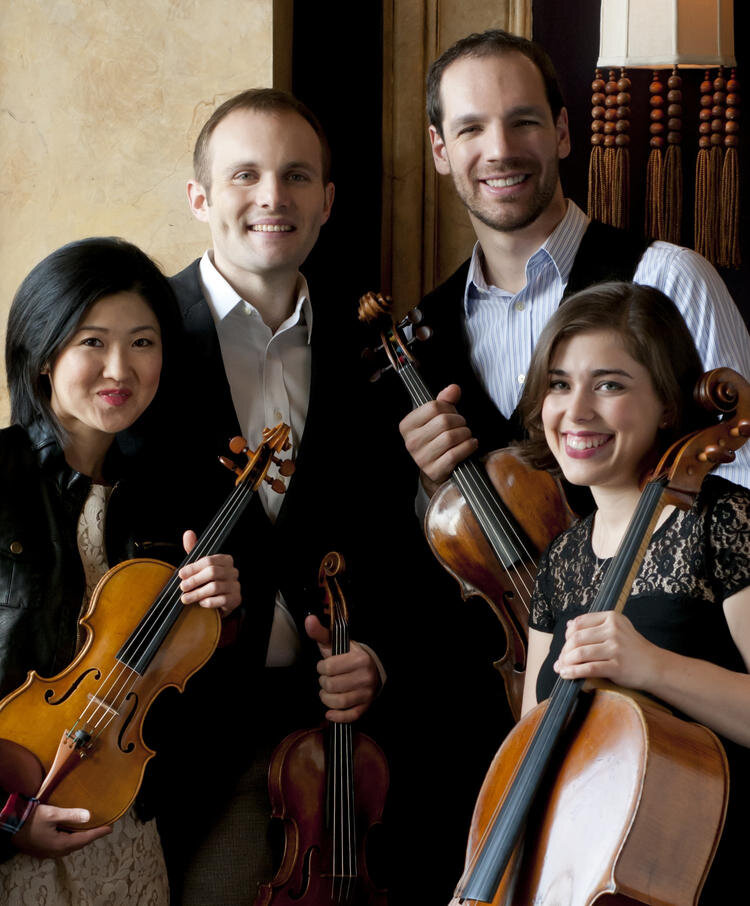

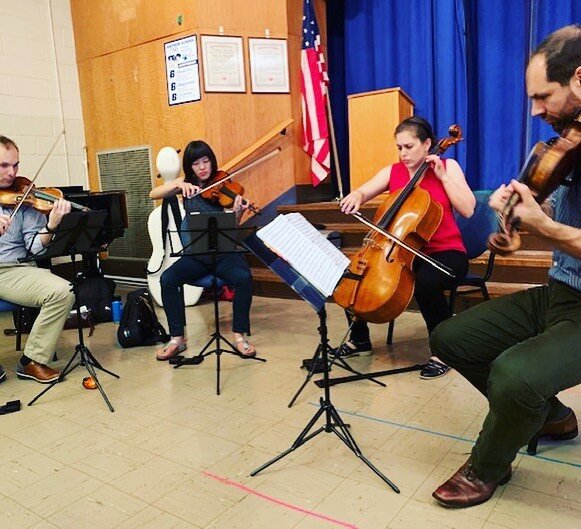

Opera Santa Barbara 2019-2020: read the reviews
Visit Opera Santa Barbara’s website
Visit conductor Kostis Protopapas’ website
Visit VOICE Magazine
++ Here is my review for Santa Barbara’s arts weekly VOICE Magazine of Opera Santa Barbara’s production of Puccini’s Madama Butterfly on November 3 2019:
As powerful as it gets: Madama Butterfly opens OSB season
It takes extraordinary intellectual and artistic insight to present a wildly popular opera, in this case Giacomo Puccini’s Madama Butterfly (1904) while also focusing with sober clarity on the shocking issues and tragic inevitabilities laid bare in the course of the opera’s appalling narrative. With forthright and simple storytelling and an electrifying command of the slow crescendo of horror that is the psychological and emotional core of the work, Opera Santa Barbara Artistic and General Director Kostis Protopapas gave audiences last weekend at Santa Barbara’s Granada Theatre a major achievement; one of the most beautifully designed and lit, simply yet dramatically staged, superbly acted and brilliantly sung productions of Puccini’s masterpiece in this viewer’s and likely most of the audience’s memory.
Relishing Puccini’s glorious music, Protopapas held forth in the pit conducting the OSB Orchestra, chorus and fabulous ensemble of principals with the expressive abandon born of cherished acquaintance with the score. The first-rate OSB Orchestra responded throughout Sunday’s matinee performance with gorgeous élan and soulful intensity; a crucial emotional bulwark for the action on stage. Shout out to the horn and percussion sections in particular, for brilliant coloration and subtle but bone-chilling epiphanic motifs and special effects throughout Puccini’s two and a half hour-long musical drama.
Madama Butterfly is a many-tiered and carefully constructed verismo polemic on child abuse, emotional and psychological abandonment, xenophobia and the consecration of American imperialism the whole world witnessed at the turn of the last century when Teddy Roosevelt’s Great White Fleet - referenced several times in the libretto - paraded its global reach by circumnavigating the planet from 1907 to 1911 including a stop in Santa Barbara. Sexism, the outrage of forced child marriage and entrapment, the financial dependency of women in a patriarchal system and the abuses that accrue; a perfect storm of inequality and abuse of women that continues to this day, is the vast subject on which the composer declaimed his outrage with some of the most exquisite and heartbreaking music in the operatic repertory. Puccini saw David Belasco’s one-act play Madame Butterfly: A Tragedy of Japan in London in 1900 and ran with the story, composing one of the most gorgeous as well as traumatic opera scores of the twentieth century. The composer’s Madama Butterfly together with his La Bohème and Tosca are among the ten most performed operas in the world and they all feature women as powerful if doomed protagonists. Protopapas, his production team and superb cast, made sure audiences would not only be swept up in this gorgeous production, but also enlightened by it.
The visuals for OSB’s Madama Butterfly were nothing short of stunning, with a lighting scheme by Azra King-Abadi that was refreshingly clean and colorful; harbor-blue tones in harmony with delicate floral pastels of expectation in Act I, shifting steadily to more ominous, swirling rusts and a blood moon of impending ritual seppuku by Act II’s denouement as Cio-Cio San’s naïve early teen fantasies of love, happiness and a better life are betrayed by her molester, Lieutenant Benjamin Franklin Pinkerton, who has no intention of taking her to America. Daniel B. Chapman’s projection design enhanced the visual experience magically. Making full use of the Granada Theatre’s state of the art system, Chapman gave the audience back screen “moving art” projections of Nagasaki Harbor, with discreet but fascinating animated actions to enhance the opera’s already intriguing stagecraft; a passing junk, changing seasons and finally, sepulchral storm clouds and other apocalyptic visual portents of Butterfly’s culturally inescapable suicide. Applause is due Technical Director Todd Jared for keeping it all together.
Stage Director Octavio Cardenas moved his characters about the three-tiered set and its superbly efficient pairs of giant scene-changing shoji screens with the mastery of a miniaturist. Butterfly as chamber opera was the result; intimate, emotionally charged scenes within scenes that pinpointed each trigger moment in the libretto’s ghastly trajectory. Kudo’s to Kentucky Opera for their loan of props and furniture, but particularly their jaw-dropping period costume authenticity circa 1904 including Kate Pinkerton’s magnificent day dress and Goro’s half Western, half Nipponese business suit. Cardenas handled the on-stage movement in the chorus scenes with quiet authority. Distracting supernumerary piffle minimized, unobstructed choral singing was the satisfying musical result.
Speaking of musical results, Protopapas gathered an ensemble cast of extraordinary vocal power, musicality and dramatic savvy for this Opera Santa Barbara production of Butterfly. Soprano Eleni Calenos (Cio-Cio San/Madama Butterfly) commanded attention immediately for her enormous and carefully nuanced vocal prowess. Gifted with a superb and open high register, her intelligently defiant interpretation of the ill-starred title role was a brilliant and calibrated progression from the character’s 15-year old emotional naivete to her final defeat as a mature mother some years later, forced to surrender her child to strangers. Tenor Harold Meers (U.S. Navy Lieutenant Benjamin Franklin Pinkerton) awed with his magnificently resonant voice and well considered dramatic realization of one of Puccini’s most complex and conflicted characters.
Baritone Luis Alejandro Orazco (Sharpless, United States consul at Nagasaki) displayed a voice of commanding richness and vibrant color and gave his character a touching glimmer of empathy. Tenor Benjamin Brecher (Goro, a matchmaker) sang the difficult part with vocal clarity and elevated the role from its too often superficial use as comedic relief to one of social and cultural conscience. In Brecher’s interpretation, Goro knows the ways of the world sadly and well. Mezzo-soprano Audrey Babcock (Suzuki, Butterfly’s maid); bass Colin Ramsey (The Bonze, Cio-Cio-San’s uncle); bass John Allen Nelson (The Imperial Commissioner) and mezzo-soprano Julia Metzler (Kate Pinkerton) gave solid performances vocally and dramatically.

Production photos by David Bazemore

Artistic and General Director Kostis Protopapas | photo by Zach Mendes

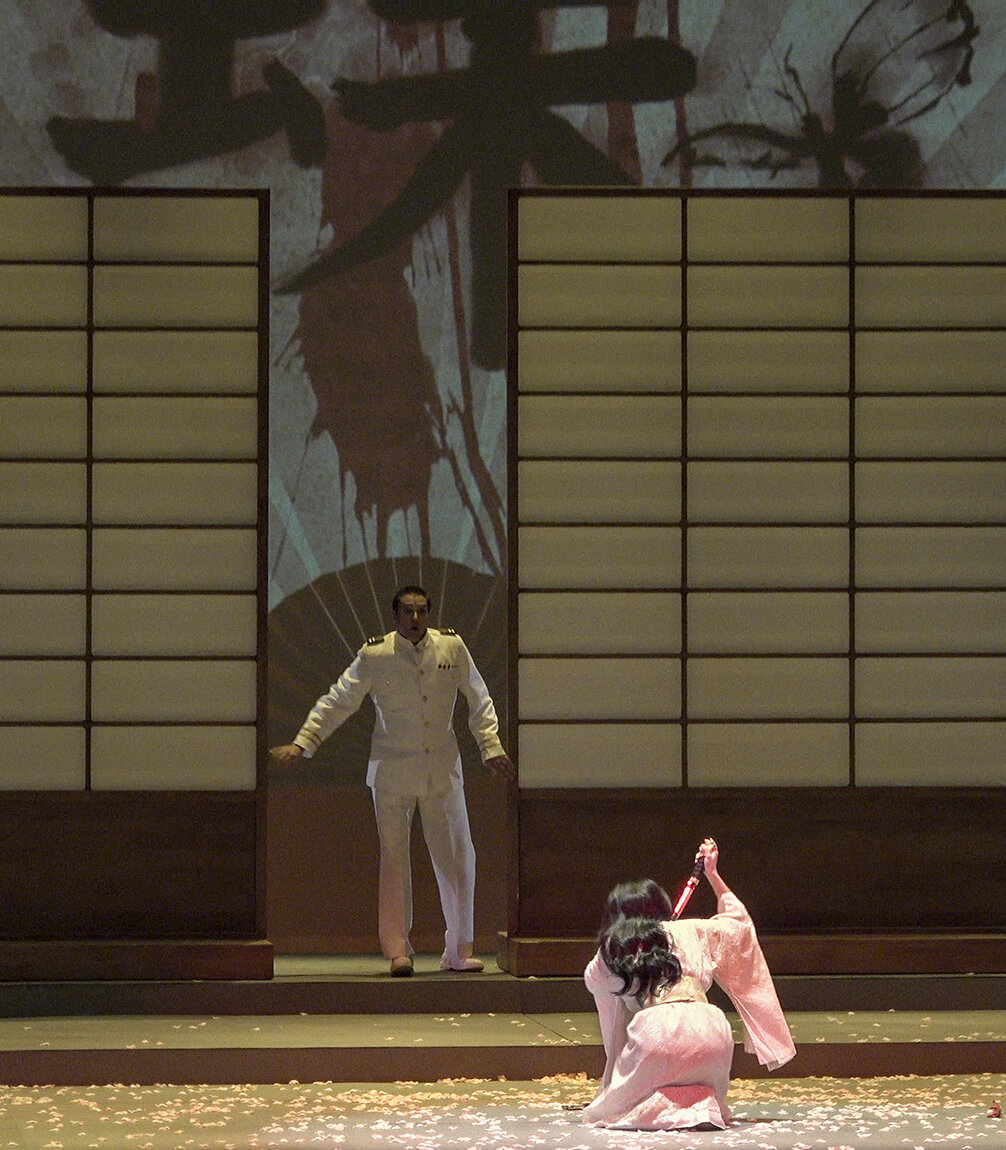
Pinkerton arrives at the moment of Butterfly’s suicide
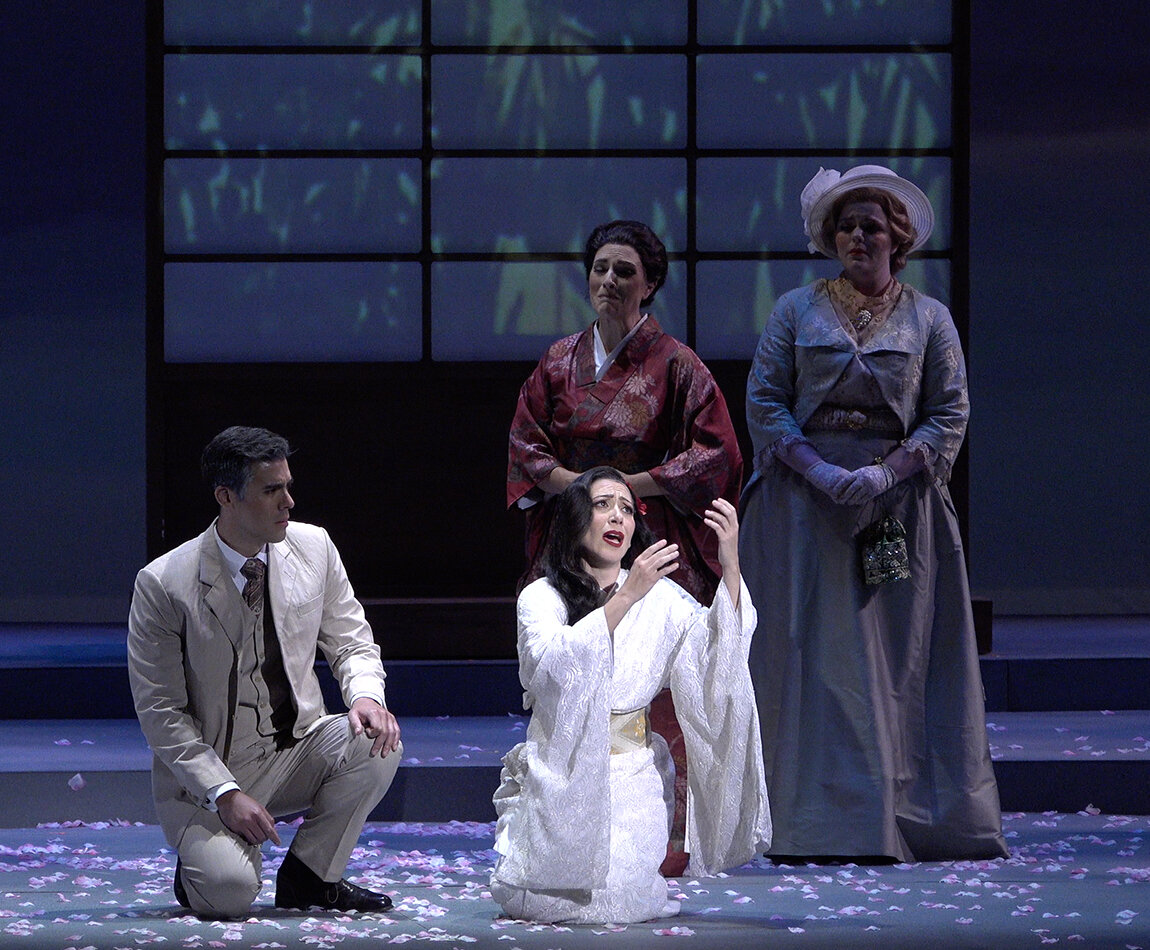
The American consul has come to take Butterfly’s child. Behind them, Suzuki and Kate Pinkerton
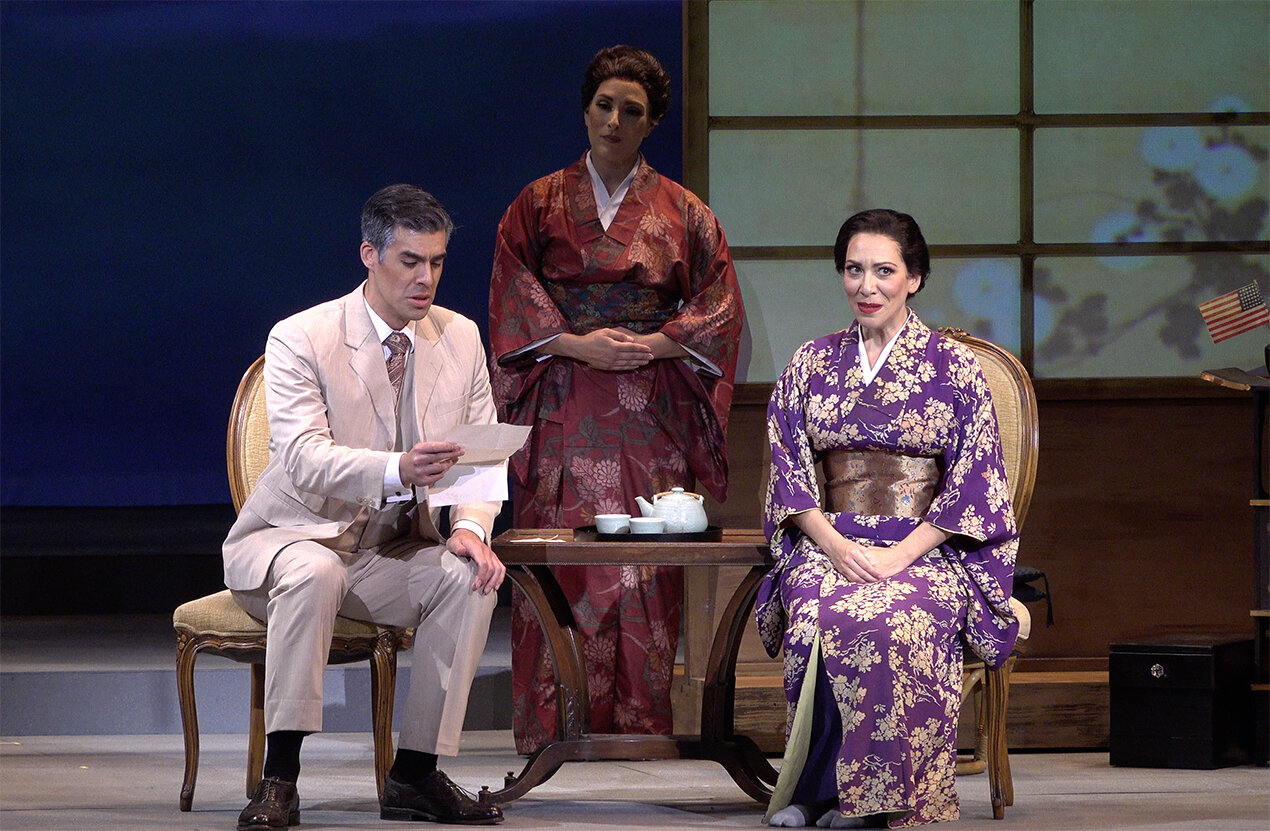
Sharpless, the American consul reads Pinkerton’s letter of farewell to Butterfly, her servant Suzuki standing behind them

Butterfly surrenders her blond-haired, blue-eyed son to the American consul
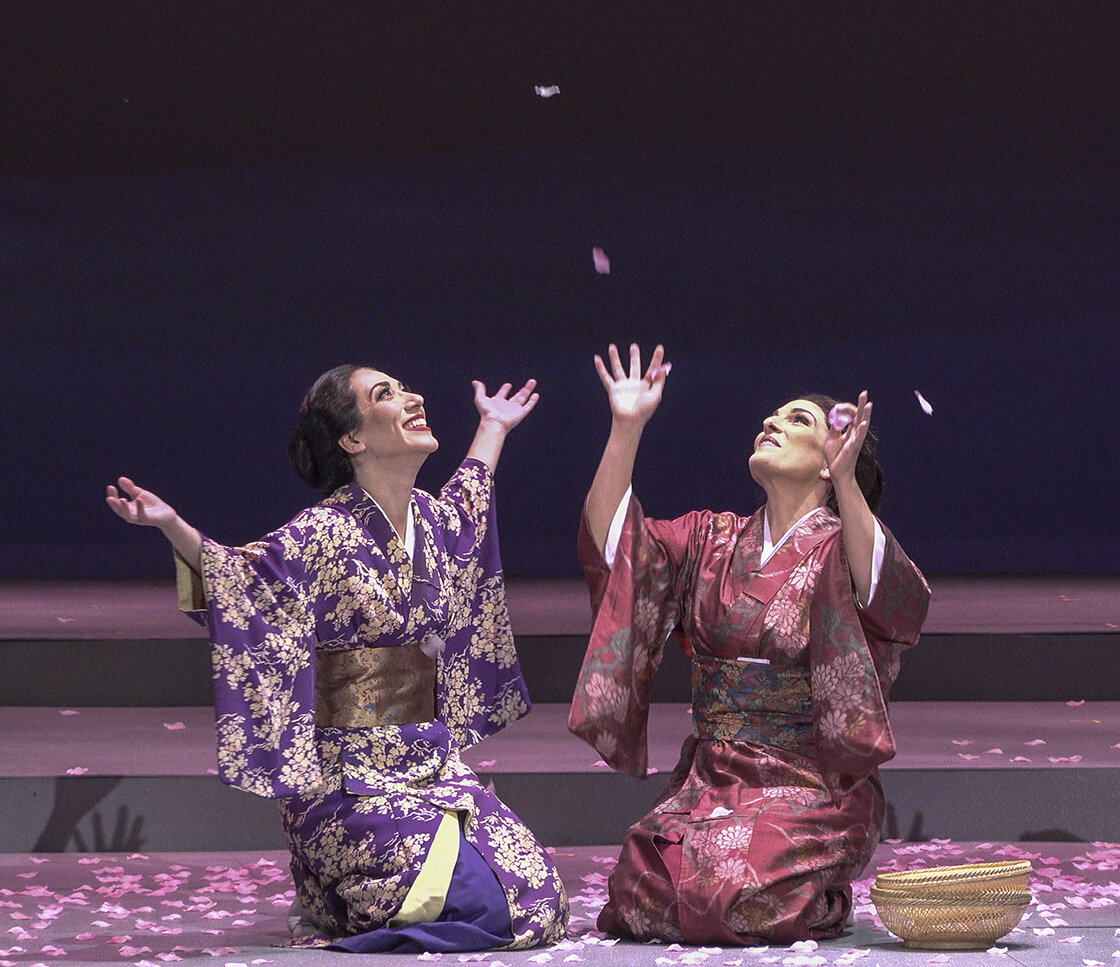
Butterfly and Suzuki preparing for Pinkerton’s return after three years
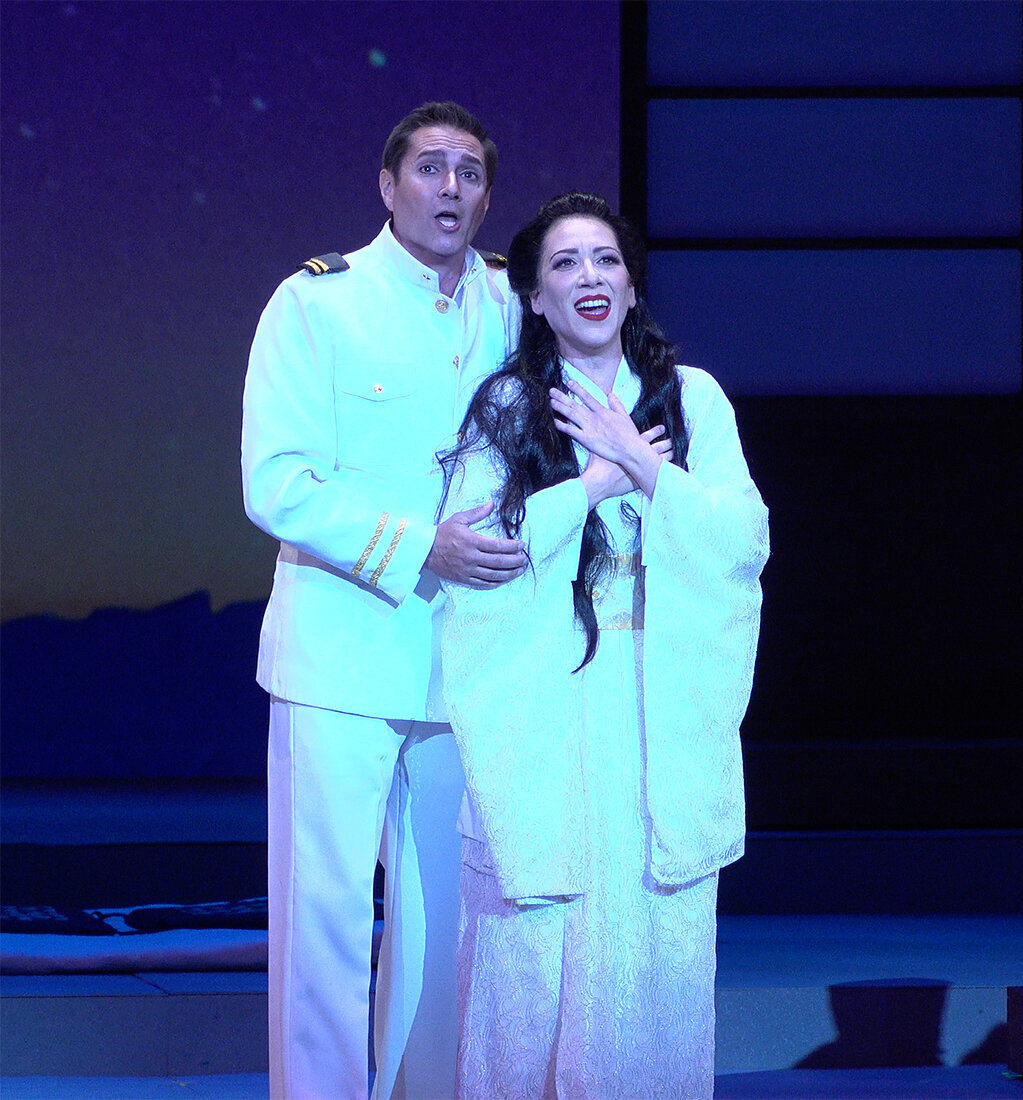
Pinkerton and Butterfly at their “marriage”
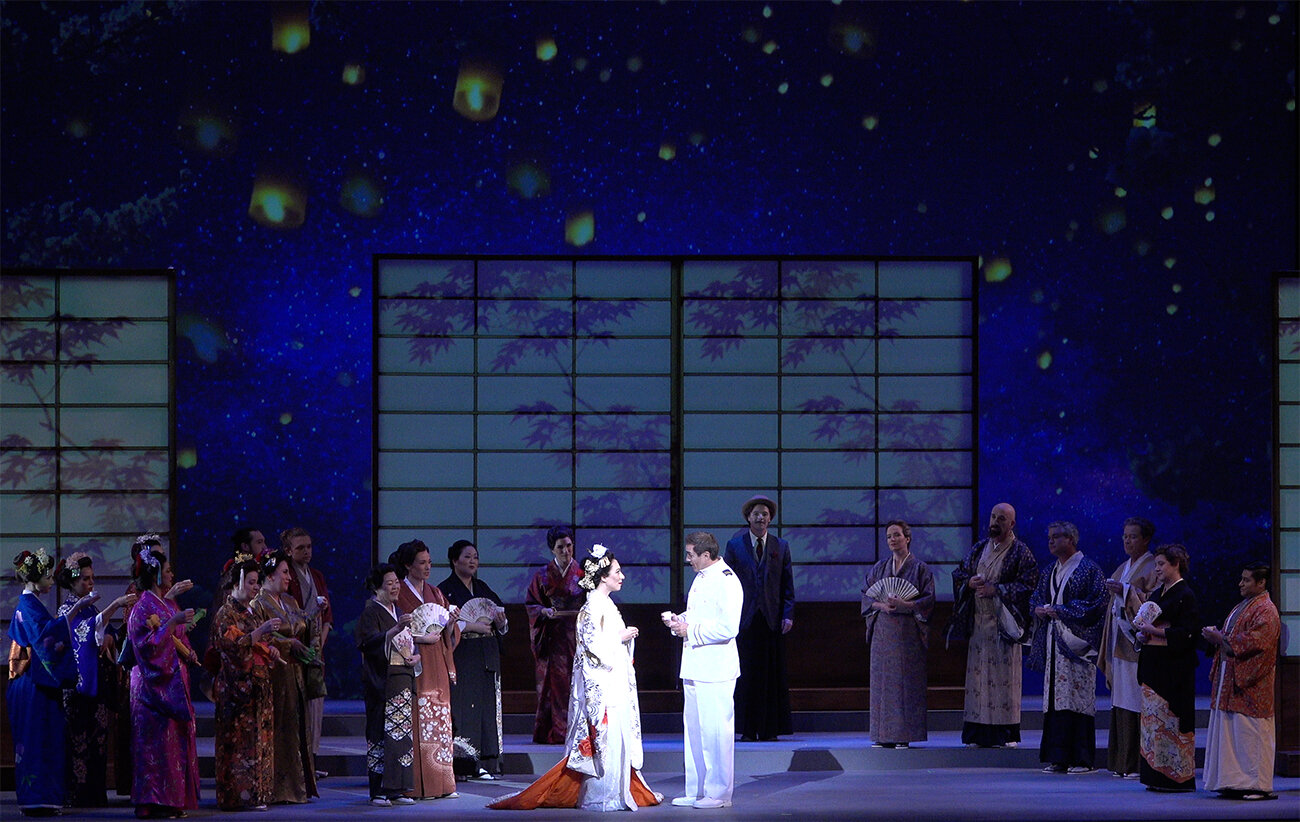
The wedding ceremony
State Street Ballet: American Masters — read my review
++READ MY REVIEW FOR SANTA BARBARA’S ARTS WEEKLY VOICE MAGAZINE OF THE OPENING OF STATE STREET BALLET’S 25TH SEASON AT THE GRANADA THEATRE IN SANTA BARBARA ON OCTOBER 12 2019, A COLLABORATIVE PERFORMANCE WITH THE SANTA BARBARA CHORAL SOCIETY
Celebrating 25 Years and the Choreography of William Soleau
Founding Executive Artistic Director Rodney Gustafson’s State Street Ballet launched its 2019-2020 Silver Anniversary season at Santa Barbara’s Granada Theatre last Saturday night celebrating not only the singular achievement of having successfully navigated a quarter century of financial and artistic growth as a professional dance company, but also SSB’s bond with its community and commitment to collaborative effort. Sharing the stage with the Santa Barbara Choral Society, which has enjoyed its own heady artistic history since 1948, SSB’s Co-Artistic Director/Choreographer William Soleau curated a program of his works - American Masters - that included two world premieres set to choral masterpieces by Leonard Bernstein (Chichester Psalms) and Morten Lauridsen (Lux Aeterna) and finished with his gorgeous original choreography from 2011 to Aaron Copland’s Appalachian Spring. Martha Graham’s eponymous pointe shoe footprint notwithstanding, Gustafson’s confidence in Soleau’s choreographic vision and moxie was plain to see; 25 years setting many of his most famous pieces to the unique dancers of State Street Ballet has been amply rewarding for both. The Choral Society’s Conductor and Artistic Director JoAnne Wasserman, enjoying her own anniversary – 27 seasons at the helm of the choir - officiated on the podium.
Spanish choreographer Nacho Duato, Artistic Director of the Berlin State Ballet since 2014 said some years ago during an interview that dance could not exist without music. A concept far deeper than it sounds, some choreographers miss the aural/kinetic connection altogether, most create movement that matches the music in rhythm, accent, accelerando and diminuendo, but they often ignore music’s deeper, sub-textual messaging. William Soleau’s choreographic portfolio is consistently beautiful to the eye and accessible to the intellect, his movement design simple in form and structure on many levels. Yet he also achieves what other choreographers often overlook; powerful emotional connection and authority through his deep study and understanding of the scores he sets to dance, particularly the music of composers whose sub-textual signals, tonal and harmonic progressions, dissonances and consonances beg for visual representation.
The program opened with world premiere choreography by Soleau set to Leonard Bernstein’s Chichester Psalms for Boy Treble or Countertenor, Choir and Orchestra (1965). With the Choral Society and orchestra upstage to allow room for the dancers to perform downstage the first movement Make a joyful noise unto the Lord, flowed like the text itself. The second movement, The Lord is my shepherd, with its serenely beautiful use of countertenor – sublime singing by Jacob Hall – featured dancers Saori Yamashita and Francois Llorente in a powerfully moving and mellifluous pas de deux. The third movement, My Heart is not haughty, Nor mine eyes lofty, together with the stunning Finale, Behold how good, And how pleasant it is, allowed the trio of Deise Mendonça with Jack Stewart and Noam Tsivkin and company members Anna Carnes, Amara Galloway, Marika Kobayashi, Emma Matthews, Tanner Blee, James Folsom and Nicholas Topete opportunity to emulate the beauty and meaning of Bernstein’s ravishing score.
A brief video interview with composer Morten Lauridsen prepared the audience for his otherworldly masterpiece Lux Aeterna (1997), its five sections of the Communion antiphon for the Roman Catholic Requiem Mass conceived as a quiet meditation on mortality and the death of the composer’s mother. Soleau wisely intuited that some sections of Lauridsen’s deeply moving score required complete, stand-alone attention from audience and dancers alike and from time to time had the company - Amara Galloway, Courtney Hanaway, Chloe Kelley, Deise Mendonça, Tanner Blee, James Folsom, Francois Llorente and Noam Tsivkin - sit facing the Choral Society and orchestra, listening along with the audience to the touching and lovingly prepared singing of this, the most widely performed twentieth century choral masterpiece on the planet. Soleau’s choreographic design for Lux Aeterna featured State Street Ballet’s remarkable unison ensemble pairings; duos, trios, couples and the full company. A starry night projection and the choreographer’s visceral understanding of the score and text made for visually arresting body imagery-to-sound cognizance, particularly in the last moments of the work – stunning!
After intermission, a short silent video collage of snippets from State Street Ballet’s 25 seasons was shown, accompanied by live improvisations performed from one of the Granada’s boxes by SSB’s house guitarist Chris Fossek, a lovely preamble to the major work of the evening, William Soleau’s enchanting and deeply moving 1997 choreography to Aaron Copland’s Appalachian Spring. Simply but elegantly staged, the narrative of two nineteenth century American Shaker families joining together as one through marriage was both an homage to Martha Graham’s iconic original visual stylings and a completely fresh work of choreographic art by Soleau. The Choral Society orchestra now in the Granada Theatre’s pit and playing handsomely as it did throughout the evening, allowed for a sprawling panoramic tale on stage of barn dances, weddings, picnics, pairings and partings; State Street Ballet’s corps and soloists enjoying this repertory favorite they’ve performed frequently over the years with technical zest and charming individual personality.
Daniel Kepl | Performing Arts Review
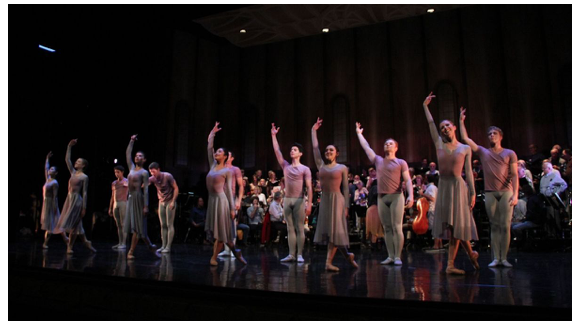
All photos by David Bazemore
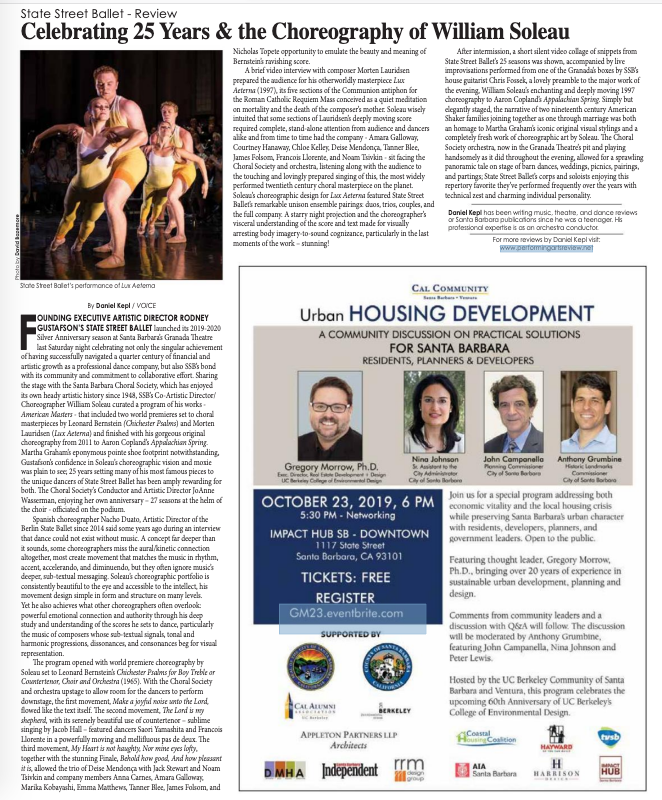
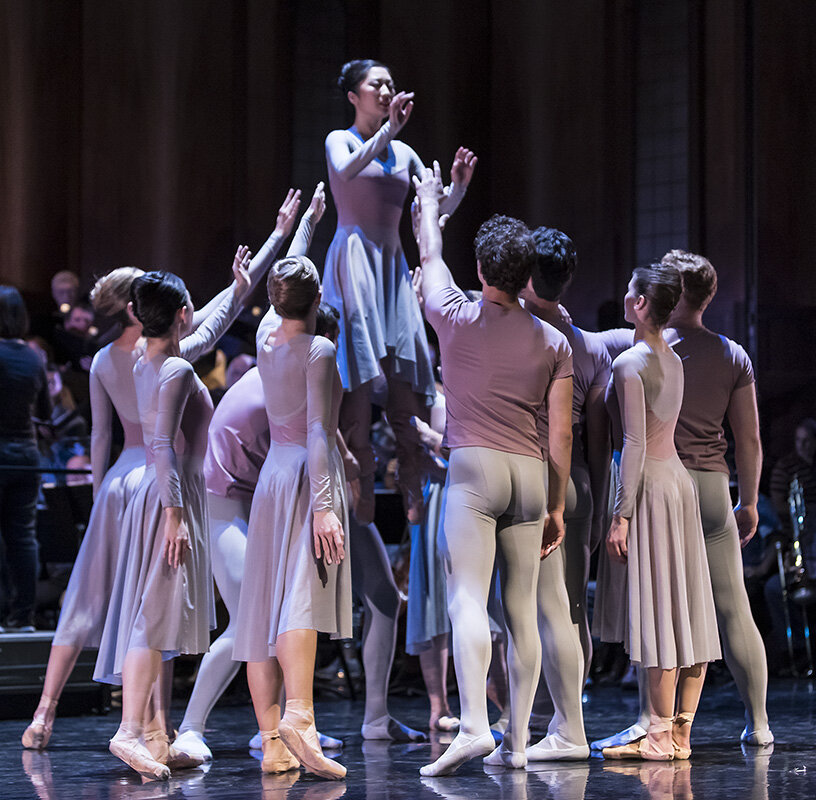
Bernstein - Chichester Psalms

Bernstein - Chichester Psalms

Bernstein - Chichester Psalms
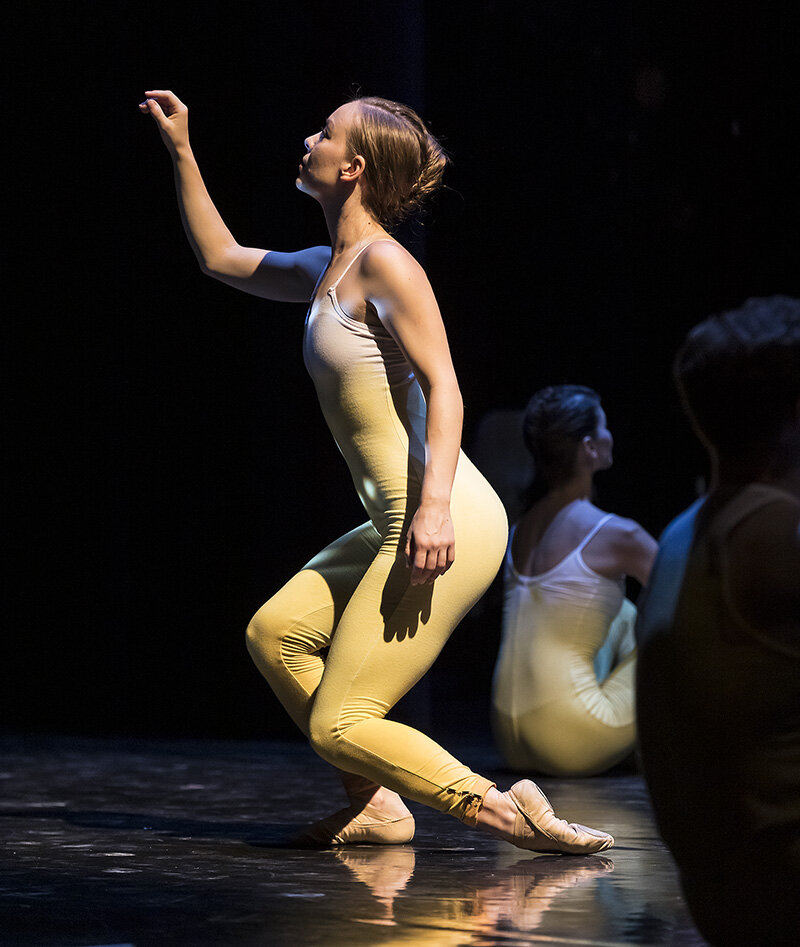
Lauridsen - Lux Aeterna
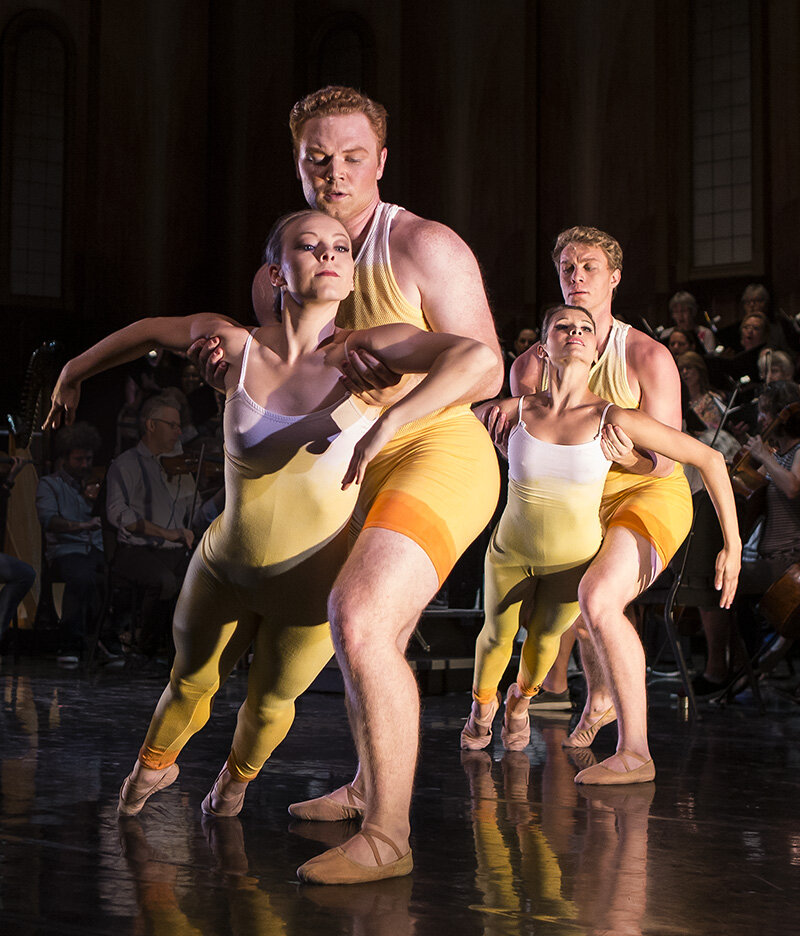
Lauridsen - Chichester Psalms
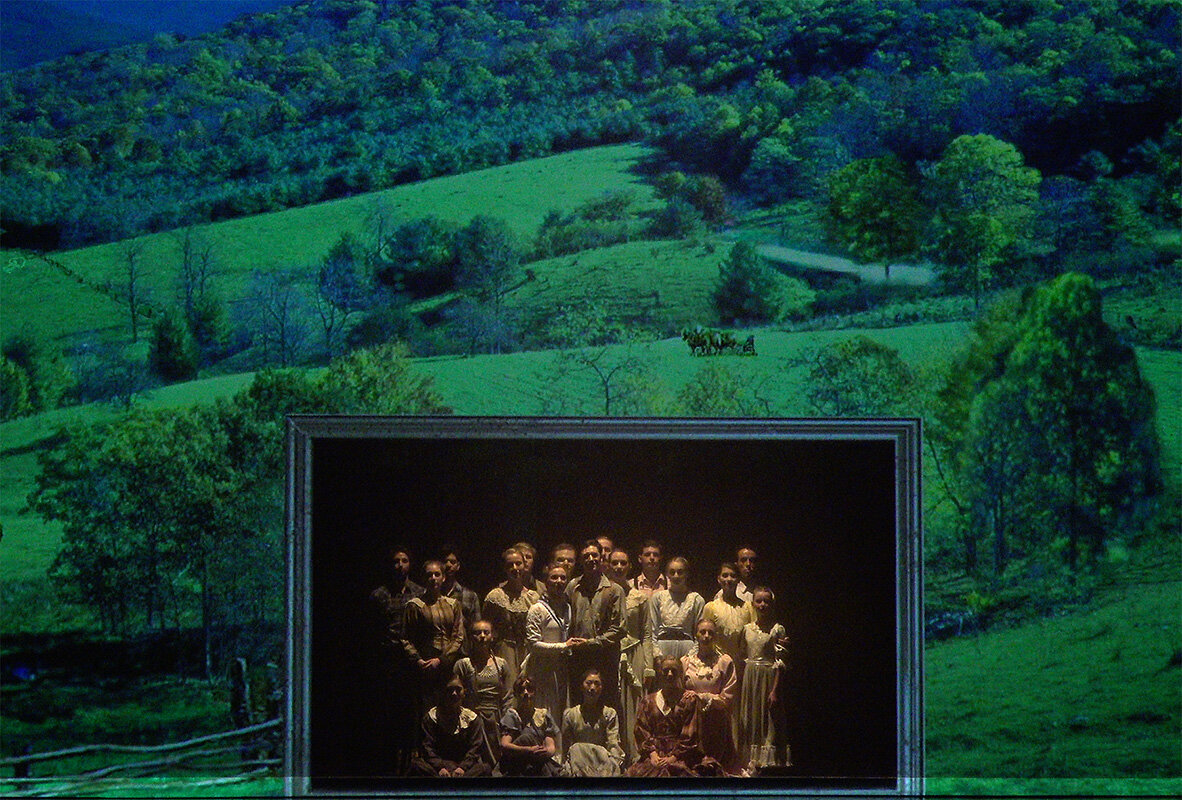
Copland - Appalachian Spring
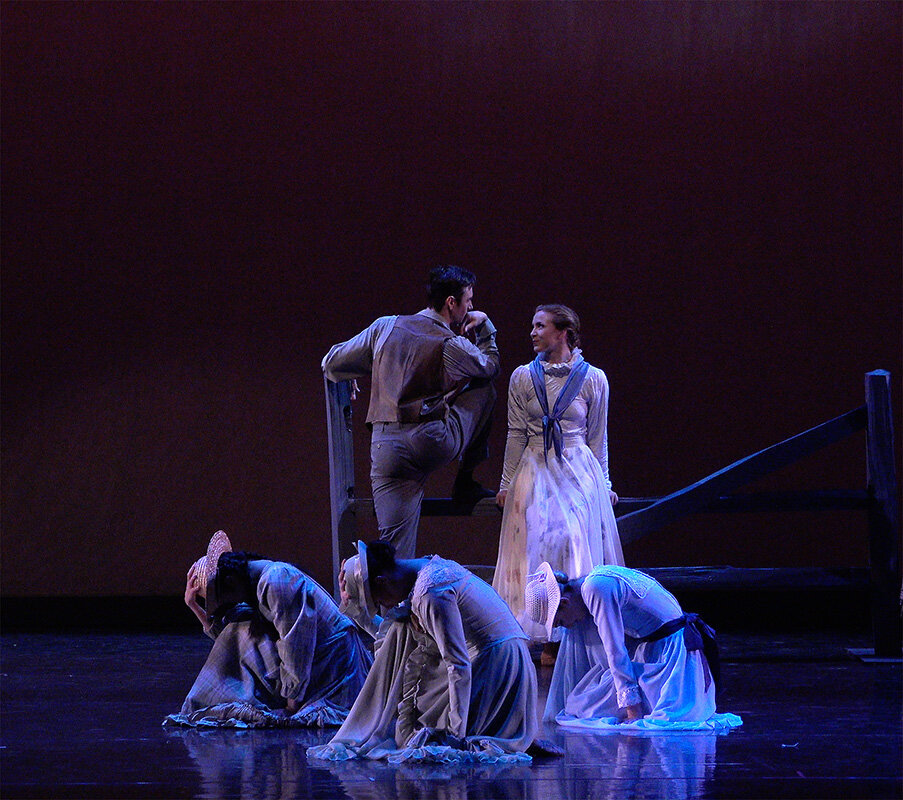
Copland - Appalachian Spring
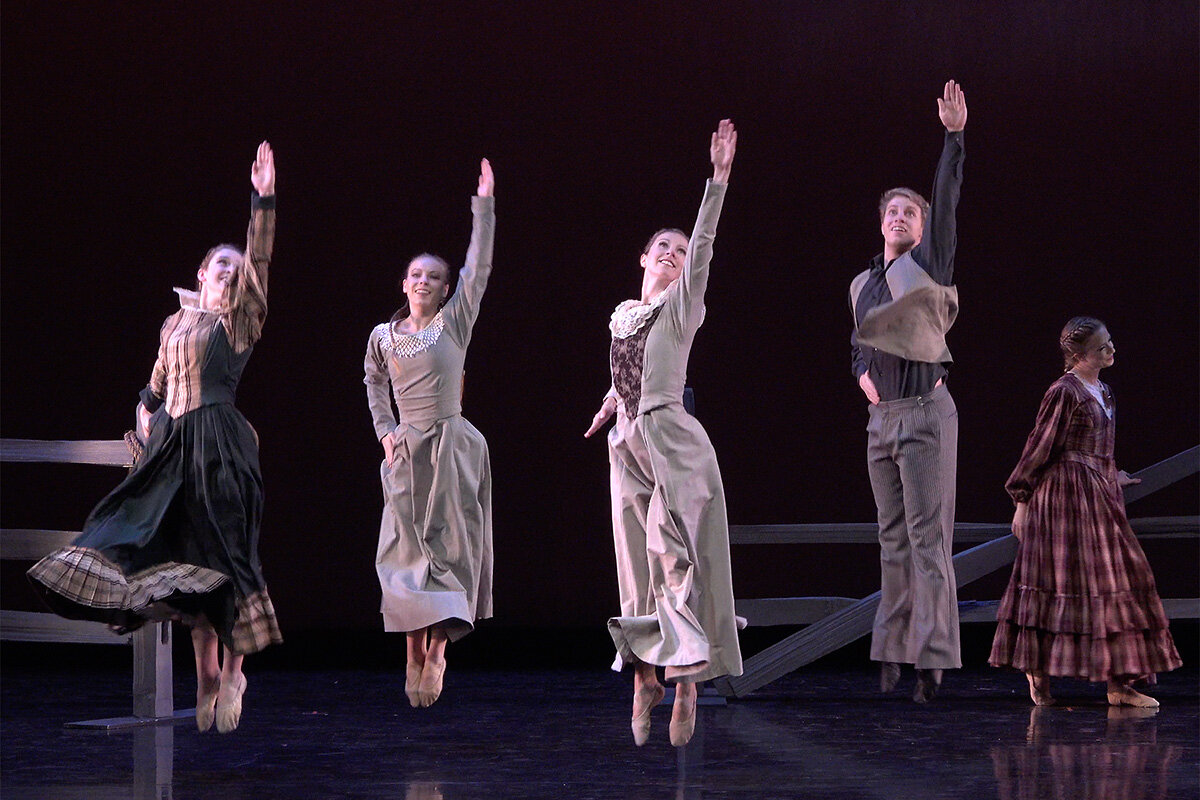
Copland - Appalachian Spring
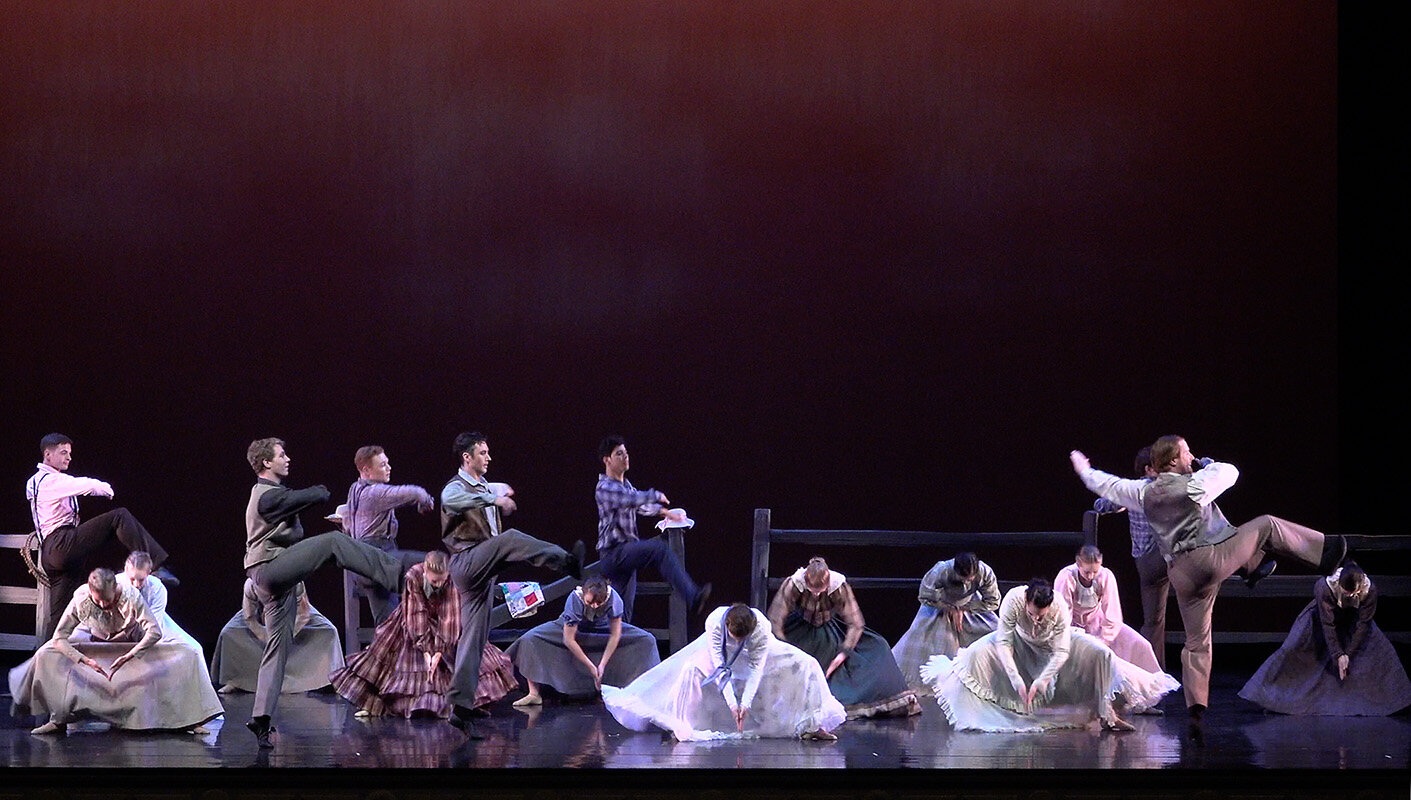
Copland - Appalachian Spring
Sankai Juku: Meguri: Teeming Sea, Tranquil Land — read my review
++READ MY REVIEW FOR SANTA BARBARA’S ARTS WEEKLY VOICE MAGAZINE OF THE JAPANESE BUTOH DANCE THEATER TROUPE SANKAI JUKU AT THE GRANADA THEATRE IN SANTA BARBARA ON OCTOBER 4 2019
Sankai Juku – Androgyny and Primal Expression
Mouths blackened and frequently agape in the manner of Edvard Munch’s Scream, their white floor-length waist wraps exposing with macabre sensuality a bit of leg and slashes of interior fabric color matching each scene’s simplistic but powerful lighting design changes, choreographer/director Ushio Amagatsu’s world famous Tokyo-based Sankai Juku company of eight male dancers performed his seven-part Meguri: Teeming Sea, Tranquil Land (2015) as the 2019-20 season-opening event for UCSB Arts & Lectures at Santa Barbara’s Granada Theatre last Friday night. Mesmerizing both novice viewers and seasoned aficionados, a full house, many of them college students, remained silently focused for more than an hour (there was no intermission) as Amagatsu’s hauntingly beautiful work unfolded. The power of living art.
Sankai Juku has perfected the Japanese dance theater style known as butoh. A product visually and psychologically of the atomic bomb, twentieth century butoh surfaced in 1951. Men naked from the waist up and caked crudely in white powder perform organic, slow motion movement that at the same time twinkles discreetly with miniscule and intensely disciplined facial expression and finger/hand signals. Also known as ankoku butoh (the dance of utter darkness) there is something about the look and manner of this distinct style of performance theater that pushes primordial as well as post-apocalyptic buttons. White body and face powder for example, inspires surreal and androgynous fantasies of primitive hominid cave and mud existence, but also resurrects searing geisha memories of the blast-blistered victims of Nagasaki and Hiroshima.
Using a black box stage with but one strikingly simple and ultimately profound back wall set which at the beginning of Meguri: Teeming Sea, Tranquil Land looked like ordinary brick but in time and changing light revealed effigies of fossils and marine creatures from the Paleozoic, Amagatsu submerged the audience in a cluster of gently tinkling percussive and low string sounds for the mostly solo first sequence, The Call from the Distance. Heeding the meaning of Meguri, the musical score circulated like water or solar systems or universes through the entire piece; an arresting soundscape collaboration between composers Takashi Kako, YAS-KAZ and Yoichiro Yoshikawa.
The second sequence Transformation on the Sea Bottom began with a low, rumbling electronic score and four dancers on their backs in a circle, raised hand and leg movements in slow motion the focus of interest - sea anemone the successful illusion. The sea-bottom currents becoming agitated, the four rose to dervish - the back wall becoming more textured and organic. The third section, Two Surfaces began with three dancers entering in silence, the lighting ambiance one of blue water imagery in sound and movement; a constant flowing force. The form and structure of this section was particularly disciplined, the dancers engaging in some of the most complicated exchanges of the evening. The soundscape for the fourth movement, Premonition – Quietude – Tremblings presented the musical illusion of wind and storm over a rumbling sea floor and featured beautiful ensemble unison movement from company members, particularly in the Tremblings segment.
Sounds of the mechanical world framed Forest of Fossils, the fifth section of Meguri. A thin layer of soil on stage was part of the performance design for the work as a whole and the fascinating effect of loose dirt and dust kicked up by the dancers during Forest of Fossils gave the section a Rite of Spring atavism and cadence; ceremony and narrative couched in primordial sounds that could have been the low-pitched honks of a brontosaurus (thunder lizard). Weavings and Return, the last two sections of Teeming Sea, Tranquil Land were also the most vigorous and moving, the entire company of eight on stage in various combinations and sequences. The textured wall, now brightly lit, allowed closer examination of visual artist Roshi’s magnificent conceptualization of fossil sea lilies. But as the last section, Return recapped several choreographic leitmotifs from the preceding movements and the dancers performed their final dervish soliloquy, the lights dimming, the score drifting away, thoughts about our precious and fragile ecosystem remained worrying.
Daniel Kepl | Performing Arts Review
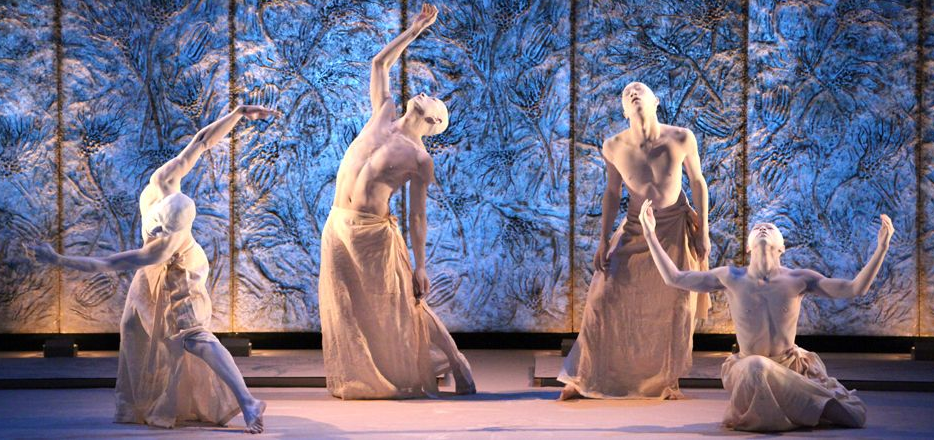
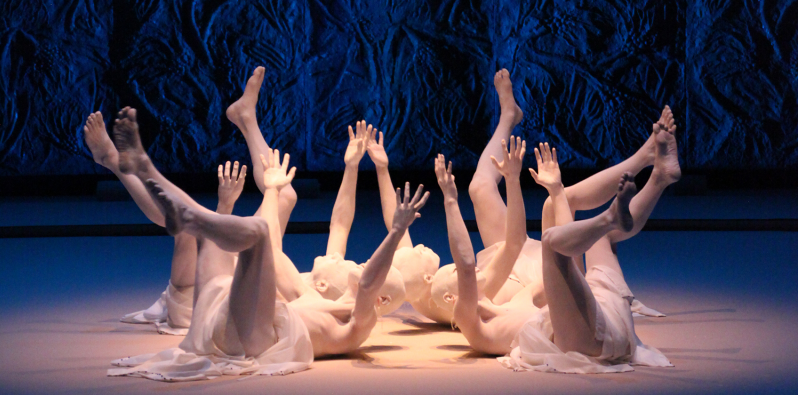
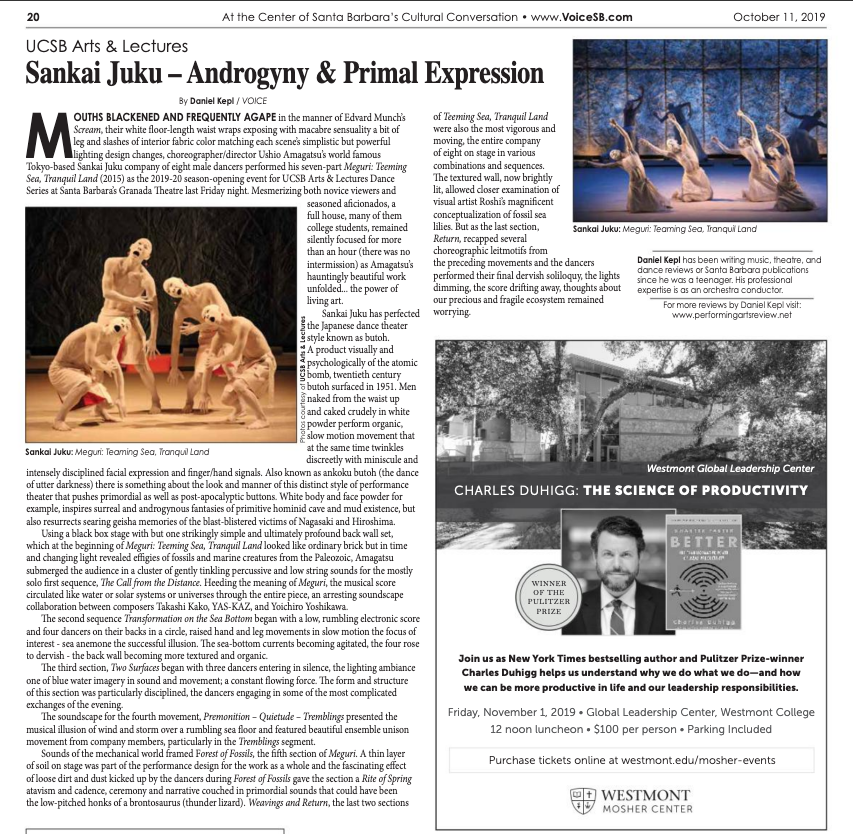

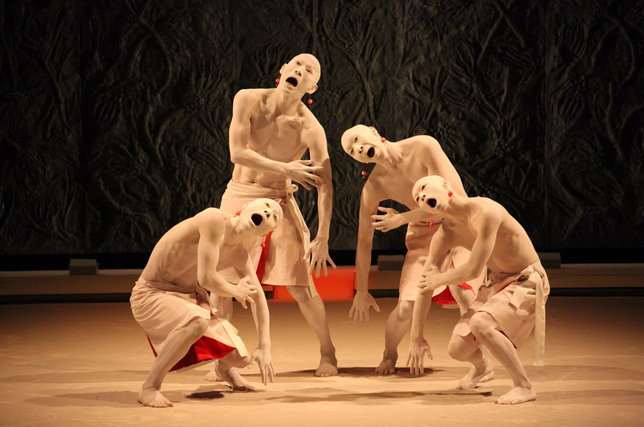

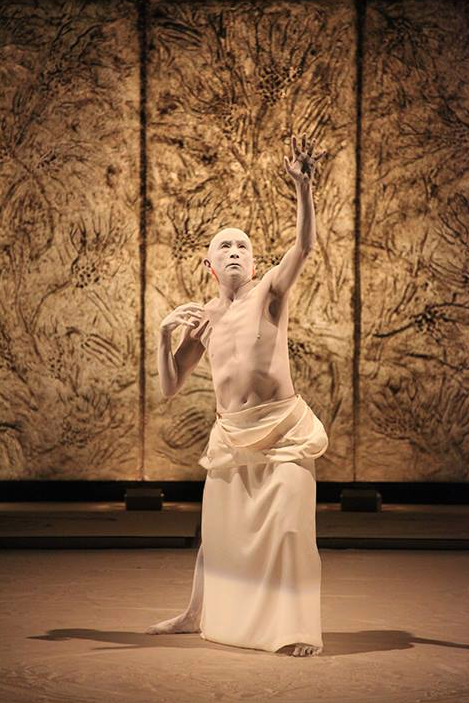

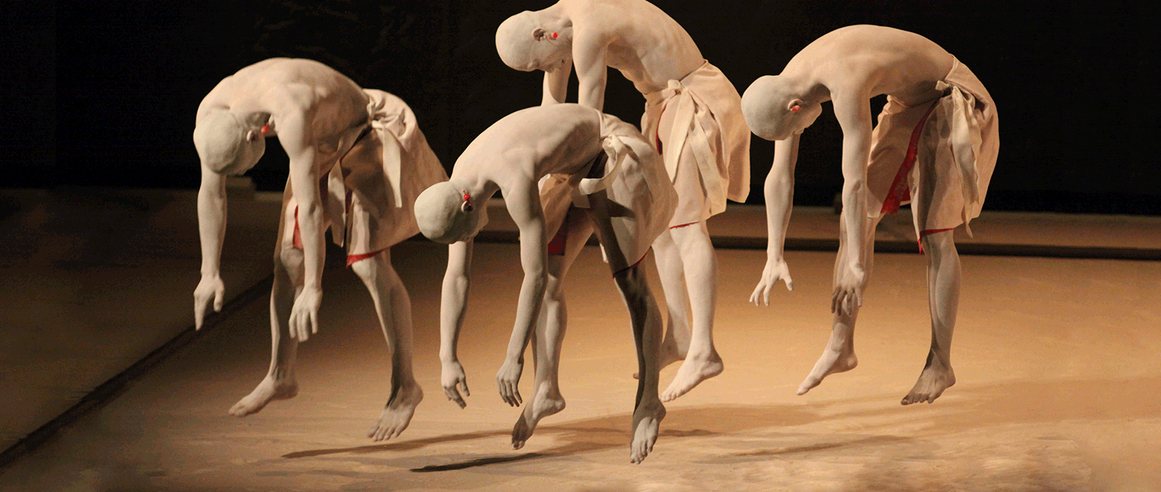

DANCEworks/Doug Varone & Dancers: read my review of the world premiere of "Somewhere"
Visit Santa Barbara DANCEworks
Visit Doug Varone and Dancers
Visit VOICE Magazine
++ READ MY REVIEW FOR SANTA BARBARA’S ARTS WEEKLY VOICE MAGAZINE OF THE WORLD PREMIERE OF DOUG VARONE’S “SOMEWHERE” AND THE FINAL CURTAIN AFTER 22 SEASONS OF SANTA BARBARA’S DANCEWORKS ON SEPTEMBER 6 & 7 2019:
DANCEworks: 22 Years Presenting Class Acts Comes Full Circle
Once in a Blue Moon the history arc of a performing arts organization begins and ends in triumph. Last weekend in Santa Barbara’s Lobero Theatre, brilliant performances by New York City-based Doug Varone and Dancers featuring the world premiere of his new masterpiece Somewhere, also celebrated the last curtain call for founder and executive director Dianne Vapnek’s visionary SUMMERDANCE/DANCEworks series; 22 years hosting annual residencies in Santa Barbara by a Who’s-Who of world famous dance companies including Doug Varone’s ensemble, which launched Vapnek’s dream in 1997.
A choreographer’s heaven, DANCEworks residencies in Santa Barbara have been unique as a result of an active partnership with the Lobero Theatre Foundation since 2006. Providing the Lobero’s stage as a rehearsal/creation platform during each annual month-long DANCEworks residency has been no small gift. The list of major new works created in this supportive creative environment over the past 22 years is significant, the choreographers who have embraced DANCEworks residencies remarkable: Doug Elkins, Larry Keigwin, Aszure Barton, Mark Dendy, Kate Weare, Shannon Gillen, Adam Barruch, Brian Brooks and others.
Saturday night’s full house was chock-o-block with local dance-savvy pros and happy enthusiasts, together with a gaggle or two of out-of-town dance aficionados. Santa Barbara’s dance community is large and vibrant, everyone knew this farewell event would be epic; the energy in the room was cheerful and electric. As house lights dimmed, chatter subsided – quiet anticipation reigned for a moment or two until Dianne Vapnek emerged from between the stage curtains. Looking for all the world like a petite Swiss mädchen, Vapnek absorbed the instantaneous tsunami of adulation from a now standing, shouting and foot stomping audience with a certain mischievous sanguinity. Delivering a brief history of the whys and wherefores she exited, to another heartfelt outburst of hurrahs; a wonderful beginning to an evening of stunning virtuosity.
Settling in, the audience audited an evening-long journey of virtuosic movement innovation and visual subtext that is the world of choreographer Doug Varone. Marking his fifth and most important residency for Vapnek and DANCEworks, Doug Varone and Dancers presented a program that engaged audience attention in ways that will take years to unravel. Clearly, Varone speaks to the brain; it’s capacity to absorb enormous amounts of information at multiple levels of consciousness in nanoseconds. His choreography is diverse but specific and detailed, sometimes whirling by in great flurries of gesture and glyph, at other moments finding nuance through a kind of anti-movement; suggestion and implication driving visions in the mind, if not the body.
The precious fruit of this last DANCEworks residency, Doug Varone’s fresh and profound new choreographic take on Leonard Bernstein’s iconic masterpiece West Side Story opened the program with the entire company – Courtney Barth, Hollis Bartlett, Bradley Beakes, Jake Bone, Whitney Dufrene, Dequan Lewis, Aya Wilson, Ryan Yamauchi - and represented a case study in the choreographer’s nothing-is-as-it-seems visual messaging. Altering and manipulating Bernstein’s score in subtle but fascinating manner; creating movement in stark contrast to now legendary, even stereotypical perceptions of scenes like the high school prom, rumble and dream sequences Varone’s new piece Somewhere was created during the company’s residency here these past several weeks and forced the audience to experience anew and in far more complex visual manner, Bernstein’s abiding subtext about the human spirit and its discordant antithesis, conformity. The house roared its approval.
The Lobero stage was a simple black box throughout the evening, its stark simplicity and bald lighting instantly transported the audience to back alleys and freeway underpasses for Somewhere but also allowed for total concentration on Varone’s detailed and fast-paced movement design. Two Piano Pieces: Nocturne (2017) and Short Story (2001) to music of Chopin and Rachmaninoff followed intermission. Both are chamber dance masterpieces, but of the two the most intensely moving was Doug Varone’s incredibly intimate solo meditation on aging and memory to a nocturne of Chopin – an honor to witness this genius revealing his vulnerability with such honesty. Company principals Bradley Beakes and Aya Wilson performed Varone’s shockingly tense, terrifyingly contained choreography for Short Story to one of Rachmaninoff’s most plaintive preludes with subtle body articulation and carefully nuanced emotional intensity. Conflict, compromise, conciliation, commitment – not necessarily in that order – the cardinal signs of partnering are examined through an abstract, subliminal prism; magnificent performances by both artists.
Lux (2006) to Philip Glass’ first large orchestral score The Light, capped the evening with cascades of thrilling and virtuoso movement from the entire company. Displaying ensemble cohesion as well as duo, trio, solo moxie, the company thrilled with Lux as it had at the beginning of this beautiful program with Varone’s new piece, Somewhere. One last treat: as the wild ovations and hollering subsided, Doug Varone and Dancers receiving multiple call backs with a last farewell from Vapnek, the audience began to call it a night when down came a massive screen and we were gifted a summation video of excerpts from DANCEworks’ many brilliant residencies and performances over the years. The message; one person can change the world. Thanks, Dianne Vapnek, for your vision, your energy, your commitment to dance and the gift you have given the Santa Barbara community for 22 amazing seasons. Brava!
Daniel Kepl | Performing Arts Review
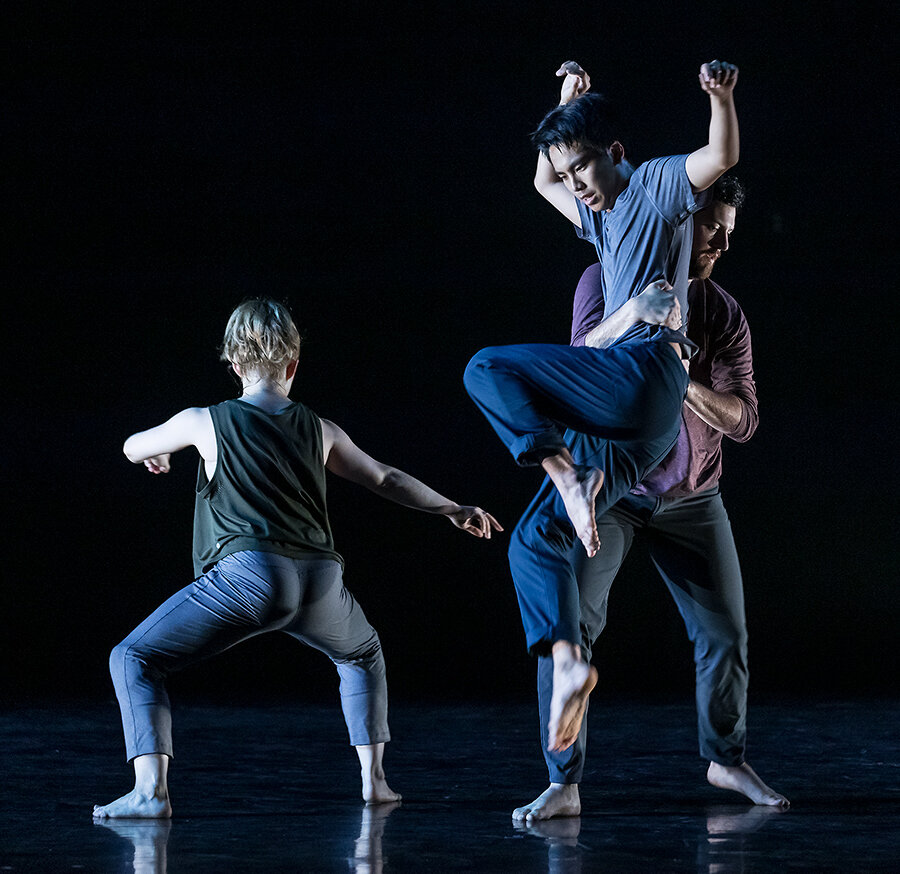
Photos by David Bazemore of the world premiere of Somewhere


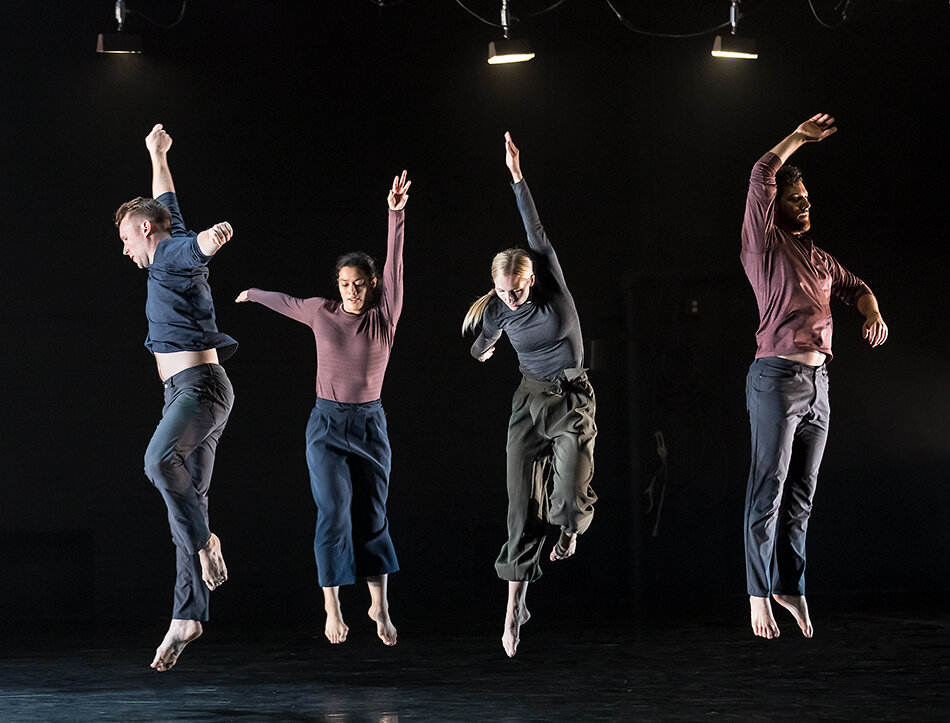
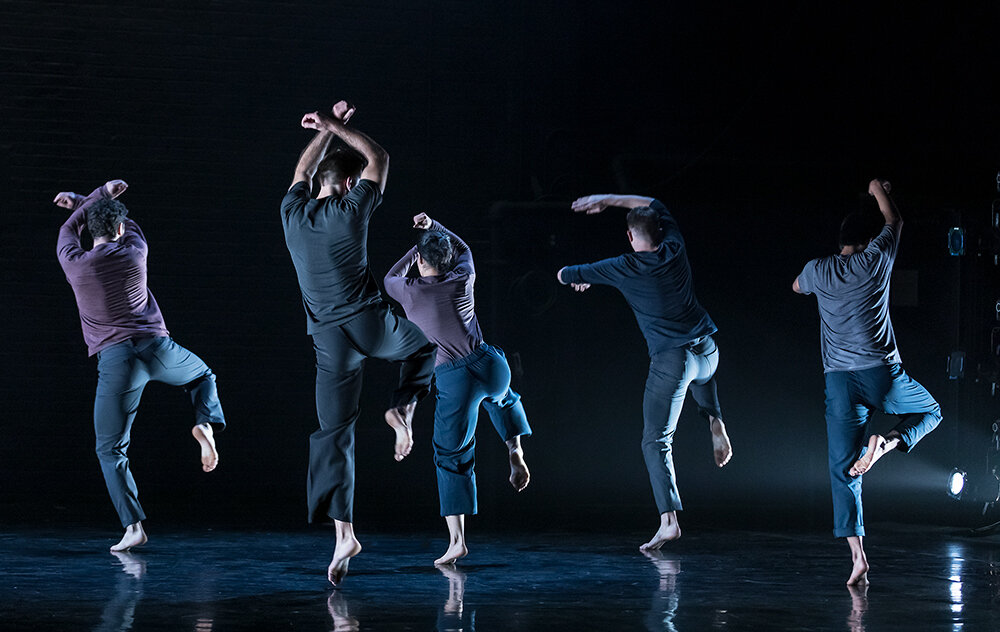


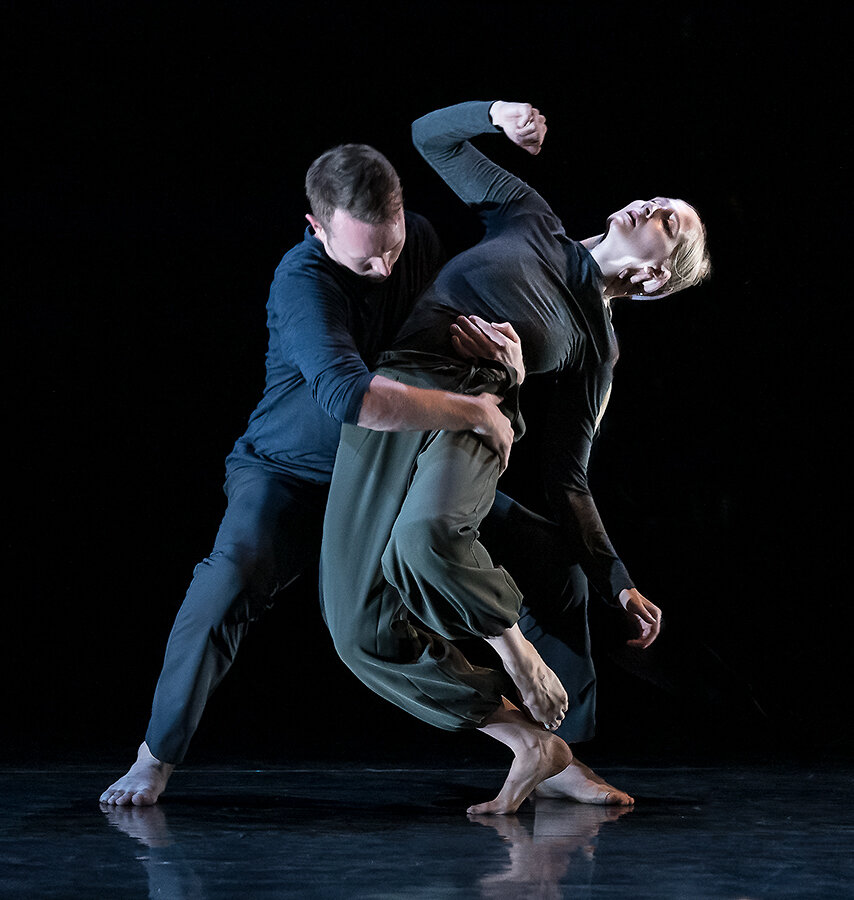

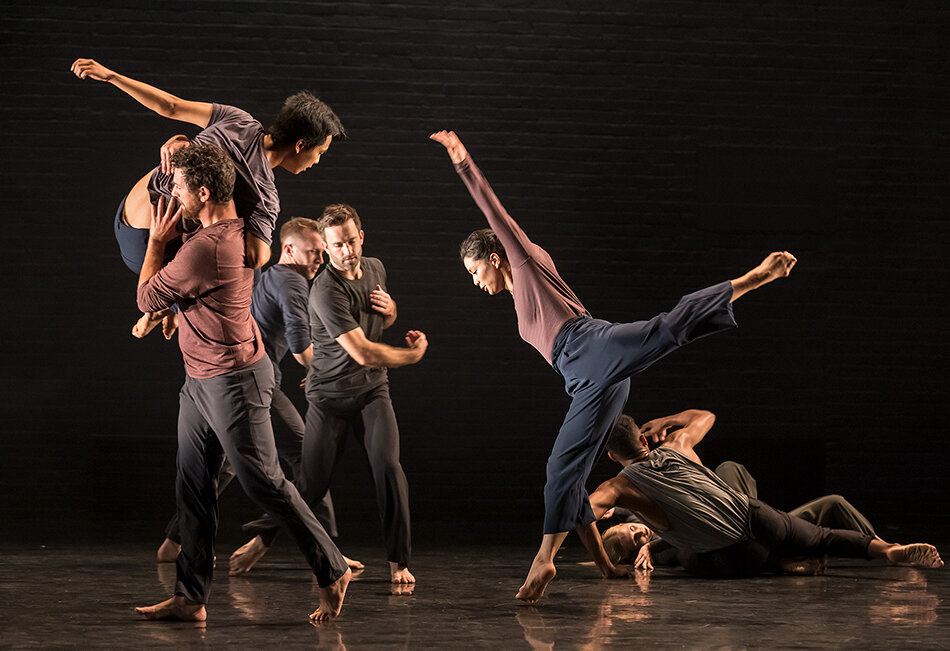
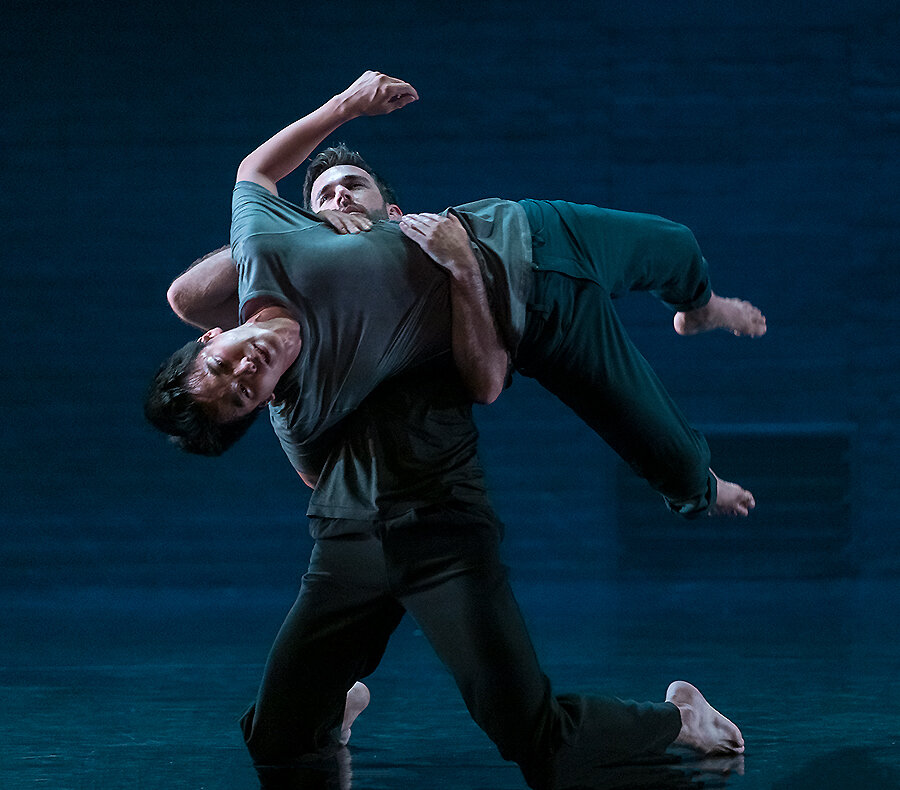
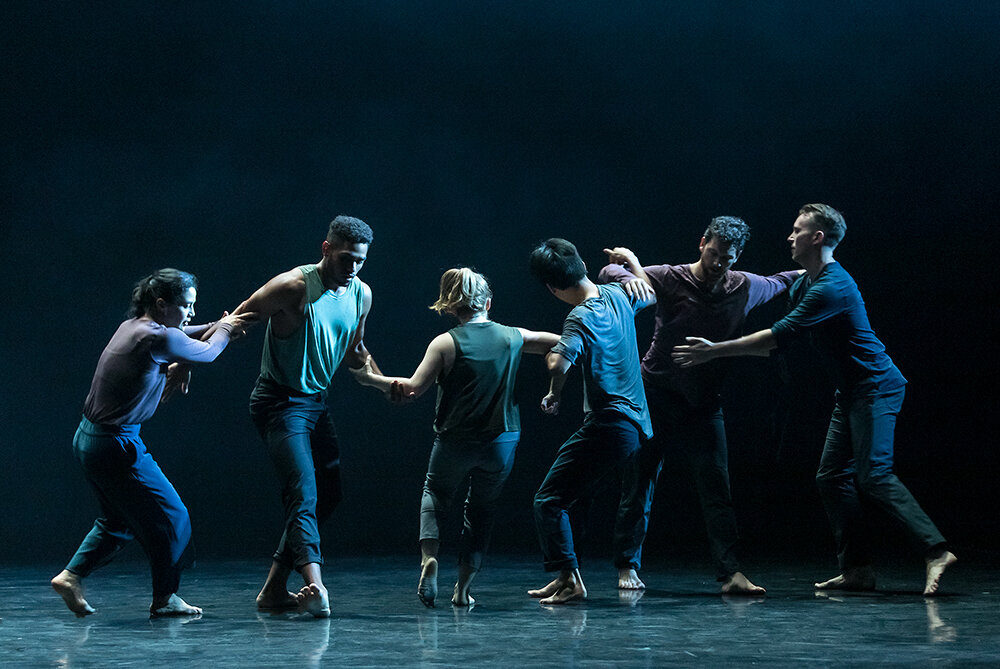
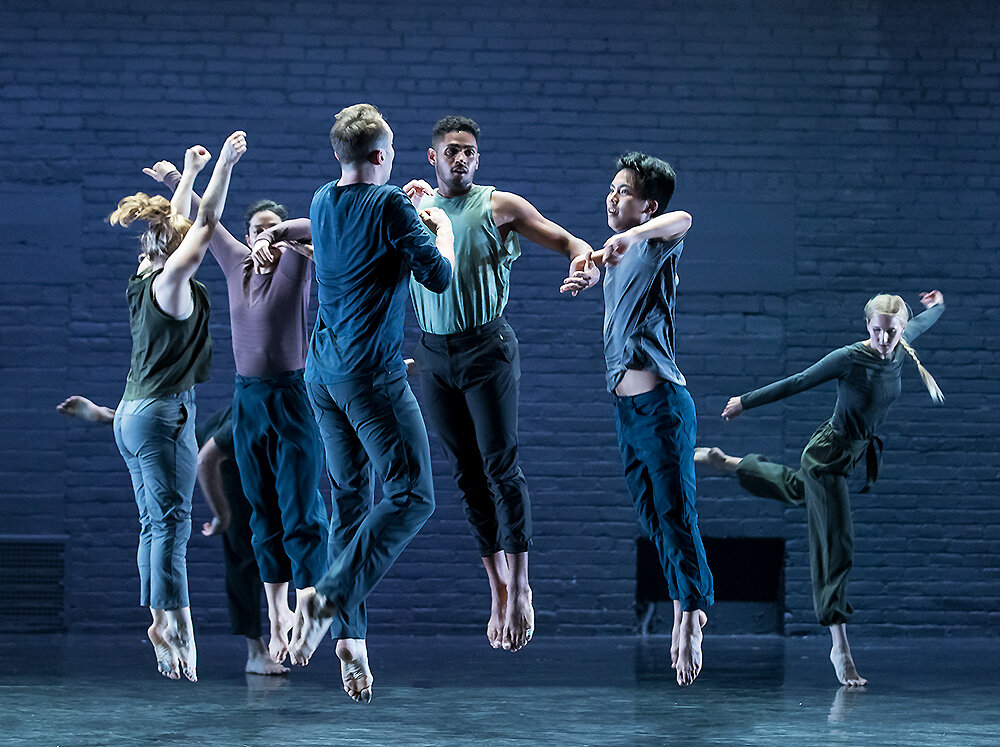
Music Academy of the West 2019 — read the reviews
SCROLL DOWN to read all my reviews for Voice Magazine of the 2019 Music Academy of the West summer season in Santa Barbara
Visit the Music Academy of the West
Visit conductor Marin Alsop’s website
Visit composer Jennifer Higdon’s website
Visit Cold Mountain director/designer James Darrah’s website
Visit composer Thomas Adès’ website
Visit conductor Daniel Harding’s website
Visit conductor Matthias Pintscher’s website
Visit conductor Larry Rachleff’s webpage
Visit VOICE Magazine
++ HERE IS MY REVIEW WRITTEN FOR SANTA BARBARA’S ARTS WEEKLY VOICE MAGAZINE OF THE MUSIC ACADEMY OF THE WEST’S LAST CONCERT OF THE 2019 SUMMER SEASON ON AUGUST 10 2019:
Marin Alsop Schmoozes with the Academy Festival Orchestra
Chatting persuasively with her hands, conductor Marin Alsop led the Music Academy Festival Orchestra in its final concert of the 2019 summer season at the Granada Theatre in Santa Barbara on August 10th and made clear music can change lives. The internationally acclaimed conductor of the Baltimore Symphony Orchestra among others took blissful liberties of expression and interpretation with the now seasoned ensemble. The result was an Epiphany of conductorial vision and orchestral competence. Eight weeks on a short rehearsal leash presenting five technically challenging and superbly executed orchestral programs, a west coast opera premiere of no little consequence and chamber music recitals beyond number has honed the orchestra into a musical force to be reckoned with; they were ready to soar and Alsop set them free. Like attending a spectacular air show, the audience experience was breathtaking.
Alsop’s musical choices for the evening seemed satisfying enough, but not particularly revelatory. It was her ecumenical authority, her command of imagination and execution that gave sparkle and yes, suavity to the program. Dvorák’s Symphony No. 7 in D Minor, Op. 70 received a smooth-as-silk performance; Hindemith’s orchestral masterpiece Mathis de Maler was so tidily put together it’s three movements seemed positively Mozartean and Jennifer Higdon’s drop dead gorgeous blue cathedral was given a memorable and radiant performance. By concert’s end the audience takeaway could not have been other than awe. In just eight weeks the orchestra had achieved a level of virtuosity that spoke literally volumes about teamwork and comradery. Bringing it all together, Alsop’s charismatic leadership.
Jennifer Higdon has been American composer in residence at the Music Academy of the West this summer. Programming an overview of her chamber and orchestral music as well as mounting a world-class production of Higdon’s 2015 opera Cold Mountain has been both a tribute to America’s premiere melodist and a formidable challenge for the Music Academy’s young professional fellows. Higdon’s blue cathedral (1999-2000) opened the Festival Orchestra concert last Saturday and its 13 minutes were a memorable technicolor “journey of the soul,” as Higdon remarks in her program notes about the death of her brother, the inspiration for the piece. blue cathedral is bound to become a standard of the orchestral repertoire for its marvelous musical structure and sound imagery, to say nothing of its disarming beauty from first note to last. Higdon’s personal narrative about the mysteries of death and the fragility of life is fertile soil for her uncanny and deeply moving choice of orchestral colors, her exciting use of tuned percussion, the work’s wonderful chamber music interludes, brass segments and string writing of great force and beauty. With the composer in the house, the orchestra gave Alsop her every nuanced need, even as the piece drifted away, a mystery unsolved. Wow!
Speaking of nuance, Alsop’s clear command of the entire musical environment, text and sub-text, brought the three descriptive movements of Paul Hindemith’s 1933 masterpiece Mathis der Maler to gorgeous, bittersweet and ultimately glorious flower. There were moments, particularly in the heartbreaking sighs of the second movement Grablegung (Entombment) when Alsop’s demands of the strings in particular were otherworldly, sometimes terrifyingly so. Following her entreaties to the letter, the effect was riveting. The Temptation of Saint Anthony, the symphony’s last movement was a thrilling virtuoso tour d’ensemble featuring magnificent playing from all sections of the orchestra stoked by a contagious energy from Alsop that nearly fractured the Granada’s roofbeams. Alsop’s superb conducting and the orchestra’s extraordinarily high level of musicianship generated a memorable sonic event.
After intermission Alsop and colleagues delivered a gentle tsunami of late romantic lush with a leisurely and pointedly idyllic performance of Antonín Dvorák’s Symphony No. 7 in D Minor, Op. 70 (1884-85). Enlightened balances between sections and internal voices; delicious solo moments permitted to enjoy emotional gamut; a string section of mesmerizing merit and unquestioned capability; intensely focused playing from the orchestra and a conductor with the stylistic savvy of a graduate cum laude of the Arthur Murray Dance Studios – what could go wrong? Nothing. The performance a beautiful arch of sound through all four movements, capped the summer season with genuine and beautiful music and confirmed the Music Academy of the West’s rank as one of the very best summer training programs for young professionals in the world.
Daniel Kepl | VOICE Magazine
++ HERE IS MY REVIEW WRITTEN FOR SANTA BARBARA’S ARTS WEEKLY VOICE MAGAZINE OF THE MUSIC ACADEMY OF THE WEST’S WEST COAST PREMIERE OF AMERICAN COMPOSER JENNIFER HIGDON’S OPERA COLD MOUNTAIN ON AUGUST 2 & 4 2019:
Jennifer Higdon’s Cold Mountain: An American Masterpiece
The Music Academy of the West presented the west coast premiere of American composer Jennifer Higdon’s opera Cold Mountain at Santa Barbara’s Granada Theatre last weekend (August 2 and 4). A proud feat in itself - Santa Fe Opera gave the world premiere in 2015 - the scope and breadth of Higdon’s re-imagining of Charles Frazier’s 1997 novel and the extraordinarily professional standard of the Music Academy fellows performing the work became instantly apparent, from the spellbinding opening orchestral flurry out of the pit that set the opera into a gyroscopic spin to its last, shocking and heartbreaking seconds. Profoundly addressing multiple dichotomies - justice and injustice, dissipation and epiphany, the power of love and finality of death - Higdon, with a sublimely original Dickinsonian libretto culled partially from Frazier’s novel by Gene Scheer, has created a powerful American masterpiece based on the most traumatic event in US history; a struggle that continues ideologically to this day.
Higdon has been composer-in-residence for this summer’s 72nd Music Academy season and personally oversaw the preparation of Cold Mountain. Assembling a world-class production team and an extraordinarily confident and competent cast of young fellows from the Music Academy’s Vocal Institute, this production must certainly be among the most satisfying of the half dozen or so iterations produced by major opera houses around the country since 2015. Director/Designer James Darrah created a visual feast with his imaginative conflation of elements of theater, opera and film that stretched audience credulity far beyond the confines of the Granada’s proscenium. Scenic designer François-Pierre Couture created in one powerful set, the aura of woods and seasons, primal needs and fateful choices, cottages, mansions and hospitals abetted skillfully by lighting designer Pablo Santiago’s sparse but powerful color decisions and projection designer Adam Larsen’s kaleidoscopic intimations of changes seasonal and psychological.
Charles Frazier’s National Book Award-winning Civil War novel clearly resonated with the Pulitzer Prize winning (Violin Concerto) and two-time Grammy winning (Percussion Concerto, Viola Concerto) composer. Reading and re-reading the author’s stunning prose about chaos, brutality and victimization in the decimated south at the end of the American Civil War Higdon knew she could realize the author’s epic tale through the emotion-charged artistic vehicle of opera. With laser focus and atavistic empathy her 20-month compositional effort has succeeded in creating a gripping anti-war musical and theatrical experience in two acts with epilogue that is at once magical, breathtakingly beautiful and necessarily brutal.
Costume designer Molly Irelan’s Civil War grays, brown-hued Appalachian winter tones and period authenticity; Corwin Evans’ essential and intelligent, sound design and Andrew Kenneth Moss’ believable fight and death choreography commended each scene, confrontational and otherwise throughout the over two- hour opera with sometimes subtle, often shocking energy and dramatic inflection. Kudos to assistant conductor and chorusmaster William Long for his detailed training of the wonderful and moving male chorus. Conductor Daniela Candillari helmed the formidable forces of the Academy Festival Orchestra in the Granada’s orchestra pit with the authority of one who knows Higdon’s score by heart. And what a score! Imaginative orchestral colors, evocative use of tuned and mallet percussion, beautiful melodies and scorching sounds of horrific surprise.
Stellar is not an exaggeration in describing the vocal cast for Cold Mountain. Baritone Evan Bravos’ performance in the lead role of Inman indicated his career is already moving forward and little wonder; he commands a powerful, rich voice and his acting chops are first-class. Soprano Anneliese Klenetsky’s powerful performance in the lead role of Ada was engaging, her voice secure and multi-textured. Mezzo-soprano Talin Nalbandian brought her principal role as Ruby to vivid life, as did tenor Sangmoon Lee (Teague) and tenor Andrew Zimmermann (Veasey). The rest of the cast: baritone Titus Muzi (Reverend Monroe/Pangle); bass Peter Barber (Stobrod/Blindman); mezzo-soprano Smantha Rose Williams (Lucinda); mezzo-sopranot Meagan Martin (Sara); tenor Ryan Hurley (Reid); baritone Samuel Kidd (Owens/Ethan); soprano Magdalena Kuzma (Lila); soprano Yvette Keong (Katie); mezzo-soprano Sun-Ly Pierce (Olivia); mezzo-soprano Kady Evanyshyn (Claire); tenor Hayden J. Smith (Junior/Charlie); baritone Alexander Kapp (Thomas) and tenor Tayte Mitchell (Owens’ son) kept pace with often thrilling, edge-of-seat performances.
Daniel Kepl | VOICE Magazine
++ HERE IS MY REVIEW WRITTEN FOR SANTA BARBARA’S ARTS WEEKLY VOICE MAGAZINE OF THE MUSIC ACADEMY OF THE WEST CHAMBER ORCHESTRA’S CONCERT ON JULY 20 2019:
Academy Chamber Orchestra Explores the Russian/French/Jazz Connection
Not only one of the UK’s foremost living composers and a world-class concert pianist, Thomas Adès is also a conductor of spectacular clarity and intense intellectual purpose. Little wonder he’s in demand at major concert halls and opera houses around the world to conduct his own work as well as the music of others. Adès is becoming a regular guest at the Music Academy of the West in Santa Barbara for all of the above reasons and more; he’s an inspiring mentor for the Academy fellows under his charge.
Conducting a chop-challenging program last Saturday night at the Lobero Theatre by the Academy Chamber Orchestra Adès began with his own The Origin of the Harp, Op. 13 (1994), continued with Maurice Ravel’s Piano Concerto in G Major (1929-31) in a soul-spinning performance by pianist Kirill Gerstein and after intermission brought the house down with Igor Stravinsky’s Pulcinella – the complete 40-minute ballet score in its original instrumentation with Academy fellows Sun-Ly Pierce mezzo, Ryan Hurley tenor and Samuel Kidd baritone as soloists. The evening was a revelation.
Composed for an array of exotic percussion including wood chimes, shell chimes, variously sized gongs, repurposed mallets and a striking triple triumvirate of three violas, three cellos and three clarinets including bass clarinet, Adès’ The Origin of the Harp promised and delivered atavistic colors and mysterious evocations in sound. The composer’s take on Celtic legend and Daniel Maclise’ 1842 painting about a water nymph and her human dilemma, seduced the audience in sonic mists and mirrors then journeyed us through the protagonist’s identity crisis; water sprite falls in love with human, no-go, gods take mercy and turn her into a harp, the glorious sound of the instrument an eternal allure. Dissonant constructs, lots of tricky meter twists and turns, superb traffic control from conductor Adès and a delicious, drifting last sustained chord made for appreciative nods and enthusiastic applause from the sold-out house.
Maurice Ravel’s Piano Concerto in G Major followed and in little ways became an entirely new listening experience. Adès and Russian-American pianist Kirill Gerstein are good friends and collaborative partners; the result was a performance both loose and easy as this concerto composed in the jazz era should be performed but seldom is and tight as a finely tuned drumhead. Sharing acute intellectual focus and interpretive curiosity (Gerstein recently premiered Adès’ Piano Concerto – no easy assignment) the two artists know each other well and lovingly revealed the subtlety of Ravel’s freer jazz vibe while also relishing his punches, grinds and other uniquely French mischief.
Stunning solo harp passages, lots of brilliant jazz licks in brass, wind playing at the level of a Category 5 hurricane while also avoiding covering the soloist made the first movement a jump-off-the-page thrill. The gorgeous solo piano lullaby that is the slow movement spoke volumes about late romantic longing expressed at a leisurely pace in Gerstein’s hands that seemed nearly improvisatory, breathtaking. The last movement Presto with its many virtuoso riffs for all sections of the orchestra coupled with Adès’ exciting understanding of the power of dynamic contrast and sudden punches, powered the piece to an exhilarating finish.
After intermission and in furtherance of the programmatic posit on the influence of jazz in art music of the twentieth century, Adès trotted out a double-dip treat; Stravinsky’s 40-minute complete ballet Pulcinella (1948 version) including instrumental sections and song texts the composer left out of his 1922 Suite with which most audiences are familiar. The takeaway, a treasure trove of fabulous but seldom heard instrumental tableaux and song texts performed by Academy fellows Sun-Ly Pierce mezzo-soprano, Ryan Hurley tenor and Samuel Kidd baritone that helped elucidate the familiar tunes heard in the Suite. Thomas Adès’ conductorial leadership at its zenith, a virtuoso performance by the Academy Chamber Orchestra couched in dynamic punch and expressive nuance was the inevitable and satisfying result.
Daniel Kepl | VOICE Magazine
++ HERE IS MY REVIEW WRITTEN FOR SANTA BARBARA’S ARTS WEEKLY VOICE MAGAZINE OF THE LONDON SYMPHONY ORCHESTRA’S CONCERT ON JULY 13 2019:
London Symphony Orchestra — Sonic Elegance
Keenly focused, inordinately discreet, the sound of the London Symphony Orchestra last Saturday night in Santa Barbara’s Granada Theatre made perfect sense of patent clichés about reticence and the British temperament. Completely devoid of homeland composers, the already interesting LSO program became even more intriguing as a result of the delicacy and charm that informed each hemidemisemiquaver. The orchestra’s Principal Guest Conductor Daniel Harding stepped in for an ailing Michael Tilson Thomas to helm music that included Thomas’ undeniably Yankee-centric Agnegram, Beethoven’s fastidiously Germanic Violin Concerto in D Major, Op. 61 with Canadian soloist James Ehnes and Hungarian Béla Bartók’s folkloric Concerto for Orchestra (1943). Evidencing the orchestra’s wide repertorial reach, the performance also illuminated a precious British collective aesthetic; keep calm and carry on.
The Music Academy of the West and the LSO have entered the second of a stunning four-year collaboration launched last summer when the orchestra’s principal players were in residence during the eight-week summer season to mentor Academy fellows and make chamber music with MAW faculty colleagues. This summer, the entire orchestra was in Santa Barbara for several days and presented a marathon weekend of three sold-out concerts to a combined audience in excess of 7,000 at the venerable Granada Theatre (Friday and Saturday nights) and the more spacious state-of-the-art outdoor ambiance of the Santa Barbara Bowl on Sunday evening, sitting side-by-side with the Academy Festival Orchestra; a mighty sound indeed!
Saturday’s Granada Theatre concert began with Michael Tilson Thomas’ delightful four-minute Agnegram (1998) a celebratory salute to the San Francisco Symphony’s long-time patron, pianist Agnes Albert’s 90th birthday. The LSO is no stranger to MTT, who came to the orchestra as Principal Conductor in 1987 and was designated Conductor Laureate in 2016-2017. Maestro Harding, immediately exciting to watch and exuberant in finessing glittering colors from the orchestra without breaking a sweat, made the most of this whimsical, vaguely Coplandesque, slightly jazzy and often outright cheeky birthday bon-bon. Nothing over the top mind you, just good, clean American fun performed with polished élan by our cousins from across the pond.
Beethoven’s oft programmed Violin Concerto in D Major, Op. 61 featured Canadian violinist James Ehnes undertaking the role of gentle protagonist. Erring in favor of classicism, Ehnes’ confident but calm approach to the work – abetted at every perfectly turned phrase and cadence by Harding and the orchestra – peeled away decades of romantic excess to reveal the concerto’s leaner, cleaner Mozartean bloodline; soft dynamic range, even softer cadences, phrases tapering elegantly and a sweet, singing quality not just from Ehnes but the entire ensemble, reduced appropriately in size to a chamber orchestra. The Larghetto movement was especially moving, the playing of Ehnes tender, the orchestral accompaniment a salve of genuine, quiet reflection and repose. The violinist’s insistence on real pianissimos, his fascinating choice of cadenzas – Kreisler? Schnittke? – commanded silence in the concert hall and gave this war horse new and supple legs. Kudos to all, particularly the stylish playing of timpanist Nigel Thomas. After three calls back to the stage, Ehnes obliged with a virtuoso and time-bending treat as encore, Eugène Ysaÿe’s one-movement Sonata No. 3 in D Minor (Ballade) dedicated to George Enescu.
One of the great orchestral masterpieces of the twentieth century, Béla Bartók’s Concerto for Orchestra occupied the second half of the LSO program and gave the audience a five-movement, forty-minute, decidedly British lush out. Silken string sectional playing of overwhelming beauty; tidy brass ensemble bits performed with immaculate taste and telling balances; clean, expressive, impressive music making of the world-class sort. For encore, a refrain from the previous evening’s Voyager Family Concert, John Williams’ iconic Adventures on Earth from E.T. The Extraterrestrial.
Daniel Kepl | VOICE Magazine
++ HERE IS MY REVIEW WRITTEN FOR SANTA BARBARA’S ARTS WEEKLY VOICE MAGAZINE OF THE MUSIC ACADEMY FESTIVAL ORCHESTRA’S CONCERT ON JULY 6, 2019:
Academy Festival Orchestra + Pintscher = Cutting Edge Programming
Music Director of the world-famous Paris-based Ensemble Intercontemporain and also one of Europe’s busiest composers, there’s bound to be a certain frisson to Matthias Pintscher’s thinking. The visiting composer/conductor took charge of the Academy Festival Orchestra last Saturday evening in Santa Barbara’s Granada Theatre for a diverse and pointedly Germanic program that included Alexander Zemlinsky’s Sinfonietta, Op. 23 (1934); Arnold Schoenberg’s transcription for orchestra of Johannes Brahms’ Piano Quartet in G Minor, Op. 25 (1937 née 1855-61) and for starters, Pintscher’s own composition, towards Osiris: Study for Orchestra (2005-06). A bushel and a peck of curiously engaging repertoire packaged intelligently with an aim to satisfy.
Cordially introducing himself to the audience Pintscher, who has just been appointed Music Director for next summer’s Ojai Music Festival, explained towards Osiris to the audience. An abstract, on the Isis/Osiris myth – birth, dismemberment and reconstitution – the work is also an homage to contemporary German visual artist Joseph Beuys’ Osiris, a series of cardboard bits and pieces assembled freely on a blank canvas. Beuys’ visual representation and the Isis/Osiris myth have been conflated by Pintscher into “a totality of sound which is destroyed, falls apart into individual objects and then is recombined... but not the same.”
Eschewing the baton, Pintscher’s precise hand inflections conjured ancient distance, formidable myth, fragmentation and metamorphosis; all in just the first hypnotizing bars of the piece. The magical sounds of a battery of tinkling percussion with two harps augmented by narrative solo trumpet soliloquy quickly morphed into a larger orchestral structure that was promptly rent asunder and reconstructed from the jigsaw of its fragments by the composer. Pintscher’s conducting like that of his mentor Pierre Boulez, was clean, precise and perfectly comprehendable even from this viewer’s perch in the balcony, his communicative powers conjuring vibrant colors, nuanced phrasing and considerable ensemble style from the orchestra. Solo cadenzas aplenty, brain-twisting meter challenges, virtuoso technical punishments as well as glorious victories of sound sensibility for all sections of the orchestra – little wonder towards Osiris is performed often by the greatest orchestras of the world. The young professionals of the Academy Festival Orchestra, particularly the massive percussion battery enlisted for the piece, relished the task, digging into and turning out a definitive performance of this complex masterpiece with thrilling finesse.
Austrian composer Alexander Zemlinsky’s Sinfonietta Op. 23 (1934) served as the program’s fascinating if heartbreaking axis. The composer’s teachers and friends were a who’s-who of German music, including his composition teacher Bruckner, his friend and champion Brahms and his brother-in-law Schoenberg. Zemlinsky, like Schoenberg in 1933, fled to America from the Nazis in 1938. While Schoenberg thrived in Los Angeles, Zemlinsky fell into complete obscurity in America and died in 1943, lost to the headlines of World War II. Europe has rediscovered his music in recent years, but he is still relatively unknown and unprogrammed in the US. Things will change. His last orchestral piece, the Sinfonietta is in three movements and while steadfastly romantic bears sonic witness in its troubled, darker moments to the tensions and terror underlying the growing fascist threat to Europe at the time. Using his baton perhaps for greater sweep and flow, Pintscher’s immaculate conducting and unrivalled communication skills harvested a cornucopia of orchestral color and vibrant energy from the Festival Orchestra. After intermission, an audience lush out - Arnold Schoenberg’s magnificent transcription for orchestra of Brahms’ sprawling four-movement Piano Quartet in G Minor, Op. 25 in a performance that highlighted both Schoenberg’s mastery of orchestration and Pintscher’s command of the podium.
Daniel Kepl | VOICE Magazine
++ HERE IS MY REVIEW WRITEEN FOR SANTA BARBARA’S ARTS WEEKLY VOICE MAGAZINE OF THE MUSIC ACADEMY FESTIVAL ORCHESTRA’S SECOND CONCERT OF THE 2019 SUMMER SEASON ON JUNE 29, 2019:
Academy Festival Orchestra Perfects Time Travel
Like an outtake from The Day the Earth Stood Still time stopped for a few seconds last Saturday night in Santa Barbara’s Granada Theatre. After the last horrifying slam chord of Dmitri Shostakovich’s Symphony No. 11 (The Year 1905) conductor Larry Rachleff’s hands froze in outstretched supplication to the gods of higher consciousness, their animated gestures, which had guided the Music Academy Festival Orchestra and its audience through a century of history in the course of the evening, no less impressive in petrifaction. The Orchestra’s strings became a human frieze as well, bows suspended motionless above their instruments. Ditto winds, brass and percussion. 80 or more musicians and an audience of nearly 1,500 experienced collective paralysis for perhaps 10 unforgettable seconds, transfixed in total and breathless silence after the last note of the orchestra’s exciting and thoroughly virtuoso performance had passed. Shaken but forever illuminated by the experience, grateful auditors soon gathered their senses and clambered to their feet, the triumph of the moment occasioning a hail of bravos and three curtain calls before maestro Rachleff led his concertmaster away, signaling an end to the magic. Such moments happen once or twice in a lifetime.
This second concert in as many weeks by the Academy Festival Orchestra under the inspired baton of Larry Rachleff mined parallel universes and lucid dreaming. The conductor’s remarks before each of the two masterpieces on the program were not simply convenient but crucial to understanding each multi-layered narrative. Charles Ives’ Decoration Day (1912) opened the program with a soundscape of the composer’s youthful memories of the American holiday circa 1890 - early morning and childhood anticipation of the day ahead; marching bands, picnics, patriotic songs and hymns. Fascinated by dissonance – the famous clashing marching bands section of Decoration Day – Ives was nevertheless uncomfortable in the twentieth century, longing most of his life for the America of his childhood just after the Civil War. Rachleff’s nearly mystical interpretation allowed for a leisurely pace, clarity of voicing and elegant turning of phrases; a uniquely romantic approach to the piece that satisfied completely.
After intermission, Dmitri Shostakovich’s hour long, four-movement Symphony No. 11 in G Minor, Op. 103 (The Year 1905). Composed in 1956-57 ostensibly to commemorate Bloody Sunday, the slaughter of innocent peasants by the Czar’s Cossacks on January 9, 1905, Shostakovich was clearly also troubled by the much more recent and equally tragic 1956 invasion and ruthless suppression of Hungarian independence by Soviet forces. The surface story about an event 50 years earlier served as cover for the composer’s horror at events taking place in his own time. The ominous quiet of dawn that opens the work (The Palace Square) portends the atrocity on the steps of the Winter Palace that would spark the Russian Revolution of 1917. Two stunningly virtuoso movements, The 9th of January (Allegro-Adagio) which depicts graphically in sound the Cossack attack on the unarmed crowd and Eternal Memory (Adagio) based on the patriotic song You Fell as Victims, leads to the final movement Tocsin (Allegro). Seemingly a triumphant vindication of the people’s struggle over their oppressors, the emphatically martial pace and insistent G Minor tonality of the music suggests a much more sinister cautionary tale; victory is defined by the victors. The Academy Festival Orchestra turned in a performance that was technically thrilling and emotionally draining. Bravi tutti!
Daniel Kepl | VOICE Magazine
++ HERE IS MY REVIEW WRITTEN FOR SANTA BARBARA’S ARTS WEEKLY VOICE MAGAZINE OF THE MUSIC ACADEMY OF THE WEST’S FIRST CONCERT OF THE 2019 SUMMER SEASON ON JUNE 22, 2019:
Exhilarating Performance opens Academy Festival Orchestra’s Summer Season
It’s been about four years since the Academy Festival Orchestra performed during the first week of Santa Barbara’s annual eight-week summer orgy of recitals, concerts, lectures and master classes at the Music Academy of the West’s magnificent Montecito campus and other venues throughout the city; a tradition of world-class music making since 1947. Not an easy job cajoling great music from an orchestra of strangers, conductor Larry Rachleff confided to a sold-out crowd at Hahn Hall last Saturday night. Expanded learning and performance opportunities and the excitement of the London Symphony Orchestra’s four-year collaborative relationship with the Music Academy have generated extraordinary worldwide interest. This year’s talented pool of young professional Academy fellows was deemed up to the challenge of putting together a major concert in the first week of the summer session. They did not disappoint.
Bonding as one instrument to present a first-class orchestral experience within days of their arrival from all parts of the planet, Saturday’s Festival Orchestra program was marvelously tight and exciting; a summer picnic with two substantial courses - Beethoven’s Symphony No. 3 Eroica (1803-04) in a mature and technically exhilarating performance by the orchestra and César Franck’s seldom performed Symphonic Variations (1885) featuring the Music Academy’s 2018 Concerto Competition winner, pianist Sylvia Qianhul Jiang. Both works roughly 80 or more years apart historically, indulged Rachleff’s fascinating programming savvy; a sublime musical reflection on the dawning (Eroica Symphony) and apex (Symphonic Variations) of European romanticism.
César Franck’s Symphonic Variations is a sleeper not often performed these days. Sonically spacious, it is a musical narrative for piano and orchestra that tweaks and convolutes not one but two delicious and highly romantic melodies. The piano speaks its mind, engages with the orchestra in a mélange of bravura flashes, laconic Parisian contretemps and dramatic urgencies. Franck was a master of the dual arts of variation and improvisation, having spent his adult career as one of Europe’s most formidable keyboard virtuosos. The Symphonic Variations represent handsomely, this expertise. Pianist Sylvia Qianhui Jiang, an undergrad at The Juilliard School studying with Robert McDonald, gave fresh energy and pertinence to the work with her immaculate technical clarity and characterful interpretation.
Conducting from memory, maestro Rachleff and the Academy Festival Orchestra set Hahn Hall aflame after intermission with a heart-stopping performance of Beethoven’s Symphony No. 3, Eroica. Nikola Tesla could not have created a more electrifying experience, as the four movements of Eroica flew by, Rachleff challenging his younger colleagues with razor-sharp tempi, interesting dynamic terracing, superb balancing and a pantry of vivid orchestral colors and effects. The second movement Marcia Funebre with its extremely tricky and exposed ensemble and rhythmic complexities came off magnificently, the conductor’s intimate gestures rewarded handsomely. Even the notoriously risky horn licks in the third movement Scherzo were executed with poise by the section. The last movement Finale: Allegro molto left skid marks! Fast, then faster, with purposeful asides for a nifty flute solo and Turkish march, Rachleff asked for and received technical mastery and sparkling detail.
Daniel Kepl | VOICE Magazine


Conductor Marin Alsop | Photos by Phil Channing
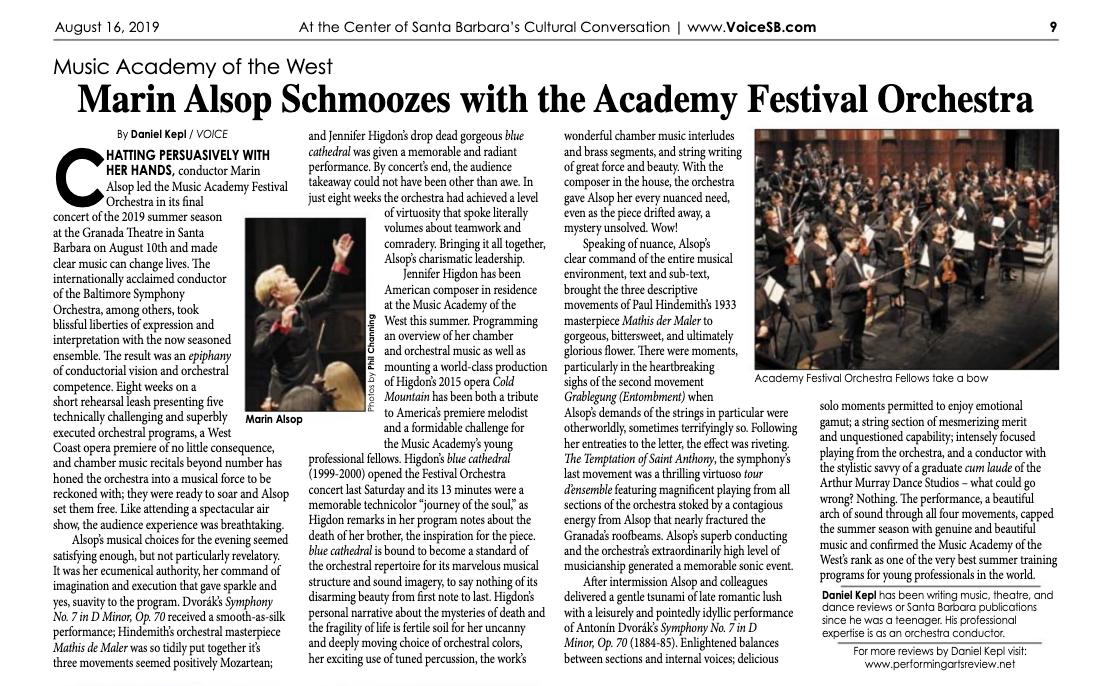

American composer Jennifer Higdon watches the performance of her blue cathedral


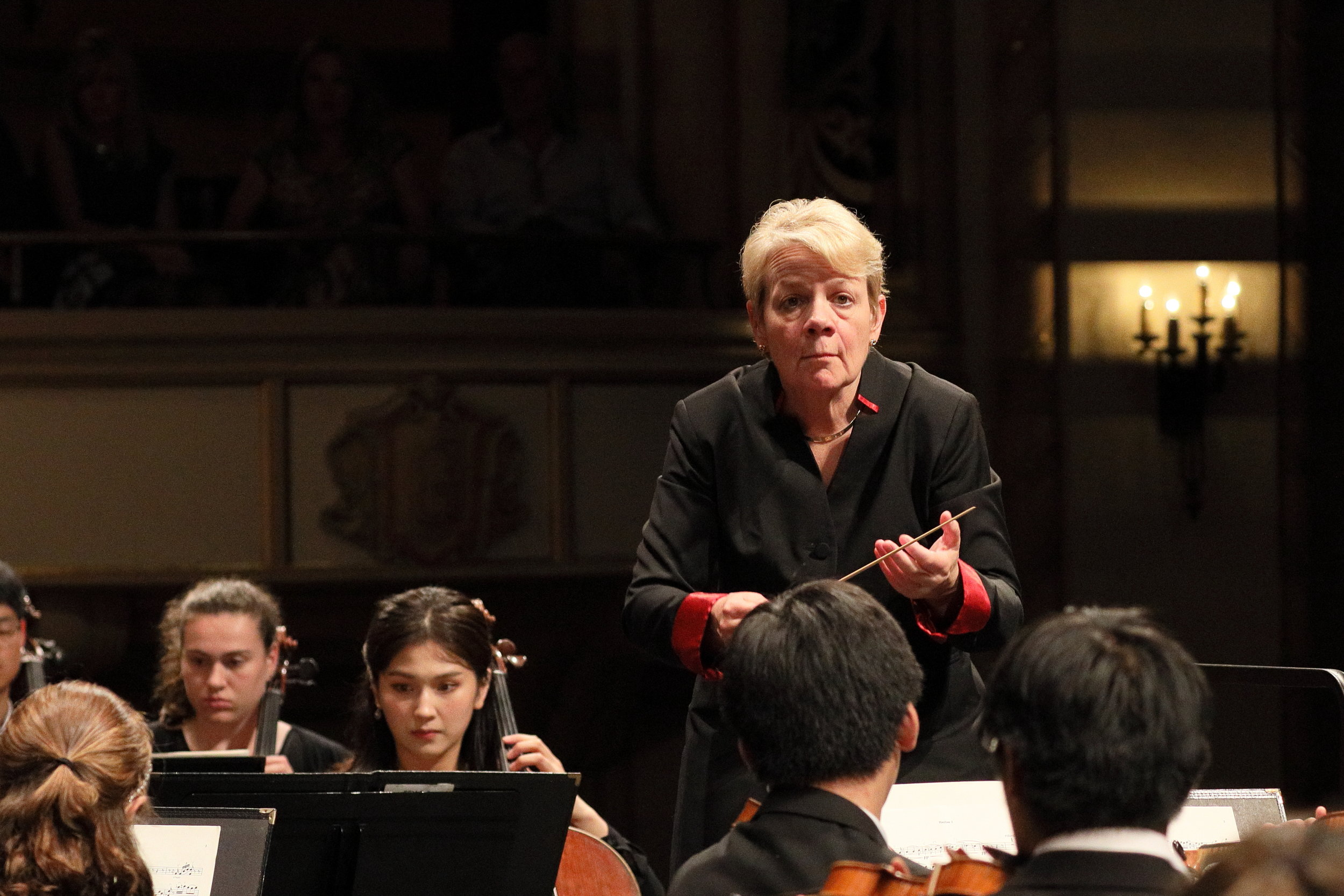


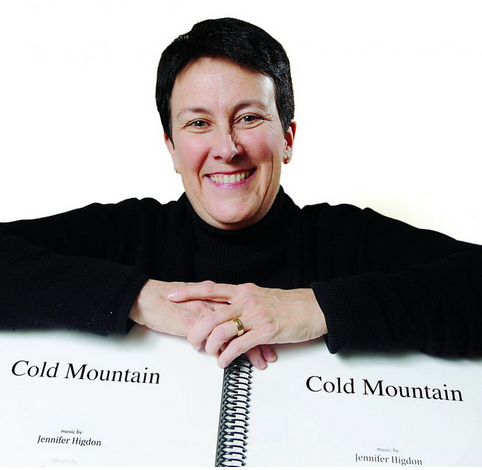
American composer Jennifer Higdon
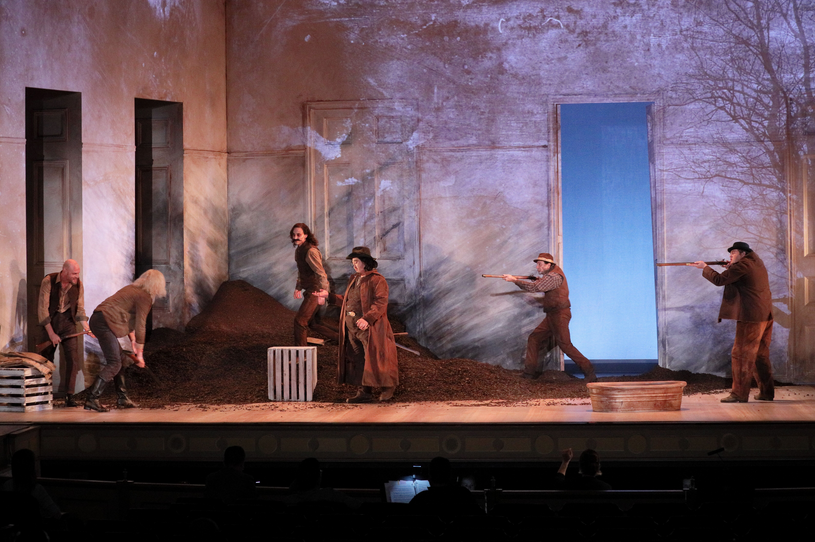
Scene from the Music Academy of the West’s production of Jennifer Higdon’s opera Cold Mountain - photo by Phil Channing
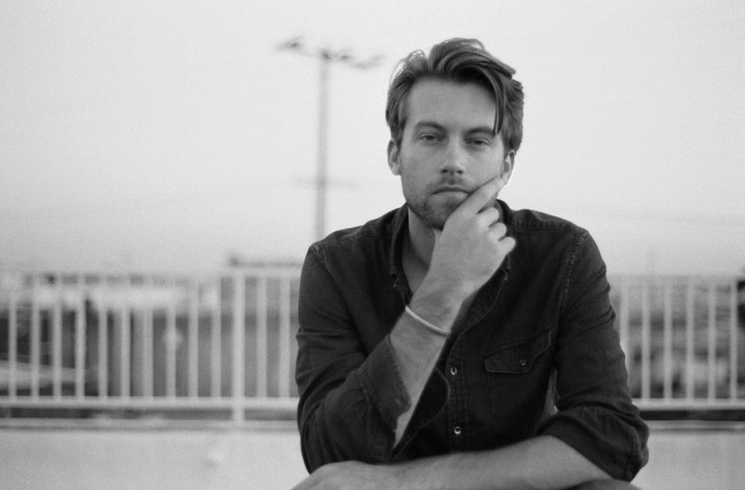
Cold Mountain director/designer James Darrah
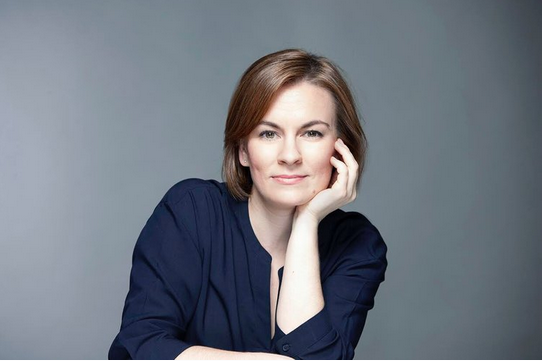
Cold Mountain conductor Daniela Candillari
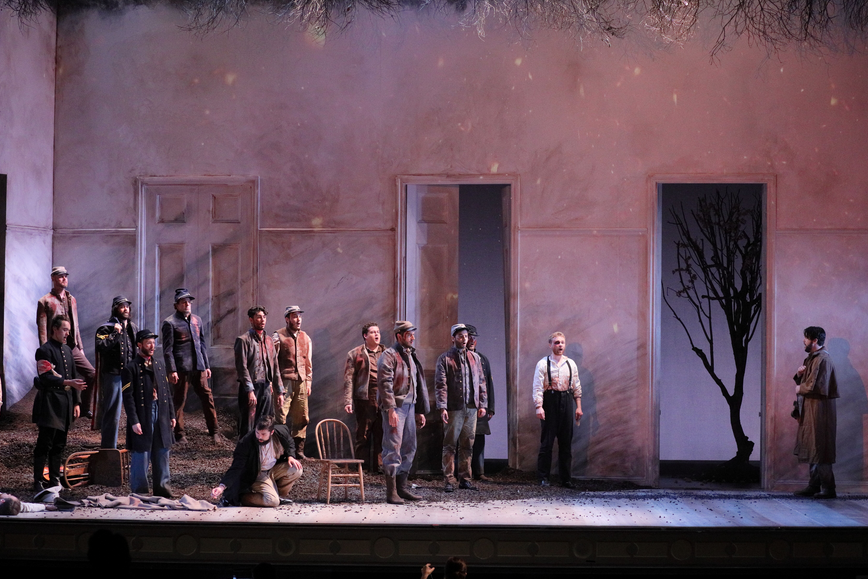
A scene from the Music Academy of the West’s west coast premiere of Jennifer Higdon’s opera Cold Mountain - photo by Phil Channing

A scene from the Santa Fe Opera world premiere of Jennifer Higdon’s opera Cold Mountain

A scene from the Santa Fe Opera world premiere

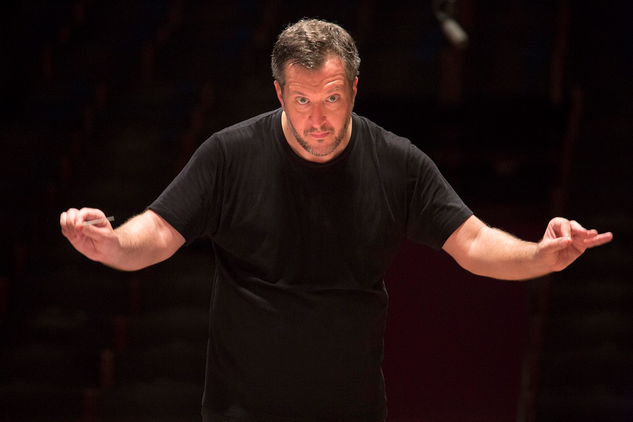
Thomas Adès | photo courtesy Santa Barbara Independent
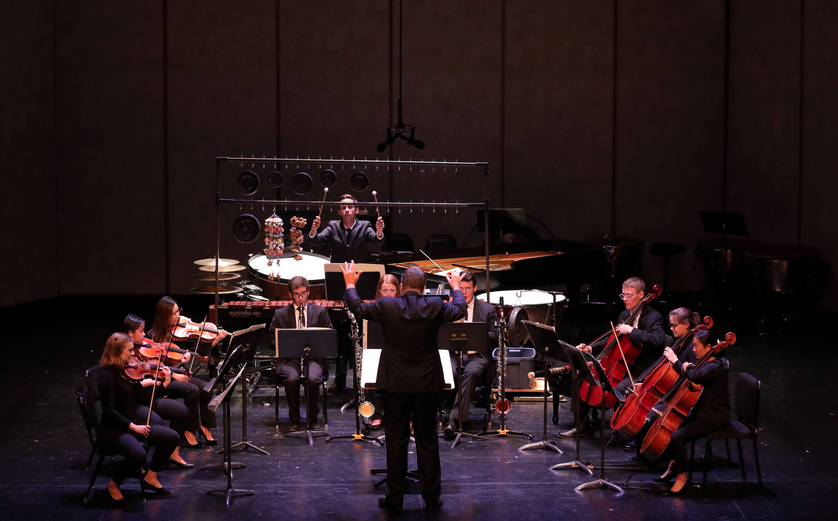
Thomas Adès conducts his The Origin of the Harp, Op. 13 with the Music Academy Festival Chamber Orchestra on July 20, 2019 | photos by Phil Channing
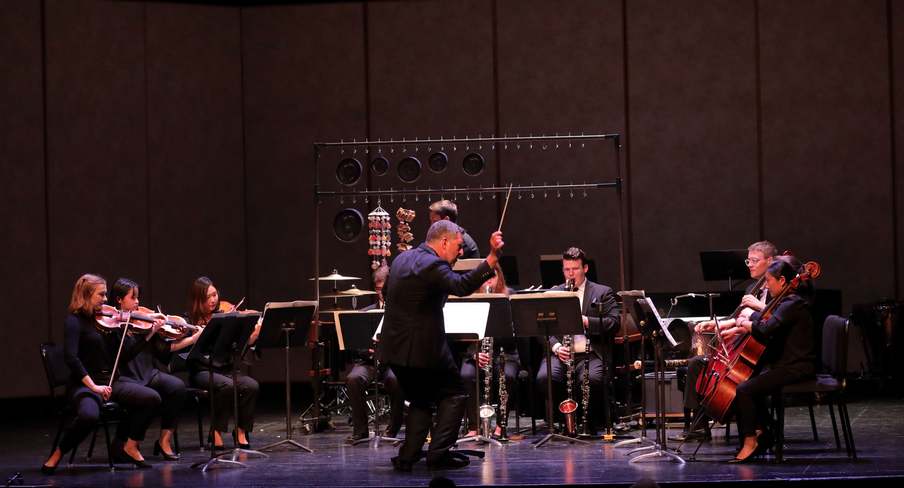
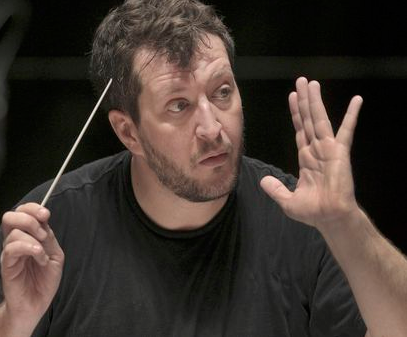
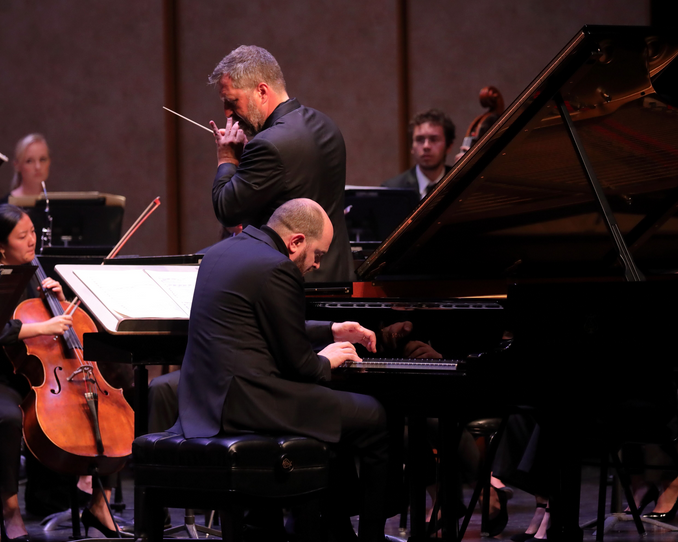
Thomas Adès conducts Ravel’s Piano Concerto in G Major with the Music Academy Festival Chamber Orchestra, Kirill Gerstein at the keyboard | photo by Phil Channing
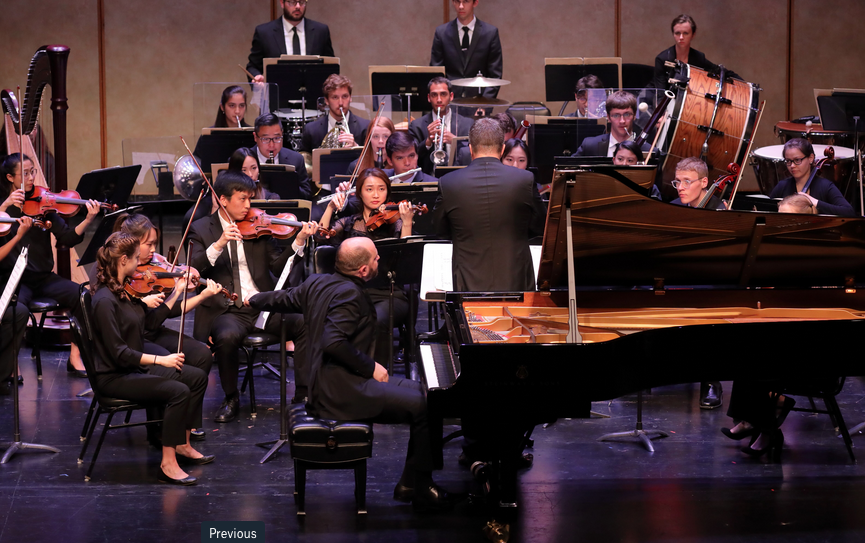
photo by Phil Channing
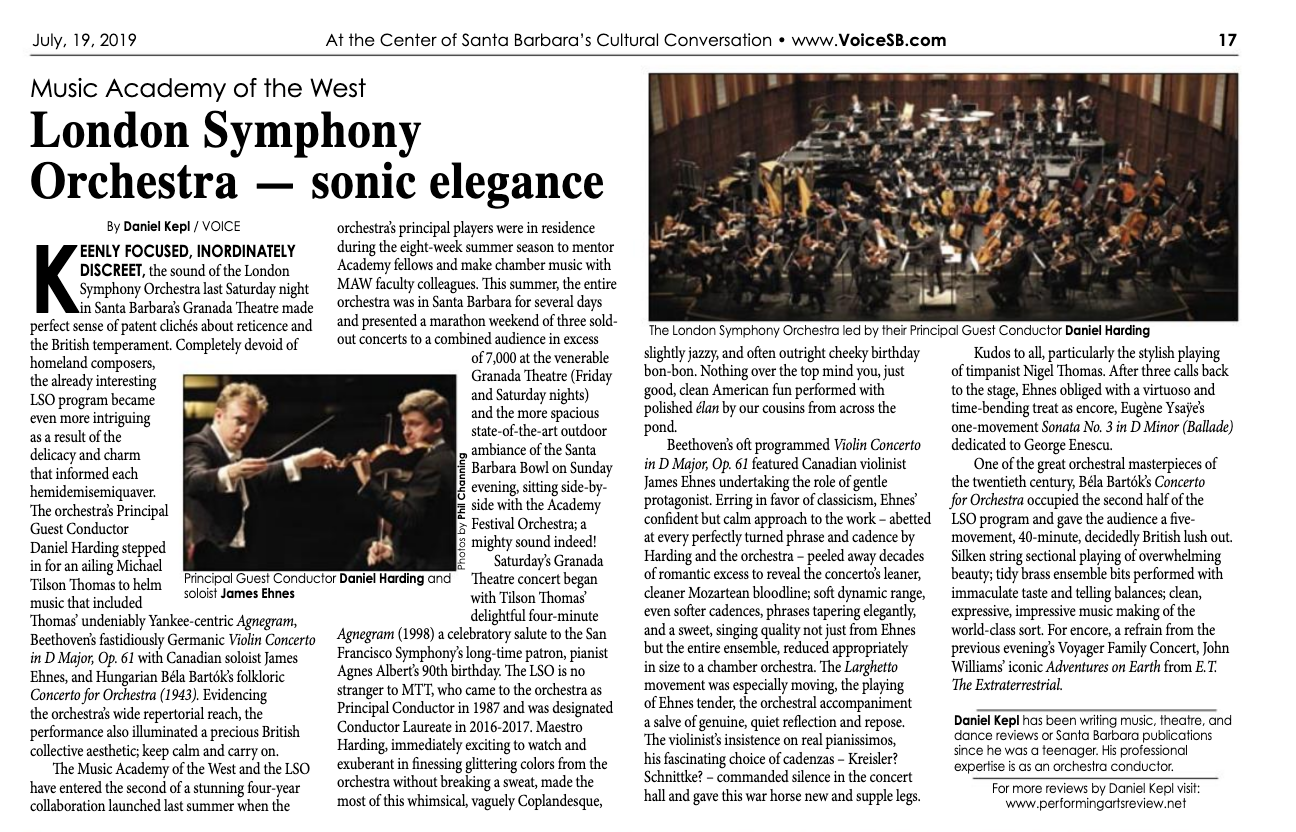
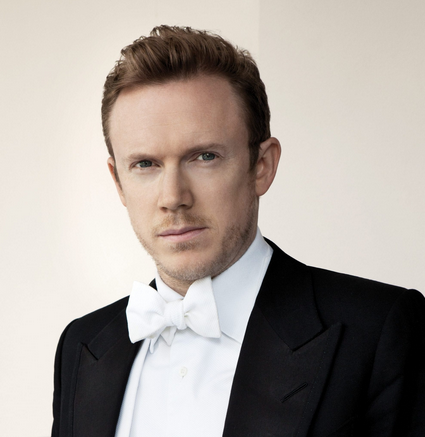
Conductor Daniel Harding
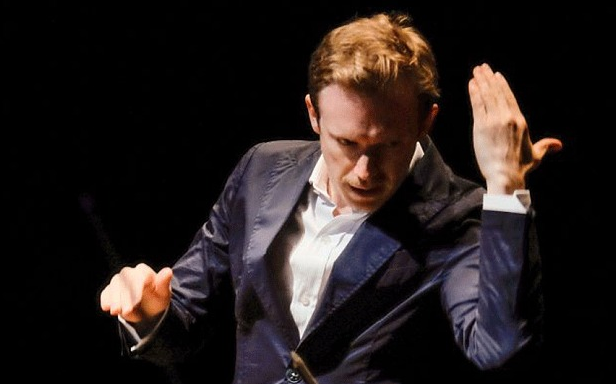
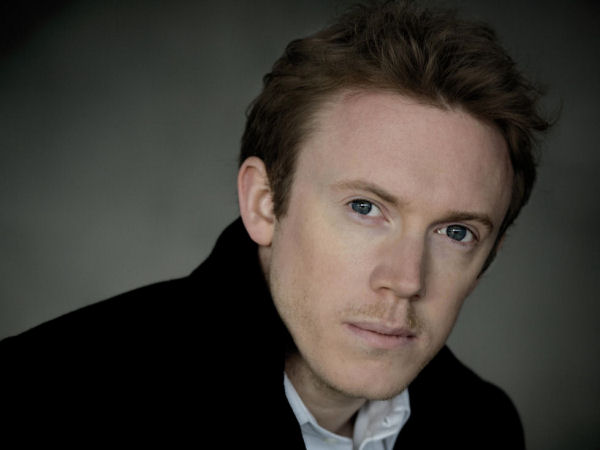
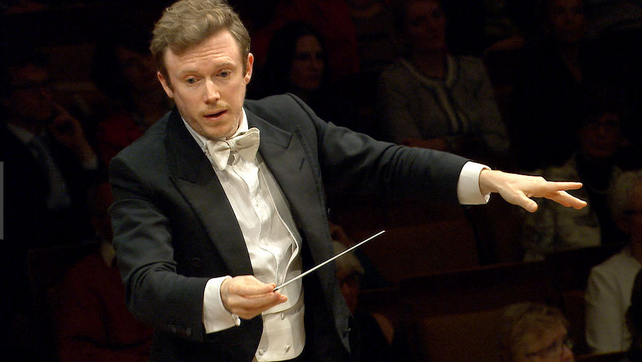
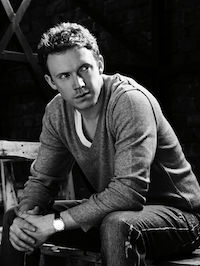
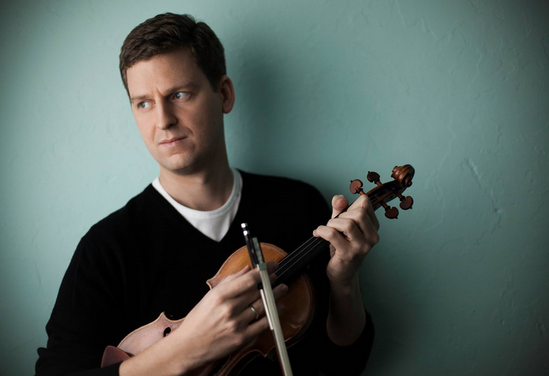
2019 Grammy Award winning Violinist James Ehnes

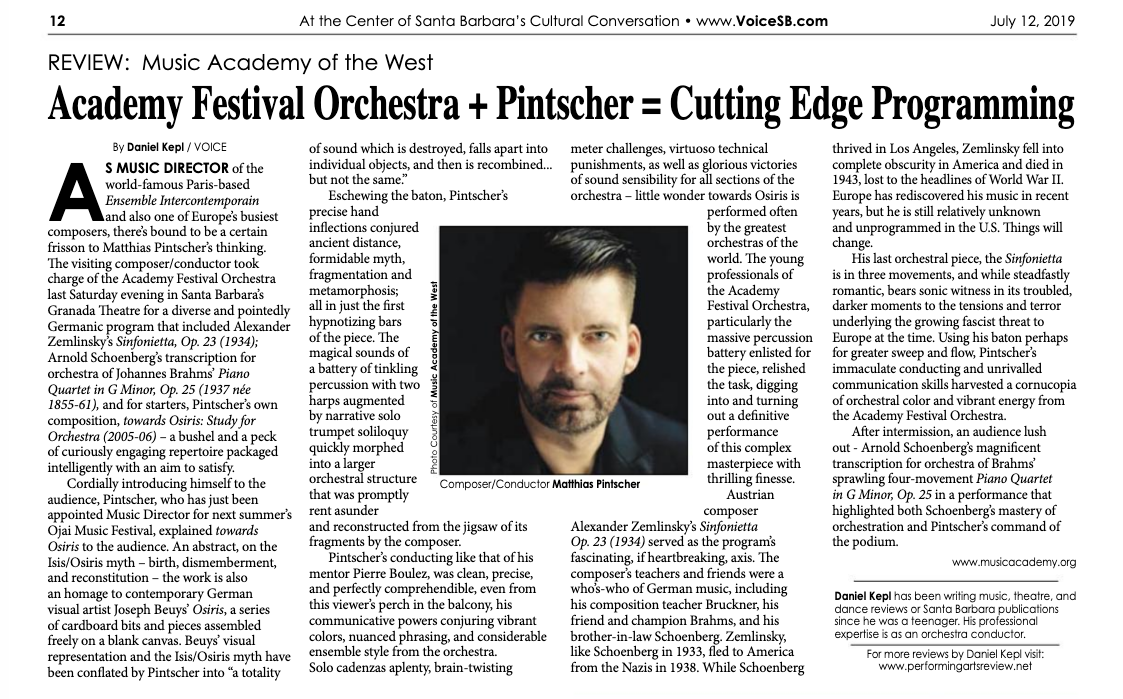
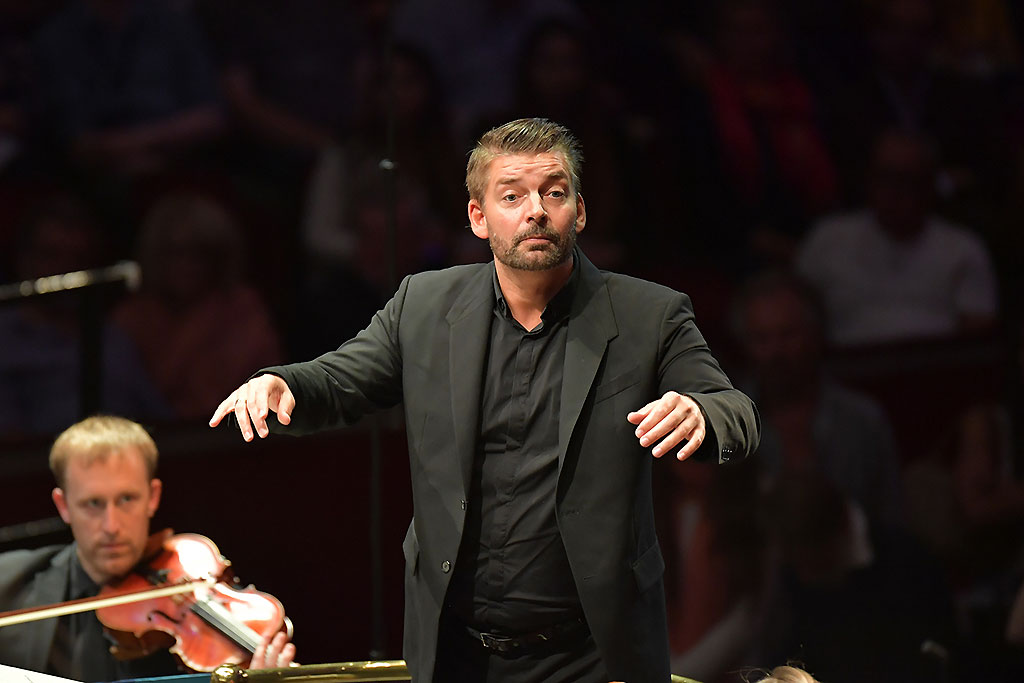
Conductor Matthias Pintscher
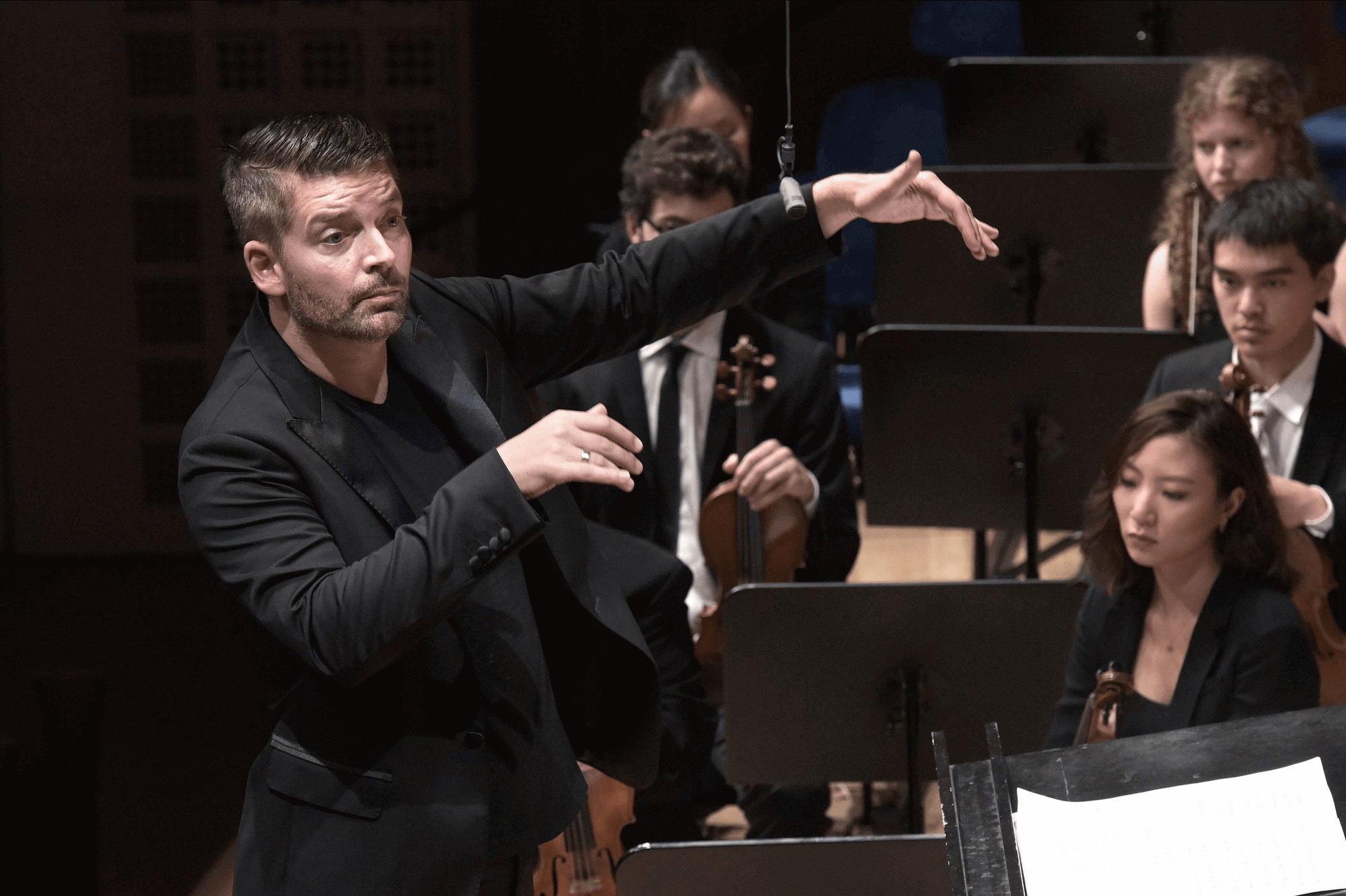
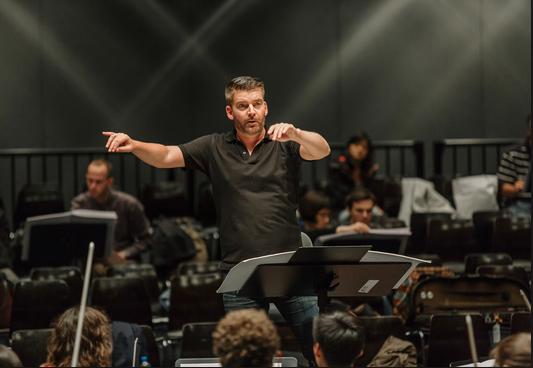
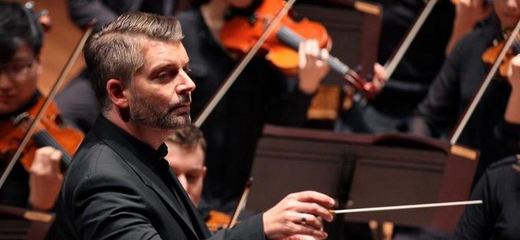
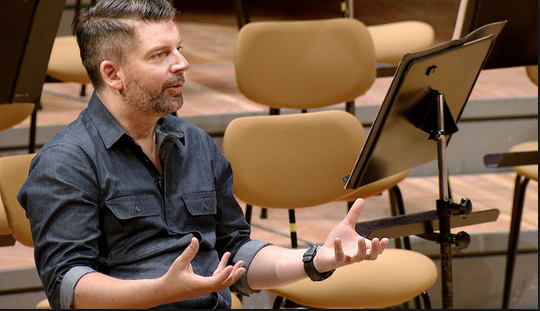

Photos by Phil Channing

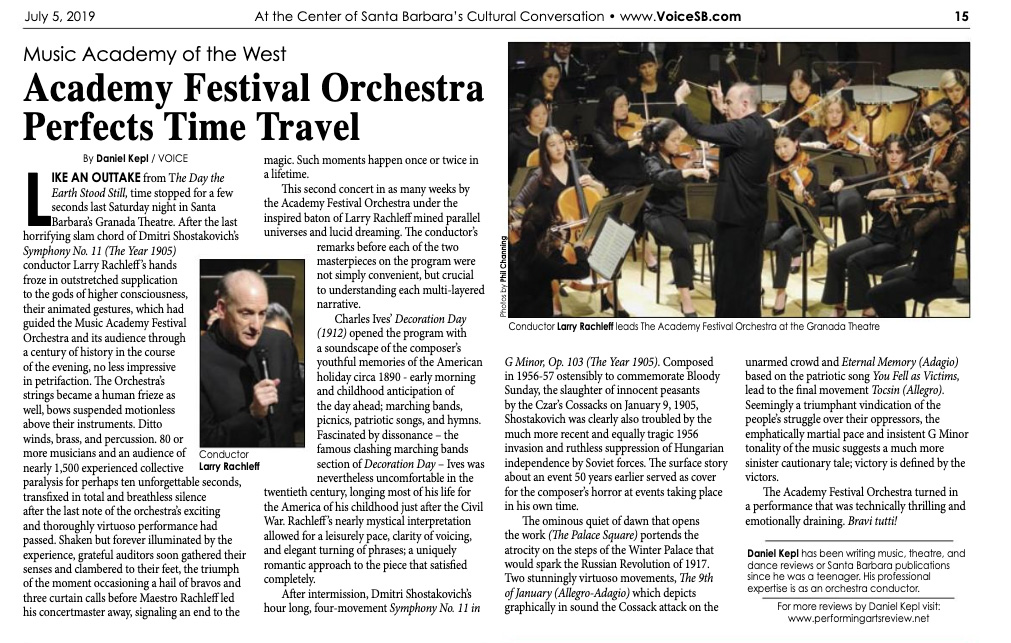

Conductor Larry Rachleff
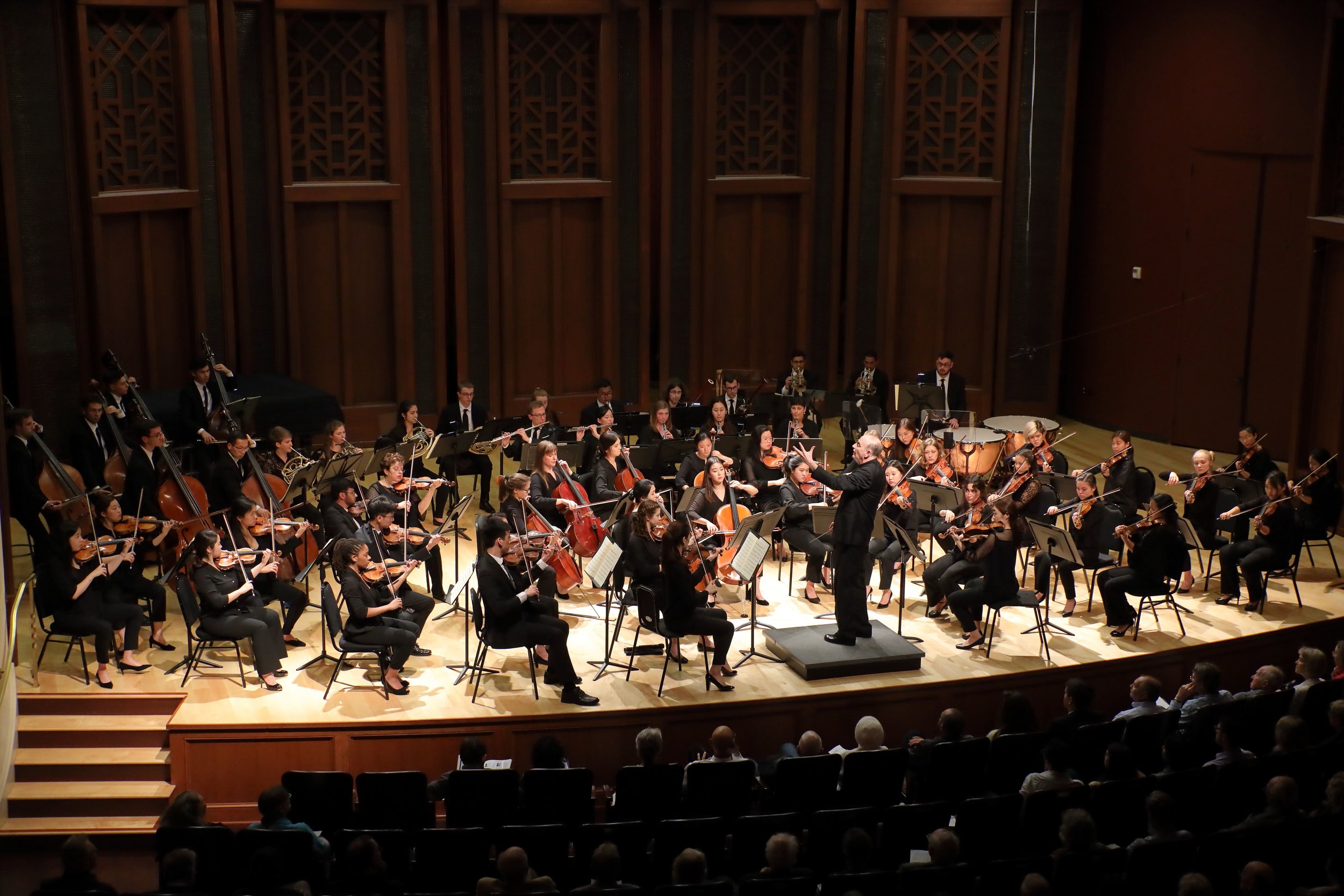
Academy Festival Orchestra, Larry Rachleff conducting
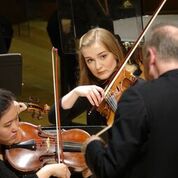
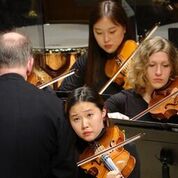
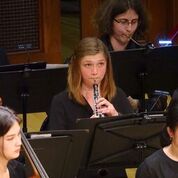


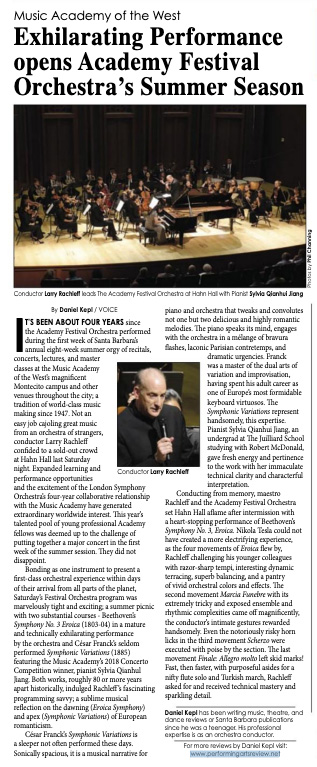
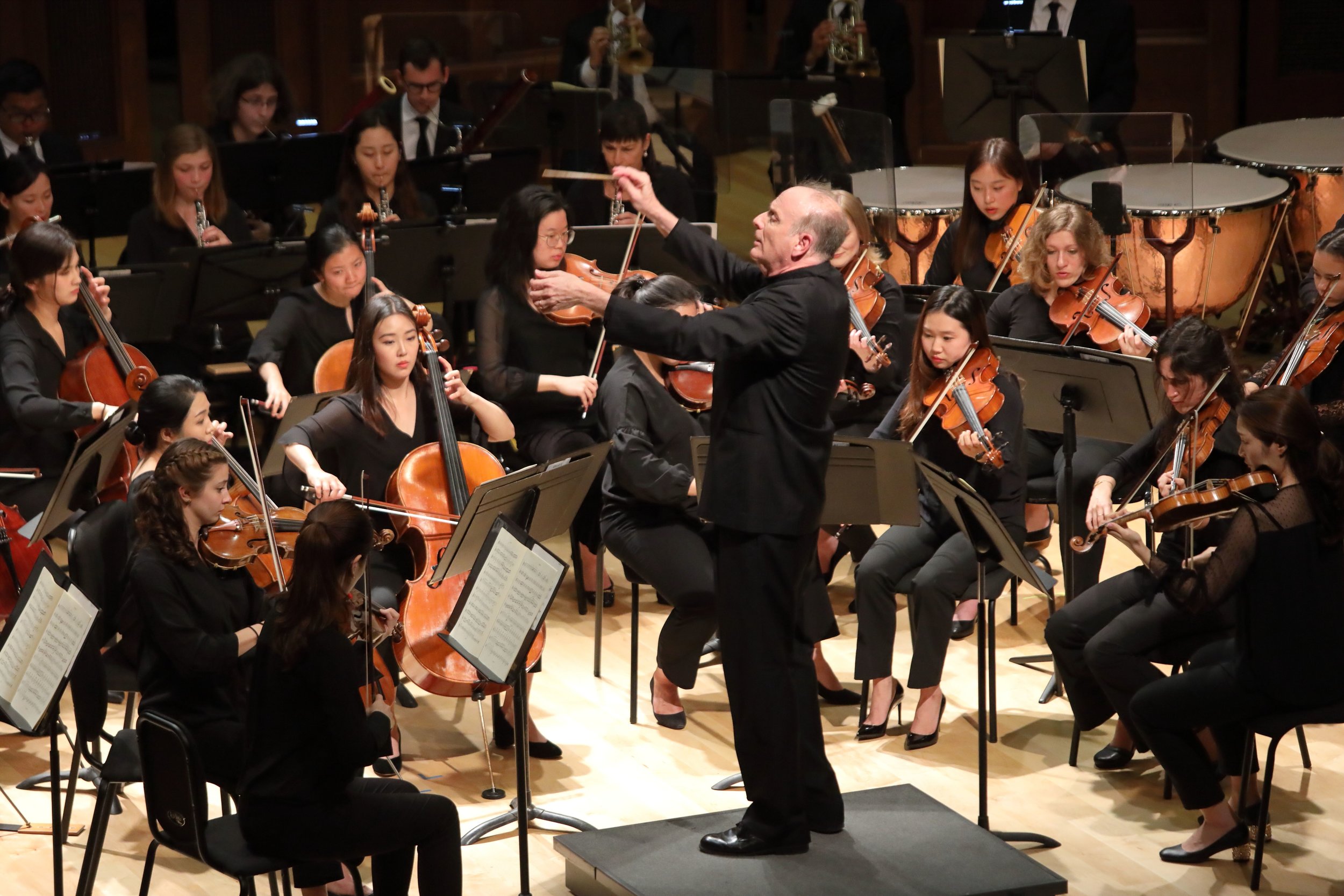
Conductor Larry Rachleff | Photos by Phil Channing
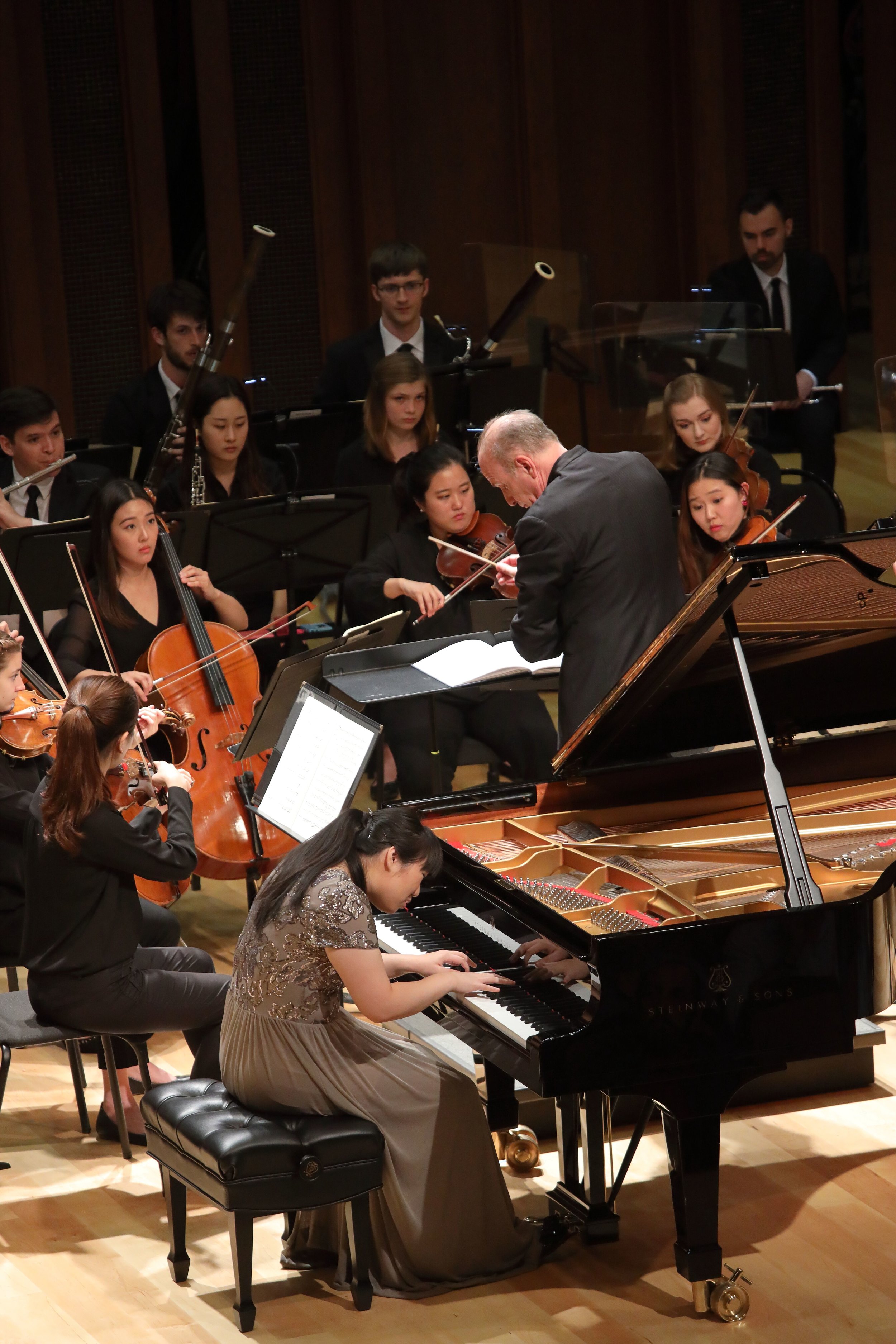
Pianist Sylvia Qianhui Jiang performs César Franck’s Symphonic Variations with the Academy Festival Orchestra, Larry Rachleff conducting on June 22, 2019
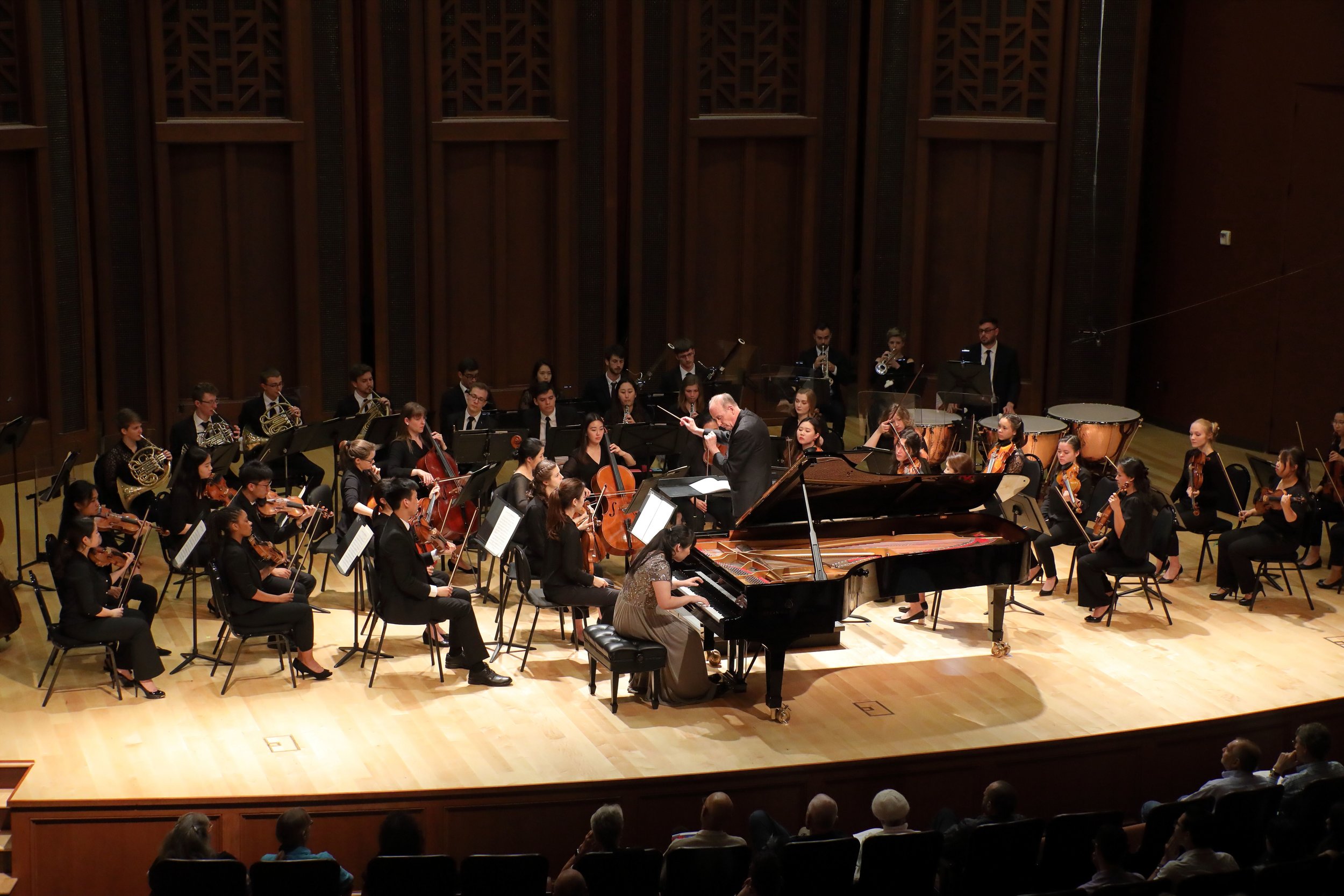
Pianist Sylvia Qianhui Jiang performs César Franck’s Symphonic Variations with the Academy Festival Orchestra, Larry Rachleff conducting on June 22, 2019
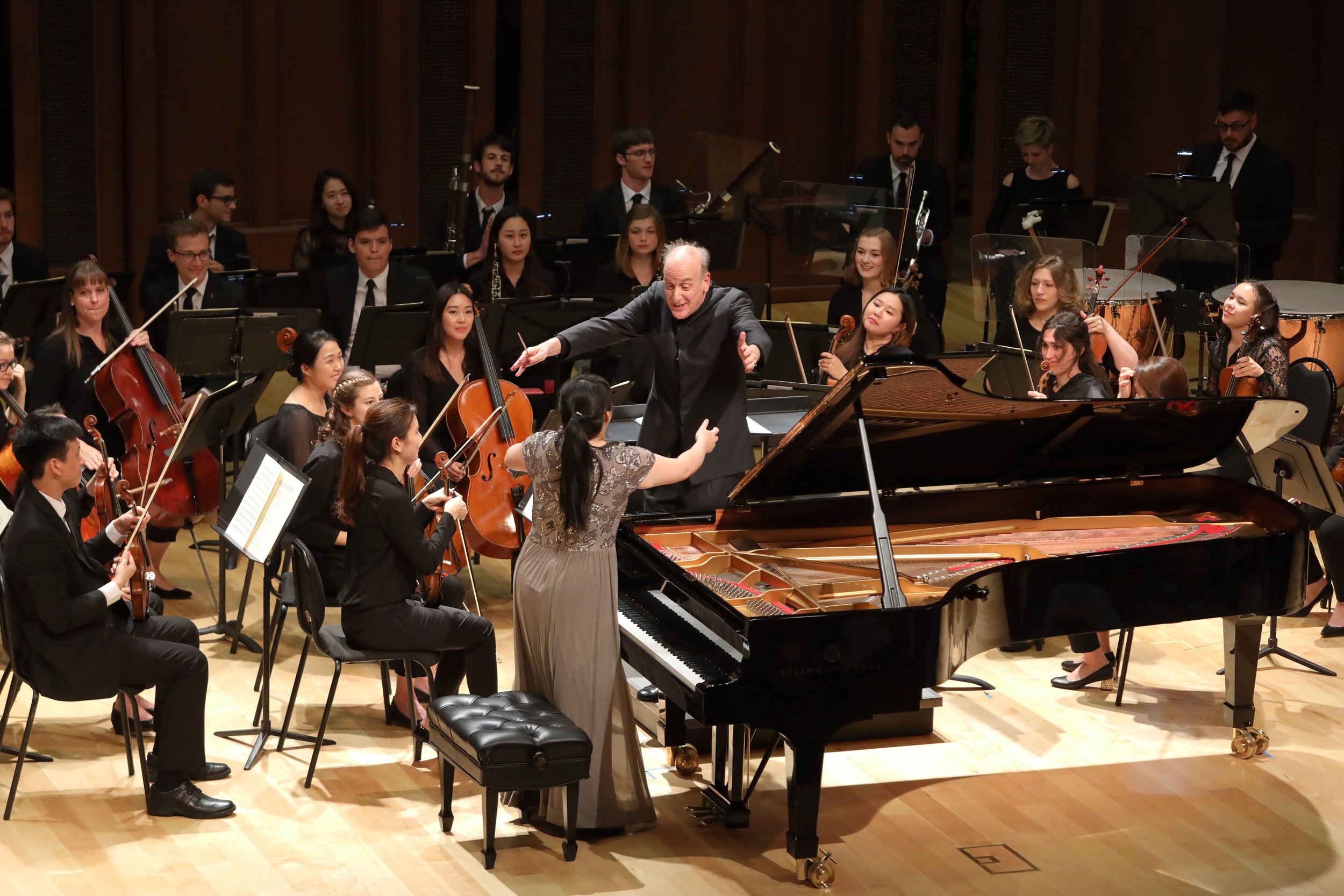
An embrace celebrates a magnificent performance by pianist Sylvia Qianhui Jiang of César Franck’s Symphonic Variations with the Academy Festival Orchestra, Larry Rachleff conducting on June 22, 2019
Michigan Philharmonic — watch the interview with conductor Nan Washburn about season 2019-2020
Visit the Michigan Philharmonic
Visit Conductor Nan Washburn’s website
Donate to the Michigan Philharmonic - a 501/c/3 nonprofit
Celebrating her 21st season 2019-2020 as Music Director and Conductor of the Michigan Philharmonic, Nan Washburn has taken a community orchestra she was hired to helm in 1999 in the metropolitan Detroit suburb of Plymouth and developed it into a regional professional orchestra that is flourishing.
Michigan Philharmonic offers an eight concert subscription season to packed houses in Plymouth and surrounding communities; nurtures a burgeoning youth symphony and enjoys a vigorous outreach program of special events and workshops including summer concerts at several of Michigan’s massive Metroparks that surround the Greater Detroit area. Washburn discusses the upcoming 2019-2020 season and reflects on the important mission her orchestra fulfills every day in her community.






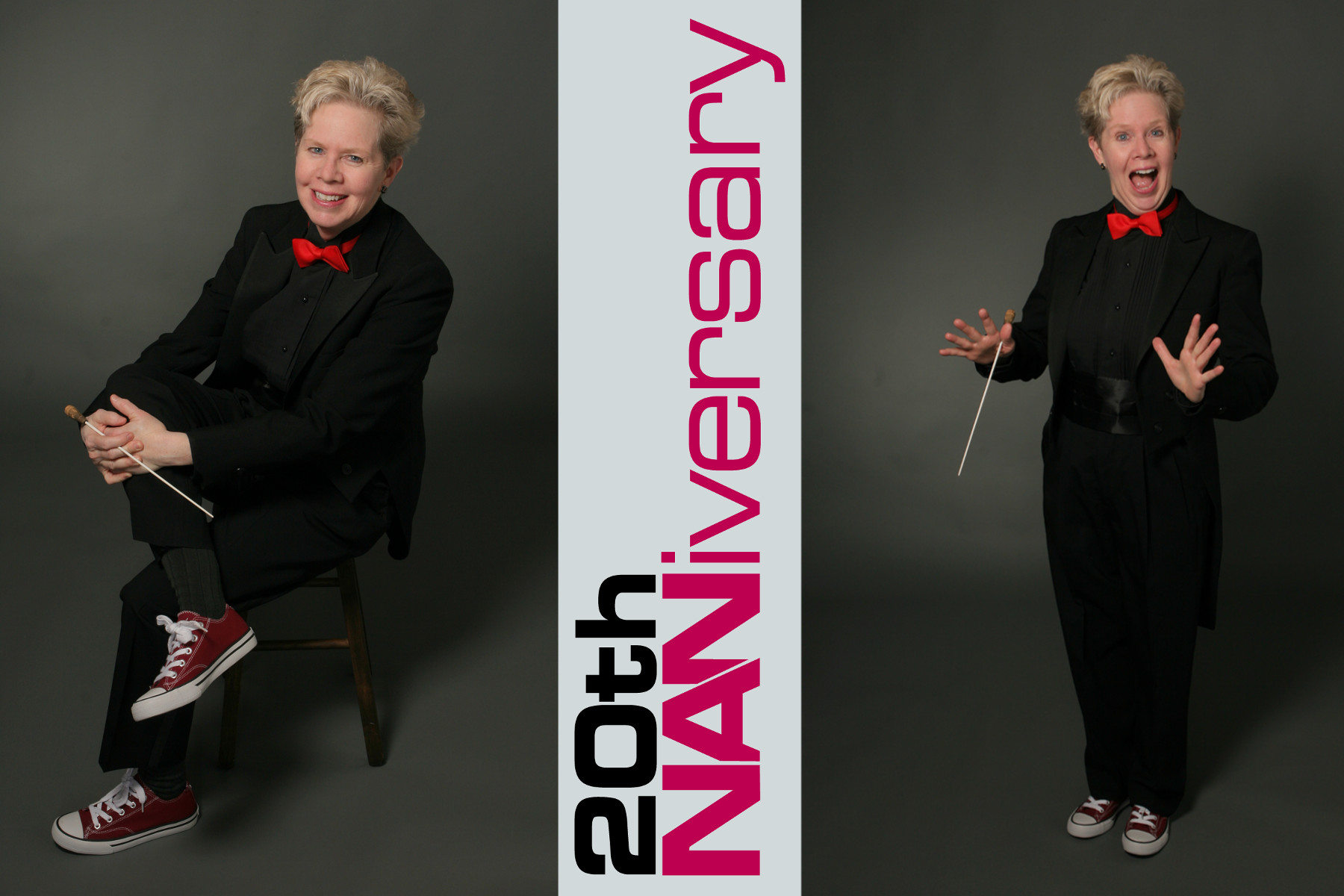
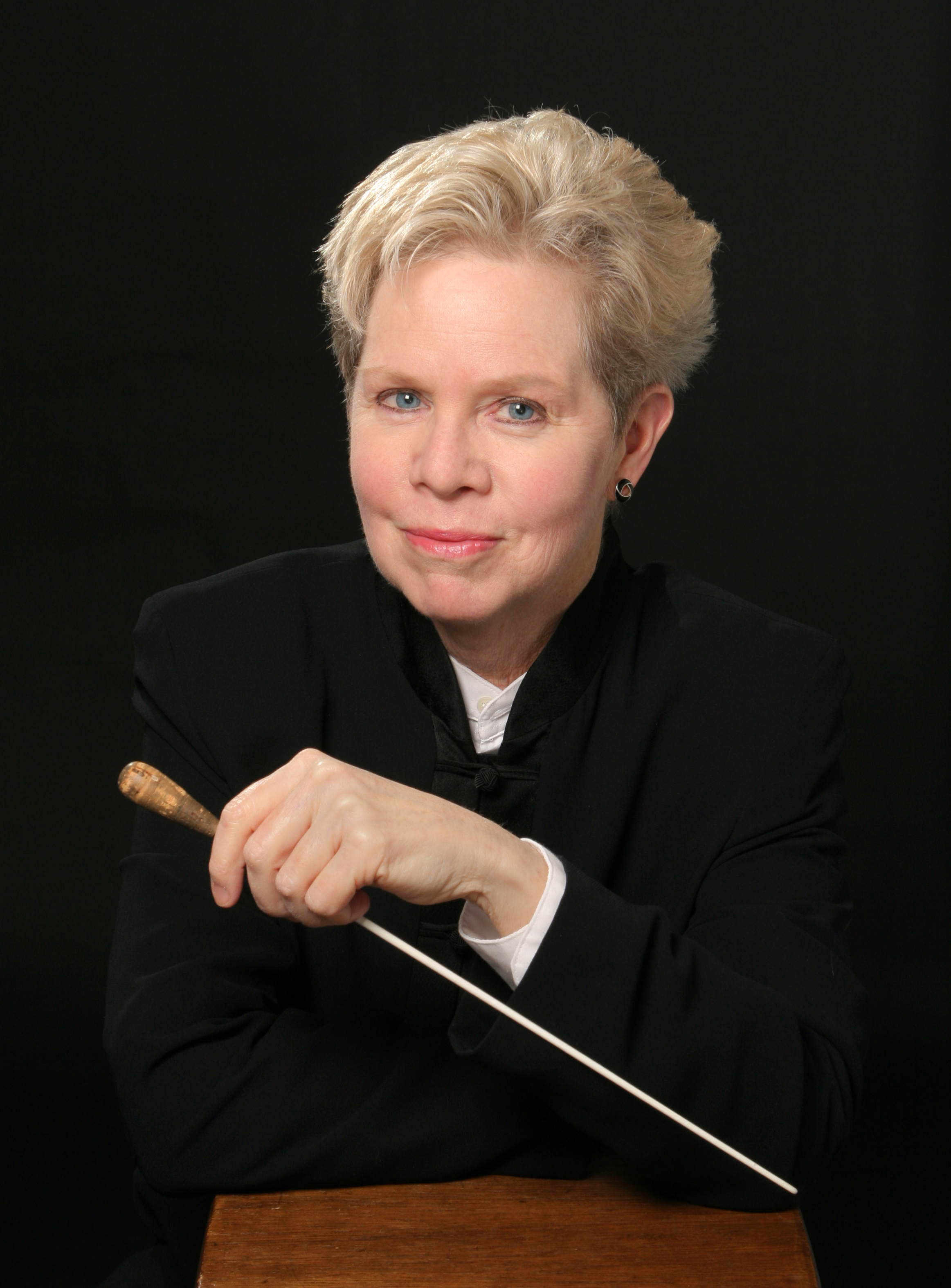
Nan Washburn, Music Director and Conductor of the Michigan Philharmonic
Violinist Harvey Thurmer: Music in the Shadow of Stalin — watch the interview, watch the recital
Read Harvey Thurmer’s biography
Visit Miami University College of Creative Arts
Read my review of Thurmer’s recording of György Kurtág’s Kafka Fragmente, Opus 24
Violinist Harvey Thurmer, New England Conservatory grad and a member of the string faculty at Miami University in Oxford, Ohio presented a fascinating and all too relevant lecture recital at Souers Recital Hall on the MU campus February 4th 2018 which illuminated tellingly, the double-edged sword of life for creative artists in a totalitarian state. With collaborative pianist Heather McPhail Thurmer presented a program titled Climate Change & Fake News: Music in the Shadow of Stalin; powerful musical examples by Russian composers Stravinsky, Prokofiev, Shostakovich, Schnittke and Shchedrin of truth speaking to power - carefully.
With immaculate musical taste and necessary historical backstory between pieces, Thurmer began his program with Stravinsky’s Pastorale (1907). Clearly a nostalgic chestnut from the composer’s youth in Imperial Russia before the Revolution, Harvey played this accidental memoir of a happier time with melancholic warmth. Prokofiev’s Solo Sonata, Opus 115 (1947) followed in similar though more haunted, post-WW II character. A treat because it is not often performed, the Opus 115 is an homage to Bach in some ways, full of cheerful counterpoint and devil-may-care insouciance. Liberated from the printed page by Thurmer’s clear understanding of color and imagery, enhanced by the violinist’s expert articulation and finely honed intonation, spiced with a soupçon of Russian gemütlichkeit, the sonata is guardedly optimistic in an otherwise ashen post-war landscape.
Thurmer makes clear in his chat from the stage the next piece, Prokofiev’s Violin Sonata No. 1, Opus 80 (1938-46), has quite a different story to tell. Wary is the overall feeling of this sonata as Stalin’s increasingly ruthless treatment of his own people, especially intellectuals, made silence a survival tactic during the timeframe of its composition. Musically haunting, this sonata does not dare speak to power, instead illuminating totalitarianism, intolerance and oppression in graphic tonality and stunning subtext. Thurmer and McPhail pulled out all the stops on this one — colors deep as the subconscious, beautiful as black sapphire; quiet, treacherously difficult but powerful whisper runs on fiddle; spine-chilling journeys down harmonic pathways as obtuse as guessing friends from enemies must have been at the time. A powerful performance by both artists.
Shostakovich’s Preludes Opus 34, No. 10, 16, 24 (1931-33) arranged by Dimitri Tziganov, offered narrative opportunity with every note of Thurmer’s interpretation: wistful, tenuous, intuitive. Schnittke’s First Sonata (1963) performed by Thurmer and McPhail with intense emotional focus and mystical result, together with Rodion Shchedrin’s In the Style of Albeniz (1973), music by the Lenin Prize-winner that for all its Iberian pretense is unnervingly paranoid, macabre and acidic, rounded out the Climate Change & Fake News program, reminding the listener that despite the appalling psychological insult of thugs like Stalin on the creative spirit, art does in the end, triumph.
Daniel Kepl | Performing Arts Review
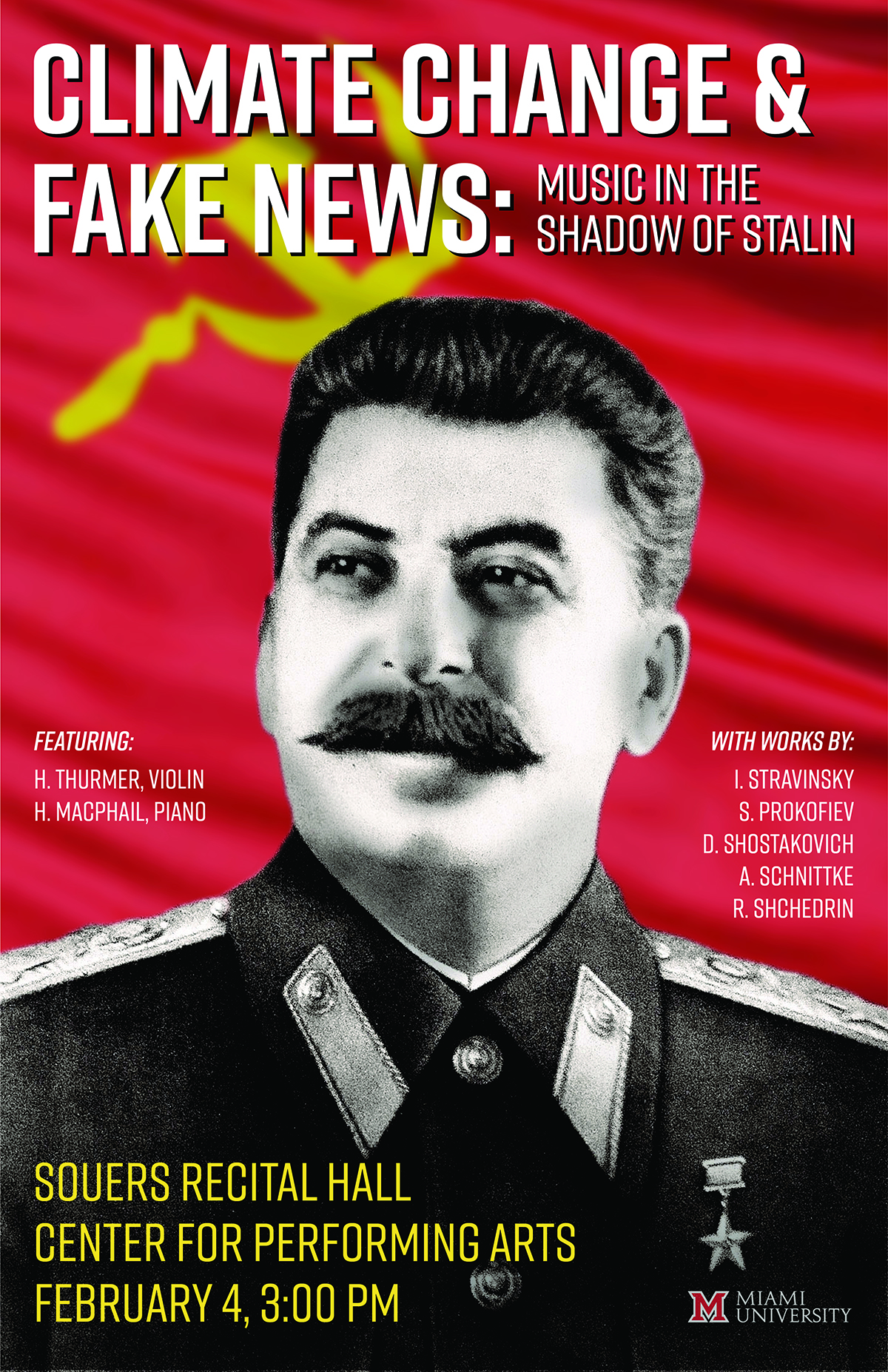












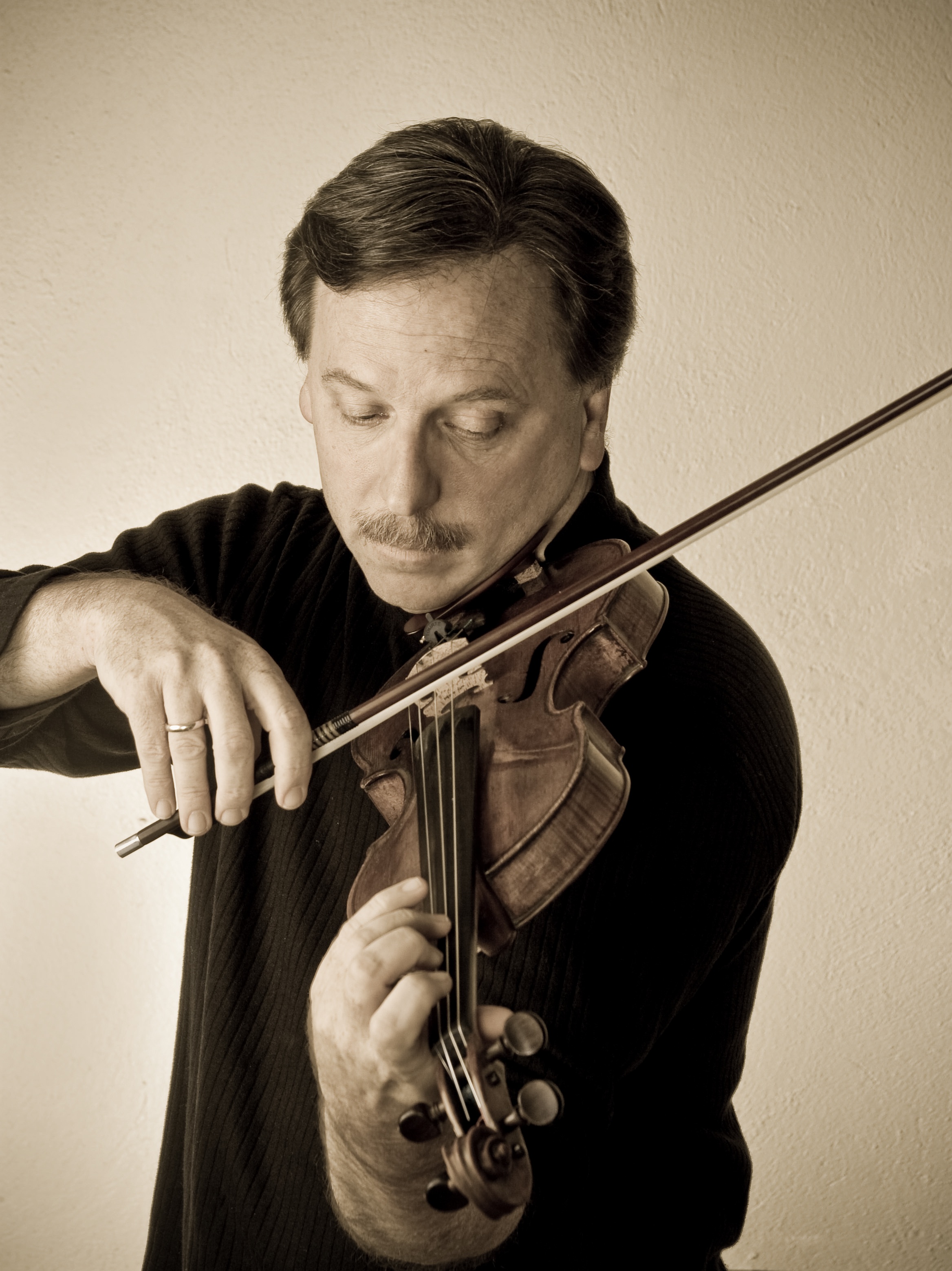
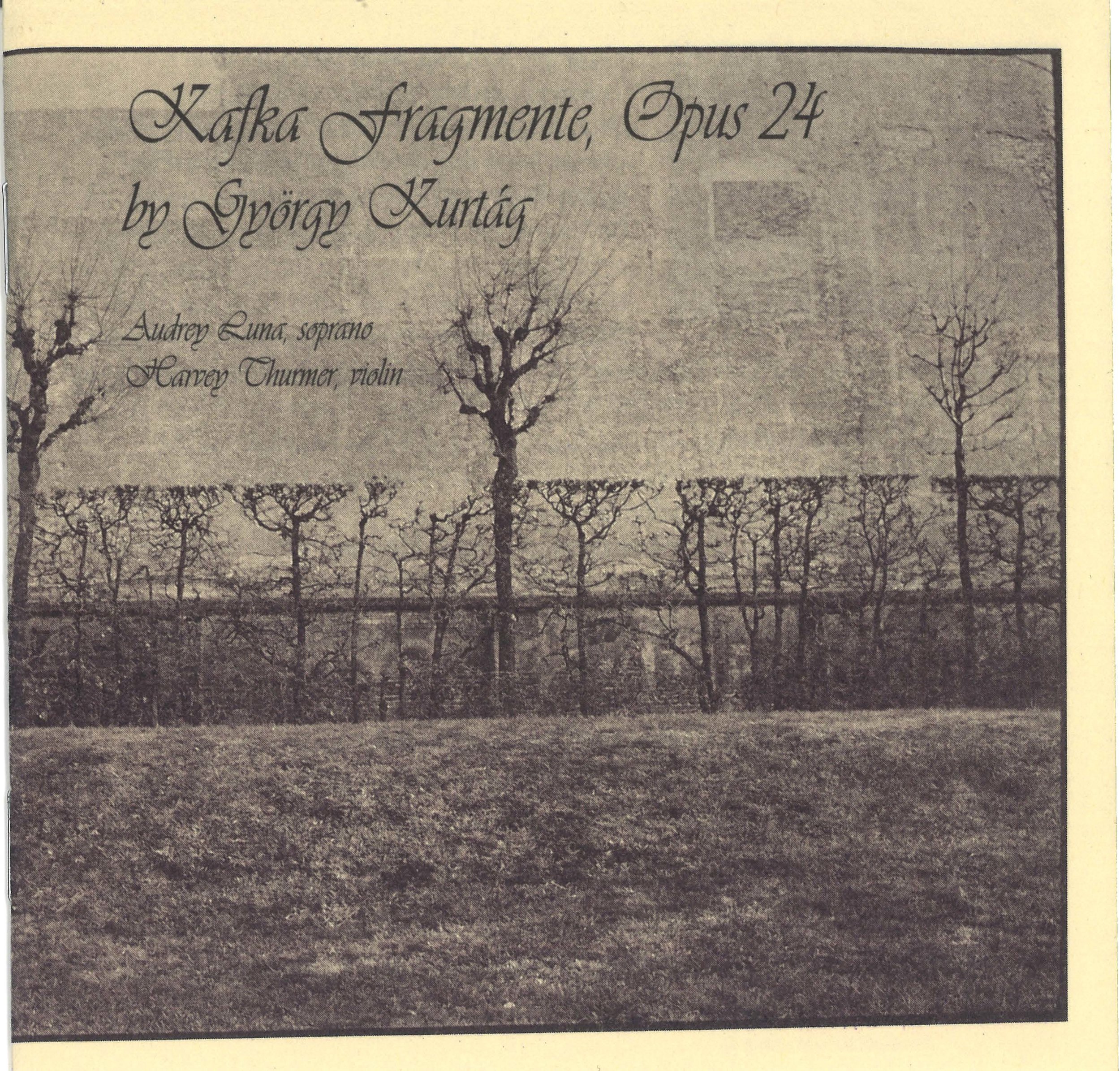
Read my review of Thurmer’s 2003 recording of György Kurtág’s Kafka Fragmente, Opus 24
Pianist Daniel Shapiro plays Schubert - watch the interview
Buy the DVDs - Volume 1 - D575, 840, 845, 850
Buy the DVDs - Volume 2 - D664, 537, 894, 958
Buy the DVDs - Volume 3 - D784, 959, 960
Read Daniel Shapiro’s bio
Impeccably researched and performed with unerring humanity, pianist Daniel Shapiro discusses the necessity of finding oneself in order to “see” the less trodden and more subtle pathways of Schubert’s genius in these masterpieces for solo piano
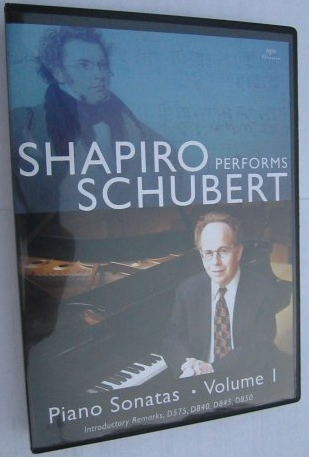
Daniel Shapiro performs D575, D840, D845, D850 - Volume 1



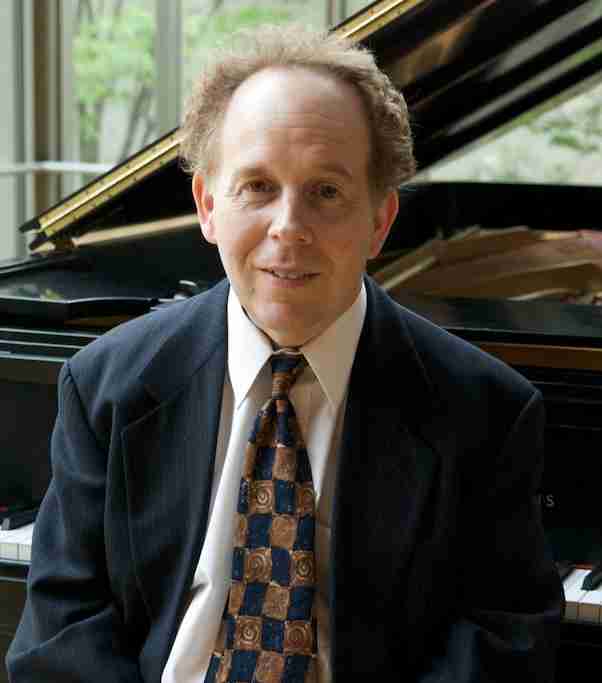
Santa Barbara Dance Theater: Distance and Desire — interview with Christopher Pilafian coming soon

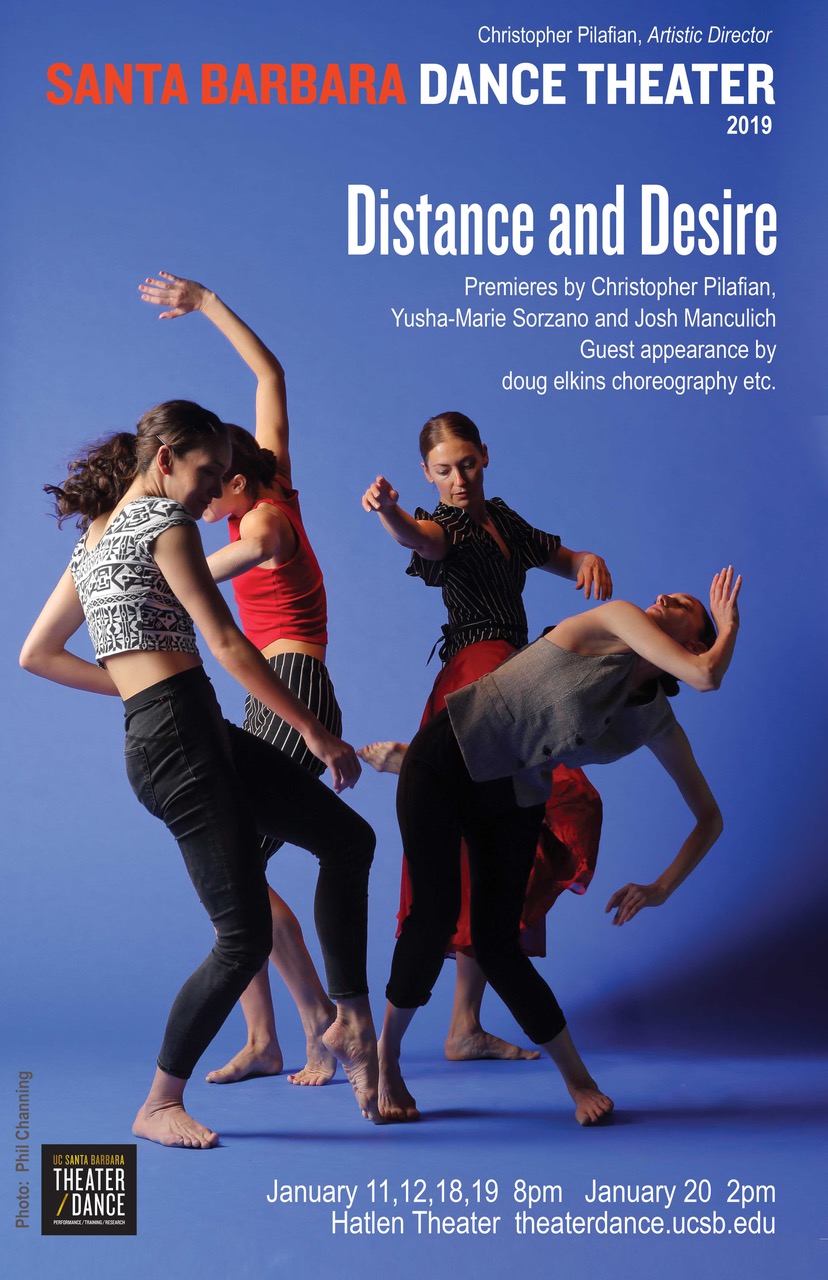


Santa Barbara Dance Theater artistic director Christopher Pilafian
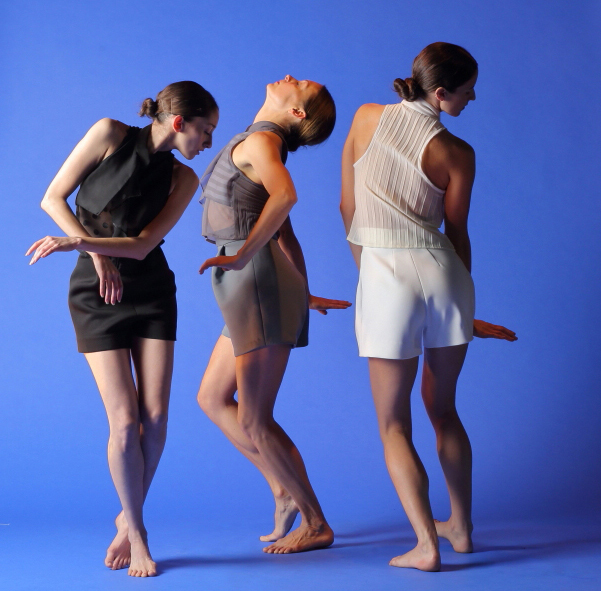
Yusha-Marie Sozano’s To All Our Ends
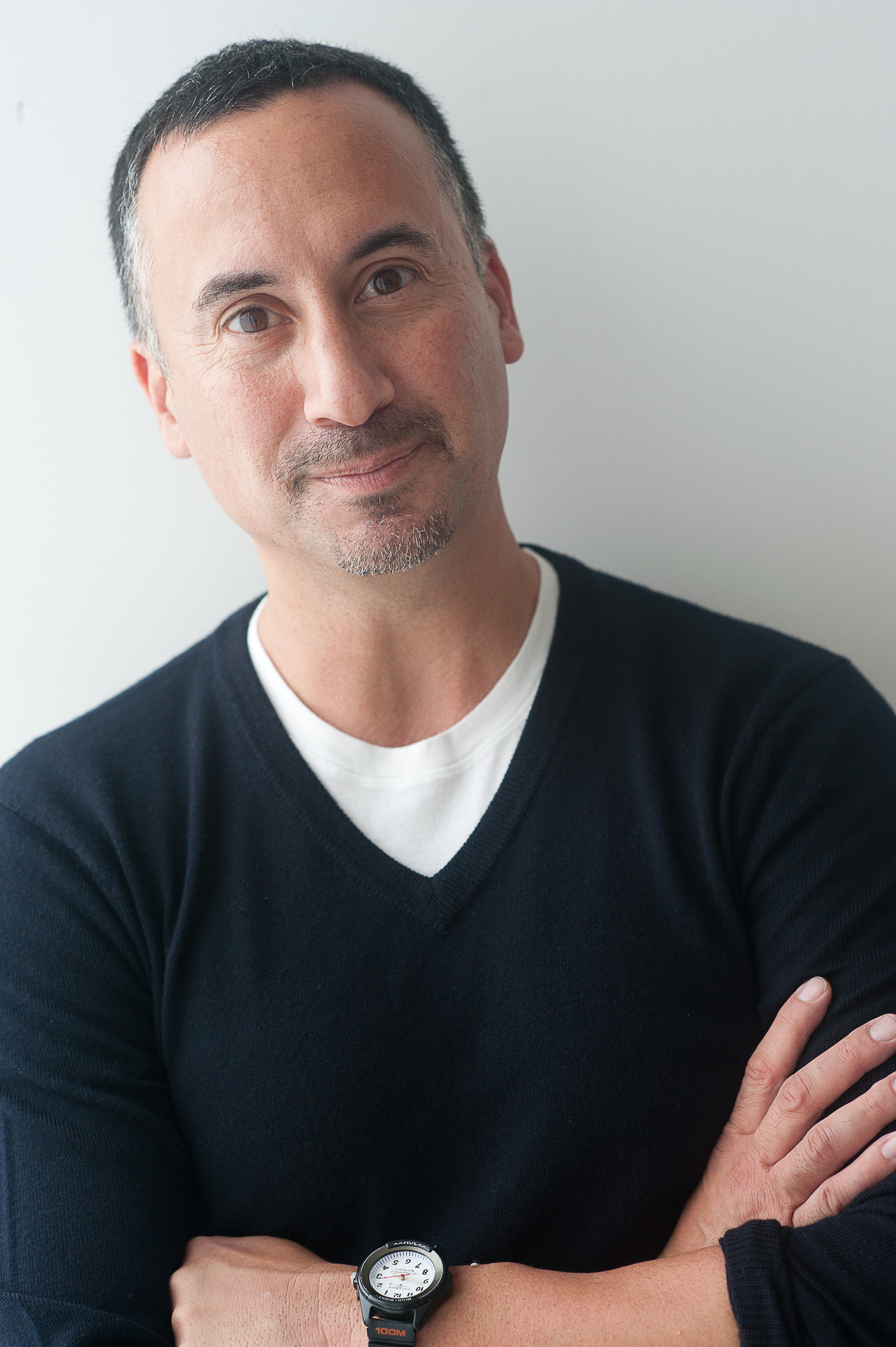
Doug Elkins | Photo by Christopher Duggan
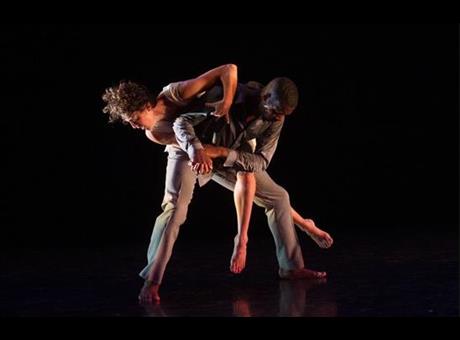
doug elkins choreography etc.
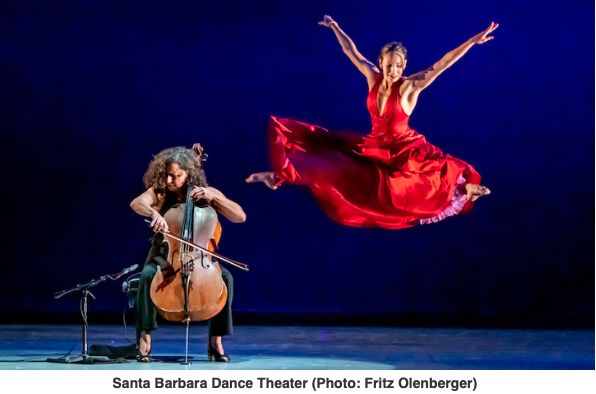
Greater Bridgeport Symphony 2019-2020 — watch the interview
Visit Greater Bridgeport Symphony’s website
Visit conductor Eric Jacobsen’s webiste
The Greater Bridgeport Symphony celebrates its 74th season in 2019-2020. A professional orchestra serving the historic Connecticut port city’s metropolitan population of approximately 200,000 the orchestra has been under the artistic direction of brooklyn-based conductor and cellist Eric Jacobsen since 2014.
Mr. Jacobsen is a member of Yo Yo Ma's Silk Road Project and is conductor and co-artistic director with his brother Colin, of the orchestra The Knights. Eric is Music Director of the Orlando Philharmonic and will enjoy guest conducting appearances with the Westchester Philharmonic, Detroit Symphony, Arkansas Symphony and Virginia Symphony during 2019-2020.
Founded during the Great Depression as a Works Progress Administration (WPA) Symphony Orchestra, the Greater Bridgeport Symphony has had its ups and downs over the decades as has the community of Bridgeport, Connecticut. In recent years, especially since the appointment of Eric Jacobsen as Music Director, the Greater Bridgeport community has recognized and become more engaged in the orchestra’s growth.
Executive Director Mark Halstead is excited by the personal commitment and energy Eric Jacobsen has brought to the Bridgeport community. World-class guest artists, outreach to young musicians and above all, service to great music has inspired musicians and audience alike throughout the region.
The Greater Bridgeport Symphony Orchestra’s bottom line is about making music at the highest possible level of artistic and intellectual excellence. With Eric Jacobsen at the helm the artistic growth of the orchestra and its audience is assured.
Daniel Kepl | Performing Arts Review
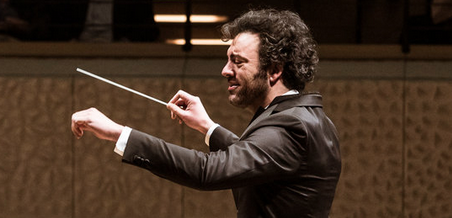


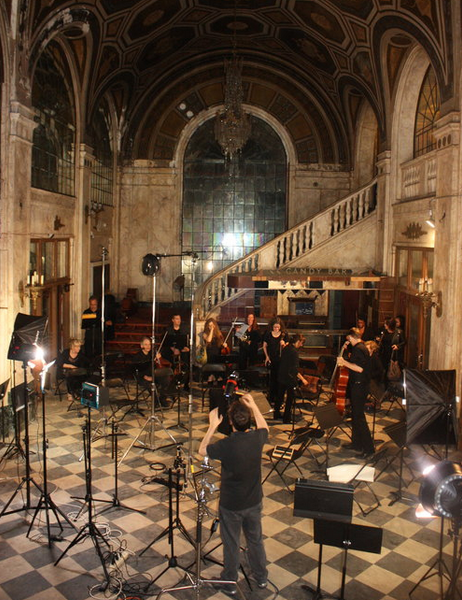

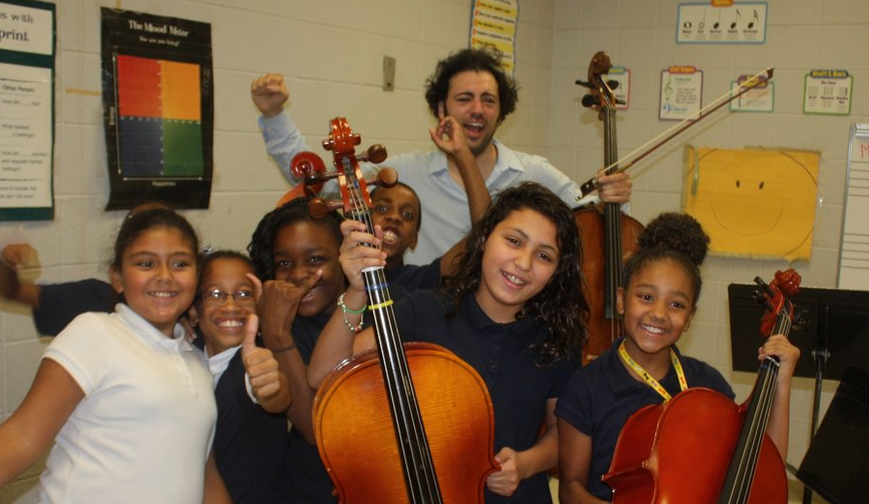
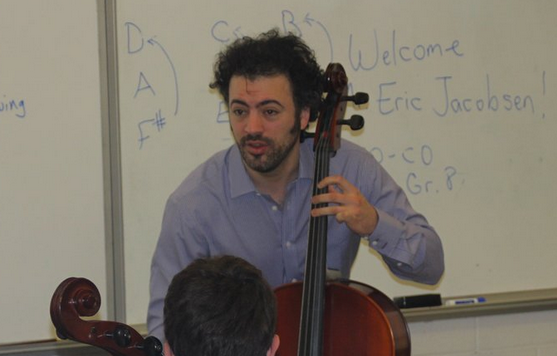


Conductor Dean Anderson — watch the interview
Visit Dean Anderson’s website
Visit Dean Anderson’s page at La Sierra University
Los Angeles-based conductor Dean Anderson received his DMA at UCLA under conductor Neal Stulberg. Dr. Anderson is director of orchestra studies at La Sierra University in Riverside, director of instrumental activities at Occidental College in Los Angeles and conducts the Dana Point and Symphony Irvine orchestras. Anderson is a contender for the position of Music Director of the San Bernardino Symphony, conducting the orchestra’s holiday concert on December 1, 2018.
Daniel Kepl and Dean Anderson discuss the responsibilities of the conducting art, the most influential mentors in Anderson’s career to date and his advice to young conductors just beginning their journey.


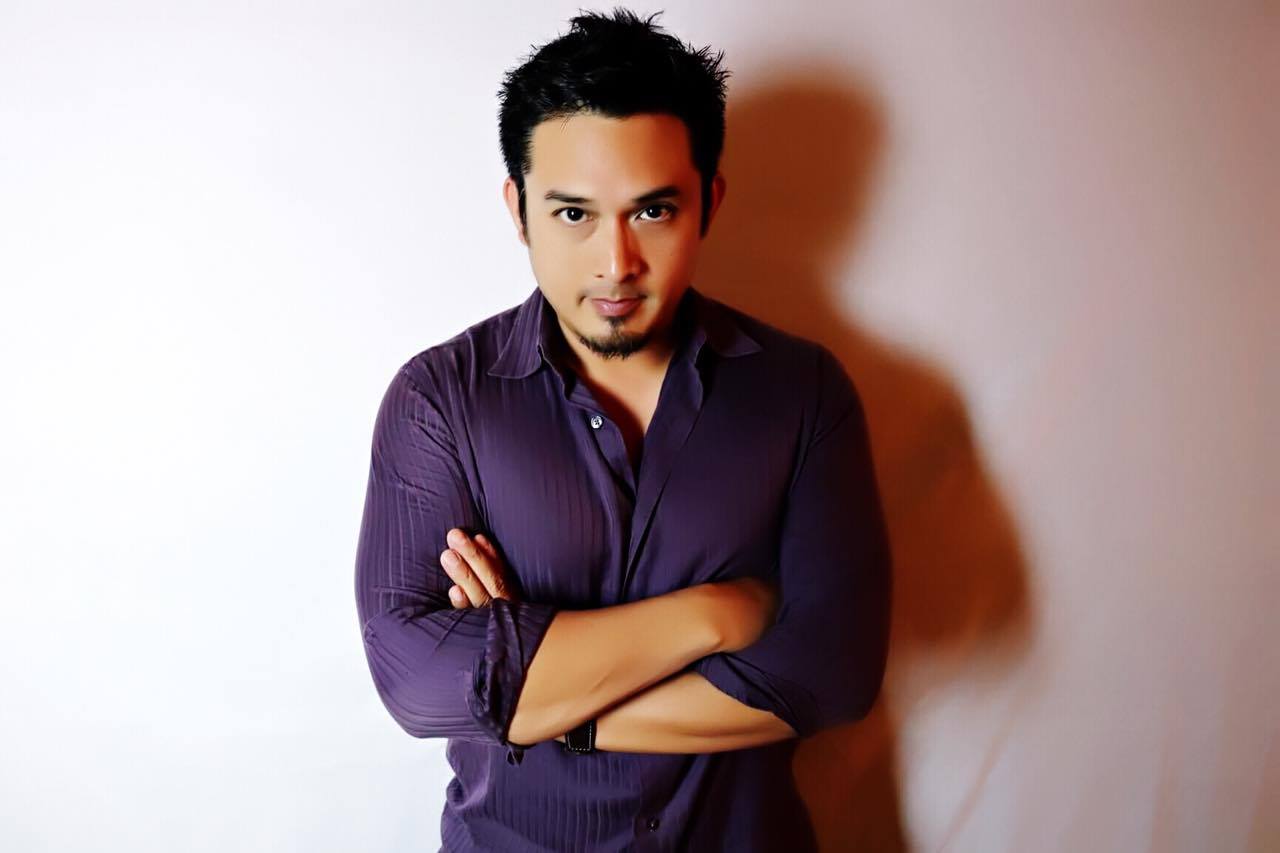

The UCLA Symphony Orchestra


Dana Point Symphony - California
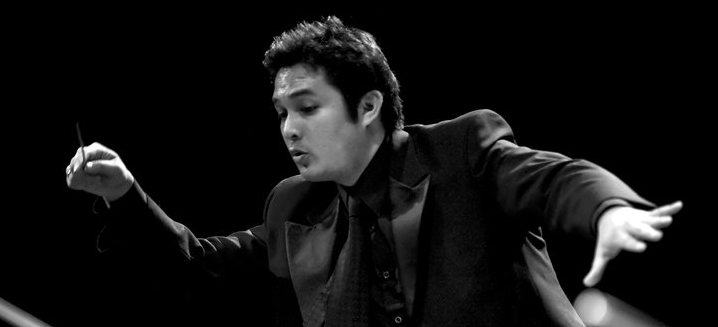
UC Santa Barbara Opera Theater: Mozart's Marriage of Figaro - watch the opera
Visit UCSB Opera Theatre
Click here to download a PDF of the review
Among life’s clichés ‘masterpiece’ is likely one of the most overwrought, but Wolfgang Amadeus Mozart (1756-1791) is one of a handful of geniuses who deserve the compliment in spades. Virtually all his music, particularly those works from the last years of his too short sojourn on this planet, are bona fide masterpieces.
Le Nozze di Figaro (The Marriage of Figaro) composed in 1786 during a burst of creative energy facilitated by his librettist, Lorenzo Da Ponte (Don Giovanni, Cosè fan tutte), is as perfect a work of art as can be conceived by the human mind. UC Santa Barbara Opera Theatre brought its dazzling genius to sparkling life on February 8th and 10th with a fully staged production at Lotte Lehmann Concert Hall on the seaside campus.
Featuring a cast and orchestra assembled from the Department of Music’s best and brightest - mostly grad students - and with directorial and additional musical assistance from faculty and guest professionals on stage and in the pit, the excitement on opening night was palpable.
From the first notes of the opera’s famous overture, conducted with insouciant flair and contagious vigor by Opera Santa Barbara Artistic and General Director Kostis Protopapas, the performance on February 8th flew by like an E ticket. On loan to UCSB Opera Theatre, maestro Protopapas was in firm but benign command, especially when he sat down at the harpsichord from time to time to dash off deliciously coy recitativo accompaniments throughout the evening.
Delighted appreciation for the musical jokes and discreet sight gags planted throughout the opera’s three hours occasioned frequent applause in support of UCSB’s wonderfully musical cast, which executed Mozart’s famous solo arias, duos, trios, quartets, quintets, sextets, and choruses with studied and steady style and panache.
A number of those in attendance might have been experiencing a live opera performance for the first time, but a large group were seasoned opera buffs, followers of maestro Protopapas and his Opera Santa Barbara colleagues, who played strategic roles in making this Figaro special. Approval by opera nuts and neophytes alike, gave currency as well as acclamation to UCSB Opera Theatre’s high standard of preparation and performance.
Mozart gave the world a Figaro score of knockout tunefulness and stunning virtuosity. Despite the legendary opinion of Emperor Joseph II about too many notes, not a single hemidemisemiquaver is wasted or superfluous. Achieving artistic success in presenting such a delicate musical and theatrical soufflé takes coaching from a village of widely experienced production professionals.
The exciting snap, crackle, and pop that distinguished UCSB Opera Theatre’s Figaro indicated with exclamation points, this lucky cast enjoyed mentoring from some of the best in the business.
Soprano Isabel Bayrakdarian (Stage Director); tenor Benjamin Brecher (Music Director/Producer); Richard Adamson (Set Designer); Ben Crop (Lighting Designer); and Lise Lange (Costume Designer) lent their extensive collective experience in professional theatre and opera to this production. The result, sung in Italian no less, was a perfect synergy of intent, training, purpose, and polish.
Richard Adamson’s set design was clever. A revolving scene change capability made for efficient use of the small stage area at Lotte Lehmann Concert Hall and suited the set piece needs of this all too class conscious Da Ponte/Mozart propaganda piece. Placing the servant’s quarters at the center of Count Almaviva’s house - the eye of the storm, so to speak - Adamson conjured a kind of physical metaphysics on people’s revolutions that were just around the historical corner and about to rock Europeon status quo to its core.
Ben Crop’s experience in lighting several of Santa Barbara City College’s Garvin Theatre shows over many years gave him experiential wiggle room to explore lighting possibilities at Lotte Lehmann. Making color an ambient companion to mood, Crop’s lighting gave hue and ballast to Adamson’s set changes.
A stylish eighteenth century wardrobe on loan from opera/theatre friends on the east coast afforded Costume Designer Lise Lange several beautiful opportunities to match elegance and period to set and lighting design. Special thanks to Hair and Make-up Designer Sarah Flores for her expert wig fittings - very important.
Uncompromising directorial and musical leadership from UCSB Assistant Professor of Voice soprano Isabel Bayrakdarian and tenor Benjamin Brecher, Head of the Voice Area at UCSB gave stellar cachet to this production, top down.
Bayrakdarian’s many professional engagements with opera companies around the world singing works from the major repertoire including Figaro, has given her a canny eye for artistic as well as comedic detail.
Bayrakdarian’s staging was all about movement - sensible, conversational, natural movement.The action flowed accordingly, with several comedic episodes and neatly choreographed mis-adventures set up by Bayrakdarian and Brecher in the manner of good theatre - the gags pressed subtly - comedy as confection.
Together, artistic team Brecher and Bayrakdarian assembled an ideal vocal cast for this Figaro. Baritone Byron Mayes (MM/DMA) in the title role was rich in stage presence and ripe of voice - deep, projecting, mature, and rounded. Soprano Naomi Merer (MM/DMA) as Figaro’s fiancée Susanna, brought a masterful sense of comedic verisimilitude to her role and championed a voice that grew in warmth and consonance as the evening progressed.
Peruvian-American soprano Kelly Newberry (DMA) created a sensation in the pants role of Cherubino, not only for her superb voice but also her captivating stage presence. Likewise, bass-baritone E. Scott Levin, who has enjoyed an active professional career since 2002. His Doctor Bartolo was a lesson in delicious comedic effect; a perfection of professionalism and charm that had to have inspired his younger colleagues.
Soprano Julie Davies (DMA) brought her fulsome and beautifully supported voice to the role of Countess Almaviva, while baritone Tyler Reece (DMA) contributed not a little comedic skill and solid singing to his role as Count Almaviva. Mezzo-soprano Molly Clementz (Marcellina); tenor Zachary Mendez (Don Curzio/Basilio); soprano Carol Tsai (Barbarina); bass Byron Wu (Antonio); and a delightful women’s chorus of Alexandra Lopez, Alexandria Jackson, Cloe Gentile, and Terra Giddens rounded out the excellent cast.
Daniel Kepl | Performing Arts Review


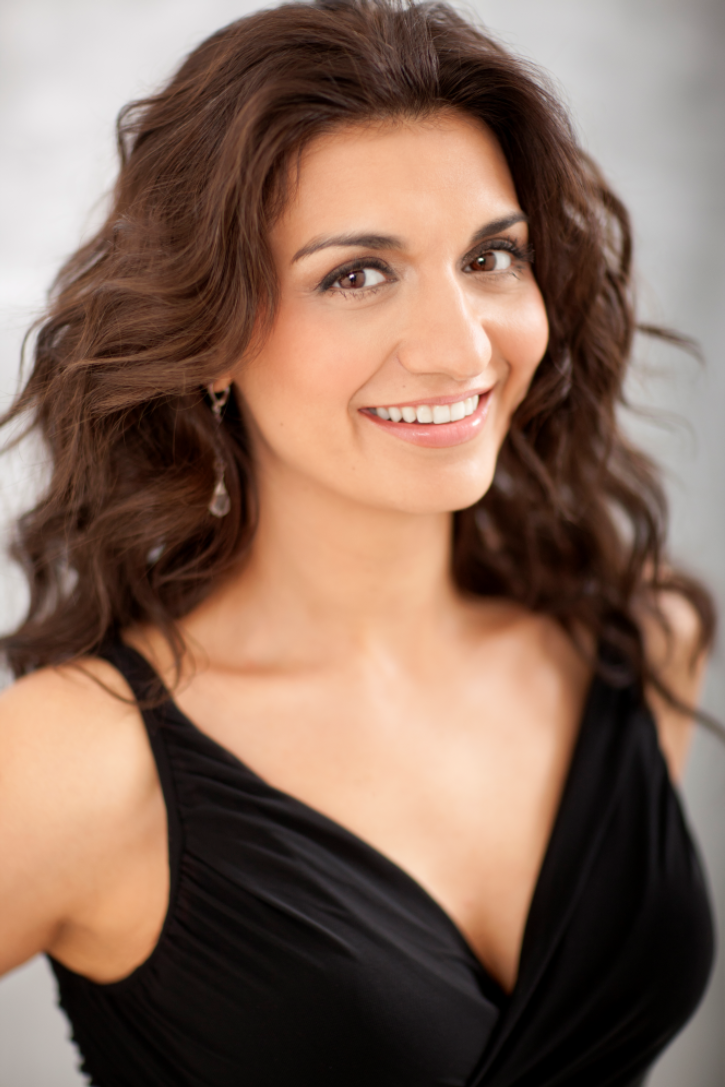
Director/Soprano Isabel Bayrakdarian
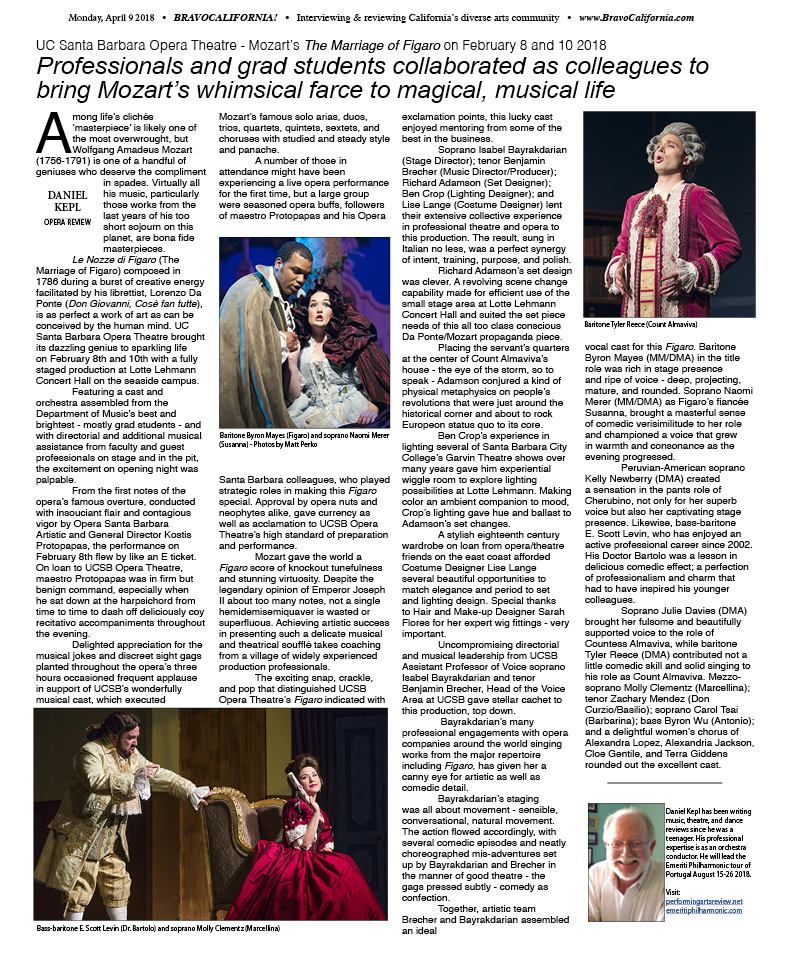
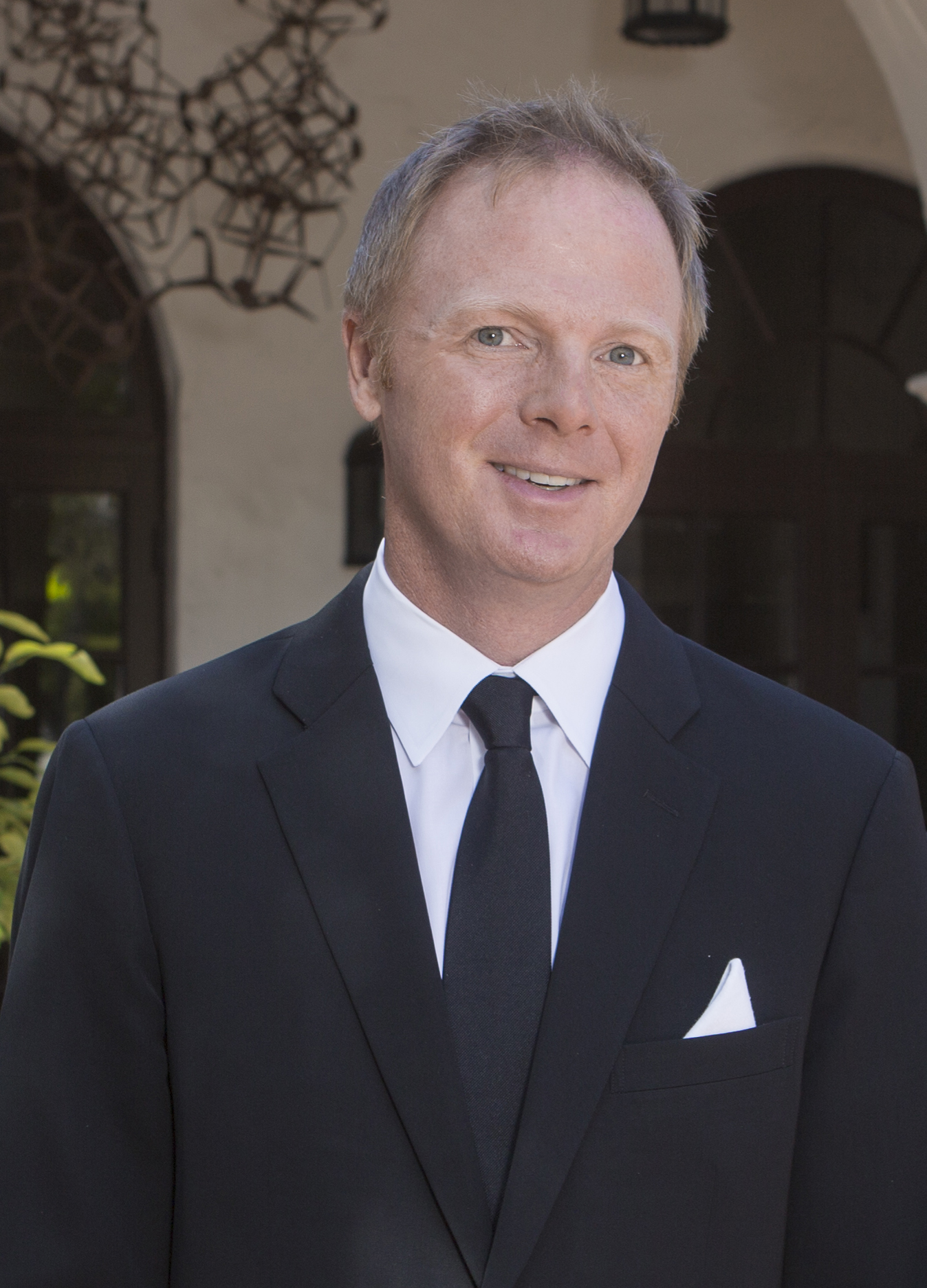
Tenor/Music Director & Producer Benjamin Brecher | photo by Eric Isaaks
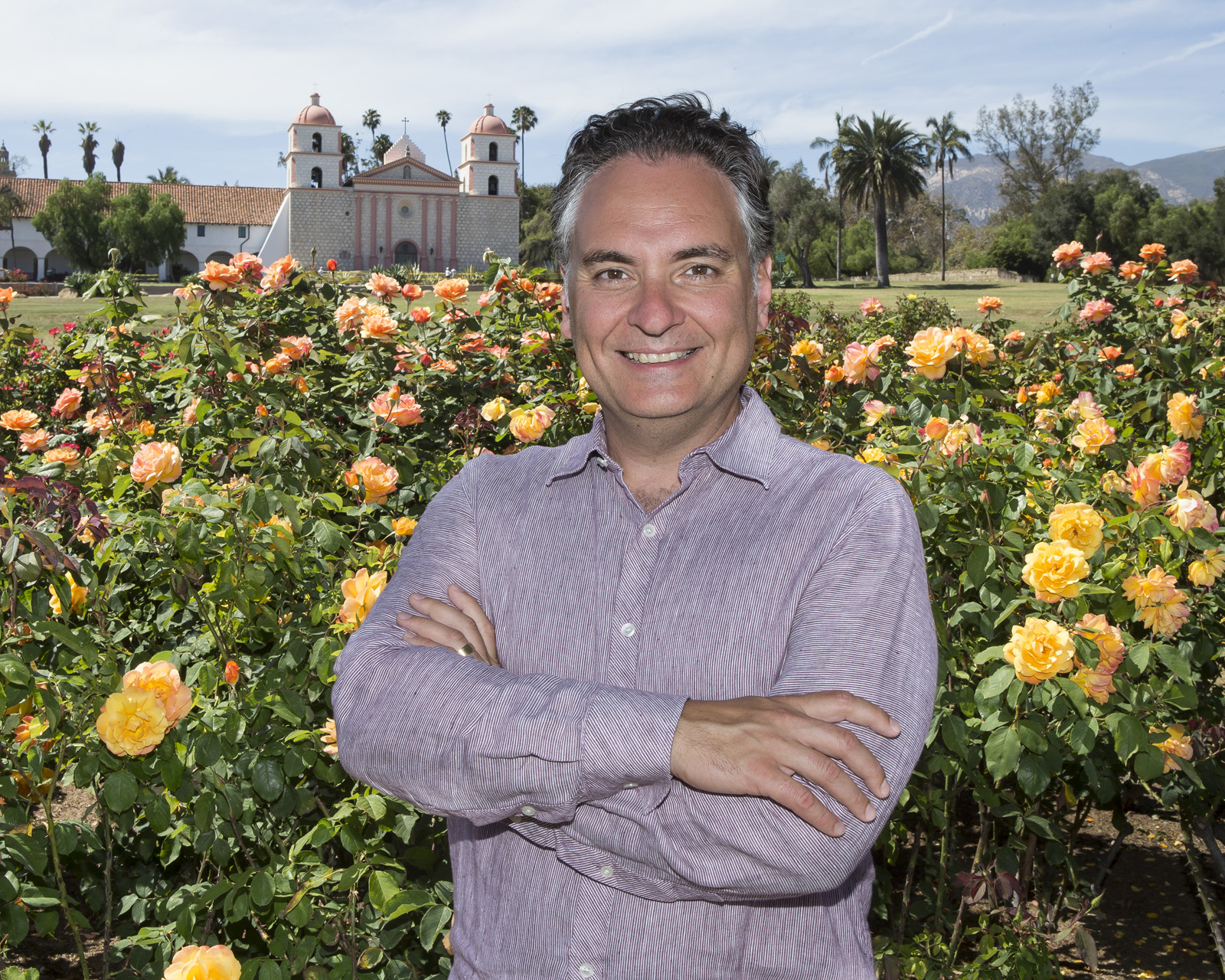
Opera Santa Barbara Artistic and General Director Kostis Protopapas conducted
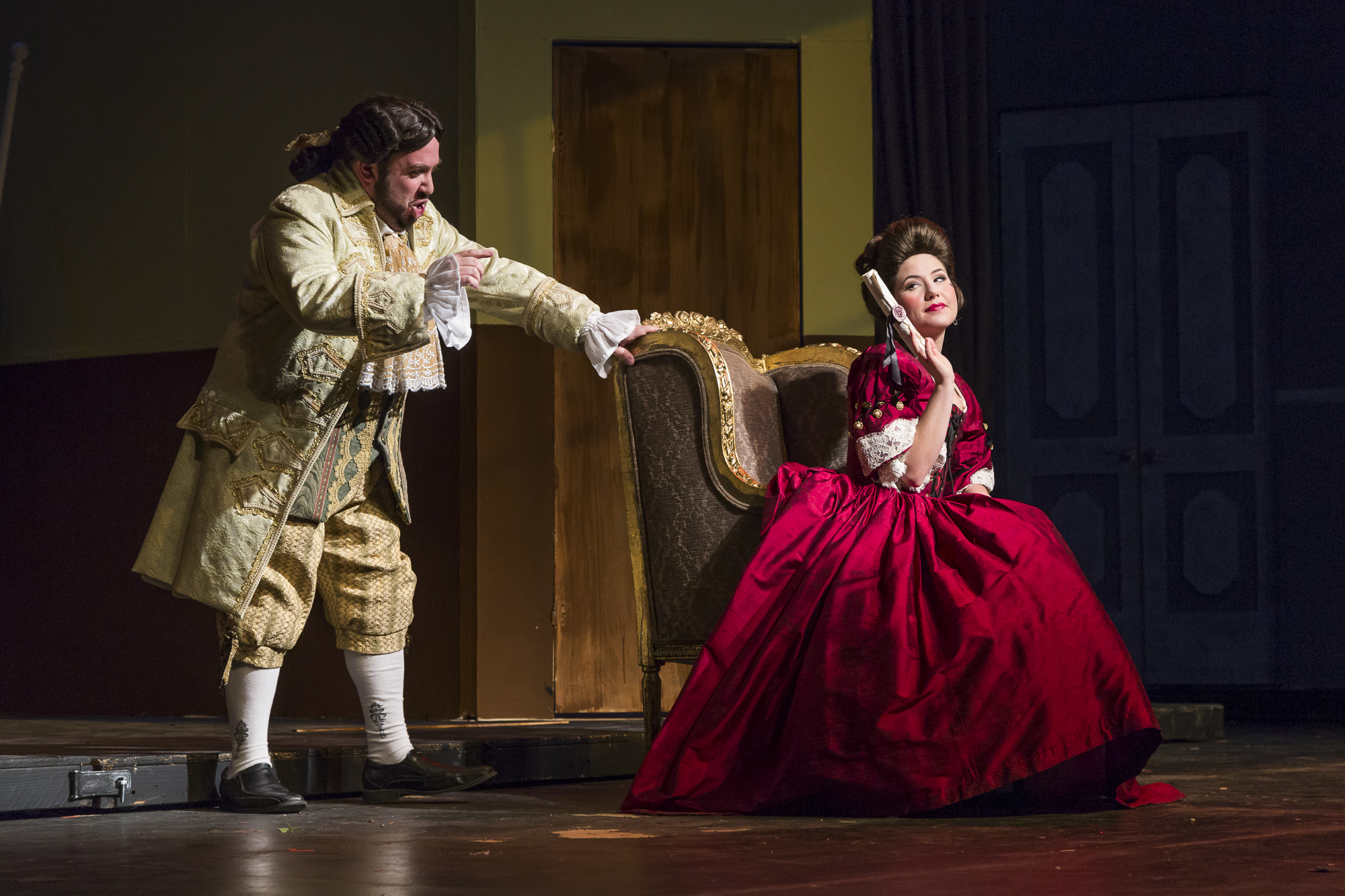
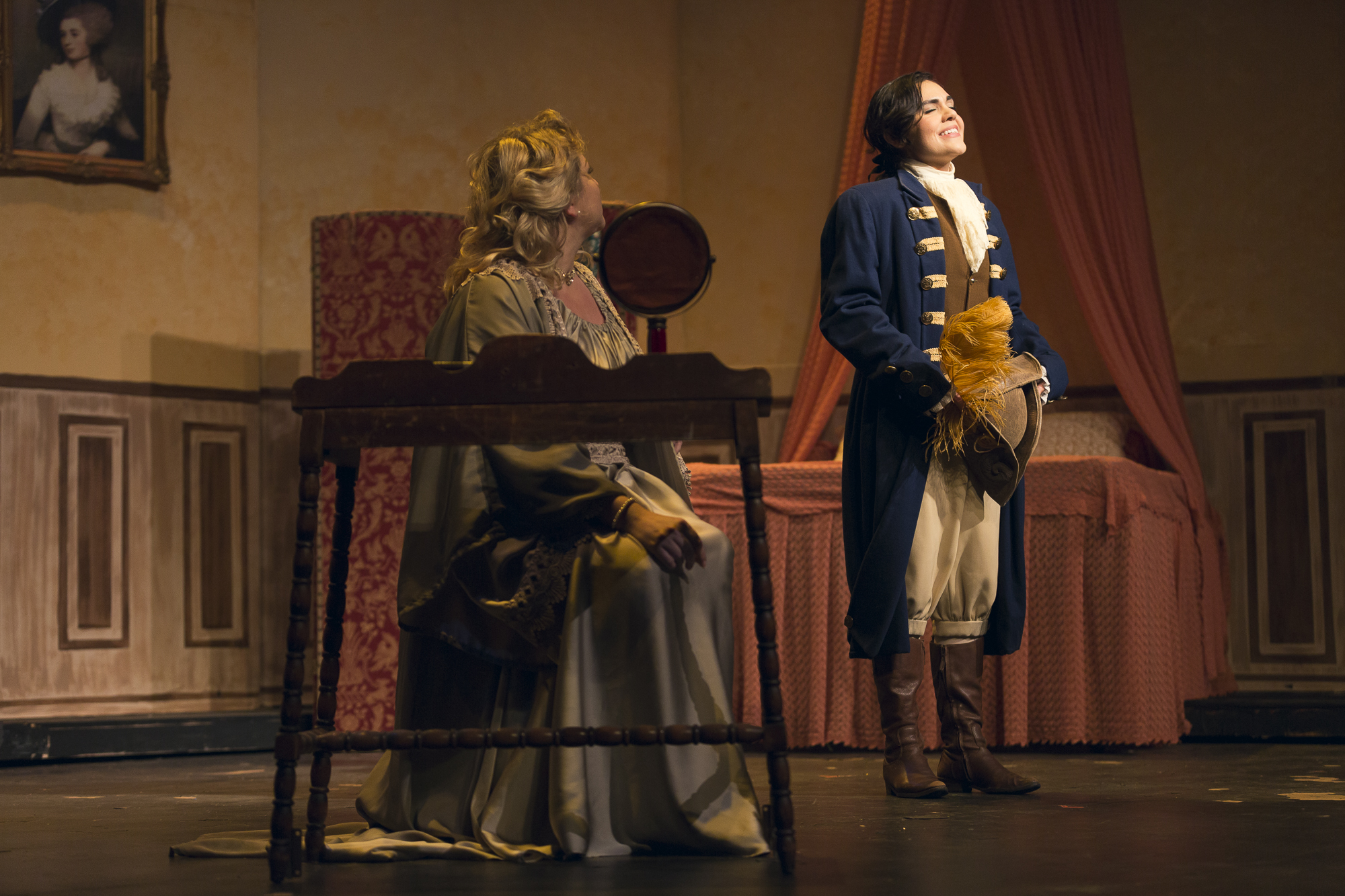

Westmont College Opera: Die Fledermaus - watch the opera
Visit Westmont College Theatre Arts
Visit Westmont College Music Department
Download a PDF of the review
Westmont College Theatre Arts Chair John Blondell has been producing innovative plays at the college’s sylvan campus in Santa Barbara since 1988. Co-founder and director of the award-winning international theatre ensemble Lit Moon Theatre Company, which is also based in Santa Barbara, Blondell has enjoyed additional opportunity to shift the interpretive sands under preconceived notions about dozens of traditional classics like Peer Gynt, Hamlet, Through the Looking Glass, and Tartuffe, to name but a handful of over 80 productions he has directed over the years with that professional company in cities around the globe. He has garnered a raft of awards as a result of his innovative re-thinking of the same old same old. Bottom line, Blondell is no lightweight. His approach to the standard theatre repertory is sometimes controversial, always fresh.
Last year, the Music and Theatre Arts Departments at Westmont teamed to present the college’s first fully staged opera on campus. This year, Dr. Blondell and Adams Chair of Music and Worship Dr. Michael Shasberger, kicked things up a couple notches, asking for and receiving the blessing of Santa Barbara’s Ensemble Theatre Company to mount Johann Strauss II’s operetta Die Fledermaus (The Bat) at Ensemble’s New Vic Theater in the heart of downtown.
A perfect war horse for Blondell to tweak, Fledermaus has been going strong since its debut in Vienna in 1874. Traditionally performed throughout the world to ring in the New Year on account of its famously opulent ballroom scene, the operetta is chock-o-block with silly plot twists, misidentifications, disguises, practical jokes, pitiable pratfalls, and implausible resolutions. What saves Fledermaus, rather like Leonard Berstein’s Candide, are Strauss’ immortal waltz tunes and hummable arias, which have levitated audiences above the schlock for just under 150 years.
Snatching innovation from the jaws of orthodoxy, Blondell set his Fledermaus in modern dress. Nothing fancy, just here-and-now attire - what one might see on a college campus. The ballroom scene, rather than posh, has been transformed into a Halloween party - clever. And to make sure his audience would not miss the singular importance of tune over tumult, he has placed the orchestra in a starring role on stage. Sometimes Westmont’s scrappy little band, under Shasberger’s tight musical leadership, was down-stage (overture and first act). Another scene change found it house right, then up-stage.
Breaking the tradition of lavish costumes and nineteenth century Viennese glitz - a budget buster - Blondell has swept away baubles and bling to focus instead on black box simplicity. Lighting and technical director Jonathan Hicks has followed suit. Likewise, Yuri Okahana’s scenography.
Director Blondell, not surprisingly, adopted his famously eccentric Lit Moon aesthetic to this production of Fledermaus, pairing mostly discreet comedic touches and fascinating character eccentricities with off-the-wall visual accents. Choreographer Victoria Finlayson, for example, gave the ballroom scene a touch of oddment by having the guests dance alone, no partnering.
The chambermaid Adele (soprano Michelle Vera), displayed an occasional nervous tick, literally convulsing from time to time, particularly in her opening scene - go figure.
Alfred, the singing teacher (tenor Jon Lindsley), modeled perhaps on Gilbert and Sullivan’s Reginald Bunthorne, sported turf green fingernails. Frank, the prison governor (baritone Micah Anthony), was appropriately black-nailed - something about dungeons?
Chairs became harbingers on the bare, Our Town-inspired meta-theatrical set; rearranged, stacked, counted, danced on and around. All manner of magic act props livened the action and brought color to the chaos. Mad Hatter and garbage lid hats, Walpurgisnacht and bordello costumes descended from the loft on a hanging rack for the party scene which opened Act II, replacing traditional tailcoats and gowns with goofy irreverence as the guests dressed on stage for the occasion.
A Viewmaster and sunglasses somehow gave credence to one aria; the pants role character, Count Orlovsky (mezzo-soprano Elena White), sported a magic marker moustache; puppet animals cavorted; a handshake shtick made pithy homage to Laurel and Hardy; the focused thus hilarious poker face of Eisenstein’s wife Rosalinde (soprano Anna Telfer); provided a bountiful
cornucopia of delight that conspired to produce ripples, then tidal waves of audience laughter and delight on opening night.
The young Westmont College cast tackled some of the most difficult vocal music of the nineteenth century with heroic energy and spirited aplomb. Soprano Michelle Vera (chambermaid), was consistently splendid, both as actor and singer. Likewise, mezzo-soprano Elena White in the pants role of Orlovsky, a Russian Prince. Tenor/baritone Kenny Galindo (Gabriel von Eisenstein), tackled Strauss’ wide-ranging and often treacherous tessitura with courageous pluck, while soprano Anna Telfer (Rosalinde) grew more confident vocally as the evening progressed. Baritone John Butler’s Dr. Falke was notable for clean musical stylings and Tenor Jon Lindsley’s sweet warblings and gender neutral affectations - the G & S Bunthorne homage - reached the edge, but never went over the cliff of parody. Baritone Micah Anthony (Frank, the prison Governor), contributed his pleasing voice to the vocal menu as well.
The supporting cast - tenor Sean McElrath (Blind, an attorney); Logan Foltz in the speaking role of Yvan, the Prince’s Valet; soprano Jessica Lingua (Ida, Adele’s sister); Merckx Dascomb (Frogg, the jailer); Nina Fox (a jailer); and a bevy of well trained chorus members - helped create an entertainment that became curiouser and curiouser as the evening progressed. Herr Strauss would have been well pleased.
Daniel Kepl | Performing Arts Review

Director John Blondell discusses his quirky take on Johann Strauus II’s iconic operetta Die Fledermaus
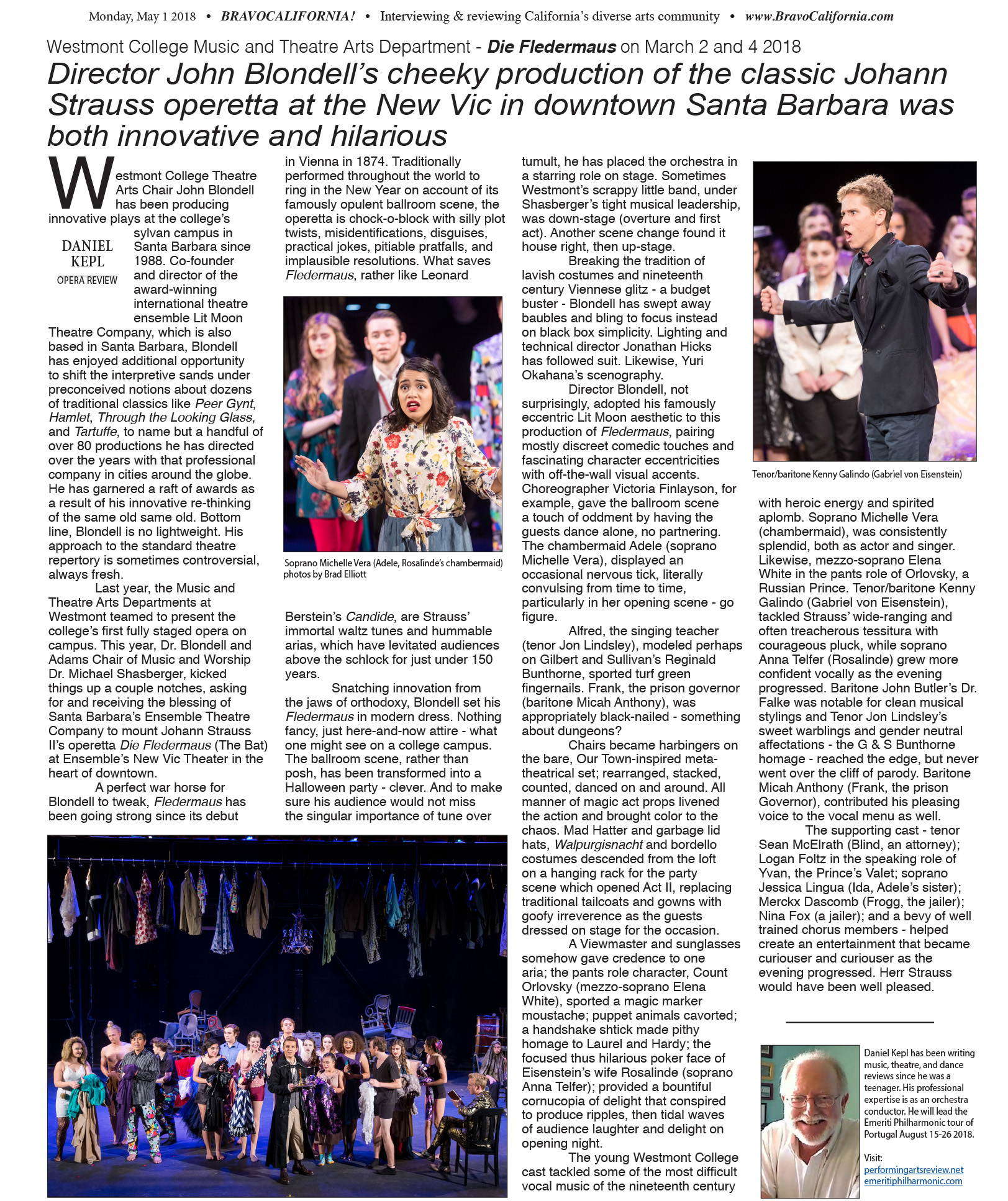



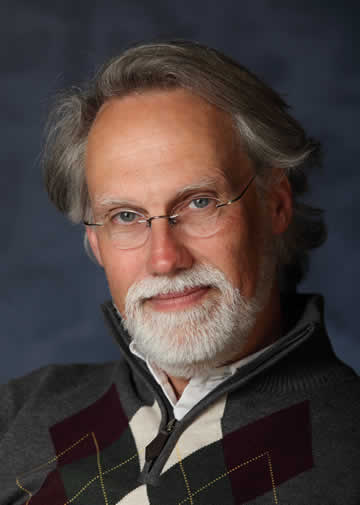
Westmont College Theatre Arts Chair, Director John Blondell
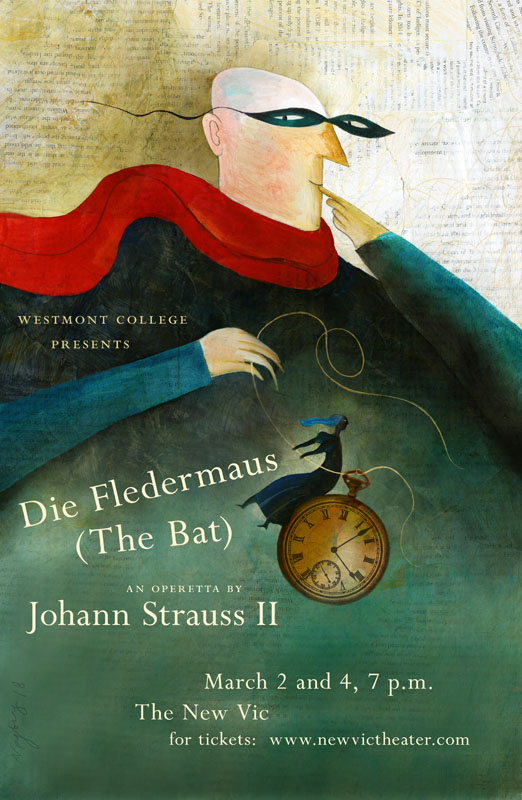
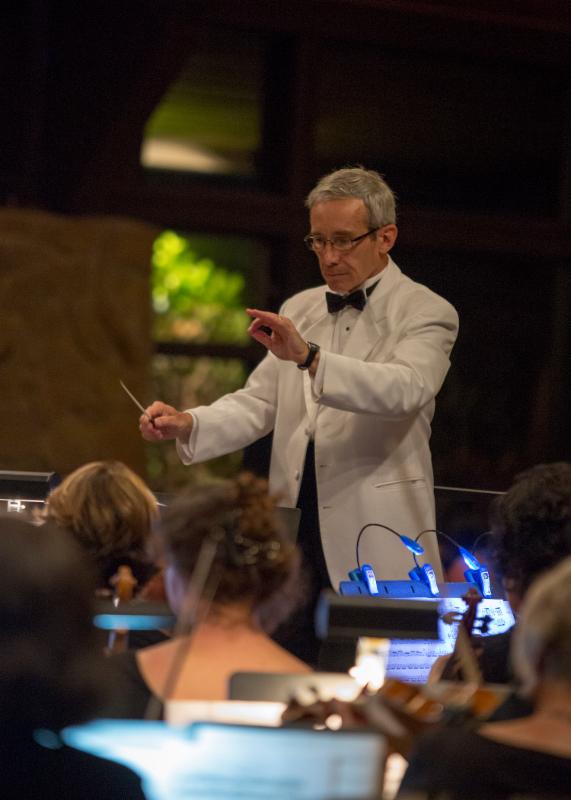
Dr. Michael Shasberger, Adams Professor of Music and Worship and Chair of Westmont’s Music Department

Production photos by Brad Elliott


The New Vic in downtown Santa Barbara
SOPRANO JULIET WALLACE: EMERGING ARTISTS TRAINING WITH BERLIN OPERA - WATCH THE INTERVIEW
Visit Juliet Wallace’s Go-Fund-Me campaign
Visit Berlin Opera Academy
Visit Juliet Wallace’s Facebook page
The Berlin Opera Emerging Artists Studio is a month long program starting in mid-June and is one of the most highly respected young professional musician training courses in the world. The Studio offers a daily program of movement and German language classes followed by intensive coaching sessions from répétiteurs, teachers and directors including the rare encouragement to bring whole roles to prepare with them.
The course will also include group masterclasses and public concerts. There will be business classes as well on how to build a career in Germany and conduct interviews and auditions with German agents. Participants will leave the intensive program with professional recordings that can be used for auditions.
Daniel Kepl | Performing Arts Review

Coloratura soprano Juliet Wallace

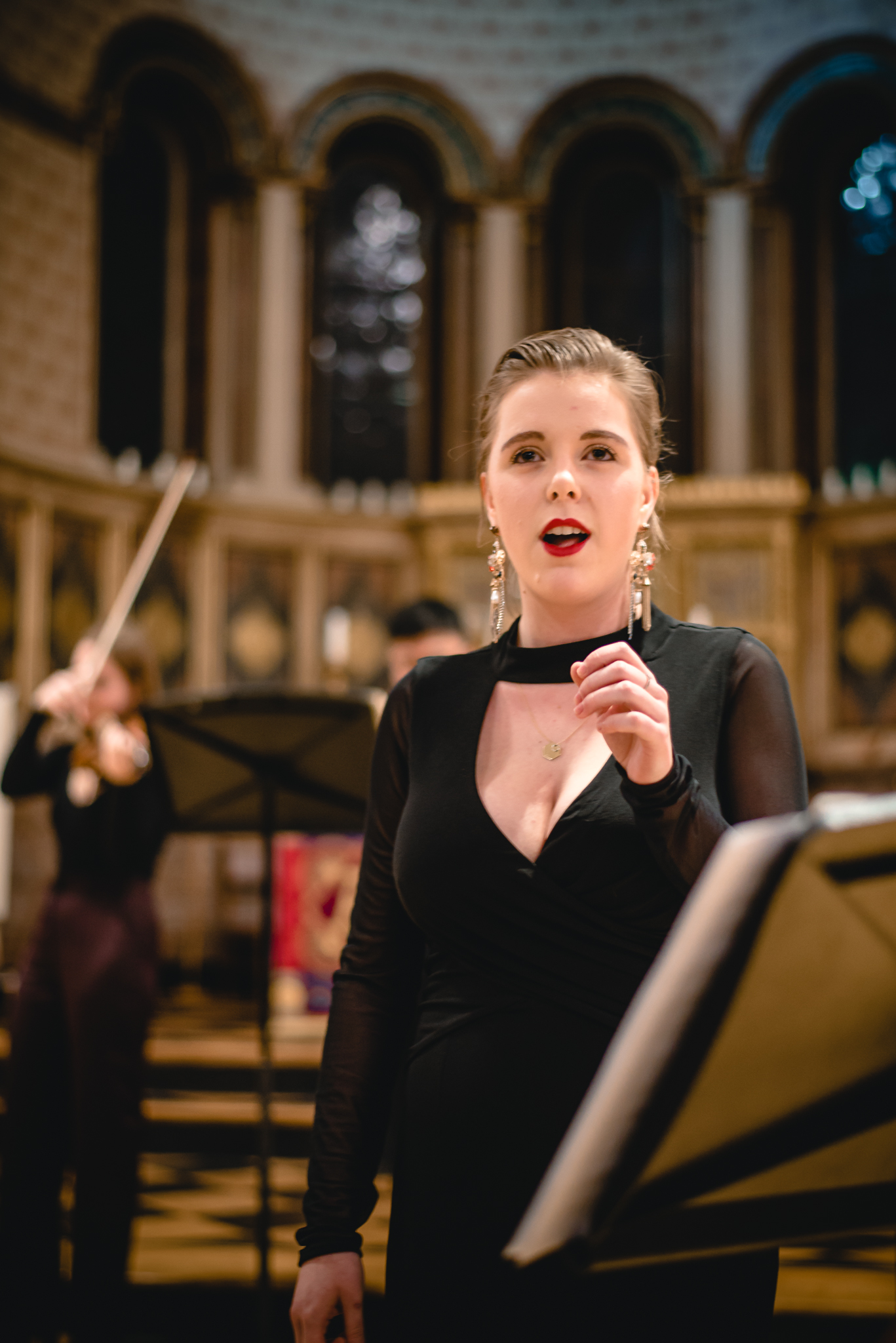

Music Academy Festival Orchestra, Lehrer Vocal Institute August 6, 2022: read the review

